stokes point Careel Bay: the shift from warner's hut in 1813 to Finisterre in 1924; 1934 additions probably designed by australia's first women architect, beatrice (Bea) may hutton
a pittwater rendezvous site for royal sydney yacht squadron members is still a home with a view for those with a passion for sailing
Sketches and records indicate that the tip of Stokes Point in Careel Bay, on the Pittwater estuary, has had a fisherman's hut, a shack, then villa then mansion on its promontory since soon after Europeans came to this fair land, and from at least 1813.
Additionally, the persons to purchase this headland out into the estuary and along the shore at the bay were the founders of the Royal Sydney Yacht Squadron, in Isaac John Josephson, Dr. Frederick Milford and later a member of the Prince Alfred Yacht Club, when it was formed to greet the first Royal Visitor to these shores, which, coupled with the knowledge that the nearby property of Dr. Elliott, Marara, fashioned to become a Pittwater rendezvous or yacht club for the Royal Sydney Yacht Squadron, would indicate Careel Bay was to be the place where these premier yacht clubs of Sydney were to have their Pittwater chapters, long before Newport's Salt Pan for the RMYC and Green Point for the RPAYC was settled on decades later.
Isaac Josephson, born in 1824 in Sydney, was 57 when in May 1881 he purchased the just over 4 acres that comprised Stokes Point for £80 18 shillings and 7 pence, with the Certificate of Title registered in December 1881.
Although still active and passionate about sailing into his final days, he may have bought the small peninsula for his sons and daughters and grandchildren's use as much as for a view from which to watch sailing and yacht races. The First Pittwater Regatta, held in 1888, was still a way off, but records and photographs indicate RSYS and RPAYC members were holding regattas at The Basin with year round residents involved, as well as The Basin Cup and races to and around Lion Island and back to Sydney Harbour, from the early to late 1880's and especially so during the 1890's. The owners and their crews either sleeping on the vessels themselves or camping out on the adjacent land - sometimes at The Basin.
This lovely emerald inlet was also known as Blind Cove:
This beautiful little bay shown in our illustration, formerly private property, has been made a reserve of by Government, and is now practically a cruising ground for the yachting community of Sydney. A more useful and delightful sheet of water could not have been chosen, situated as it is at the entrance to the Hawkesbury River, just opposite Barrenjoey.
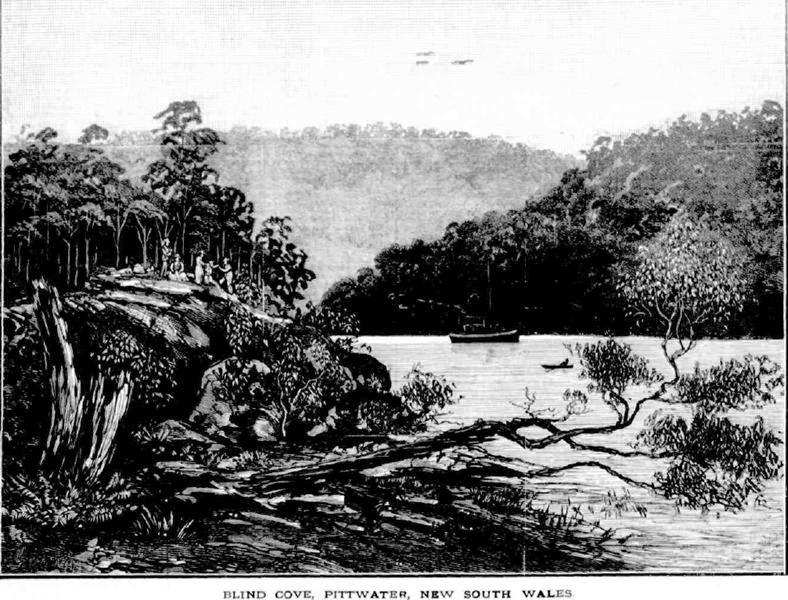
To the north is the broad expanse of water known as Brisbane Water, and to its south Pittwater, which is now connected with Sydney, Newport, and Manly by means of a coach running daily.
Blind Cove, also called The Basin, is a safe refuge in the very worst of weather. It owes its name of Blind Cove to the fact of its being invisible to the incomer until he has almost reached its entrance, which is very narrow and hidden from view by a low stretch of sand; but inside this narrow passage there is deep water, and the height of the hills surrounding the basin (some 600ft) so thoroughly shelter it from heavy winds that it might well be called Looking-glass Bay. It is on account of this, and also the beauty of the surrounding scenery, that has made it one of the principal rendezvous of yachtsmen.
Blind Cove, Pittwater, N.SW. (1883, March 10). Australian Town and Country Journal (NSW : 1870 - 1907), p. 26. Retrieved from http://nla.gov.au/nla.news-article70996783
An Album of photos gifted to the Australian National Maritime Museum title by them 'Boating on Pittwater including steam yacht ENA' and dated circa 1890, shows how the visitors would use canvas to form shelters over the vessels from sun and rain ands also some of their activities - such as shooting wildlife from these yachts - a practice that had been going on since Europeans landed with much of the local wallaby, bird and even koala population decimated for 'sport'. Further south, at Manly, the hill people would traverse to head north to glorious Pittwater was actually called 'Kangaroo Hill' due to the weekend warrior's of that era visiting to kill wildlife. These were also wallaby hunts. Passage from My Holiday by Charles de Boos, detailing his walk from Manly to Barrenjoey in 1860-61,record over and over the killing of ducks, 'wallobies', and even the humble 'gill' bird and wonga pigeon - the honeyeaters and red wattlebirds, was a target and almost disappeared from the landscape.
.jpg?timestamp=1567239765467)
.jpg?timestamp=1567239252720)
from ANMM/McCormick album
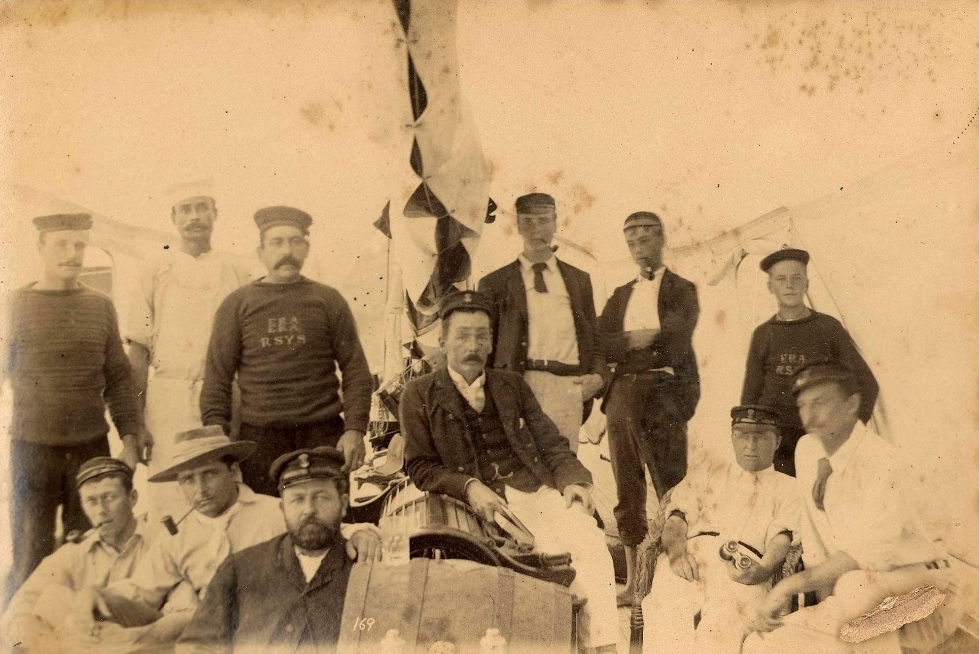
from ANMM/McCormick album
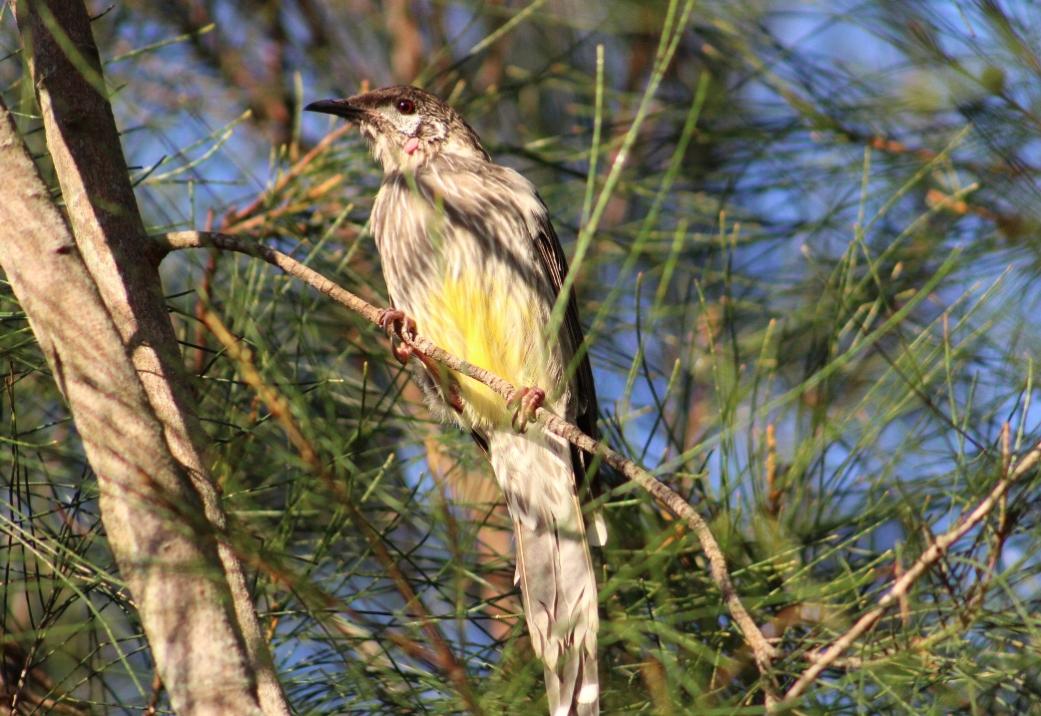
Charles De Boos in his series of 1861 articles collated as 'My Holiday' gives one of our first insights into the profusion of oysters that once grew naturally in pristine Pittwater estuary bays and foreshores, although he does seem to be mistaking 'Creel Bay', or Careel Bay, from what sounds like a description of what we now call Winnji Jimmi, Winnererremy Bay and Bayview and was then known as a 'Water Maze'.
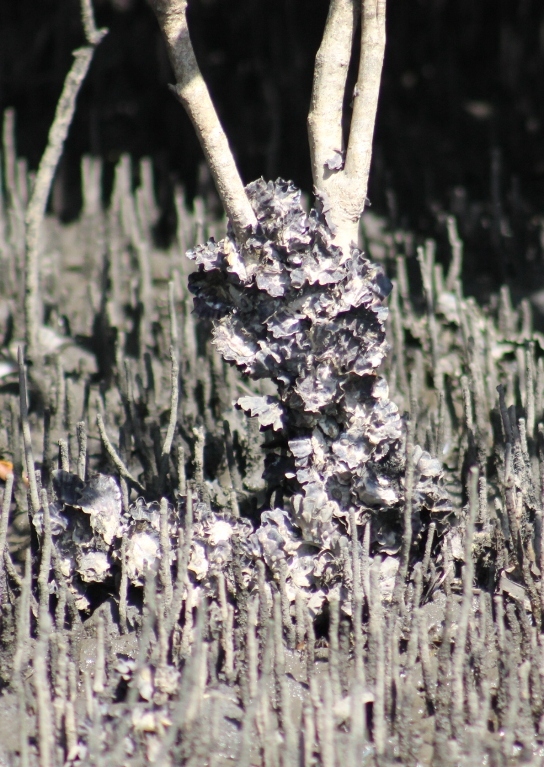 We continued our descent to the mouth of the gully, in the hope that we had seen the last of the dogs-a hope; however, that was to be grievously disappointed. By dint of sliding; slipping, and jumping, for the lower part of the range was exceedingly precipitous, we reached-I can't call it the beach, for it was here a broad muddy flat, covered with mangroves, a peculiar kind of dark green leathery-leaved tree that has the characteristic of growing only in salt water; and the young shoots of suckers of which could be seen starting up from the mud to the very verge of low watermark, surmounted in most instances by a cluster of others-a circumstance that has given rise to the assertion, at one time considered fabulous, that oysters in Australia grew on trees. There was a belt of low swamp oaks, intervening between the foot of the range and the mangrove scrub which reached to the highest high water mark, and as we came upon these we heard a loud whirr of wings, accompanied by the clapping together of the pinions, that always denotes the flight of a pigeon. Tom's eye was on the bird, and he followed it until it rested on a limb of one of the swamp oaks.
We continued our descent to the mouth of the gully, in the hope that we had seen the last of the dogs-a hope; however, that was to be grievously disappointed. By dint of sliding; slipping, and jumping, for the lower part of the range was exceedingly precipitous, we reached-I can't call it the beach, for it was here a broad muddy flat, covered with mangroves, a peculiar kind of dark green leathery-leaved tree that has the characteristic of growing only in salt water; and the young shoots of suckers of which could be seen starting up from the mud to the very verge of low watermark, surmounted in most instances by a cluster of others-a circumstance that has given rise to the assertion, at one time considered fabulous, that oysters in Australia grew on trees. There was a belt of low swamp oaks, intervening between the foot of the range and the mangrove scrub which reached to the highest high water mark, and as we came upon these we heard a loud whirr of wings, accompanied by the clapping together of the pinions, that always denotes the flight of a pigeon. Tom's eye was on the bird, and he followed it until it rested on a limb of one of the swamp oaks.
Right: oysters growing up a mangrove at Careel Bay - September 2014. A.J.G Picture.
"A wonga wonga, by Jupiter!” he exclaimed, and, taking a steady aim, he fired, the feathers from the bird fell down in a shower, whilst the bird himself flew away into the thick brush of the gully, not unharmed, as many of the feathers were stained with blood. However, we did not get him, and that was enough for me. Not so for Tom, for he persisted in hunting up the feathers, in declaring that the bird must have been skinned by the shot, and in wondering however it could have got away. I was quite used to all that sort of thing, for I had tried the same dodge myself when I hadn't bagged my game, so I put down my gun, walked quietly down to the rocks, and commenced opening and eating the oysters with which they were covered in the greatest profusion.
One 1885 jaunt lists all the yachts that came out here - another indication of why higher, less prone to king tide and sheltered land may have been bought. Worth remembering when reading this is the Pittwater was actually called 'The Hawkesbury' as well during these years, and had been recorded as 'an arm of the Hawkesbury' from the first visit here in 1788 by Governor Phillip even though it's obviously an estuary:
CRUISING IN THE HAWKESBURY.
It has often been said that our aquatic amateur sailors: were unequal to the task of venturing outside the Heads; but the number who have gone out during the holidays, to explore "fresh fields and pastures new," both north and south, completely disproves any such statement, and the only reason that- those . extended cruises do not occur' oftener is because it is useless going outside unless one has at least three days to spare from business.
The beautiful waters of the Hawkesbury had representatives from the different sailing clubs. The S.A.S.C. and the D.B. A.B.C. were in great force. Commodore Dietrich. Commodore McDonnel, Vice-commodore Milson (Waitangi), and the Vice-commodores of the P.A.Y.C. and D.B.A.S.C., all went up in their boats, thus setting a good example to the other members and bearing silent testimony that we have a nucleus of at least one hundred well trained boat sailors. Exclusive of five yachts there were-at least 20 boats counted about the bays in the Hawkesbury, all of which sailed out from the Heads from Tuesday to Thursday morning.
Camping out is now held in high favour and becoming even quite fashionable, and this too by persons owning boats that hitherto have been looked upon as mere racing machines. The Sydney Amateur Sailing Club was represented by the Asteroid, Dreamland, Lottie, Snowdrop, Muriel, Cutty Sark,. Wanganella, Psycho, Colleen Bawn. The Double Bay A. Sailing Club by the Curlew, Iris. The Lottie being also the commodore's boat of the other club.
Besides- these, there were- also present the Viking, Mr. Charlton's new boat, the Weringa, Pearly Sybil, Agnes, Zuleika, Corinne, Maritana ; the latter having Ï made a very fast trip from Sydney.
The weather was very favorable both going and coming. In going down there was a good muster on Thursday morning, some ten boats going out in close order. Some had gone on Wednesday afternoon and one on Tuesday morning. The time made was very good both ways. A capital opportunity was given to beat the river, as there was a fine S.E. wind and flood tide. and the majority made their way as far as Beroura Creek which was honoured by the Dreamland, Lottie, Wanganella, Curlew, Zuleika on Christmas Day; while just below were the Waitangi and Muriel, with the Pleiades and Viking in Cowan Creek. Some boats, anchored in Wogonga Creek, the Asteroid was lying very lonely under Long Island; and some three or four others went over to Pittwater and the Basin.
On Friday most of the boats worked lower down the river, and in the sea reach the Violet, Mistral and Sao, were met coming from Sydney; followed by the Wolverene, which, if report be true, found amusement and instruction in shelling the banks of Cowan Creek, and thereby setting fire to the bush and so disfiguring nature. Certainly from The Basin reports were heard, and soon after bush-fire smoke was seen moving in clouds.
On Saturday evening there was a large muster at the Basin, 12 boats and three yachts laying there waiting for the return trip on Sunday. Punctually at 8 p.m. the Waitangi, the flagboat, of the fleet, fired her cannon; which is repeated at 8 a.m., when the flag is hoisted. At night the scene on shore was very lively, as most of the-crews had mutual friends, and told various yarns of their aquatic experiences, and it was pretty late before the various crews turned in except for those who were going out with the early westerly at daylight.
The Cutty Sark left the basin first, followed by the Snowdrop, Pearl, and the Young Harry, a fishing boat from Double Bay, hired by some amateurs.. These three got well off the land by 10a.m.; but found the E.N.E very late in coming in. Soon after the Dreamland and Wanganella, with the Sibyl, from the river, put out, getting an offing about 11 a.m. The Dreamland came back very fast, catching the Pearl, which had a long start of:' some two or three miles, and boating the Wanganella by some 12 minutes. When Long Reef was reached, the scene would have made a very pretty picture. There were sú¿. boats iri, a heap astern or the Wanganella, and four ahortd;, with some yachts bowling along at a fast pace.
The trip took from two and a half to three hours, and more for slower boats, from Barrenjoey to South reef, and the wind was not too much aft to stop the jib from drawing. The Curlew, Iris, Colleen Bawn, stayed behind, and perhaps others but all the rest, so far as we can learn, reached home safely without accident. The fair wind did not necessitate anyone having to overland it from Pitt Water to be in time-for business.
Besides these sailing boats, there were numerous skiffs taken round by steamer, and the two steam yachts Eva and Northumbria steamed up. What other ports were visited by the clubs and other boats will, doubtless, be duly recorded; but for Broken Bay it may be said that it had the lion's share, and it is gratifying, to know that when such an occasion as this just past offers itself our amateurs are only too glad to vary the monotony of the smooth harbour for a lurch and a roll on our own sunny ocean. CRUISING IN THE HAWKESBURY. (1885, January 3). Australian Town and Country Journal (NSW : 1870 - 1907), p. 38. Retrieved from http://nla.gov.au/nla.news-article71021899
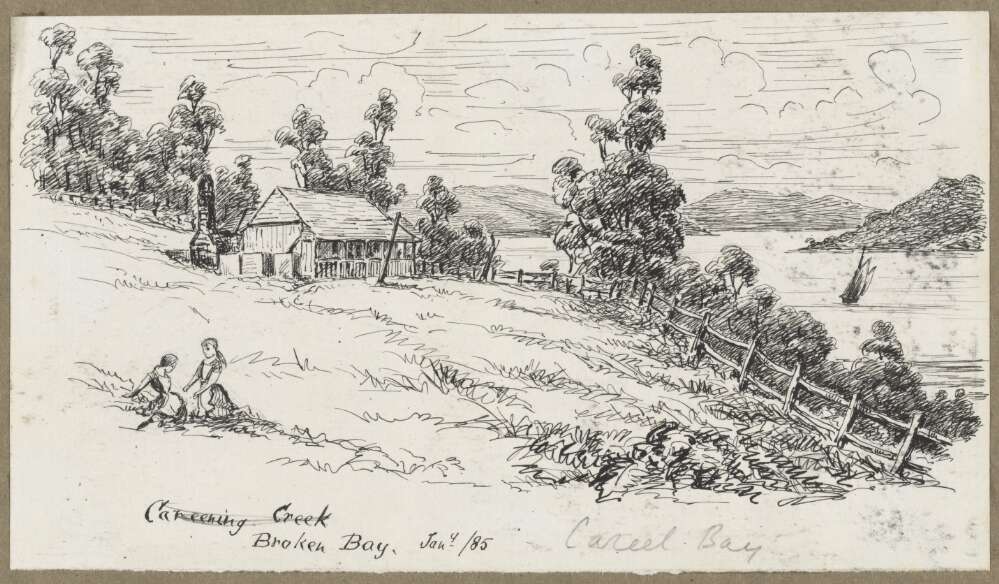
 stokes.jpg?timestamp=1692216921496)
By Graham, H. J. (1885). Careening Creek (Careel Bay January 4 or 9 1885), Broken Bay Retrieved from http://nla.gov.au/nla.obj-135522526 Scottish-born Harold John Graham (1858-1929), hoping to recover from illness, sailed to eastern Australia in 1881. A keen amateur artist, he recorded his observations of places and the local flora and fauna. He worked as a draughtsman in the Water Conservation Branch of the Public Works Department in Sydney. Retiring because of ill health, Graham together with his family, returned to England in 1900. Tragically his wife, Amelia Mary Graham, was drowned off Middle Head on November 29, 1885 - see References-Extras.
There were also Blocks 4 and 5 Book-Number 260-914 Lot 6 of 4 acres which were sold by Rev. Dalton to William Waterhouse in 1882 (steamboat proprietor of 'North Shore' and later Mayor of the Victoria Borough prior to that becoming North Sydney Council - steamships were still landing people via Careel Bay Wharf at Careel Bay as an outing for the day into the1890s via the Namoi and Newcastle, all with bands aboard) and/with Matthew Byrne for £99. This may have been to circumvent an earlier fracas over steamers and proprietors using the wharf built by Rev J J Therry without permission, and accessing land for picnics etc. that didn't belong to them.
The sum of £99 or around $200 in 1882 converted to 2023 times with interest is certainly more now - £15, 237.06 or around $30,500.00 - but certainly not the 5 to 10-20 Millions these waterfront blocks and homes fetch today, even if the Careel Bay of the 1880's was still a little cut off from the bustle of metropolitan Sydney Town.
A description of the place then:
The steamer Newcastle left Sydney yesterday morning with a large number of excursionists for Broken Bay, and a most enjoyable day was spent by all on board. The weather was splendid, and the slight swell outside made everyone in good spirits.
The landing-place at Careel Bay was the subject of extreme admiration, and the company have chosen a real good spot for their patrons. A start was made for home at 3.45, and after a bit of a toss the company arrived in town about 6 o'clock. AN ANTIQUARIAN. (1891, November 9). The Australian Star (Sydney, NSW : 1887 - 1909), p. 6 (EXTRA SPECIAL). Retrieved from http://nla.gov.au/nla.news-article227242064
OCEAN EXCURSION TO CAREEL BAY.
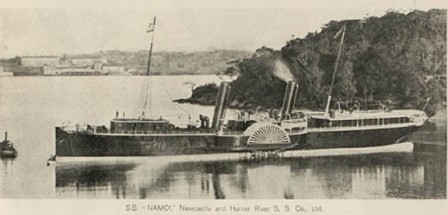 The express excursion S. S. Namoi started on her well-known fortnightly excursion trip on Saturday afternoon to Careel Bay, Hawkesbury River, and had a favorable run, during which time from the decks of the steamer could be seen the ocean yacht race in progress, and the views of the many changes in landscape, as point after point was reached. On arrival at Careel Bay an opportunity was afforded for an hour's ramble on shore, which was taken advantage of by a great number, who thoroughly enjoyed their stroll among the flora, ferns, palms and maiden hair, which were seen to grow in abundance on the hillside and grounds shelving to the water's edge.
The express excursion S. S. Namoi started on her well-known fortnightly excursion trip on Saturday afternoon to Careel Bay, Hawkesbury River, and had a favorable run, during which time from the decks of the steamer could be seen the ocean yacht race in progress, and the views of the many changes in landscape, as point after point was reached. On arrival at Careel Bay an opportunity was afforded for an hour's ramble on shore, which was taken advantage of by a great number, who thoroughly enjoyed their stroll among the flora, ferns, palms and maiden hair, which were seen to grow in abundance on the hillside and grounds shelving to the water's edge.
Others, again, went for oysters, which were in profusion, whilst some ardent fishers remained on board to ply the line from the vessel's side, resulting in many of the finny tribes being lured from the ocean's depths to the fishermen's baskets. Careel Bay is essentially a fishing hamlet, if we can judge by the surroundings. The vessel was well found in every respect, and the creature comforts of her patrons were not in the slightest respect overlooked. The catering, as usual, was first-class. Awnings were run up fore and aft, and seating accommodation amply provided for. Selections of music by the band at intervals enlivened the journey. The adverse weather of the last few days, bringing with it sundry squalls of rain, could not be otherwise than expected, but, despite this, the trip well repaid those who patronised it. OCEAN EXCURSION TO CAREEL BAY. (1894, February 19). The Australian Star (Sydney, NSW : 1887 - 1909), p. 3. Retrieved from http://nla.gov.au/nla.news-article227219125
With the Opening of the Sailing Season taking place through the Royal Prince Alfred Yacht Club on Saturday September 2nd, the Avalon Sailing Club holding an Open Day on August 27th and Learn to Sail programs already open through that club, BYRA and WPYC ready for those aged knee high to older grasshoppers, even though all these clubs sail year round, a quick dip into Careel Bay's long association with aquatics, and a shelter to return to that changed from a hut to a palatial home and grounds, with a focus on the Point of Stokes Point, whets your appetite for folding yourself into the breezes via shaking out the canvas.
There were certainly some formative mariners and shipwrights here after Andrew Thompson passed away so young, Andrew Jackson and Charles Jenkins (Scotland Island) are both listed as 'Mariner' under occupation, while Jospeh Beno was a Master Mariner. Charles Swanson, listed as at 'Barrenjoey' also had a William Macauley at Barrenjoey with a 'Shipwright' occupation as well - they both being here so early, and being connected to Careel Bay through the Collins family and church service attendance in the Collins home prior to a small shed of worship being built, gives credence to Careel Bay and the Clareville side of this peninsula being the second place vessels were launched from in Pittwater.
Thomas Warner is the man who was granted the 50 acres that comprised the points' archipelago. Thomas Warner was sentenced to 7 years at Middlesex on 21 February 1787. He arrived in the Colony on the Third Fleet ship Albemarle, in October 1791. He was the master of two Hawkesbury trading vessels, the Union, during the years 1817 to 1819, and the Tiveot in 1821. In his memorial to Governor Macquarie in July 1820, requesting a grant of land, he stated that he had been free for 27 years and had resided at Broken Bay for seven years – so from at least 1812 or 1813.
Warner had built a house and cleared and cultivated two acres of land. He was listed as “Settler, Broken Bay” in the 1822 General Muster. His grant of fifty acres was surveyed by Meehan, and also by George Boyle White in 1827. Seventy years old at the time of the 1828 census, he then had 25 acres, of which he had cleared 10 acres and had 5 under cultivation. He had sold 25 acres of the original 50 to James Stokes for £15 on November 24 1823. Warner transferred his remaining 25 acres to Elizabeth Watson by deed of gift on 10 March 1830. [LTO Book C No. 396] She sold it to William Charles on 29 July 1835 for £12 [LTO Book K No. 239]; she then married William Charles. The 50 acres was then conveyed to George Green of North Shore on 2 March 1854.
George Green was one of Australia's early champion rowers and also built boats. George Green at the age of 12 was not the first of the Green family to arrive in Australia. His father Amaziah’s sister, Charlotte Green was sentenced to penal service and came to Australia aboard the H.M.S. “Glatton” in 1803. On board she met prisoner Thomas Hyndes who she later married at St. Phillip’s, Sydney, they were wed by Rev. Samuel Marsden in 1806. They were both granted a full pardon by Governor Macquarie, Thomas in 1812 and Charlotte in 1814. Thomas acquired land and became a timber merchant setting up a timber yard and mill in Sussex Street. Being well established and childless, Charlotte wrote her brother Amaziah in England who now had five children to send out his son George and they would become his guardian, help and care for him and get him an apprenticeship.
Amaziah petitioned the Secretary of State, the Right Hon. Lord Bathurst to send his son George aged 12 and his brother James Green aged 37 years to settle in Sydney with Thomas and Charlotte Hyndes. This came to pass and they sailed on the “Eliza” in July 1822 as seamen. The voyage took 125 days arriving in Port Jackson on 22nd November, 1822. True to his word Thomas found George an apprenticeship with a boat builder and his uncle James Green was appointed overseer of one of Thomas’ timber properties.
Bob Chapman, a relative of George's, advises: 'George Green was apprenticed to boat builder Thomas Day (ie probably some connection with Day Street down that part of Sydney in earlier times). No doubt the connection to Thomas Day would have been through his uncle (and sponsor) Thomas Hyndes.'
On 19 Apr 1830 at St Phillip's Sydney NSW, aged 20 years George married Maria Bates with his guardians’ consent. The ceremony was performed by William Cowper. George and Maria had eleven children, George Amaziah Green (1830–1906), Mary Ann Maria Green (1832– ), Henry Thomas Green (1834–1909 ), Richard Augustus Willoughby "Dick" Green (1836–1921), Robert Green (1838–1867 ) James Absolom Green (1840– 1912), Agnes Martha Green (1842– ), Sarah Alice Green (1844–1928 )Charlotte Lydia Green (1847– 1918), William Charles Green (1849–) Charles John Green (1852– 1919). Five of George’s sons followed boat building careers and all were accomplished rowers and sailors. George had other business interests in farming, hotels and land development in NZ. He died in 1872 in New Zealand. Maria died in 1896.
Anecdotes from family members state George Green built boats in the vicinity of Stokes Point and Clareville and also practised his rowing in the Clareville/Long Beach vicinity. In the 1861 published My Holiday Charles De Boos describes what may have been him or some of the other fishing families that lived here then:
Having thanked Collins for his kindness and attention, we once more pushed ahead, the road now leading us across a long level piece of country that intervened between the sea and the waters of Creel Bay, until it brought us down to the margin of the latter.
Arrived here, we had before us as pretty a marine picture as ever painter sketched, and as directly opposite to the one we had but so recently left as could be well conceived. The flat level land had here narrowed to some sixty rods in width, being backed by a heavily wooded range, the base of which was here and there encumbered by large masses of rock, from which the incumbent soil had been washed, and which now protruded in huge boulders, or lay out bare and detached from their native beds.
On the margin of the bay were three little whitewashed slab huts with bark roofs, the passionate squalling of an infant that proceeded from one of them would have given evidence of their being inhabited, even if we had not seen two or three barelegged and barefooted children peering at us round the corner of the house.
Not much else is shared on the 16 years George Green owned the acreage but as he held other businesses closer to town (North Shore) the land and building may have been occupied by one of this children during the interim.
John Collins purchased Thomas Warner’s 50 acre grant at Stokes’ Point from George Green on 21 October 1870 for £70. On the same day he sold it to the Revd. Joseph Dalton, one of the trustees of Therry’s will, for £100. [LTO Book 121 Nos.729, 730].
The Champions' detailed research into one James Stokes and although the records they found indicate he owned a vessel they do not state he built one, leaving the Collins and the men who married into this family, as well as those stationed at Barrenjoey, as the most likely early shipwrights at Careel Bay:
STOKES, after whom Stokes Point is named, built several sloops here. Stokes was a fine old man who lived a secluded life on his little promontory across the bay. He was transported for being found in a crowd with a stolen handkerchief in his possession. He always protested his innocence, saying that the handkerchief had been planted on him by a pickpocket; his subsequent conduct certainly bore witness to his good character. He had been a ladies' shoemaker in London, and his neatness and tidiness were in keeping with the refinement of his early profession. His manner was courteous, his hands were well kept despite his arduous employment, and on Sunday he was a magnificent sight in a tight bottle-green coat with large buttons, a very tall hat, and a stock which might have belonged to Beau Brummell himself. Fashions came and fashions went but the bottle-green coat remained as a brilliant speck of colour in that colourful district. ROADS OF TO-DAY—TALES OF YESTERDAY. (1937, August 25).Sydney Mail(NSW : 1912 - 1938), p. 43. Retrieved from http://nla.gov.au/nla.news-article160498911
From Shelagh and George Champion's 2013 edition of Profiles of the Pioneers in Manly, Warringah and Pittwater:
James Stokes [listed as James Stocks] was sentenced to 7 years. He left Gravesend England in October 1798 on the Hillsborough and arrived in the Colony on the on 26 July 1799. On the ship there were 300 male convicts, 95 of whom died on the voyage following an outbreak of typhoid.
James Stokes, of Sydney, limeburner and sole owner of a sloop called the Happy Return, signed a bond to the Naval Officer in Sydney on 29 August 1815. He promised:
1. Not to take any person whatever without the Governor’s written permission after being duly advertized nor to bring any person whatever from the Out Settlements without permission from the Lieutenant Governor or Commandant of that place.
2. Not to depart the Port without a regular Clearance.
3. Not to navigate without the limits of the Territory comprized within the Latitudes of 10 37’ and 43 39’ South and 135 East Longitude from Greenwich inclusive of the penalty of the Bond given on Registering.
4. Not to receive Deserters from His Majesty’s Ships from Merchant Vessels or from any
Colonial Vessels or Gangs engaged at this place or stationed under agreement at any of the Islands within the limits of this Territory, but may receive men from Colonial Vessels or Gangs who have no pay consideration or maintenance from their Employers.
5. Not to fail or neglect providing a sufficient quantity of Provisions where the Gangs are stationed, whereby they may become distressed.
6. Not to break Bulk until reported and entered by the Naval Officer and fees paid according to the General Order of the 15th October 1810.
7. Not to authorize Strange Vessels to take any person who is a British subject from the Gangs.
8. Not to purchase or receive more than twenty gallons of Spirits from any ship they meet.
9. Not to purchase or barter to receive provisions, tools or clothing from convicts that are allowed to them by Government.
If there were any default in observing these rules then James Stokes would be liable to a penalty of £500 sterling and his two crewmen £50 sterling each. [AO Fiche 3284; X702 p.119-121]
As a limeburner before he signed this bond, however, he had been obtaining shells for lime from Broken Bay. One record states that the Happy Return was proceeding to Broken Bay under ballast on 23 August 1813. As owner and master of a vessel, Stokes would have known Pittwater well. He was recorded as being a salt boiler in September 1822, with Mary Dursdale as his housekeeper. It is not surprising to find him at the age of 54 (recorded as Stocks in the 1828 census) settled on 25 acres at Stokes Point, which he had purchased from Thomas Warner. He had cleared 5 acres and cultivated 3. A housekeeper, Margaret Shinnie, and her 11-year old daughter, also named Margaret, lived with him. James Stokes was living by himself in a wooden house at Careel Bay at the time of the 1841 census, and was listed as landholder, Pitt Water, in Low’s 1847 directory. Stokes died in 1856. - Profiles of the Pioneers in Manly, Warringah and Pittwater - by Shelagh Champion, OAM, B.A.(Lib.Sc.) and George Champion, OAM, Dip.Ed.Admin
James Stokes sold his 25 acres to William Charles on 29 July 1835 for £10. This transaction brought Warner’s 50 acre grant under one ownership once more. William Charles sold to George Green on 2 March 1854 for £70. [LTO Book 30 No. 888] On 21 October 1870 George Green sold the land to John Collins for £70, and on the same day Collins sold it to Revd. Joseph Dalton, a trustee of Revd. Therry’s will, for £100. [LTO Book 121 Nos. 729, 730]
In 1871 the executors of Rev. Therry's Estate began to divide and sell off the 1200 acres he owned stretching from Careel Bay to Bilgola, with some success - although the Francis Fahey blocks, Lot 1 and 2 purchased at this time for just over £120 and closest to that wharf, were sold again in 1882 as Francis Fahey, Draper 1883-1882, had passed away intestate. His widow, Mrs. Harriet Fahey arranged for Rev. Dalton to resell, to a James Brown, with him paying out the £40 balance due and reimbursing her for what had already been paid on the Lots.
These earliest land sales also show that Albert Black, Customs Waiter at Barrenjoey then, and the Collins family members purchased blocks as well - these were held onto into the 1920's and gradually sold off by surviving daughter Katherine Roche to support, in some cases, the children of her deceased family members.
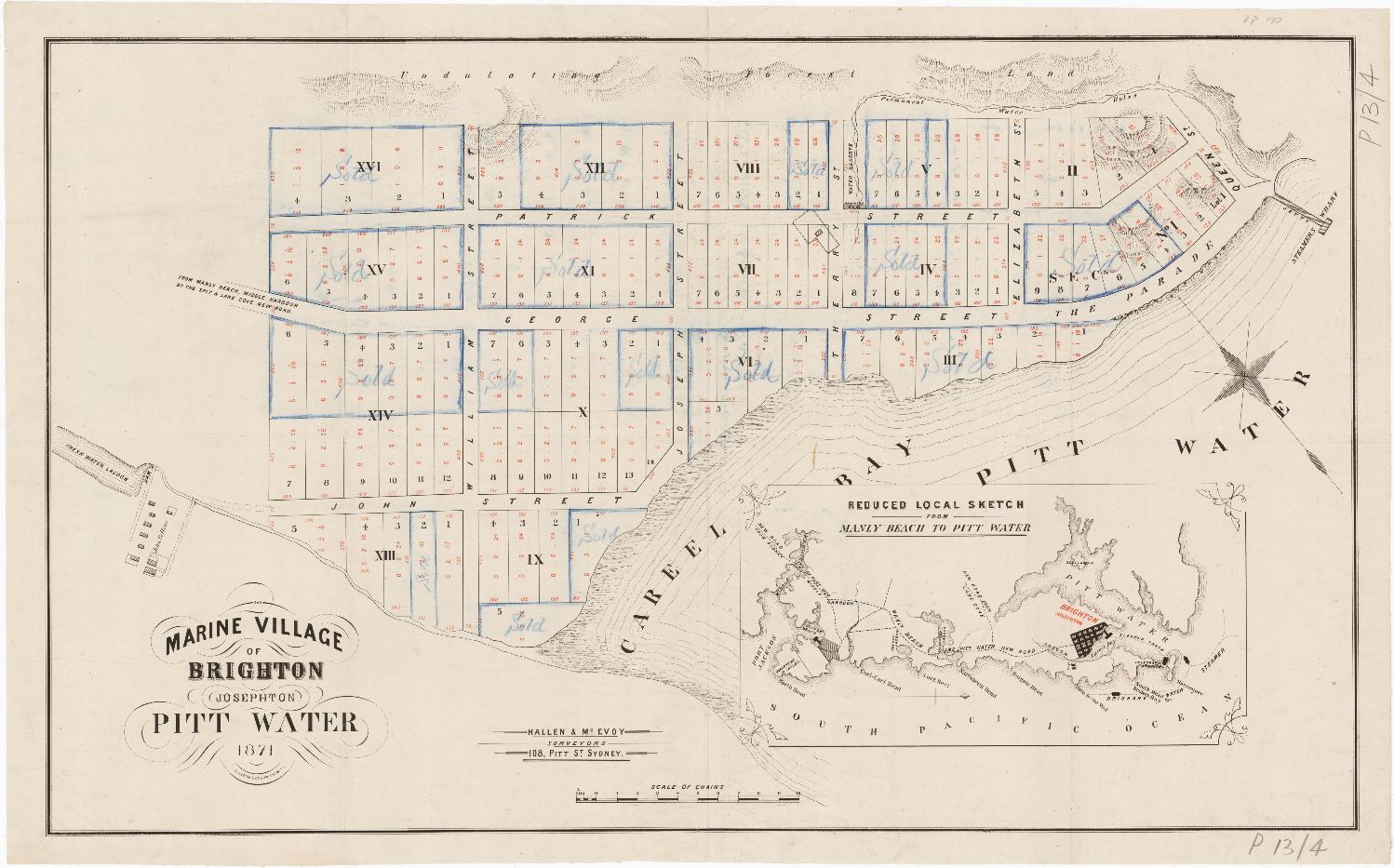
Marine Village of Brighton -Josephton Pitt Water 1871, sections shown Collins Lagoon too - Item c053460004, from Subdivisions folder - courtesy State Library of NSW
BELOW; Sections from (showing sales/owners) Marine Village of Brighton - John St, William St, George St (the Parade), Joseph St, Therry St, Patrick St, Elizabeth St, Queen St, [1871]. Item No: c053460043, courtesy State Library of NSW. Map 2 - among these you can see people such as John Collins of Avalon as well as Albert Black, then Coast Waiter at Broken Bay Customs Station at Barrenjoey, as well as his boatmen, John Connolly and Michael Madden.
Albert Thomas Black and wife Kate had several children while he was Coast waiter in charge of the Broken Bay Customs Station at Barrenjoey. The Mullhulls also were blessed prodigiously with children, while those employed as keepers or as Boatmen for the Customs Station, to 'man' the lifeboats during emergencies, were not opposed to the sound of little feet and joyous laughter either.
To educate their six children, four of whom were born at Barrenjoey (two sons and two daughters) Albert and Kate Black employed a tutor, Patrick Hynes. In Tales from Barrenjoey. Jervis Sparks. 1992, pages 91 - 109 Jervis relates that Patrick Hynes was sixty-one years old when he started working for the Blacks. Irish born and a widower, he was later appointed as a teacher, after Mr Black and his boatmen, John Connolly and Michael Madden, wrote to the authorities requesting aid to set up a school.
Michael and his wife had several children - a Thomas, Patrick, Michael, John and James are listed in the Funeral Notice when he passes away, at Manly, in February 1897. A devout Catholic family, one daughter joined the sisterhood - see the Obituary for this gentleman below.
The residents submitted Hynes' name as a teacher, and proposed to one of the boatmen's cottages, a few hundred metres south on the dunes, as the school.
John Connolly and Michael Madden, and even John's son Michael's son Jeremiah, were in the business of saving lives. There also seems to be a lot of itinerants going on and off the shores around the station and lightship - a few insights into the life and times just before and after Mr. Hynes became teacher/tutor:
SUPPOSED INCENDIARISM AT BARRENJOEY.-Information was brought yesterday morning to the police, that a night or two since a person named Connolly, residing close to the Custom-house station at Barrenjoey, was alarmed by hearing crackling noise apparently on the roof of his house, and on going outside found the building in flames. Connolly had, during a series of years, got together a large and valuable collection of shells, valued some time back by a skilled conchologist at L200, and these were totally destroyed, as well as the main part of the house. An assumption that the fire was the work of an incendiary, is strengthened by the fact that some persons at a distance saw some small flashes of flame before the fire broke out, and thinking the family had not gone to bed, made for the house, which was all in a blaze before they reached it. We believe that Mr. George Smith, J. P., of Manly, who usually attends to such matters, will be despatched by the Government to hold a magisterial inquiry into this very suspicious affair. GOVERNMENT GAZETTE. (1871, April 15).Empire (Sydney, NSW : 1850 - 1875), p. 3. Retrieved from http://nla.gov.au/nla.news-article60871107
We further desire to express our admiration of the heroic conduct of Master JEREMIAH CONNELLY, who nobly ventured out in a small boat with the object of rendering assistance, thereby showing his willingness, and incurring a great risk, to save life, if possible.
P.S.-We enclose a small remittance, which please divide among your crew as you think fit. '
Signed, FRANCIS SMITH, Peacock Point, Balmain. J. C. WALKER, Balmain. GEORGE A. WILLIAMS, Richmond Villa, Domain. THE LATE FATAL ACCIDENT IN BROKEN BAY. (1871, December 29). The Sydney Morning Herald (NSW : 1842 - 1954), p. 10. Retrieved from http://nla.gov.au/nla.news-article13249989
TEMPORARY LIGHTS, BARRENJOEY (BROKEN BAY). The Screens have been removed from these lights. They will now be seen from the southward when Barrenjoey is open, off the South Head of Broken Bay. FRANCIS HIXSON, Superintendent. NOTICE TO MARINERS. (1872, January 20).Empire (Sydney, NSW : 1850 - 1875), , p. 2. Retrieved from http://nla.gov.au/nla.news-article60880257
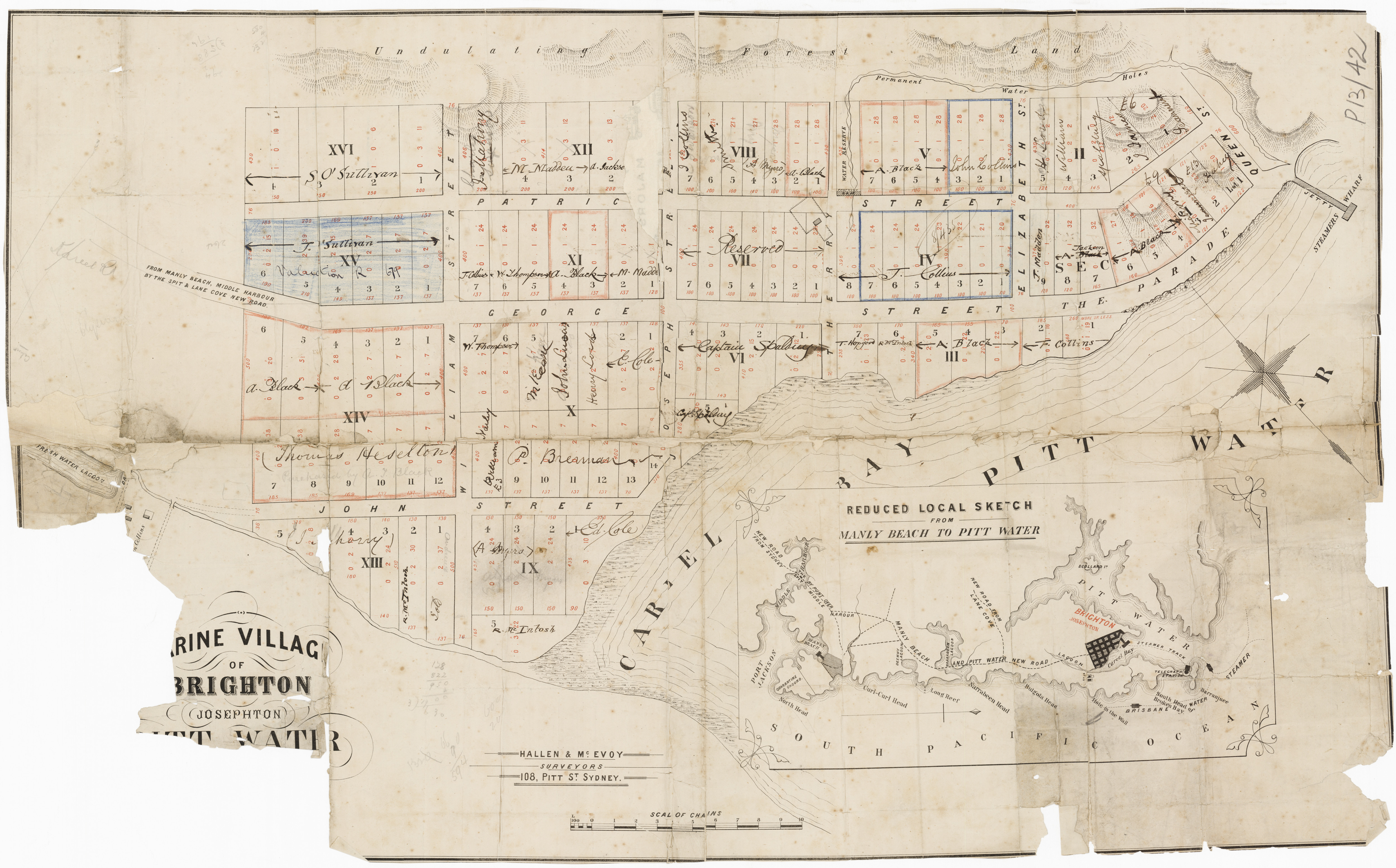
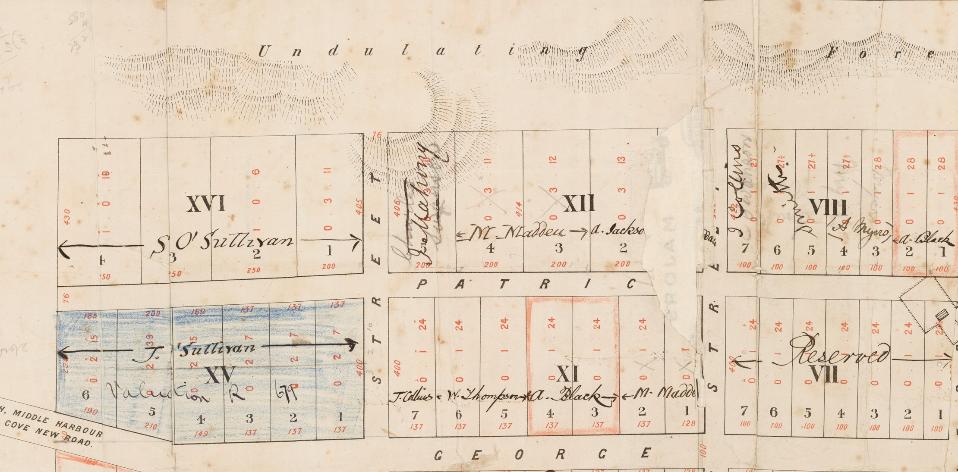
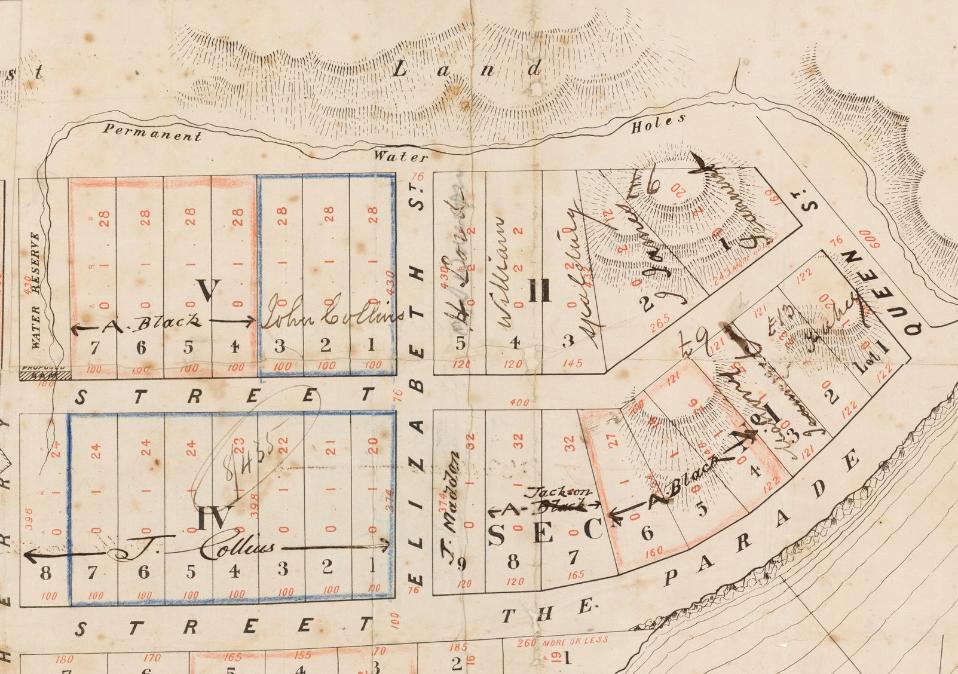
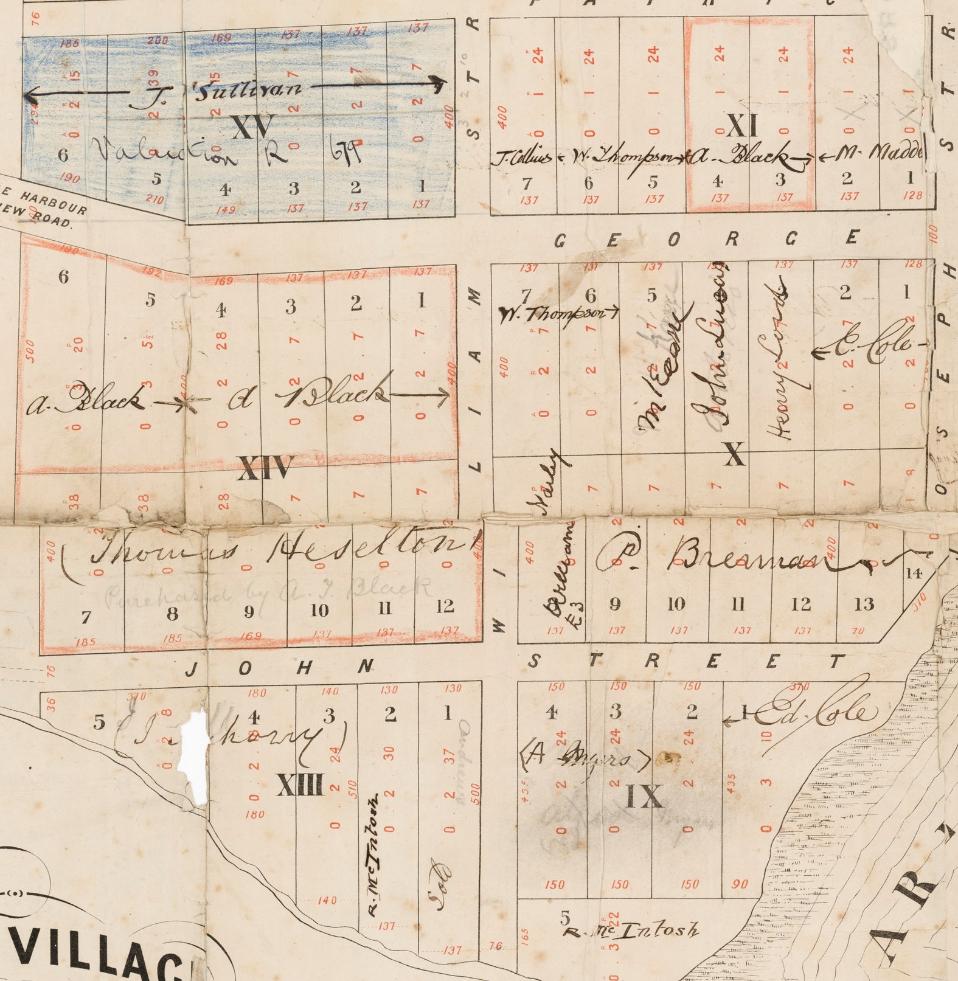
.jpg?timestamp=1591729318905)
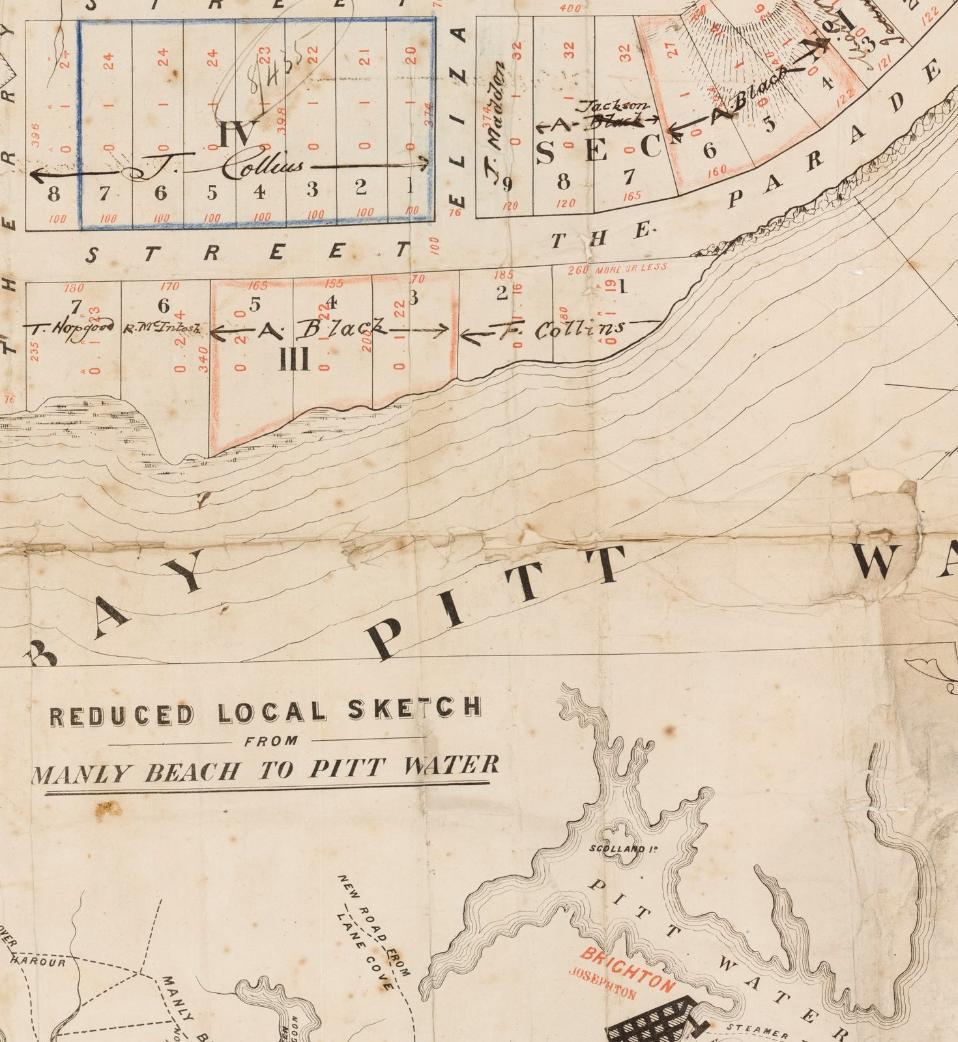
The first sale appears to have been to John Collins on 10 October 1872. [LTO Book 132 No. 924] Collins had built a cottage on Lot 1 of section XIII, which lot was bounded by John Street on the south, William Street on the west, and the creek on the north. He paid the trustees £5, but the value of the lot with its improvements was £40. The lot was to be conveyed to Hannah Andrews, the wife of John Andrews, in exchange for the Andrews’ 50 acres at the Basin, on the opposite side of Pittwater. [LTO Book 132 Nos. 923 & 924] Later, John Collins’ widow Honorah conveyed this land to her son, Patrick John Collins, on 28 September 1887. [LTO Book 372 No.284].
The Careel Bay archipelago itself was held onto until May 1881, with many of the blocks selling immediately;
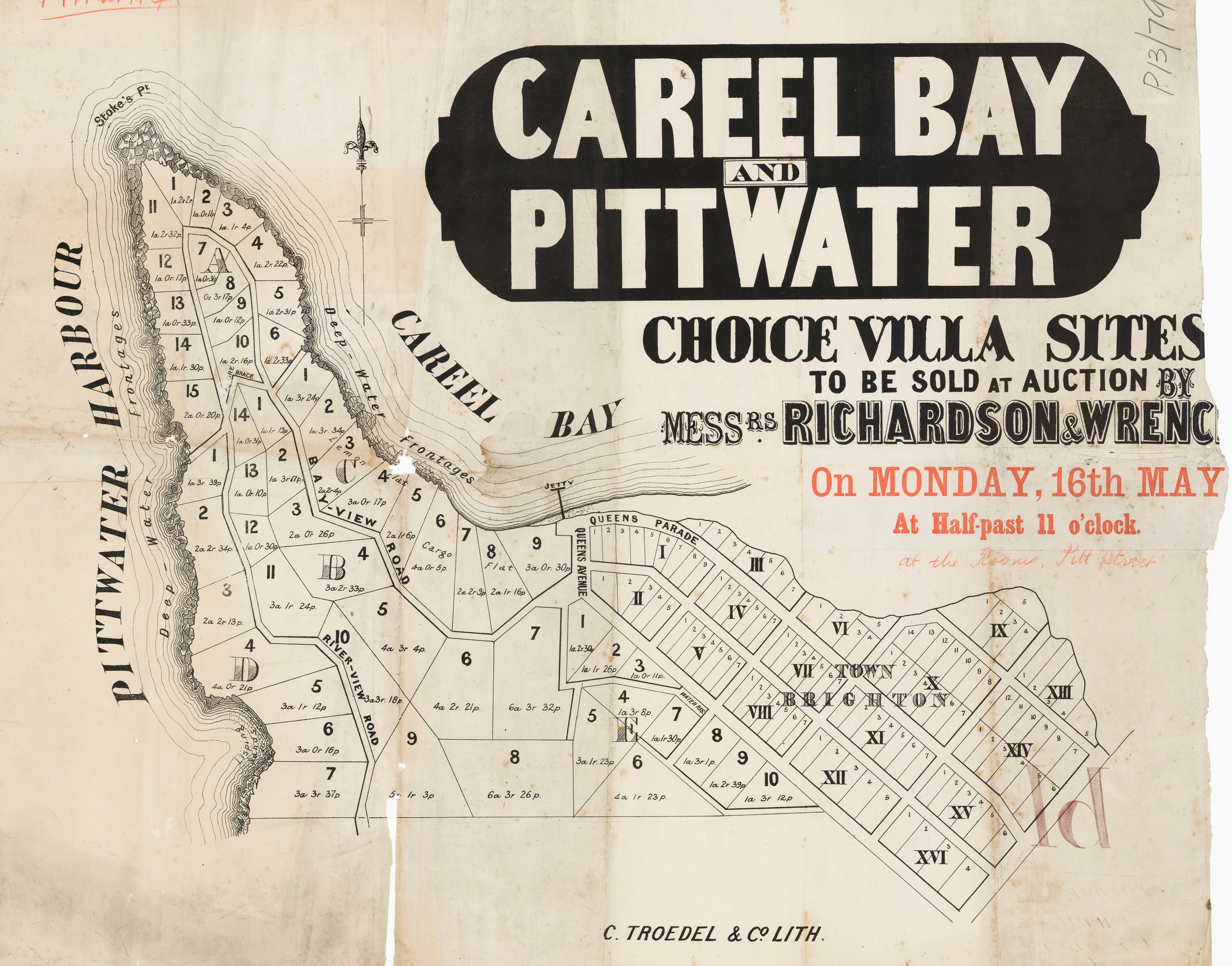
Careel Bay, May 16th, 1881. Land Sale - Item c053460085, from Pittwater Subdivisions folder, courtesy State Library of NSW
Those who bought land, by May 1881, are listed as:
Pittwater estate, subdivision of Father Therry's grant, as follow., viz.:— Stokes Point: Lots 1 and 11, section A, in area 3 acres 0 roods 34 perches, L40 3s Id — Mr. I. J. Josephson, purchaser ; lot 15, section A, 2 acre 0 roods 20 perches, L24I 8s 9d ; lots 3 and 4, section A, 2 acres 3 roods 36 perches, L30 11s 7d — Mr. Francis ; lot 13. section A, 1 acre 0 roods 33 perches, L12 13 3d — Mr. S. Swain ; lot 14, section A, 1 acre 1 rood 30 perches, L15 Is 10d ; lot 12. section A, 1 acre 0 roods. 17 perches, LI1 12-5 4d — Mr. H. Solomon : lot 2. section A, I acre 0 rood 11 perches. Ll l It's 3d — Mr. I. J. Josephson ; lot 10, section A. 1 acre 2 roods Ifi perches, 1/22 S;— Mr. J. Cunningham ; lots 7 to 9, section A, 3 acres b roods 23 perches, L10 12s fid — Mr. F. Smith ; lots 5 and 6, section A, 3 acres I rood 21 perches, L10 Ills— Mr. .J. Cunningham.
Section B, lot 1 and 14, 2 acres 2 roods 4 perches, L22 Ms fid — Mr. R Symons ; lots 2 and 13, 2 acres 3 roods 27 perches, J/23 7s — Mr. J. Hodgson; lots 3 and 12, 3 acres 1 rood Ifi perches, LIS 8s fid— Mr. W. Waterhouse ; lot 4 and 1 1, 7 acres 0 roods 17 perches, L35 Km 7d — Mr. G. Harrison ; lots 5 and 10, 8 acres 2 roods 22 perches, L43 3s 3d — Mr. M. Bayley ; lot 7, 6 acres 3 roods 22 perches, L41 14s — Hon. J. Lucas ; lot 6,4 acres 2 rood 21 perches, L23 3 Id — Mr. A. Myers ; lots 8 and 9, 12 acres 29 perches. L48 14s 6d - Mr Francis
Section C : Lot 1, 1 acre 3 roods, 24 perches L57 19s; Lot 9 3 acres 0 roods 30 perches, l108 7s 6d - Mr. R. Symons; lot 2,1 acre 3 roods 34 perches, L37 5s 9d; lot 3 2 acres 2 roods 4 perches L44 3s 9d - Dr. Milford; lots 4 and 5, 5 acres 1 rood 23 perches, L80 18s 1d - Mr. W. Waterhouse; lot 8, 2 acres 1 rood 16 perches, L50 10s 6d; lot 6, 4 acres 0 roods 5 perches, L66 10s 4d - Mr. Francis, lot 7 , 2 acres 2 roods 9 perches L43 9s 1d - Mr. J. Blannie.
Section D: lots 5 to 7, 10 acres 1 rood 25 perches, L156 1s 10d — Mr. M. Bayley; lot 1. 1 acre 3 roods 33 perches, L2fi 1 8s .Jd ; lot 4, I acre 0 roods 21 perches, L5 1 12s 10d — Mr. Francis; lot 3, 2 acres 2 roods 13 perches, L25 lfis 3d — Mr. G. A. Shipley; lot 2, 2 acres 2 roods 31 perches. LSI 3s lOd — Mr. J. Blannie.
Section E, lots 4 and 7, 3 acres 0 roods 38 perches, L12 Is 8d — Mr. F. Grishrook; lot 8, 1 acre 3 roods 1 perch, Lll Is — Mr. F. Collins lots 3 and 10, U acres 2 roads 11 perches, L28 Ms ; lots 5 and fi, 7 acres 3 roods G perches, LIG Ms Gd — Mr, J. Waudels ; lot 1, J acre 2 roods 30 perches, L20 5s — Mr. J. Hodgson ; lots 2 and 3, 2 acres 1 rood 37 perches, L21 Ifis 3d— Mr. E. Fisher.
North Division : Lots 19 and 20, 14 acres 0 roods 14 perches, L66 18s 6d; lots 12, 13, 15, 16, 21 acres 0 roods 26 perches L53 3s Md— Mr. Francis; lot 14, 5 acres 2 roods 23 perches. L2211s 6d — Mr. H. E. Castle ; lot 8, 4 acre 1 rood 23 perches, L48 1 Is ; lot 7, 3 acres 1 rood 28 perches, L13 0 3d — Mr.R. Symons; lot 9, 7 acres 1 rood 35 perches, 1,21 fin' 5d — Mr. R. M'lntosh; lots 10 and 11,11 acres 3 roods perches, L35 7.s 3d — Hon. J. Lucas; lots 1a and 2a, 13 acres O roods 18 perches, L45 17s 10d — Messrs. Kearey Brothers.
Farms : Lot 3, 128 acres 1 rood 31 perches, with homestead thereon, L770 15s Gd — Mr. G. Lix ; lot 4, 65 acres 0 roods 32 perches, L247 15s 2d — Mr. F. Smith.
South Division ; Lot 5, 4 acres, 2 roods 10 perches, L3fi 10s; lots fi to 8, 27 acres 0 roods 12 perches, LI 50 3s — Mr. Jones; lots 5a to 8a, 37 acres 1 rood 13 perches, LMO fis fid — Mr. Francis; lot 11, 11 acres 1 rood 21 perches, L57 — Mr. J. W. Warren ; lot 9, 25 acres 1 rood 6 perches, L57 17s 11d— Dr. Milford; lot 26, 12 acres 3 roods 8 perches, L64 — Mr. C. E. Jeannerett; lots 16 to 21, 21 and 25, 103 acres 1 rood 17 perches, 1,310 Is 4d ; farm, L44 3s 3d— Mr. Francis; lot 22, 11 acres 0 roods 34 perches, L14 18s — Mr. Renwick. SALES OF PROPERTY. (1881, May 24). The Sydney Daily Telegraph (NSW : 1879 -1883), p. 2. Retrieved from http://nla.gov.au/nla.news-article238300369
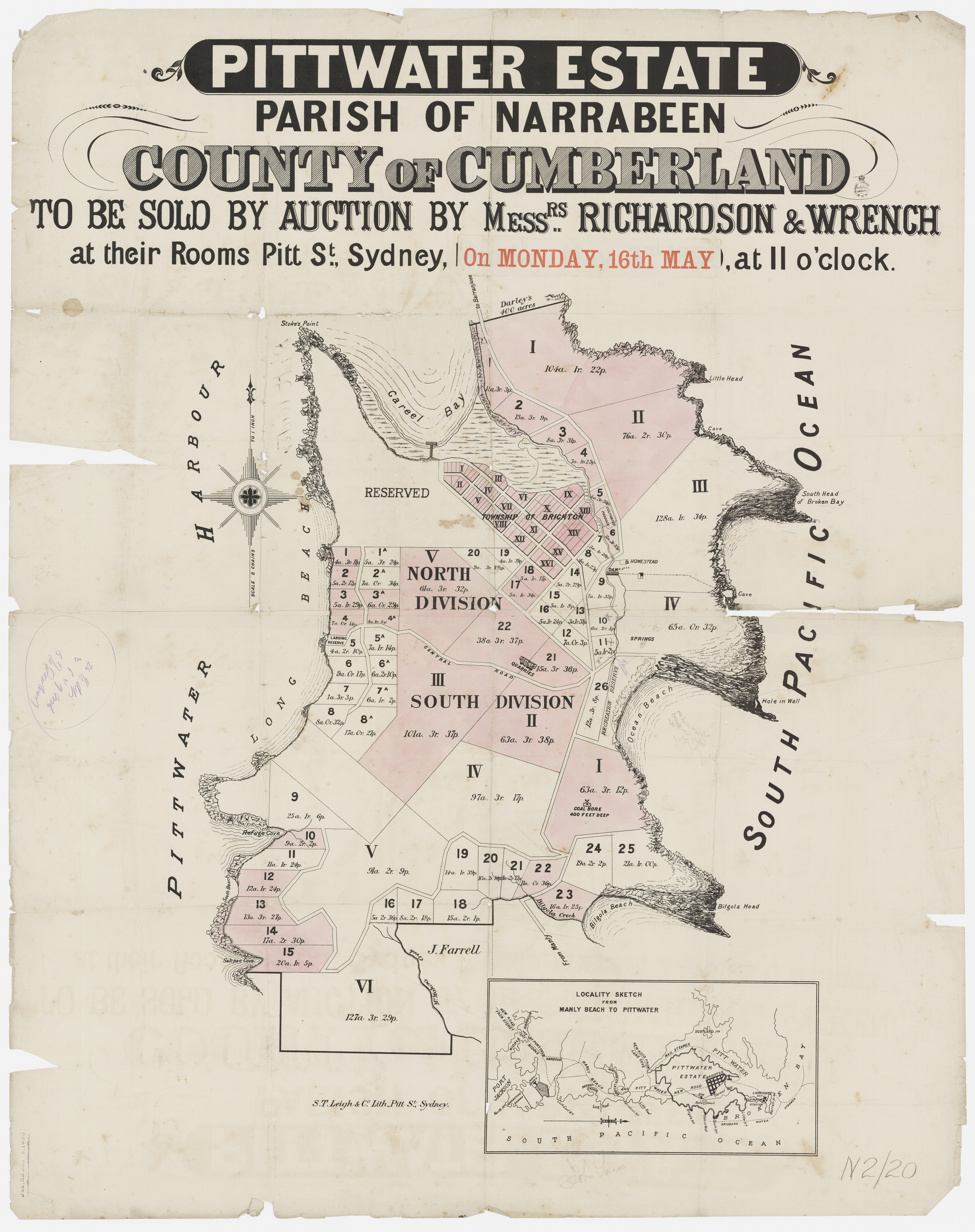
Pittwater Estate, Parish of Narrabeen, County of Cumberland - no boundaries shown, Item c050370020, courtesy State Library of NSW
The Isaac John Josephson land at and on the Stokes Point peninsula Land was Lots 1, 2 and 11 containing 4 acres, one rood and five perches from the original land grant to Thomas Warner of 50 acres, and bought by Mr. Josephson, with the Certificate of Title registered on December 1st 1881 after the May 1881 sales.
This was owned by Arthur James McDonald, solicitor of Sydney, (Vol – Fol 2931-102) by November 1908. Nevertheless, the family of Isaac Josephson held this acreage for 27 years.
Mr. McDonald onsold part of this on February 6th 1928 to Francis Lewis Davies – became Vol-Fol 4120-67 for Davies portion and the home Finsterre was already there via Notices about him in Gazette, which was the tip of Stokes Point facing out into the water comprising 1 acre, 2 roods and 9 ¾ perches – this was then onsold sold to William Illingsworth Hill, Wool Broker on December 21st 1934 –although photos and an article in a magazine indicate the Hill’s made improvements to the grounds.
Mr. Hill sold to Reginald Eric Buckingham, MD of Sydney on May 18th, 1945. This was then transferred to Kenneth Owens Humphreys on April 12th 1976, and registered under United Telecasters Sydney Limited on December 20th of that year. After he passed away the property was registered to his wife Lady Gladys Mary Humphreys who transferred it to John Vincent Toohey on June 6th, 1981.
The Toohey family sold the property to the Oatleys in 2002.
Isaac John Josephson was born Tuesday April 6 1824 in Sydney, a son of Jacob Josephson and Emma (Moses) Josephson and brother of Sarah Emma Wilson [half], Charles Abraham Wilson [half], Henry Charles Wilson [half], Joshua Frey Josephson, Lewis Josephson and Emmanuel (Manuel) Francis Josephson. He became the husband of Juliet Mary (Hanson) Josephson — married 1851.
His father Jacob Josephson, a silversmith, reached Sydney in May 1817 on the Neptune, a convict sentenced to 14 years for forgery. His wife and sons Lewis (infant/toddler) and Joshua Frey arrived on 12 September 1820 or 1821 on the Morley.
Isaac went into commerce as a wool broker among other pursuits. He was a director of the Australian Mutual Provident Society and the Chairman of the Benevolent Society until he passed away. He stood for the Sydney Council in the Bourke Ward - his brother Joseph Frey Josephson was the first Jewish Mayor of Sydney, even though the faily had converted to being Christians vai their mother before they were born, and would later serve in the NSW Parliament.
Isaac, alike his brother, was successful in business and had a passion for sailing.
Mr I J Josephson.-At his Rooms, at eleven o'clock, Wines, Jams and Jellies, damaged Tea. ABSTRACT OF SALES BY AUCTION THIS DAY. (1846, December 17). The Sydney Morning Herald (NSW : 1842 - 1954), p. 2. Retrieved from http://nla.gov.au/nla.news-article12894633
MARRIED: By special license, on Friday, the 14th inst., at St. James' Church, by the Rev. R. Allwood, I. J., youngest son of the late Jacob Josephson, Esq., to Juliet Mary, eldest daughter of J.S. Hanson, Esq. Family Notices (1851, March 22). Bell's Life in Sydney and Sporting Reviewer (NSW : 1845 - 1860), p. 3. Retrieved from http://nla.gov.au/nla.news-article59772208
On the evening of the 7th instant, at his residence, Elizabeth-street, Sydney, Joseph Samuel Hanson, Esq., aged 40 years. Family Notices (1852, June 12). The Maitland Mercury and Hunter River General Advertiser (NSW : 1843 - 1893), p. 3. Retrieved from http://nla.gov.au/nla.news-article668307
FUNERAL.—The friends of the late J. S. Hanson, Esq., are respectfully requested to attend his funeral, to move from his late residence, Elizabeth-street, on Saturday, the 12th instant, at half-past 8 A M. JAMES CURTIS, Undertaker. Hunter-street, June 10. N.B.—No circulars will be issued. 13286 Family Notices (1852, June 11). The Sydney Morning Herald (NSW : 1842 - 1954), p. 4. Retrieved from http://nla.gov.au/nla.news-article12937489
Juliet was just over a decade younger than her husband. They had four sons and two daughters: Francis Jacob (born 1851), Joshua Percy (born 1853), Herbert John (born 1854) Ida M (born 1857 or 1858) Eva M (born 1856), and Arthur William (born 1859).
His sons would also become sailors on the harbour and, it would be expected, on Pittwater as well during the 27 years the family owned this acreage on Stokes Point. Isaac had commenced sailing in the Balmain regattas a few years before being a founding signatory to the Royal Sydney Yacht Squadron - his Obituary relates he built another yacht, the Emma in 1858, although she was sailed by an M F Josephson (Manuel Francis his brother - married a Frederica M Miller in 1853) in regattas of those years, while 'Ida' was the name of his first born daughter. It is likely these two brothers, born close to each other, sailed together into adulthood:
SYDNEY YACHT CLUB REGATTA
Emma, blue with crest . M. F. Josephson.
Gitana, blue peter.J.Nichols.
Zephyr, blue and white burgee ... : . John Cooper.
Silvie, black and red. .. Leggatt
The Gitana took the lead, and kept it for a considerable distance, the Silvie taking rank as second. Emma soon displayed her accustomed superiority, arriving first at the gaol by half a dozen boat's lengths. ... AQUATICS. (1859, April 30). Bell's Life in Sydney and Sporting Reviewer (NSW : 1845 - 1860), p. 4. Retrieved from http://nla.gov.au/nla.news-article59870531
BALMAIN REGATTA
If fair weather, tolerably good sport, and a numerous attendance are to be regarded at essential to the satisfactory management of a regatta, the promoters of the Balmain aquatic festival of this year have certainly been eminently successful, and may justly...
Sixth Race.— To start at half-past 12. For all yachts (centreboard boats excluded). Coarse, from moorings round flagboat in Johnstone's Bay, thence round lightship and Sow and Pigs, back round flagship, thence round Shark Island, and back round flag ship. Time for tonnage, quarter-minute per ton. Prize, £30 ; entrance, £3 3s.
Australian, 4 tons— D. Sheehy — Light blue 1
Mischief, 7 tons— T. J. Dean— Red crops 2
Ida, 7 tons— I. Josephson— Blue, with white star. BALMAIN REGATTA. (1860, December 1). Sydney Mail (NSW : 1860 - 1871), p. 5. Retrieved from http://nla.gov.au/nla.news-article166692329
AUSTRALIAN MUTUAL PROVIDENT SOCIETY.
LIFE ASSURANCE.
ANNUITY AND ENDOWMENT OFFICE.
Principal Office-NEW PITT-STREET, SYDNEY.
DIRECTORS :
George King, Seq., Chairman.
Professor Smith, M.D., Deputy Chairman.
Boulton Molineaux, Esq. I J. F. Josephson, Esq.
Samuel Lyons, Esq. | Edwin T. Beilby, Esq.
Revenue.£160,000 per annum.
Accumulated and Invested Funds:
Half a Million Sterling.
This Society is constituted on the MUTUAL PRINCIPLE, and the whole profits derived from its business belong exclusively to its members, and are divided rateably among them at intervals of five years.
Terms of proposal, and every information respecting the terms upon which LIFE ASSURANCE, ANNUITIES, and ENDOWMENTS are granted, may be obtained from the undersigned, or the agents of the Society in the principal towns throughout the colony.
ALEXANDER J. RALSTON, Secretary, Sydney, 3rd June, 1868. Advertising (1869, May 4). Empire (Sydney, NSW : 1850 - 1875), p. 1. Retrieved August 16, 2023, from http://nla.gov.au/nla.news-article60834317
BENEVOLENT SOCIETY.
The usual monthly meeting of the board was held on Tuesday. Dr. Renwick presided, and there were present Messrs. I. J. Josephson, W. Hanson, E. T. Penfold, J. Graham, H. Hargreaves, G. Renwick, J. Starkey, J. Roseby, W. Crane, the manager (E. Maxted), medical officer (Dr. Warren) an out-inspector (J. Grunt). The minutes of previous meetings being approved, the house return was read. In indicated that 2d women and 29 children had been received during June and that If births had taken place. The discharges were 2S women, 73 children, in cluding 12 deaths. According to the outdoor relief statistics the following provisions, Ac., were issued:— 90GG loaves broad. G205ib. flour, 277Gtb. meat, 21971b. sugar, G24lb. tea, 2sGlb. sago. 3801b. rice, iG211b. oatmeal, 10 pairs blankets, 41b. arrowroot, 4 pairs men's hoots, 14 pairs women's boot?, 19 pairs children's, at a total cost for the whole of £230 2s. fld. A sum of £253 5s. had also been distributed to the outdoor poor. The medical officer sub mitted. his usual monthly summary of cases treated. Accounts were afterwards parsed amounting to .... was laid upon the table and it was shown that 98 books had been issued. The whole of the statistical returns being received the meeting closed and the house committee held its usual weekly meeting. BENEVOLENT SOCIETY. (1887, July 14). The Daily Telegraph (Sydney, NSW : 1883 - 1930), p. 3. Retrieved from http://nla.gov.au/nla.news-article239813251
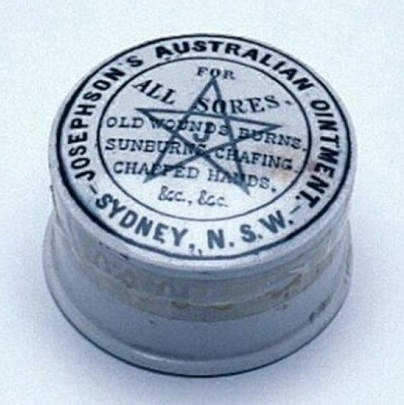 Isaac Josephson passed away in 1897, his wife just a few weeks later:
Isaac Josephson passed away in 1897, his wife just a few weeks later:
JOSEPHSON.—May 31, at his residence, 235 Macquarie-street, Sydney, Isaac John Josephson, aged 73 years. - SMH
DEATH OF I. J. JOSEPHSON.
The death is announced of Mr. Isaac John Josephson, who was for many years a well-known figure in the commercial life of this city. Mr. Josephson passed away yesterday morning at his residence, 235 Macquarie-street, at the ripe age of 73 years. The deceased was a native of the colony. At Easter time, 1894, he was assaulted and robbed, and since then he was never again the same man, but it was not until recently that his end was expected, and he gradually succumbed to hemorrhage, despite the efforts of Dr. Jarvie Hood. The late Mr. Josephson was one of the best known figures about town a few years ago, and was the originator of one of the old-time home cures known- as ''Josephson's ointment."
He was born in the colony in 1824, and when 27 years of age he married Miss Juliet Mary Hanson.
He leaves several children— Mr. F. J. Josephson, for many years alderman at Ashfield and clerk in the Immigration Department, Mr. Percy J. Josephson, Mr. A. J. Josephson,. Miss Ida May Josephson (who is now Mrs. Gleeson), and Mr. A. W. Josephson, the present licensee of the York Hotel, York and King streets.
When, the deceased gentleman first set but to earn his own living he was a clerk to Mr. S. Symons, a well-known city auctioneer, and subsequently Mr. Josephson went into business on his own account. He was a yachtsman in year's past, and on March 17, 1858 he won a prize with the yacht Emma at the Pyrmont Regatta, and on Boxing Day of the same year he won another big race with the same yacht. He also won big prizes with the Ida and the Pert. The funeral will take place to-day. DEATH OF MR. I. J. JOSEPHSON. (1897, June 1). The Australian Star (Sydney, NSW : 1887 - 1909), p. 3. Retrieved from http://nla.gov.au/nla.news-article227199410 - Photo of Jospehson's Ointment from The Collection of the Australian National Maritime Museum
His older brother Manuel shows up in the records as racing the Emma, although they may have raced her together being born and having grown up in the colony and within close age of each other. The Yacht he owned named Ida was named after one of his daughters.
Arthur James McDonald, Solicitor, bought the Josephson Lots on November 1st 1908 and later devised portions of these Lots for his children; Doris Scott Fell, Nellie Loveday (married names of his daughters; one married William Bain Scott-Fell a son of William Scott-Fell) and Reginald Arthur McDonald. He also bought Lot 20 of the 'Villa sites' on August 27th 1918 - this was 10 acres, 2 roods and 14 perches and above Bilgola Beach, according to HRLV. This was one of several Lots originally purchased by Charles Jeanerett during the 1881 sales, but then was resold to the Josephson family in 1884:
Mr Henry Rusael ; Thory's Estate subdivision, Pittwater subdivision, lot 20 of village blocks, in area 10 acres 2 roods 14 perches, L56 4s 7d — Mr I. J. Josephson PROPERTY SALES. (1884, August 9). The Daily Telegraph (Sydney, NSW : 1883 - 1930), p. 2. Retrieved from http://nla.gov.au/nla.news-article237261675
Mr. McDonald served as an officer in WWI, at Gallipoli, but was sent home due to ongoing dysentery and problems with his stomach - a 6 month stretch of it. On his return he served in a some capacity here to help the war effort, returned to work, and also brought the Stokes Point acreage under the Real Property Act:
No. 21,555. APPLICANT:—Arthur James McDonald, of Sydney. LAND:—County Cumberland, parish Narrabeen, shire Warringah, 4 acres 1 rood 5 perches, at Stokes' Point, Pittwater, lots 1, 2, and 11, section A, Stokes' Point subdivision, and part 50 acres (portion 34 of parish) granted to Thomas Warner; adjoining properties of A. H. Delohery and D. W. Solomons.
No. 21,550. APPLICANT:—Arthur James McDonald, of Sydney. LAND:—County Cumberland, parish Narrabeen, shire Warringah. 2 acres, 2 roods 13 perches, near Stokes' Point, Pittwater,— lot 3, section D, Stokes' Point Subdivision, and part 50 acres (portion 34 of parish) granted to Thomas Warner; adjoining properties of F. Kleemo and T. Rook.
Diagrams delineating these lands may be inspected at the Land Titles Office, Sydney.
W. G. H-WILLIAMS, Registrar-General. 13th September, 1918. NOTICE UNDER REAL PROPERTY ACT. (1918, September 13). Government Gazette of the State of New South Wales (Sydney, NSW : 1901 - 2001), p. 4553. Retrieved from http://nla.gov.au/nla.news-article227330895
The family continued to visit Stokes Point and Careel Bay, where he had a house:
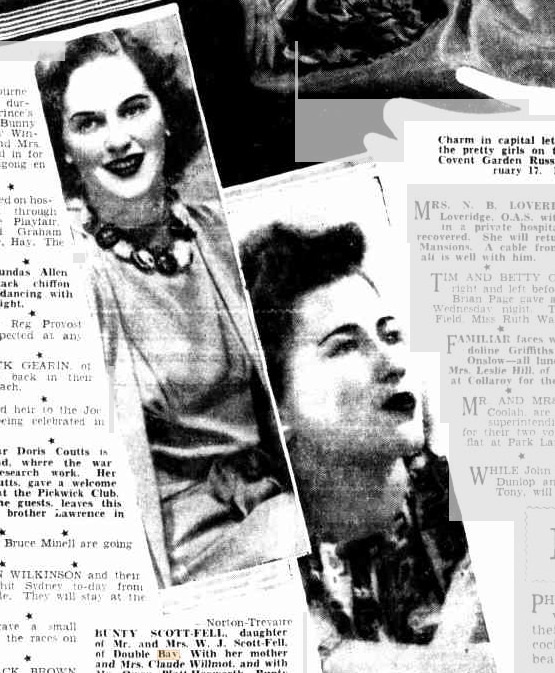
BUNTY SCOTT-FELL, daughter of Mr. and Mrs. W. J. Scott-Fell, of Double Bay, with her mother and Mrs. Claude Willmot, and with Mr. Owen Platt-Hepworth, Bunty will leave soon for a holiday at Careel Bay, where her grandfather, Major A. J. McDonald, has a house. The Jottings of a Lady (1940, February 4). Truth (Sydney, NSW : 1894 - 1954), p. 39. Retrieved from http://nla.gov.au/nla.news-article169104473
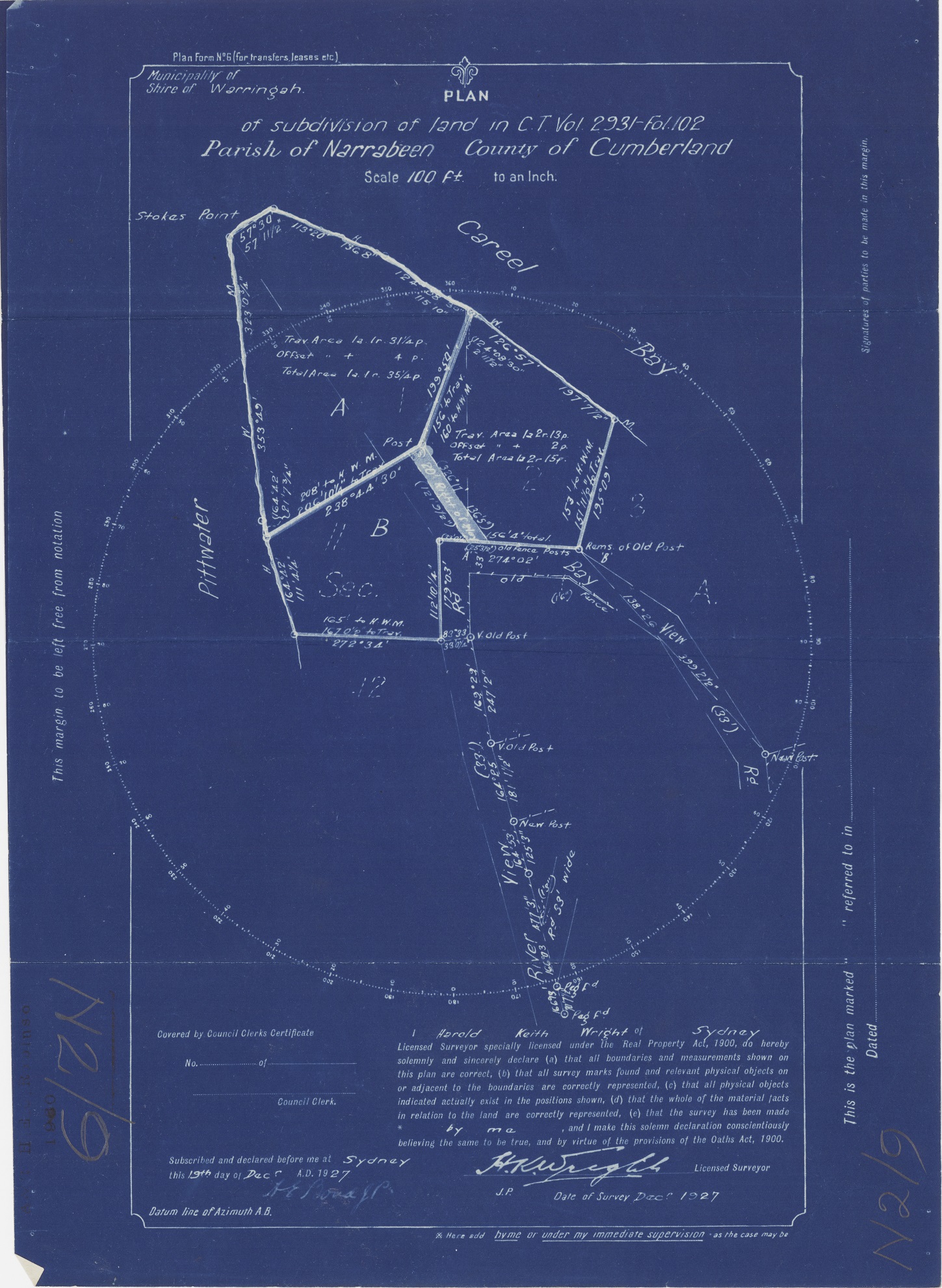
McDonald Careel Bay subdivisions Vol Fol 2931-102 December 1927, courtesy State Library of NSW
The one acre 2 roods and some 9 3/4 perches at the tip end of Stokes Point he sold to Francis Lewis Davies in 1928, with the deed registered on March 28th. Mr. Davies renewed the 'oyster culture lease':
No. 14702; by Francis Lewis Davies at Stokes Point, Pittwater, fronting the applicant's lot "A," parish of Narrabeen, county of Cumberland, frontage about 220 yds. APPLICATIONS FOR LEASES FOR OYSTER CULTURE. (1928, February 3). Government Gazette of the State of New South Wales (Sydney, NSW : 1901 - 2001), p. 617. Retrieved from http://nla.gov.au/nla.news-article223010544
The use of the name 'Finisterre' for the premises also appears when Mr. Davies owned the property:
CARELESS USE OF FIRE ACT, 1912, AS AMENDED BY THE BUSH FIRES ACT, 1930.
Appointment of Honorary Rangers.
THE undermentioned persons have been appointed as Honorary Rangers in pursuance of the provisions of section 8a of the Careless Use of Fire Act, 1912, as inserted by the Bush Fires Act, 1930:—
Davies, Francis Lewis, Finisterre, Stokes Point, Careel Bay, Pittwater. CARELESS USE OF FIRE ACT, 1912, AS AMENDED BY THE BUSH FIRES ACT, 1930. (1930, December 19). Government Gazette of the State of New South Wales (Sydney, NSW : 1901 - 2001), p. 4955. Retrieved from http://nla.gov.au/nla.news-article220234670
BIRDS AND ANIMALS PROTECTION ACT, 1918- 1930.
Appointment of Honorary Rangers.
THE undermentioned persons have been appointed as Honorary Bangers, in pursuance of the provisions of the Birds and Animals Protection Act, 1918-1930:—
Francis Lewis Davies, Finisterre, Stokes Point, Careel Bay. BIRDS AND ANIMALS PROTECTION ACT, 19181930. (1930, November 14). Government Gazette of the State of New South Wales (Sydney, NSW : 1901 - 2001), p. 4580. Retrieved from http://nla.gov.au/nla.news-article220233247
RANGERS' LEAGUE. Mr. Francis Lewis Davies has been appointed honorary secretary to the Rangers' League. Mr Percy A. Meggy, who until recently held the office of honorary secretary, is now the honorary editor for the league. RANGERS' LEAGUE. (1931, June 19). The Sydney Morning Herald (NSW : 1842 - 1954), p. 10. Retrieved from http://nla.gov.au/nla.news-article16787048
THE RANGERS' LEAGUE.
(To the Editor).
Sir, — The Rangers' League, which was established for the purpose of giving practical service in its work covering the protection, and preservation of our unique and wonderful Australian Flora and Fauna and the other natural and special features of our country, has already made surprising progress.
Being the first organisation of its kind, the work of the League has been; mainly pioneering. Much field work has. been accomplished valuable assistance has been rendered by the Government, and also 'by public and private organisations ; this . has helped in large measure to bring about the success 'which has been achieved. The team work of the members, the general increasing . interest, and the - praise and sympathy received from many sources, are very encouraging.
The' League, is under the control of a Council representative of its manifold, activities, such as ecology, botany, etc!, while the more immediate supervision is entrusted to an executive. The service rendered by the members is given in a purely honorary' capacity, and each member is expected to contribute assistance in some form; this service is supplemented, as far as possible, with available funds.
Several acts, of great interest to Rangers, are in course of amendment by Parliament,- and it is pleasing to note that suggestions by the League for the amendment of the Birds and Animals Protection Act have been accepted and included. The continued success of the League depends upon the individual and united effort of each of us. It is the duty of all Australians to do their utmost to protect and preserve our native birds, animals. plants and flowers, which are becoming more rare and even extinct. In our own interest and in that of our children, these must be regarded as an everlasting heritage to be handed down to future generations: As a means to that end, the -League is commended to you ~f or your generous support. Th secretary will be pleased, to receive inquiries from individual Rangers and all others who are interested. — Yours, etc., J. D, TIPPER, President. THE RANGERS' LEAGUE. (1930, June 21). Molong Express and Western District Advertiser (NSW : 1887 - 1954), p. 2. Retrieved from http://nla.gov.au/nla.news-article139979951
Stokes Point during the 1930's was still a place of towering gums, with Warringah Shire Council records showing one resident complaining to the Council about the cutting down of huge trees on his property and threatening to sure them for doing so. Another is complaining of people using a path through their block to walkin in and access homes further out along the Point and threatening to close the gate and block the thoroughfare unless Council put a decent passable road in. Careel Bay, outside of the permanent fishermen and their families who had lived there, was a place far removed from the dusty hot streets of Sydney town. Well into the 1930's those who lived there all year round and those who had places they fled to during the cooler months of for the Summer 'Season' sought to preserve the natural beauty and wildlife that lived there - such as trees filled with koalas - the Wilson 2 acres down by the bay were called 'Koala' - and would voluntarily undertake these Honorary Ranger roles in order to do something about those that would destroy the the trees and animals, as Francis Davies did.
Stated by himself to be born in March 2nd 1896 at Santa Clara California USA to an Elizabeth Montague nee Smith and Lewis James Davies, shipowner (one of three sons of a Captain Lewis Davies - also a shipowner). His father became richer as a merchant and through importing cars of all brands and later Fords into Australia with his then partner Mr Fehon and later, his brother Arthur Henry. Arthur Davies was the father of Muriel Nora Davies (Cherry), later Jackaman, in 2009 awarded an OAM 'For service to heritage conservation through the National Trust of Australia'.
His parents had married in Santa Clara in January 1895 and they came to Australia around 3 weeks later. They were later divorced after a, for then, scandalous petition in December 1903 with hearsay published in the newspapers of the time, wherein Mrs L J Davies had apparently stated she was going back to America and marrying a man she had been seeing since meeting him on the boat that brought her back to Australia in 1899.
Lewis James Davies remarried in 1906 to a Linda Sparke. L J Davies and his brother were both avid aquatics men, stated in found records to have yachts as well as motor vessels. Arthur was a member of both the Royal Motor Yacht Club and Royal Prince Alfred Yacht Club.
Francis Lewis Davies was 19 and 8 months when he signed up to serve in the AIF in the Medical corps. Francis is described as being 6 feet tall with a fair complexion, blue eyes and brown hair and was working as a Bank Clerk at the time. He had to get a signed permission letter from his father to do so:
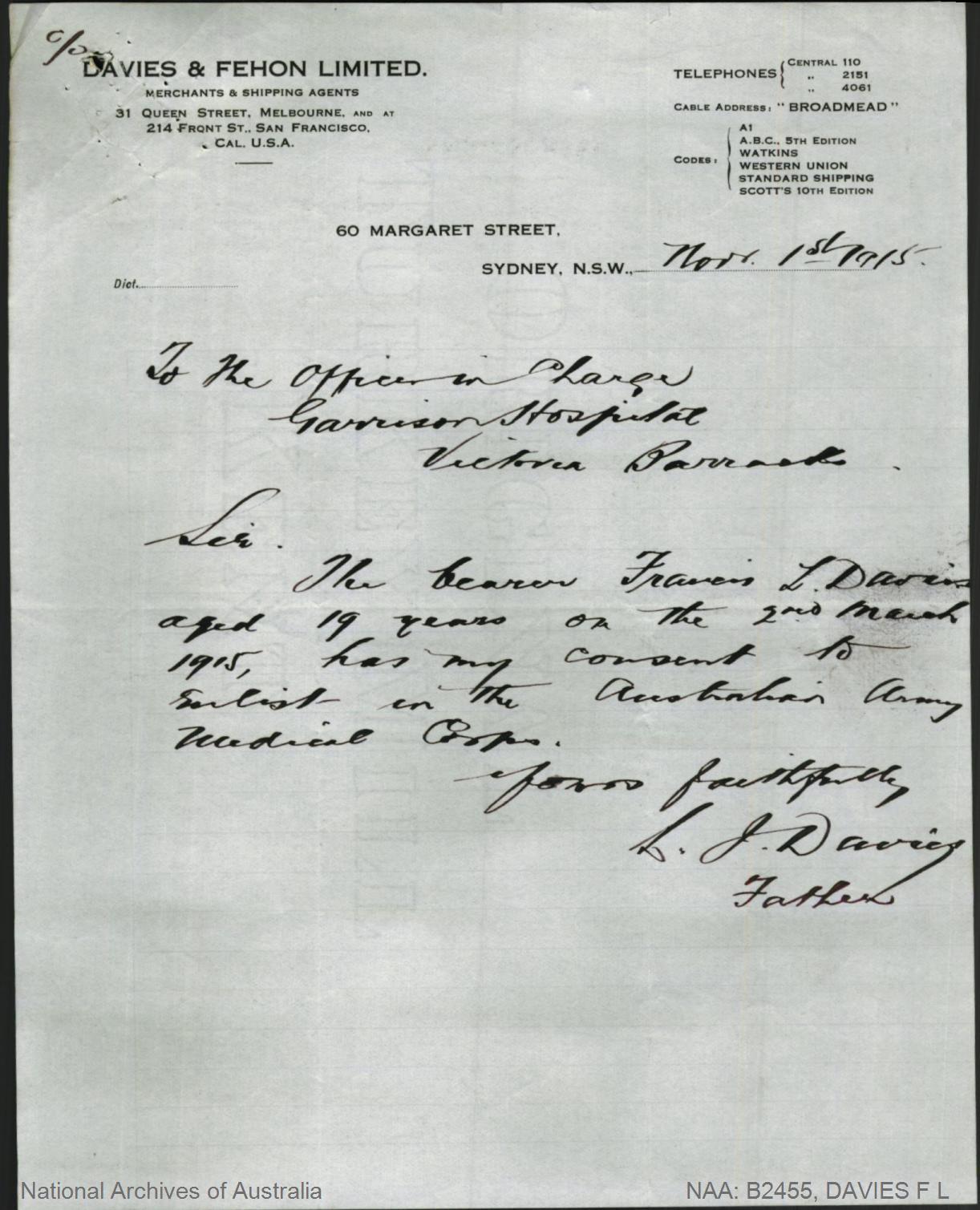
He was sent into France by June 1916 and immediately transferred into the BMTD (Base Mechanical Transport Depot) at Rouen. By December he had been transferred to the hospital, sick, re-joined his unit 7 days later and was transferred into the 3rd Australian Infantry Battalion by early 1917 and was sent into Ypres with them and later the Somme. Towards the end of 1918 he was made a temporary Corporal.
In late January 1919 he went to the U.K. on leave and was at an address given as 'Innisfallen, Warren Drive, New Brighton, Cheshire' until March 1919 when he left to return to Australia via America at his own expense, possibly to visit his mother. There was some resentment held towards her by his grandfather, taken out on him in excluding any child L J Davies had with her from his will.
Francis was married twice too - in 1927 to Maude Davies, only daughter of Captain David Lewis Davies of Chatswood, who reads as a cousin, and in 1934 to Frances W Allen, also of Chatswood, and in the same year 'Finisterre' is sold it to William Illingworth Hill, wool merchant and a nephew of Sir James Hill, who once bought the whole wool clip in New Zealand and Australia.
A Sydney Birth Notice shows the F L Davies had moved to Victoria, although they must have returned as F L Davies passed away in Sydney in 1970:
DAVIES (Win Allen Northbridge).-September 21, at Community Hospital, Brighton, Melbourne, to Mr. and Mrs. F. Davies, of Frankston-a son. Family Notices (1938, September 24). The Sydney Morning Herald (NSW : 1842 - 1954), p. 10. Retrieved from http://nla.gov.au/nla.news-article17521865
The name for the home and grounds when owned by Francis Lewis Davies probably originates from Cape Finisterre - a rock-bound peninsula on the west coast of Galicia, Spain. Cape Finisterre has several beaches, including O Rostro, Arnela, Mar de Fora, Langosteira, Riveira, and Corbeiro. Many of the beaches are framed by steep cliffs leading down to the Mare Tenebrosum (or dark sea; the name of the Atlantic in the Middle Ages).
In Roman times it was believed to be an end of the known world. The name Finisterre, like that of Finistère in France, derives from the Latin finis terrae, meaning "end of the earth". It is sometimes said to be the westernmost point of the Iberian Peninsula. However, Cabo da Roca in Portugal is about 16.5 kilometres (10.3 mi) farther west and thus the westernmost point of continental Europe. Even in Spain Cabo Touriñán is 124 metres (135 yards) farther west. There are several rocks in this area associated with religious legends, such as the "holy stones", the "stained wine stones", the "stone chair", and the tomb of the Celtic crone-goddess Orcabella. Cape Finisterre is the final destination for many pilgrims on the Way of St. James, the pilgrimage to the shrine of the apostle Saint James the Great in the Cathedral of Santiago de Compostela. Cape Finisterre is about 90 km (50 miles) from Santiago de Compostela.
One of the Enemark panoramas, taken from present day McKay Reserve, along with another taken from around the junction of Careel Head road and Whale Beach road, when enlarged and cropped to show that section a two storey stone house with large square windows perched on Stokes point, a fair way back from the current position of the house, can be seen. A pier from the property into the east and Carrel Bay is also visible in 11, while the sections in panorama '1', although not as clear, show either tents or stone being quarried in a cleared site to erect a sandstone dwelling from stone found on that site - a common practice for many of the older Palm Beach houses that are still present today. 'Florida House' and the home named 'Kookaburra' next door are two good examples. These were built by stonemason Laurie Gallagher in concert with the Verrills family - Laurie also won the contract to build the Ocean road along the beachfront. Further up the hill, and overlooking Whale Beach, 'Careel House' as is another example.
The Enemark Panoramas of Palm Beach and Whale Beach were taken in at least two lots over a few years. Those for Palm Beach show the changes in houses built in 1915 to 1919 and those that had been completed in 1921 - lending support to the same occurrence for these of Careel Bay ones when they were taken for the Barrenjoey Company selling Lots at Whale Beach from 1920 to 1921 and later.
Arthur James McDonald's sale of the Stokes Point Lot of just over one acre to Francis Lewis Davies was registered with the Title office on March 12th, 1928. Although they ay have improved on the weekender the Josephson's used over the almost 3 decades they had the land, further snippets found in the pages of the past show the McDonald Careel Bay holiday home was tucked inside the bay, and remained part of the family over succeeding generations, even if his three children did subdivide and sell off parts of the acreage given to them by their father. A few notes even provide the name of their 'shack':
With her brother, and her dance partner, Owen Platt Hepworth, in camp, Bunty Scott Fell's vacating the city for a week . . . goes with her mother, and aunt, Mrs. J. A. Loveday, to the family house at Careel Bay. They "Looked Sweet on Bicycles" (1939, October 29). The Sun (Sydney, NSW : 1910 - 1954), p. 26. Retrieved from http://nla.gov.au/nla.news-article231217705
At. Careel Bay, Mr. and Mrs. Scott Fell, are in residence with their daughter, Miss Buntye Scott Fell. To call them to the telephone, you must first ring a number — tell whoever answers you whom it is you wish to speak with, and then wait for the cowbell to ring at the other end of the telephone, so many times for such and such a person. On Christmas night there will be a dance at the Scott Fell residence, to which will go many Palm Beach-ites. Later they will call in at the Pacific Club. Some Are In 'Wigwams' (1939, December 24). The Sun (Sydney, NSW : 1910 - 1954), p. 13 (SPORTING SECTION). Retrieved from http://nla.gov.au/nla.news-article231495468
BUNTY SCOTT-FELL, daughter of Mr. and Mrs. W. J. Scott-Fell, of Double Bay. With her mother and Mrs. Claude Willmot, and with Mr. Owen Platt-Hepworth, Bunly will leave soon for a holiday at Careel Bay, where her grandfather, Major A. J. McDonald, has a house. The Jottings of a Lady (1940, February 4). Truth (Sydney, NSW : 1894 - 1954), p. 39. Retrieved from http://nla.gov.au/nla.news-article169104473
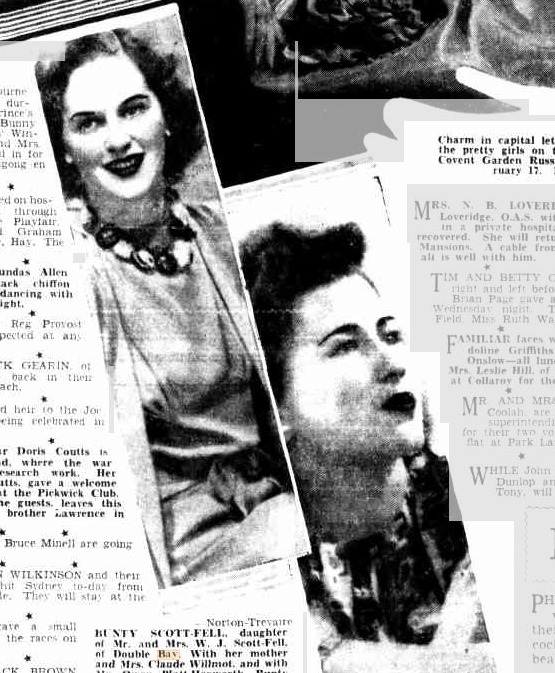
HOLIDAY away from the heat of the country for Mr. and Mrs. Reg McDonald, of Redbraes, Quirindi, when they come to Mambooloo, Stokes Point, for few weeks. The Mc Donalds' daughter Judy and her husband, John Simson, of Quirindi, are delighted that they have struck a bore after long months of waiting, so now they can commence building their own home. Intimate, Jottings (1950, February 4). The Australian Women's Weekly (1933 - 1982), p. 19. Retrieved from http://nla.gov.au/nla.news-article47230238
Those panoramas that show what was on the point during the Josephson- McDonald-Davies ownership:
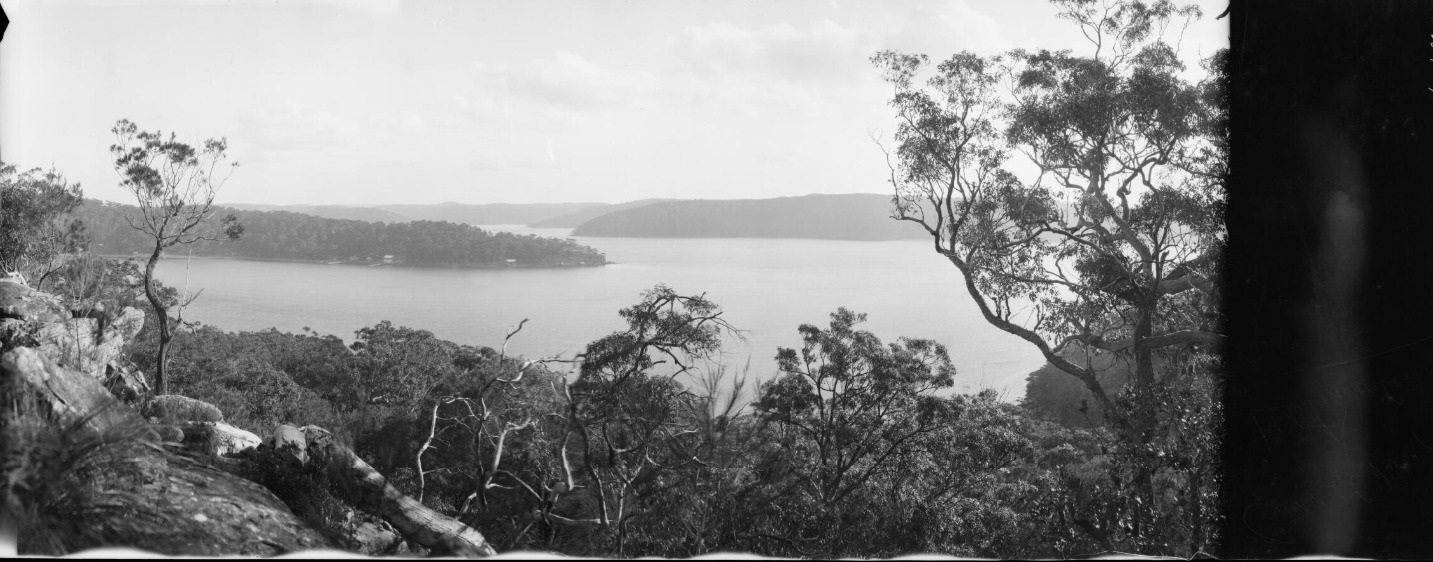
%20Stokes.jpg?timestamp=1692506735149)

EB Studios (Sydney, N.S.W.). (1917-1927). Panorama of Careel Bay, Pittwater, New South Wales, 1 Retrieved from http://nla.gov.au/nla.obj-162411339
.jpg?timestamp=1692505453118)
.jpg?timestamp=1692505510753)
.jpg?timestamp=1692505623674)
EB Studios (Sydney, N.S.W.). (1917-1946). Panorama of Palm Beach, New South Wales, 11 Retrieved from http://nla.gov.au/nla.obj-162487775
Lewis Francis Davies' sale of 'Finisterre to William Illingworth Hill was registered with the Title Office on December 21st, 1934.
W I Hill Married in 1916:
The marriage of Miss Daisy Dobell, daughter of Mr. W. Dobell, of St. Elmo, Waverley, and granddaughter of Mr. Frederick Leopold Wethered, of Seymour Court, Marlow, England, to Mr. William Illingworth Hill, of Bolton Abbey, Bradford, England, took place on Wednesday at St. Elmo. The bride, who has recently returned from a trip to America, wore a smart tailored cream suit and a white aerophane hat, lined with hatter's plush and adorned with a mother of pearl cabachon. On leaving later for Brisbane the bride travelled in a grey coat and skirt and a grey Tagal Breton sailor hat. WOMEN'S NEWS (1916, December 24). Sunday Times (Sydney, NSW : 1895 - 1930), p. 5. Retrieved from http://nla.gov.au/nla.news-article121334557
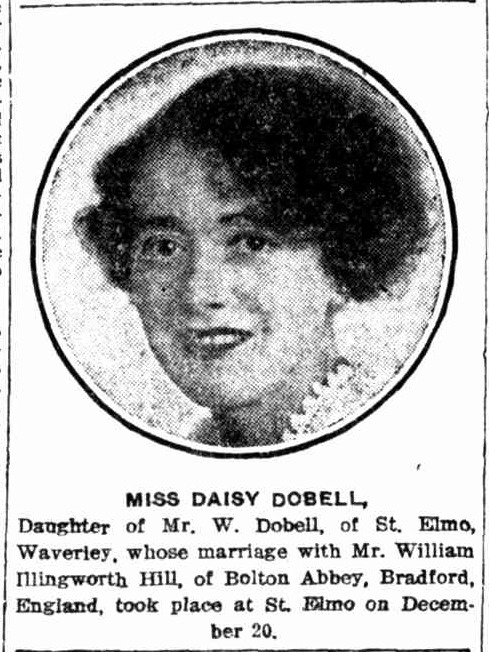
MISS DAISY DOBELL, Daughter of Mr. W. Dobell, of St Elmo, Waverley, whose marriage with Mr. William Illingworth Hill, of Bolton Abbey, Bradford, England, took place at St. Elmo on December 20. WEDDINGS (1916, December 31). Sunday Times (Sydney, NSW : 1895 - 1930), p. 26. Retrieved from http://nla.gov.au/nla.news-article121349832
Daisy Dobell, born in 1890, the eldest daughter and first born child of Mary Frances and William Dobell, Company Director, appears to have been a great swimmer, appearing in results for the 'Bondi Mermaid Club' when she lived in Waverly:
French Conversation (Madame Giraud’s prizes) -Riley Smith and Doris Rook, principal's prize; Daisy Dobell. RIVIERE COLLEGE. (1905, December 18). The Sydney Morning Herald (NSW : 1842 - 1954), p. 3. Retrieved from http://nla.gov.au/nla.news-article14751877
THE WEEK'S SWIMMING.
BONDI MERMAIDS' CLUB.
The Bondi Ladies' Swimming Club's races at Jack Helling's Bondi Baths, a mermaid's revel last Friday, resulted as follows; 33yos Point Race. — Amy . Cutler, scr, 1 ; Yolande Cadden, 4sec, 2; Daisy Dobell, 3sec, THE WEEK'S SWIMMING. (1908, November 25). Sydney Sportsman (Surry Hills, NSW : 1900 - 1954), p. 8. Retrieved from http://nla.gov.au/nla.news-article166738672
The annual carnival of St. John's Parochial School, Darlinghurst, was held at Farmers Rushcutter's Bay Baths, the results being: Ladies' Club with the following results: — 50yds: Yolande Cadden, 6sec, 1; Daisy Dobell and Beatrice Smith, dead heat, 2. 32yds: Myrtle Vine, 4sec, 1; Mrs. Jones, 10, 2; Ruby Dobell, scratch, 3. SWIMMING. (1909, March 9). Evening News (Sydney, NSW : 1869 - 1931), p. 2. Retrieved from http://nla.gov.au/nla.news-article113352880
Mrs W Dobell Miss Daisy Dobell R.M.S. OSTERLEY, FOR LONDON. (1914, March 11). The Sydney Morning Herald (NSW : 1842 - 1954), p. 14. Retrieved from http://nla.gov.au/nla.news-article15474054
Her mother passed away in September 1916, her father in April 1920, leaving an estate that was divided between their six children and included, for those of their four daughters already married, bequests for their husbands as well. Daisy took on the role of 'mother' after they passed, with the first to marry afterwards being hosted by her and her husband at a Manly home, indicating her passion for the water persisted and possibly helped the Hills decide on their Pittwater purchase, even though they didn't stay at Manly too long and had a 'house near the city' before the Harbour Bridge was built, as well as their Stokes Point 'weekender'.
WILLS AND ESTATES:
The will dated 20th March, of the late Mr William Dobell, company director, of “St. Elmo,’' Botany street, Waverley, who died on 31st March, has been presented at the Probate Office, Melbourne, for resealing. Testator left £46,481 estate in New South Wales and £6811 in personalty in Victoria to his widow, children and relatives. WILLS AND ESTATES: (1920, September 29). The Ballarat Star (Vic. : 1865 - 1924), p. 1. Retrieved from http://nla.gov.au/nla.news-article213371667
In early 1936 W I Hill's uncle passed away and the Hills went to Europe:
Sweeper to Wool King
DEATH OF SIR JAMES HILL
LONDON, Friday
Sir James Hill, pioneer of the wool ; trade, and one of the biggest buyers in Australia and New Zealand, died to-day. Hill operated before the era of public auctions. He and the late Lord Barnby once bought nearly the whole New Zealand clip. Hill started life as a sweeper and firelighter in a woollen mill, after driving a donkey cart at 10 years old to buy green groceries, which he hawked with his grandfather. He demanded £1000 a year; when 10 years of age, and, when his employers refused, he started on his own account with £50, which he had saved. Within 30 years he was negotiating deals of millions of pounds. Sweeper to Wool King (1936, January 18). Wagga Wagga Express (NSW : 1930 - 1939), p. 2. Retrieved from http://nla.gov.au/nla.news-article207550371
SIR JAMES HILL.
Wool Pioneer Passes.
PICTURESQUE CAREER
LONDON, Jan 18
The death occurred yesterday of Sir James Hill, Baronet, a pioneer of the wool trade, and one of the biggest buyers of Australian and New Zealand wool.
He operated before the era of public auctions and he and the late Lord Barnby once bought nearly the whole of the New Zealand clip. His surviving son, Mr. Albert Hill, inherits the title.
Sir James Hill, who was 86 years of age, started out in life as a sweeper and fire-lighter in a woollen mill, after having driven a donkey cart as a 10-year-old boy to buy green-groceries, which he hawked with his grand-father. He demanded a salary of £1000 a year when he was l8. His employers refused his demand, so, having saved £50, he started on his own account, and was negotiating deals involving millions of pounds, within 30 years.
The late Sir James Hill had four nephews in Australia, all connected with the wool industry, one of whom is Mr. W. I. Hill, of W. and D. Hill (Aust.), Ltd., of Sydney. SIR JAMES HILL. (1936, January 20). The Sydney Morning Herald (NSW : 1842 - 1954), p. 11. Retrieved from http://nla.gov.au/nla.news-article17208446
W and D Hill was formed at the same time they bought Finisterre:
New registrations; W AND D HILL (AUST LTD) capital £10,000 to carry on the business of wool and skin brokers etc Subscribers G Dobell, Daisy Hill, Vivienne Dobell ,Kathleen Garland, A Garland, M Fairfax, H J Brigden. COMPANY NEWS. (1934, August 21). The Sydney Morning Herald (NSW : 1842 - 1954), p. 11. Retrieved from http://nla.gov.au/nla.news-article17094705
W. AND D. HILL (AUST.) W. and D. Hill (Australia) Pty. Ltd. earned a profit of £3,373 in 1937-38. Profit of the Sydney branch was £3,673, and the Melbourne branch incurred a loss of £300. W. AND D. HILL (AUST.) (1938, December 6). The Argus (Melbourne, Vic. : 1848 - 1957), p. 4. Retrieved from http://nla.gov.au/nla.news-article12072290
W. & D. Hill (W.A.) Ltd. 1066 per R. Jowett & Sons Ltd ; 616 S Shippers; 4435 6239 Total Wool ........... 6901 OVERSEAS EXPORT MANIFESTS (1951, February 7). Daily Commercial News and Shipping List (Sydney, NSW : 1891 - 1954), p. 2 (Supplement to "Daily Commercial News and Shipping List."). Retrieved from http://nla.gov.au/nla.news-article163822317
Their return after the 1936 visit to Europe was announced in the 'social's of that day:
THE 'Billy' Hills are back once more from Europe, and are at present at their seaside home, 'Finisterre,' Careel Point, Pittwater. They spent a lot of time motoring through England and Scotland, and paying the odd visit to various relatives. The Jottings of a Lady ABOUT TOWN (1936, August 9). Truth (Sydney, NSW : 1894 - 1954), p. 31. Retrieved from http://nla.gov.au/nla.news-article169583103
Soon after they returned from this jaunt the W I Hills then did some 'additions and remodelling' of Finisterre, pictures of which were published in June 1938:
REMODELLED
Alterations and Additions to Modernise a Seaside Home
NO matter how up-to-the-minute a home is when it is built, it is inevitable that in the course of time it will become out of date. Some houses wear better than others, and some styles and periods take longer to date. In fact, some of the faith-fully-built homes in such styles as Colonial, Tudor, and English cottages never date themselves. It is only in equipment, built-in fittings, and devices that they become behind the times.
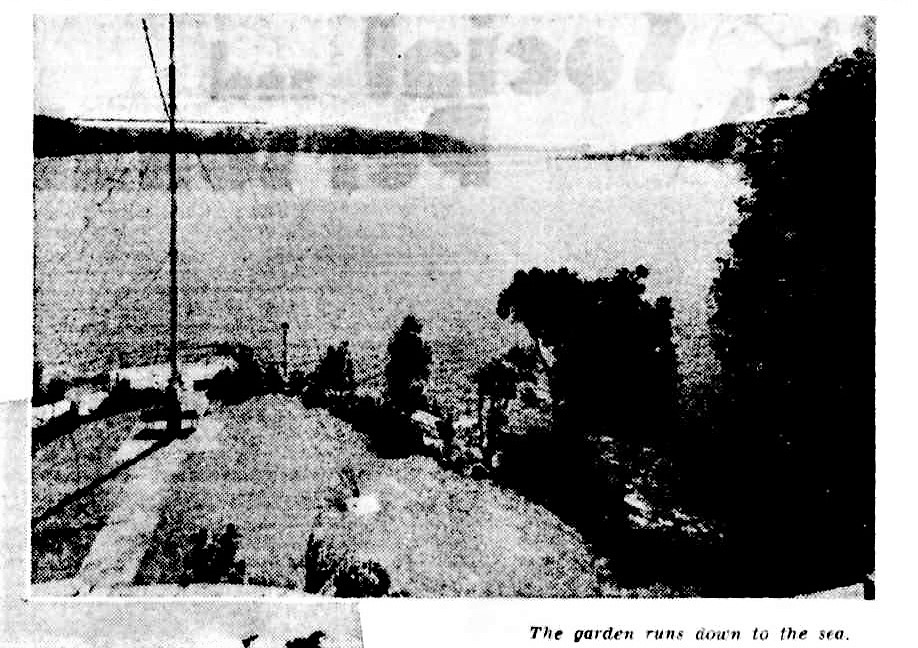
.jpg?timestamp=1692509734720)
The garden runs down to the sea.. (Left.) Cobbled pathways make pleasant breaks in the wide lawns.
.jpg?timestamp=1692509854083)
The house in its picturesque setting.
THE work of remodelling and the designing of additions call for greater skill than does the planning of an entirely new structure; that is, if the spirit of the original work is to be preserved, and this is usually the reason for remodelling as distinct from rebuilding.
Modern methods and the use of new building materials have led to a large amount of remodel-ling work in the domestic field. Particularly does this apply to homes that are fortunate enough to occupy a site which commands a view.
Hitherto the greatest use was not always made of these natural advantages, both in the planning and in the methods of construction. The intro-duction of lighter and more plastic construction units, together with the more extensive use of glass, have made it possible now to plan with the object of capturing an outlook for all the important rooms of the house.
Extensive alterations and additions, undertaken with this object in view, have just been completed at the Careel Point home of Mr. and Mrs. W. J. Hill, under the supervision of Mr. C. W. Chambers, architect.
Views of Lovely Waterways.
THE additions consisted of a large open lounge or verandah, which enjoys a view of Pittwater and Broken Bay, with Palm Beach on the right and Lion Island in the distance, and a billiard-room designed as an additional storey, with an Impressive staircase leading up from the lounge.
The perfect verandah whereon to spend leisure hours happily and dreamily.
.jpg?timestamp=1692509888149)
(Left.) Beamed ceiling and stone fireplace give an English country house atmosphere.
A double flight of stone stairs from the garden forms a new and separate entrance for this part of the house. The approach and the open lounge itself are treated in a classic manner, and a dignified appearance is the result. The exterior is all in synthetic stone.
The floor of the lounge verandah is a polished marble composition, laid out in a design in several colours. The ceiling is heavily beamed in white plaster, a treatment which harmonises with the square columns and classic balustrade.
The new billiard-room on the upper floor covers a large area, and includes ingles and recesses. One wall is almost entirely taken up by a wide window, which commands the same view as the lounge, with the added advantage of the extra height above the ground.
Extensive Use of Australian Woods.
PANELLING of Tasmanian blackwood and Queensland maple cover the billiard-room walls. All the timber is solid, and it is set off by the parquet floor, which features a number of woods.
Heavy blackwood beams across the ceiling are also in keeping, and the plaster panels between them are richly moulded. A special retiring-room off the billiard-room Is finished in a light shade of green.
The living-room, which opens on to the new lounge verandah, has been completely remodelled, so that it also harmonises with its surroundings. It measures thirty-three feet by twenty-four, so that a decorative scheme on rather broad lines was essential.
The wall panelling is divided vertically, instead of into small panels, as in the billiard-room, but the general feeling is the same. The floor is parquet, laid in squares diagonally. Strong beams of Tasmanian blackwood are again used in the .ceiling-, with the same richly-moulded plaster work.
.jpg?timestamp=1692510124710)
Tapestry Picture Decoration.
A MASSIVE stone fireplace with a semi-circular arched opening is the focal point. The stone Is rock-faced, and the chimney breast forais a background for a fine piece of picture tapestry,
A chandelier is suspended from the centre panel/ and subsidiary lights are set at intervals in the ceiling. Reading and table lamps are also included in the living-room.
The gardens have not been overlooked in the remodelling. Hand-packed stone walls add a distinctive charm to the terraces, and stone paving1 and balustrades lend variety to the lawns. Crazy-paved paths wend their way through gardens and shrubberies. The property is on the extreme point, and descends in terraces and slopes to the water's edge. REMODELLED (1938, June 28). The Sydney Morning Herald (NSW : 1842 - 1954), p. 6 (Women's Supplement). Retrieved from http://nla.gov.au/nla.news-article17475758
Although the works are credited to Claude Chambers it is likely that the first registered woman architect Beatrice May Hutton had a hand in these changes. Claude Chambers was known as an Engineer/Architec, while Ms Hutton specialised in 'homes'. Additionally, some of her finest work went uncredited and this reads like her work.
Claude William Chambers 1861-1947 was an Architect/Engineer. Born and educated in Melbourne, he worked for the Mansfield Brothers in Melbourne before joining architects Blackman and Parks in Sydney. Chambers moved to Brisbane in 1885 to work for Government architect Francis Stanley. Three years later, he played a key role in the foundation of the Queensland Institute of Architects, for which he was both a founding member and first secretary. In 1889 Chambers became the Brisbane partner of Sydney firm, A.L & G McCredie. When the partnership dissolved in 1892 he began working as a sole practitioner. Later partnerships included Chambers and Powell (1911-1920), Chambers and Ford (1920-1951) and a Sydney-based partnership, Chambers and Hutton (1930-1934). He produced architecture for both Brisbane and Sydney including commercial buildings, warehouses and wharf buildings.
Beatrice May Hutton (1893–1990), also known as Bea Hutton was an Australian architect. On 30 October 1916, she became the first female to be accepted into an institute of architects in Australia. This followed the rejection of earlier female applicants, including Florence Taylor in 1907, on the grounds of being female.
Born 16 July 1893 at The Folly, Lakes Creek, central Queensland, Beatrice Hutton was the second of seven children of a grazier and surveyor Falconer West Hutton and Clara Susannah, née Holt. Her early life was spent on the family property at Comet Down. Drought forced the family off the land in 1902 and they moved to Rockhampton in 1906 where she was educated at Rockhampton Grammar School.
Beatrice Hutton did not undertake any formal architectural education, but began her training in Rockhampton firstly, in her father's surveying office. She initially wanted to pursue a career in surveying but had to "accept architecture as the nearest feasible alternative". Later, she was an articled pupil in Hocking and Palmer, the architectural office of Edwin Morton Hockings. She became the firm's chief draftsperson during Hockings' war service.
Hutton became the first woman admitted to an architectural institute in Australia, when she was accepted as a member of the Queensland Institute of Architects on the 30th of October 1916. The Sydney architectural journal The Salon announced:
"The Queensland Institute is, we believe, the first Australian Institute of Architecture to admit a lady member...The credentials placed before the Institute Council by the candidate showed that Miss Hutton was an earnest and industrious student, and the application was supported by her principals."
It is not yet clear what constituted her contribution to the work of Hockings and Palmer, however, several wide verandahed houses in Rockhampton have been attributed to Hutton's early career, such as the now heritage-listed Rudd Residence. Houses were Hutton's particular interest and like other early women architects, she felt that women had a significant role in designing houses that were suitable for the climate and that utilised labour saving features.
Her career progressed following her move to Sydney in late 1916, where her work focussed mainly on residential projects, as well as the New South Wales Masonic Club building (1927) and Sirius House in Macquarie Place. From April 1917 she worked for expatriate Queensland architect, Claude William Chambers, becoming a junior partner from 1930 to 1933. The firm was listed for those years as "Chambers and Hutton" in Sands New South Wales Directory, and it may be that Hutton was the only woman practising as a principal in Sydney at the time. She returned to Rockhampton in 1934 to care for her elderly parents, effectively ending her architectural career.
She worked briefly for the architects Wardell & Denning and in April 1917 before joining consulting engineer Claude William Chambers. She was known to have assisted Chambers with major works in Sydney. In 1923 Hutton was registered as an architect in New South Wales. In 1931 she joined the Society of Arts and Crafts of New South Wales to pursue an interest in handicrafts nurtured by her mother.
Hutton believed that women had a valuable contribution to make in the design of the residential realm, "in the design of homes suited to climate and equipped for modern living", and she is best known for her residential work, in Rockhampton and Sydney.
In 1933, Hutton's career was cut short, due to her father's failing health, when she moved back to Rockhampton to care for him and her aging mother. After her father died, Hutton moved to Brisbane with her mother in 1936 and opened an art studio in the Colonial Mutual Life Building in Queen Street where she exhibited and sold her wood carvings. Judith Mackay wrote in 1984, when Hutton was 90, that "Beatrice Hutton currently lives surrounded by an impressive array of her own handwork in wood carving, pottery and rug-making. Her sustained enthusiasm for using her creative skills is inspirational. She exhibited and sold her work in a studio she opened with her mother, called 'The Glory Box', in Brisbane. In her later life, she continued to develop her craft work, with a brief return to architecture practice in 1940. Hutton died on October 7th 1990 at Indooroopilly, Brisbane, and was cremated. She is commemorated by the Beatrice Hutton Award for Commercial Architecture, given by the Australian Institute of Architects Queensland Chapter, the Beatrice Hutton room in the Rockhampton Art Gallery, and the Beatrice Hutton House of Capricornia College, in Central Queensland University, Rockhampton.
A few insights from the pages of the past:
MISS BEATRICE HUTTON.
ARCHITECT.
SUCCESS IN SYDNEY
How many men who admire the architecture of their big new Masonic Club realise that for half their comforts they have a woman to thank? And how many people who look up at the massive building ever think that a woman might have had some hand in its planning?
Miss Beatrice Hutton is that woman, and at present she is enjoying the position of being the first woman to be taken into partnership with a firm of architects.
In Sirius House, in Macquarie Place you will find a large glass door on which is painted: "C. W. Chambers and B. Hutton, Architects."
It was only the other day that Miss Hutton was taken into partnership, but she has had a great deal of practical experience, including the planning of flats, residential clubs, wool stores, and homes.
The very building in which her offices are situated owes something to her in its architecture!
Great buildings may be the ambition of some architects, but Miss Hutton is mostly interested in homes. When she is working on a plan of a house, the work is more to her than labour -it is a hobby that fascinates.
When asked to give her opinion of an ideal home for Australians, she smiled. "I couldn't do that," she said. "Homes depend so much on individual taste. What I might like wouldn't please you, perhaps, at all! But I must say that I do not like rooms like boxes! I like long rooms, not square ones. And as for colour, I think it should play a big part in the home. Why be drab ?
"Of course, things overdone are ugly and colour should be treated carefully. As to furniture in a room, I don't like much.
"In the planning of a house, little items are very important, such as the placing of windows and doors so put in a room that it is not necessary to stand up and walk over to them to see outside. This sounds trivial, but when there is a beautiful view outside, you soon know the difference when you can sit in your chair and notice, all that is going on without moving a foot.''
A very modest woman with a strong but feminine personality, Miss Hutton shows, by her neat, silken clad ankles, that no woman needs to ape the man in order to do a man's job.
A Queenslander who has spent, the greater part of her life in Sydney, she has the greatest admiration for Australian women, and the taste they display in arranging a home.
As well as being the first woman architect in partnership here, Miss Hutton has the distinction of being the first woman who was made a member of the Queensland Institute of Architects.
(Miss Hutton is a daughter of Mr and Mrs. F. W. Hutton, of Rockhampton. MISS BEATRICE HUTTON. ARCHITECT. (1930, February 3). Morning Bulletin (Rockhampton, Qld. : 1878 - 1954), p. 7. Retrieved from http://nla.gov.au/nla.news-article55349379
The Queensland Institute is, we believe, the first Australian Institute of Architects to admit a lady as a member. The Royal Institute of British Architects has several lady members, the first of whom was enrolled as a student in 1895. At the last general meeting of the Queensland Institute, Miss Beatrice M. Hutton, of Rockhampton, was elected an Associate member. Miss Hutton has served articles with Messrs. Hockings and Palmer, of Rockhampton. The credentials placed before the Institute Council by the candidate showed that Miss Hutton was an earnest and industrious student, and her application was supported by her principals. Miss Hutton is about to proceed to Sydney to seek further opportunities for acquiring knowledge of her profession. Institute of Architects of New South Wales & South Australian Institute of Architects & Queensland Institute of Architects & West Australian Institute of Architects & Engineering Association of New South Wales & Tasmanian Institute of Architects. (November 1916 edition). NOTES, The salon : being the journal of the Institute of Architects of New South Wales Retrieved from http://nla.gov.au/nla.obj-911165354
This month another step in the onward march of women has been made by the entry of Miss Elice Nosworthy into the Institute of Architects of New South Wales. This means that there are now two women members, Mrs. Taylor, Editress of the Women’s Section of this Journal and who, with her husband, co-edits “Building” Magazine, “The Australasian Engineer,” “Construction and the Local Government Journal”, has been the only woman up till now enjoying the privilege of membership of that Institute.
There are now six Registered Women Architects in New South Wales, they are: Miss Edith C. Horrocks, Miss Beatrice M. Hutton, Miss Beryl M. McLaughlin, Miss Elice M. Nosworthy, Mrs. Florence M. Taylor, and Miss Dorothy M. Weatherstone. (March 12, 1926 edition). No title, The Commonwealth home Retrieved frohttp://nla.gov.au/nla.obj-3137742376
There may also have been two 'on site' architects associated with this build's described materials, both of whom were working in Careel Bay during the 1930's and advertising for contractors; Claud Hamilton (1891-1943), spelt without an e, Architect and inventor of plastic cement, and Henry Glencoe Williams, whose calls for Builders to fulfil plans at Careel Bay, Avalon and Whale Beach were so numerous he may have been supervising the work of other Architects. He who also worked in rendering.
An H. Glencoe Williams example and below this, some of the advertisements being run buy both gentlemen:
NEW CLUB HOUSE.
Bronte Surf Club.
The new club house of the Bronte Surf Life-saving Club was opened by Alderman David Hunter, Mayor of Waverley. The new building is among the finest surf club houses on the coast. The entrance Is through a fine colonnaded porch leading to the main club room, which is 62ft long by 30ft wide, with a celling height of 16ft. The floor is of tallow-wood laid as a dance floor. A brick dado is carried round the room at door height, and the walls above and the celling are finished in cream, the panels in the ceiling and the lower portion of the roof trusses being stained a dark brown. The room is provided with permanent seats round the walls, and two trophy cases I for displaying the trophies won by the club. The platform for the orchestra is designed in sections, so that In addition it can be used as seating for meetings and seating for visiting members.
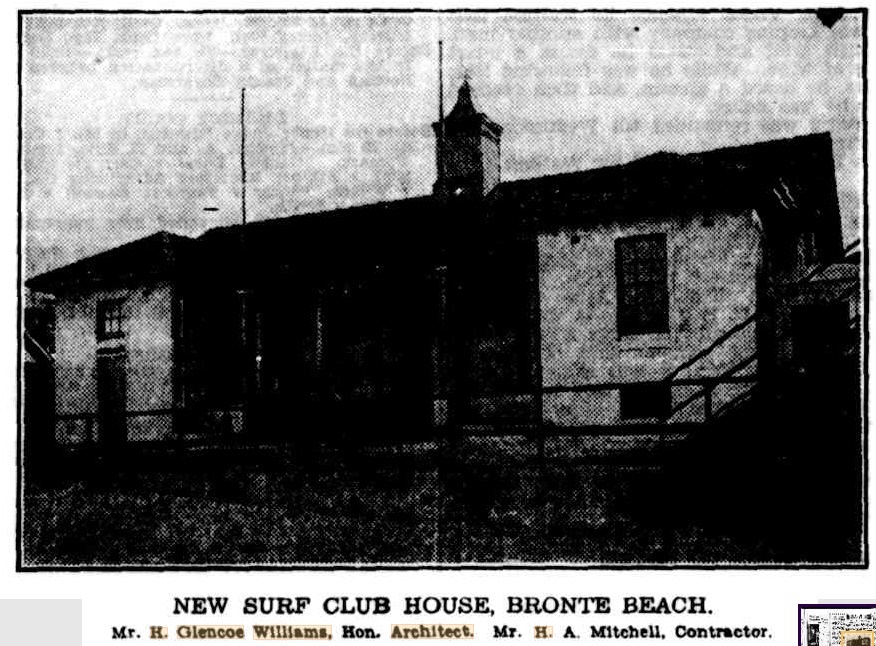
NEW SURF CLUB HOUSE, BRONTE BEACH.
Mr. H. Glencoe Williams, Hon. Architect. Mr. H. A. Mitchell, Contractor.
The building is constructed of brick, cement rendered externally, with a mottled Marseilles tile roof, and the trim and other woodwork are picked out in club colours of blue and gold. The entrance is flanked by two flagpoles, which are fixed in a specially designed vibration-resisting setting. The building is surmounted by a well-designed clock tower, which is sheathed in copper, and crowned by a weather vane designed as a silhouette of a belt and reel man in action by the artist, Mr. L. de Koningh. The work was carried out for the Waverley Council by Mr. H. A. Mitchell, contractor, to the design of Mr. H. Glencoe Williams, M.I.A., hon. architect for the club. BUILDING AND CONSTRUCTION NEW CLUB HOUSE. (1931, July 7). The Sydney Morning Herald (NSW : 1842 - 1954), p. 5. Retrieved from http://nla.gov.au/nla.news-article16791386
Careel Bay—Erection residence.—H. Glencoe Williams, Architect.—P. L. James and Sons, 24 Stanhope Rd., Killara, Builders. Tenders Accepted or Received (1937, March 3). Construction and Real Estate Journal (Sydney, NSW : 1930 - 1938), p. 14. Retrieved from http://nla.gov.au/nla.news-article222921727
Contracts Let - Glencoe Williams to L O Pincini for erection of residence at Clareville to H A Tritton for residence at Mosman and to Chegwyn Bros for residence at Careel Bay. CONTRACTS LET. (1937, July 20). The Sydney Morning Herald (NSW : 1842 - 1954), p. 5. Retrieved from http://nla.gov.au/nla.news-article17391007
Glencoe Williams, tenders for residence at North Avalon, and plans for residence at Careel Bay. BUILDING LOANS. (1938, May 24). The Sydney Morning Herald (NSW : 1842 - 1954), p. 6. Retrieved from http://nla.gov.au/nla.news-article27978060
Tenders are being called for the erection of a residence at Careel Bay, Palm Beach. Plans and specifications with Mr. Claude Hamilton, Architect, 9 Martin Place, Sydney. OPPORTUNITIES FOR BUSINESS (1939, August 2). Construction (Sydney, NSW : 1938 - 1954), p. 21. Retrieved from http://nla.gov.au/nla.news-article222855979
Claude Hamilton tenders for a two storey residence at Careel Bay, Palm Beach. CONTRACTS LET. (1939, August 1). The Sydney Morning Herald (NSW : 1842 - 1954), p. 9. Retrieved 2023, from http://nla.gov.au/nla.news-article17606429
And when you have just over one acre of grounds you can ensure you have a great garden, as mentioned above – and as featured in August 1938:
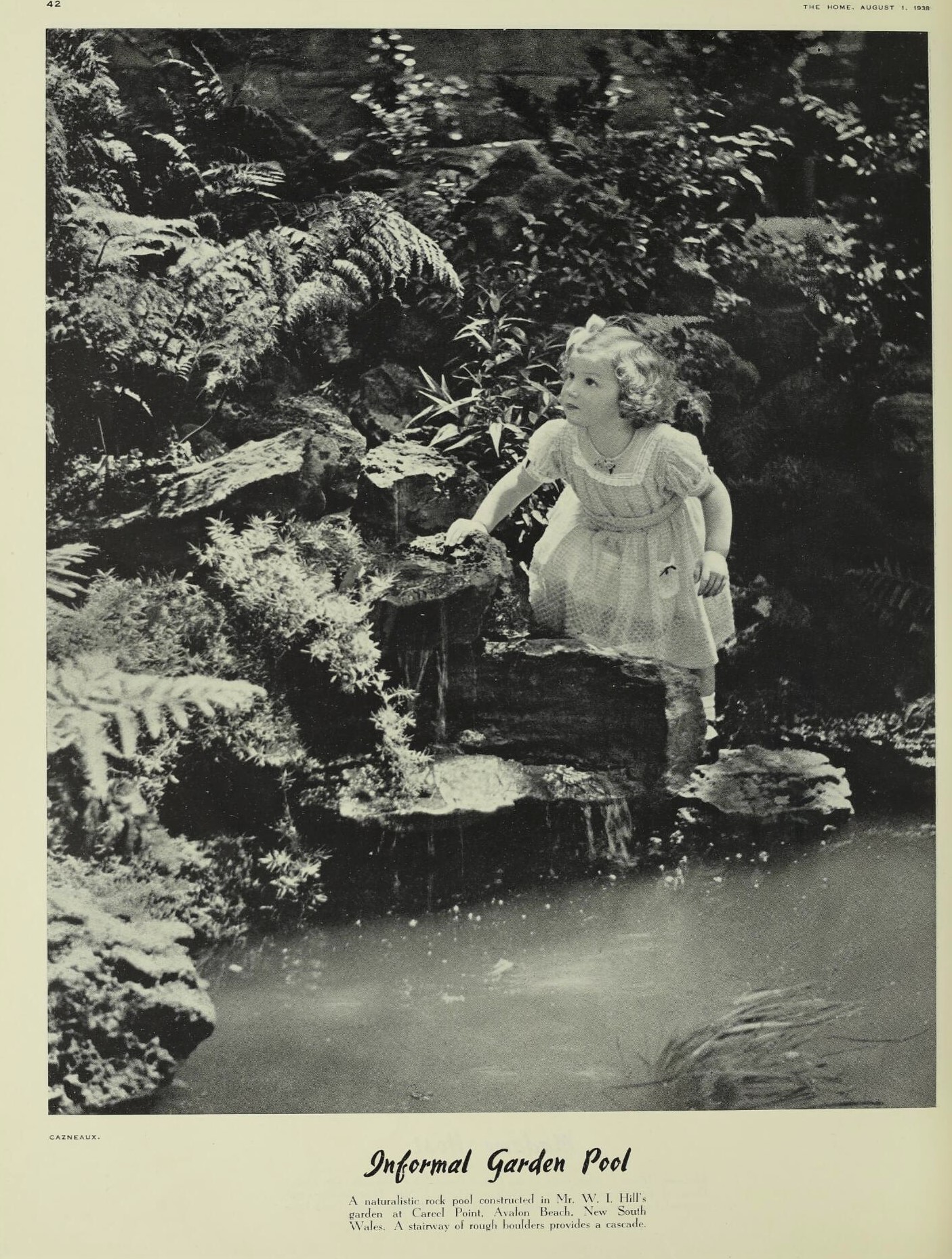
Informal Garden Pool CAZNEAUX. A naturalistic rock pool constructed in Mr. W. I. Hill's garden at Careel Point, Avalon Beach, New South Wales. A stairway of rough boulders provides a cascade. CAZN ...Title; Informal Garden Pool (1 August 1938) Appears In The Home : an Australian quarterly., v.19, no.8, 1938-08-01, p.46. Published xna, Art in Australia, 1938-08-01 Physical Description; 65 words article; Journal Part Of The Home : an Australian quarterly.Vol. 19 No. 8 (1 August 1938) Informal Garden Pool, The Home : an Australian quarterly Retrieved from http://nla.gov.au/nla.obj-389444502
And again, but with more information in October of that year:
The Hanging Gardens by S.H. Hunt Wherever the land is of an uneven nature, and in places where the surface shelves quickly from one level to another, walls become necessary to hold back the soil a ...; Title; The Hanging Gardens (1 October 1938). Appears In; The Home : an Australian quarterly., v.19, no.10, 1938-10-01, p.46, Other Contributors; by S.H. Hunt. Published; xna, Art in Australia, 1938-10-01. Photos by CAZNEAUX.
The Hanging Gardens
A wall garden at the home of Mr. W. I. Hill, Careel Point, Avalon Beach, New South Wales. Designed by W. Barker, Esq.
by S.H. Hunt
Wherever the land is of an uneven nature, and in places where the surface shelves quickly from one level to another, walls become necessary to hold back the soil and prevent erosion.
For generations the walls used were the reverse of ornamental, and generally consisted of squared rocks of any kind or colour that happened to be procurable in each particular locality.
Some of these walls, judging by their uncompromising and massive appearance, could easily have done duty as part of the masonry of a Tower of London, or some similar edifice—in very few instances was any attempt made to leave spaces between the rocks wherein to grow suitable plant life to soften the frowning faces of the walls and to brighten them with light-looking foliage and colourful flowers. In those days rock walls were a necessity —like the foundations of a house— and they were accepted as such, and were allowed, in most cases, to mar the beauty of the whole surroundings.
Only a comparatively short time ago hand-packed walls of natural coloured rock, in a number of pleasing shades, were introduced to Sydney gardens—walls that needed no ugly cement or mortar, and which were formed of thin, flat slabs, varying in size from only a few inches to a foot or eighteen inches in length, and of suitable width. When these walls are nicely constructed, and all joints properly broken, by taking care that the slabs of stone in each succeeding row are laid across the crevices between the slabs in the row beneath, they are not only very strong, but because of pleasing colours, used in artistic fashion, they become features of beauty, besides serving in best manner the purpose for which walls are intended.
It is imperative that a good foundation shall be made for the lowest layer of stone slabs, which, of course, are laid perfectly level. The artistry of the craftsman is then displayed by working in stones of correct colour and in the right positions to form a pleasing effect, without creating a too clearly defined pattern.
When the wall reaches the desired height a nice finish is provided by a wide coping that extends a few inches over the wall itself for the whole length— sometimes on both sides—sometimes only along the front. [continued on page 66.] The Hanging Gardens, The Home : an Australian quarterly Retrieved from http://nla.gov.au/nla.obj-389461643
Page 66: Should the wall be broken to permit of steps leading from lower levels to higher ones, piers of the same coloured rock are made with a large square slab to form the top on which to rest suitable specimen plants in tubs or urns, to put a finishing touch to the position. Sometimes these piers are built hollow to hold soil and suitable plants are grown in the soil itself —as shown on page 43.
The plants used in these piers are Retinospora Obtusa Nana. Plants used in the spaces of these piers—the higher one on the right with the daisy-like flowers—is Erigeron, whilst that above the bottom step is Gazania. The bushy one to the left of these is Lotus, and on the left of that is Convolvulus Mauretanicus—the smaller plants being Cerastium Tomentosa. These plants seem to do better when used as walling plants than under any other condition, provided due attention is given to drainage behind the wall, and the soil used immediately about the plant is of a light porous nature. One reason why they always look so fresh is that, in most other conditions, the foliage rots in places by contact with soil; but in a properly constructed wall the roots only are in the soil, and the foliage lies along the clean space of the wall.
The whole thing, as far as construction goes, is completely formal. Horizontal lines are rigidly adhered to in the wall, with the knowledge that a pleasing degree of irregularity will follow the incorporation of the correct plants to form the walled garden. Where the wall is to be high it is preferable to break it back to a new alignment, thus leaving a channel in which to mass plant life—chiefly annuals. It all adds to the harm of the walled garden. In the case of this picture the area was solid rock, which had to be blasted away in order to have this present approach to the house and the rest of the garden, which is situated on a steep cliff with magnificent views over the waters of Careel Bay, and to Lion Island in the distance. In shady spots use the little Campanula Fragilis and Heeria Elegans, also the too-little-used Muehlenbeckia Complexa. In sunny aspects a host of trailing plants may be used—Convolvulus Mauretanicus, the Gazania, the many colours of Mesembryanthemums, Ajuga, Lotus, Thymes, Lamb’s Ear, Balm, Oenothera, and Rhyncospermum Jasminoides. The Home : an Australian quarterly Retrieved from http://nla.gov.au/nla.obj-386111376
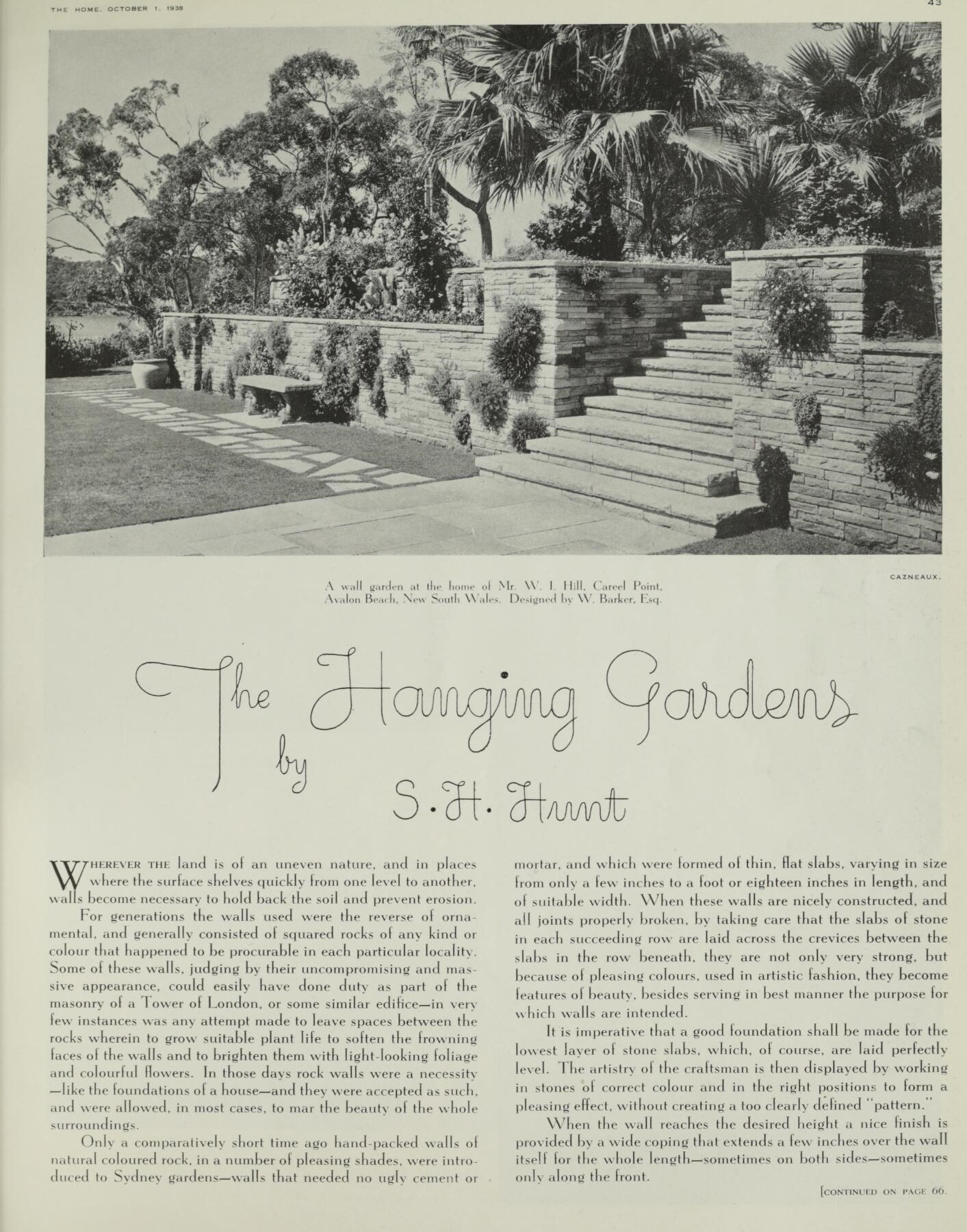
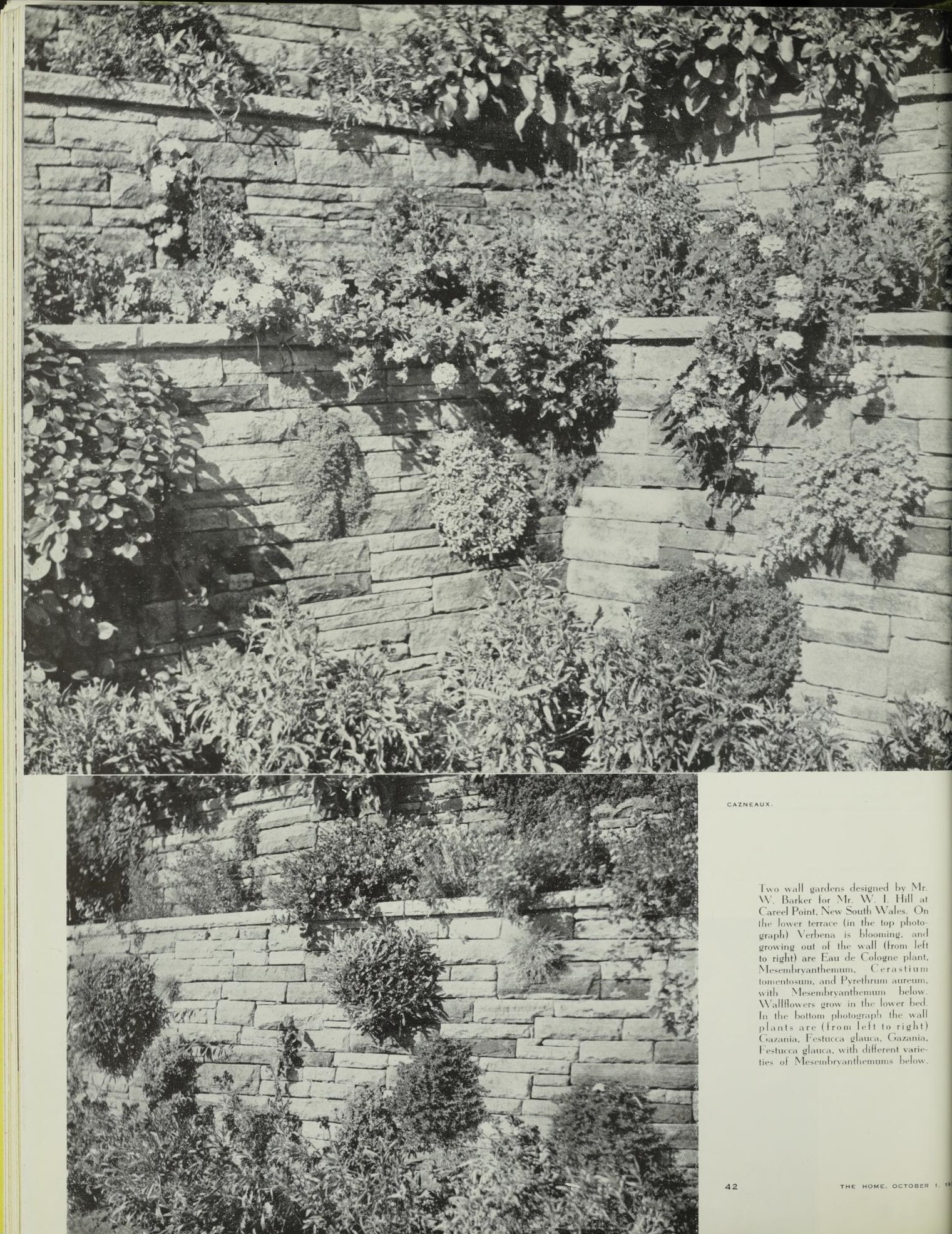
Two wall gardens designed by Mr. W. Barker for Mr. W. I. Hill at Careel Point, New South Wales. On the lower terrace (in the top photograph) Verbena is blooming, and growing out of the wall (from left to right) are Eau de Cologne plant. Mesembryanthemum, Cerastium tomentosum, and Pyrethrum aureum, with Mesembryanthemum below. Wallflowers grow in the lower bed. In the bottom photograph the wall plants are (from left to right) Gazania, Festucca glauca, Gazania, Festucca glauca. with different varieties of Mesembryanthemums below. The Hanging Gardens, The Home : an Australian quarterly Retrieved from http://nla.gov.au/nla.obj-389461643
And you then put the garden to good use:
THE lovely gardens of Finisterre, Mr. and Mrs. W. I. Hill's home at Careel Point, Avalon, will be open for public inspection on November 4. The Avalon branch of the Red Cross Society will benefit from the proceeds. Afternoon tea will be served in the gardens, which overtook one of the prettiest views on the Hawkesbury, and there will be a band to supply music. Lady Owen will officially declare the gardens open. HEADING SOUTH. For The Cup (1939, October 26). The Daily Telegraph (Sydney, NSW : 1931 - 1954), p. 15. Retrieved from http://nla.gov.au/nla.news-article247815734
THE lovely grounds of the home of Mrs. W. Illingworth Hill, at Careel Bay, will be thrown open for inspection on Saturday in aid of the Avalon branch of the Red Cross Society, of which she is president. Lady Owen will perform the opening ceremony at 2 p.m., and music will be provided by the Police Band. SOME COMING EVENTS. (1939, November 2). The Sydney Morning Herald (NSW : 1842 - 1954), p. 19. Retrieved from http://nla.gov.au/nla.news-article17631625
Lady Owen was the then State Director of Red Cross Branches.
A SUITE at the Galle Pace hotel, Colombo, is the permanent home of Mrs. Edward Fell-Burgess, who arrived in the Oronsay yesterday. She was met at the wharf by her sisters, Mrs. W. I. Hill, with whom she will stay at Careel Point, and Mrs. Wallace Bridge, who will be hostess at- a welcome cocktail party at her Aston Gardens home tomorrow. It is eight years since Mrs. Pell-Burgess visited Sydney. ' This time she has come direct from a visit to England, and will stay exactly 28 days before sailing in the Orcades for Colombo. GOSSIPY BITS (1939, January 26). The Daily Telegraph (Sydney, NSW : 1931 - 1954), p. 18. Retrieved from http://nla.gov.au/nla.news-article247448154
Careel Bay was a Women's Work place during the ensuing, especially for the combined forces of the Red Cross Society from Palm Beach to Avalon Beach. Mrs Kit McPhillamy turned her front glassed in room into a pace where camouflage netting was made and was also part of raising funds to send clothing and goods to men serving in the defence of Australia throughout World War II.
A few insights:
TEA FOR TWO
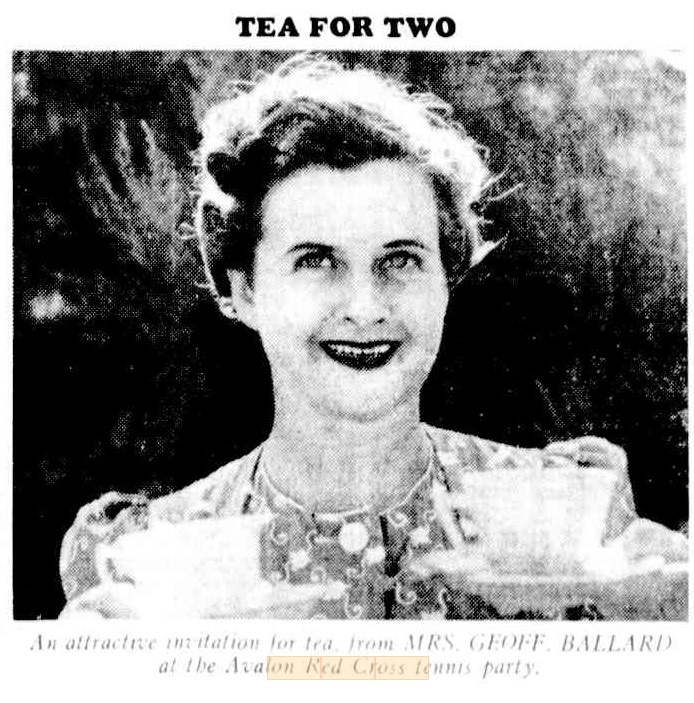
An attractive invitation for tea. from MRS. GEOFF BALLARD at the- Avalon Red Cross tennis party. NEWS CAMERA Looks in on Society (1939, December 3). The Sun (Sydney, NSW : 1910 - 1954), p. 5 (WOMEN SECTION SOCIAL). Retrieved from http://nla.gov.au/nla.news-article231504690
FOR FRENCH RED CROSS.
A LOUIS XV watch made of blue enamel bordered with pearls which has been in the family of Mrs J Jeffries of Newport for more than 200 years was presented to the French Consulate yesterday by Mrs Jeffries in aid of the French Red Cross. The watch will be disposed of to augment the proceeds of the concert to be given to-morrow at the Town Hall by Yehudi Menuhin for the French Red Cross Mrs Jeffries is a member of the Avalon-Newport branch of the Red Cross Society which has contributed more than £300 to headquarters. Mrs Jeffries who also possesses a mirror and tea service of the same period proudly points out that although the watch is so old it still keeps perfect time. FOR FRENCH RED CROSS. (1940, June 18). The Sydney Morning Herald (NSW : 1842 - 1954), p. 4. Retrieved from http://nla.gov.au/nla.news-article17682715
Red Cross Burglary
UNDERCLOTHJNG and parcels of pyjamas which were to have been sent to soldiers in hospital were stolen from the Red Cross Kiosk at Avalon yesterday. They were valued at £50. Red Cross Burglary (1941, June 5). Daily Mirror (Sydney, NSW : 1941 - 1955), p. 9 (Late Final Extra). Retrieved from http://nla.gov.au/nla.news-article271151526
The Avalon Red Cross Kiosk was then situated near the beach, one of a few 'kiosks' there during this period. A Mrs. T. Prince was of the President Avalon Branch Red Cross Society by August 1941. Avalon Beach Historical Society (ABHS) President and Avalon Preservation Association (APA) committee member Geoff Searl was alerted to the site by Pittwater Council in late 2011. Geoff worked with Council on preserving the site and designing a plaque to commemorate this slice of Avalon history.
This process was interrupted in 2016 when the 3 northern beaches Councils were amalgamated. Avalon Surf Life Saving Life Member and Avalon Preservation Association committee member Roger Sayers offered to help to restart the process with the new Council. After numerous discussions, NBC CEO Ray Brownlee was approached on behalf of ABHS and APA and approved the plaque on a sandstone base. Geoff finalised the wording and graphic images on the plaque, which was finally fixed in place and revealed in early March 2021. Some insights are shared in the March 2021 report 'Avalon Beach Reserve Heritage Marker For Old Kiosk Installed'.
ABHS photo of Avalon Beach reserve showing the kiosks
EXCITEMENT is high as to who will be crowned King or Queen of the Birds on August 31, when the Bushland Competition closes. Mrs. K. McPhillamy, of Careel Bay, has organised the contest for the Palm-Whale Beach Red Cross. Koala is topping the barometer, which is changed at P.B. Post Office each week. Bib and Bub are running a good second. Letters are pouring in to Mrs. McP's dog Bluey in response to letters he sent out to other dogs with begging photograph enclosed saying he had been scratching for an idea to help the Red Cross, that barking was his long suit, and nothing less than a shilling would quieten him. All the replies have been doggie letters and screamingly funny. From 2 o'clock on the tropical garden will be a fete, with the crowning ceremony, stalls, ponies, and lots o' fun. SOCIAL (1941, August 18). Daily Mirror (Sydney, NSW : 1941 - 1955), p. 10 (Country Edition). Retrieved from http://nla.gov.au/nla.news-article271273617
SOCIAL
THE BUSHLAND Competition is the appropriate title for an effort begun by Mrs. McPhillamy, of Careel Bay, to raise money for the Palm-Whale Beach branch of the Red Cross. Children of the district are to represent birds, and penny votes will be sold. On August 31 the child with the most votes will be crowned Queen of of the Bush. On the same day Mrs. McPhillamy's lovely tropical garden will be turned into a market, at which home-grown vegetables, fruits, jams and fish caught at the door, so to speak) will be sold. For the human birds, the district there will be a Noah's Ark, ponies to ride, ice creams and apples on sticks.
Another article describes the McPhillamy garden as being full of growing fruit; paw paws, bananas and other fruits and vegetables surrounded the house - handy during WWII rationing and scarcity.
Women in War
BUSY as a bee is Mrs. Kit McPhillimy of Careel Bay. Answering the call by the services for camouflage nets, she set to work, went to town three times a week for lessons at N.D.S., and this week started a centre at Careel Bay, Pittwater, which boasts at the most 10 homes. Mrs. McPhillimy has given up her glassed sun-room for the duration to this war work. Frames are fixed to the floor and the networkers will work three days a week, turning out one net a day as a beginning. This small community also works very consistently and hard for the Avalon-Whale-Palm Beach local Red Cross. It is to be hoped that others will follow suit, for camouflage nets are a very real need at the moment. Women in War (1942, January 13). Daily Mirror (Sydney, NSW : 1941 - 1955), p. 11 (Late Final Extra). Retrieved from http://nla.gov.au/nla.news-article271584231
EVERYONE seemed quite satisfied with the deal at the cracker card party held in the local hall at Avalon last night. Proceeds went to aid pretty brown-haired Judy Barraclough's candidature in the Miss Red Cross comp. She's 'Miss Avalon Beach.' Women in War Work (1942, November 1). Truth (Sydney, NSW : 1894 - 1954), p. 25. Retrieved from http://nla.gov.au/nla.news-article168967432
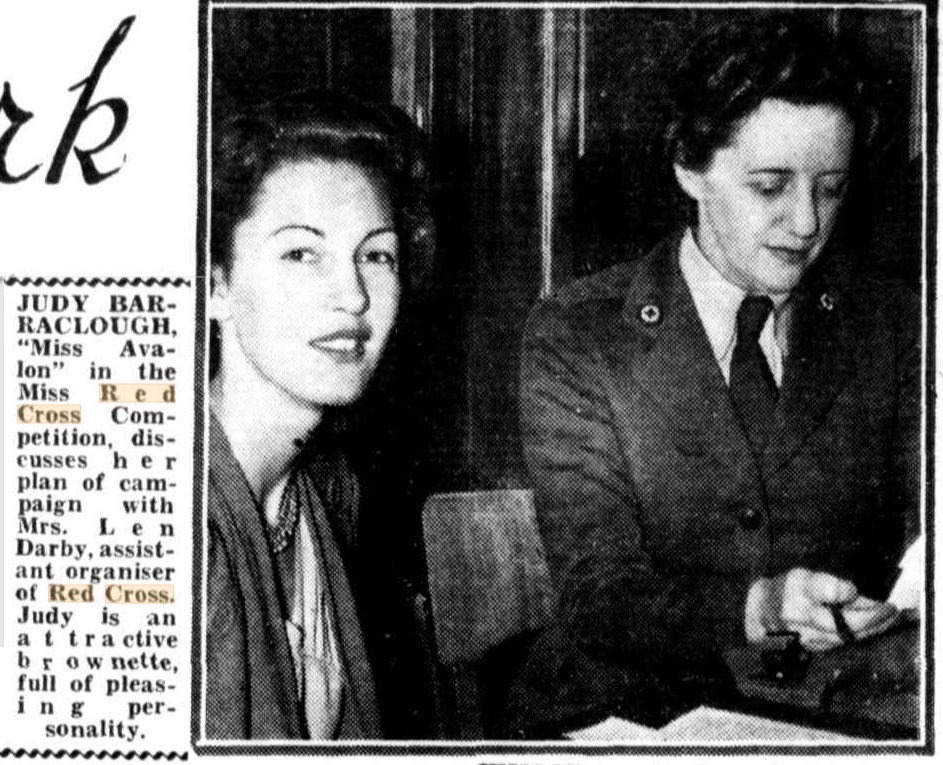
JUDY BARRACLOUGH, 'Miss Avalon' in the Miss Red Cross Competition, discusses her plan of campaign with Mrs. L e n Darby, assistant organiser of Red Cross. Judy is an attractive brownette, full of pleasing personality. Women in War Work (1942, November 8). Truth (Sydney, NSW : 1894 - 1954), p. 21. Retrieved from http://nla.gov.au/nla.news-article168972666
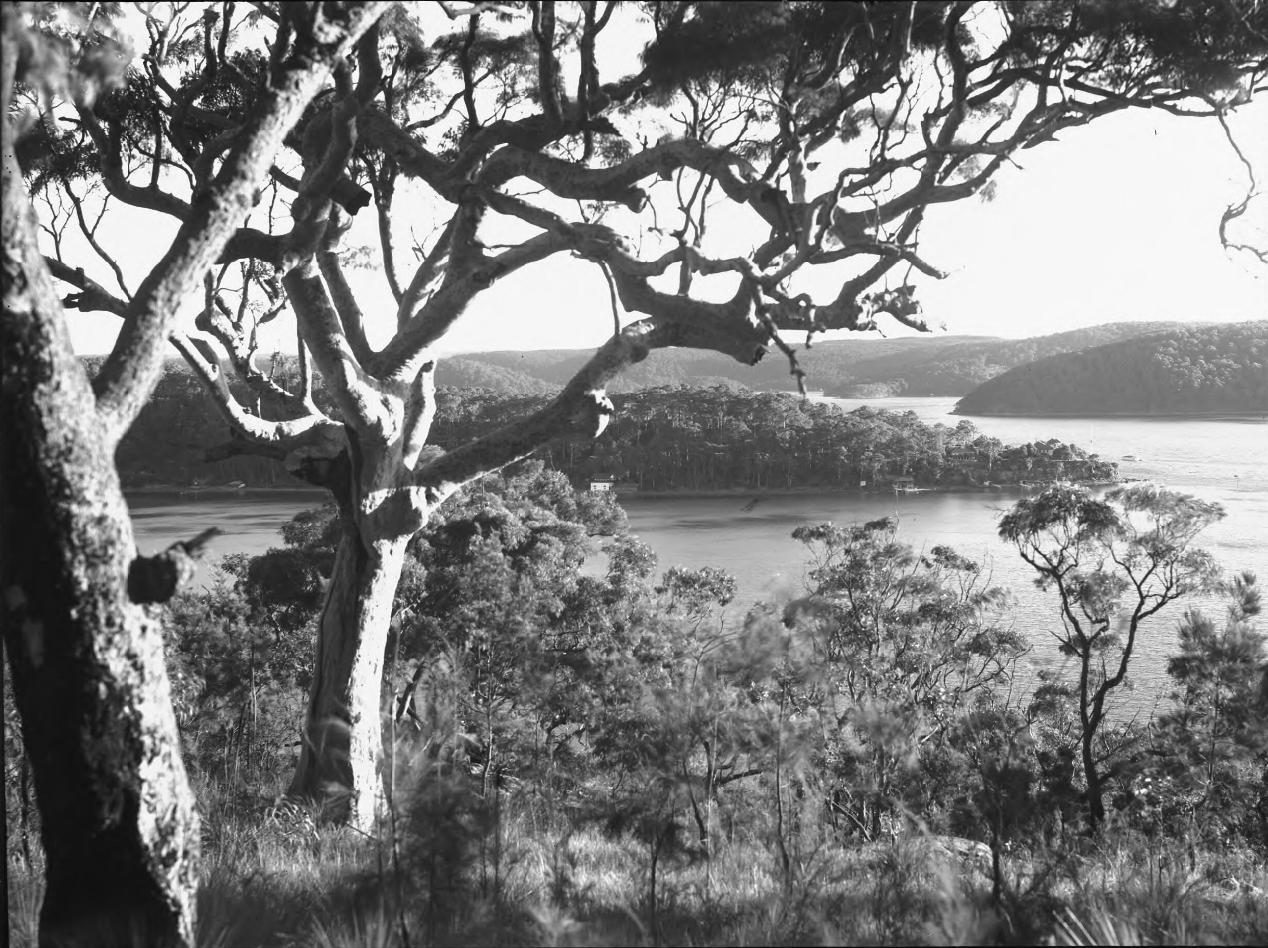
Stokes Point, circa 1947-1950, by Frank Hurley, courtesy National Library of Australia
William and Daisy Hill sold Finisterre as the war ended. The Titles Office records Reginald Eric Buckingham of Sydney, Medical Practitioner, and his wife, Susan Annie Buckingham, who was also a Doctor who studied at Sydney University and at the Edinburgh University, as joint tenants commencing May 18th 1945, the same date they mortgaged the property with the Bank of NSW being who they would pay it off to.
Reginald Buckingham, born September 23rd 1895 was one of two sons of William Buckingham, the giant store owner. Like every owner since Arthur McDonald he served in WWI, this time as a flier, and was awarded the Croix de Guerre, as did his brother William:
Croix de Guerre: Second Lieutenant Reginald Eric Buckingham, Royal Flying Corps, Special Reserve - THE EDINBURGH GAZETTE, JUNE 5, 1917. 2nd Lieutenant Reginald Eric BUCKINGHAM. Royal Flying Corps. Date: [1914-1922]. Held by: The National Archives, Kew.
Messrs. William Buckingham and Reginald Eric Buckingham, sons of Mr. William Buckingham, of Oxford-street, who left Sydney for England by the R.M.S. Karmala last January, have received commissions in the Royal Flying Corps. They are now acting as pilots in France. Their father has received cable advice to this effect. MEN AND WOMEN (1916, August 19). The Sun (Sydney, NSW : 1910 - 1954), p. 6 (FINAL SPORTING). Retrieved from http://nla.gov.au/nla.news-article223375906
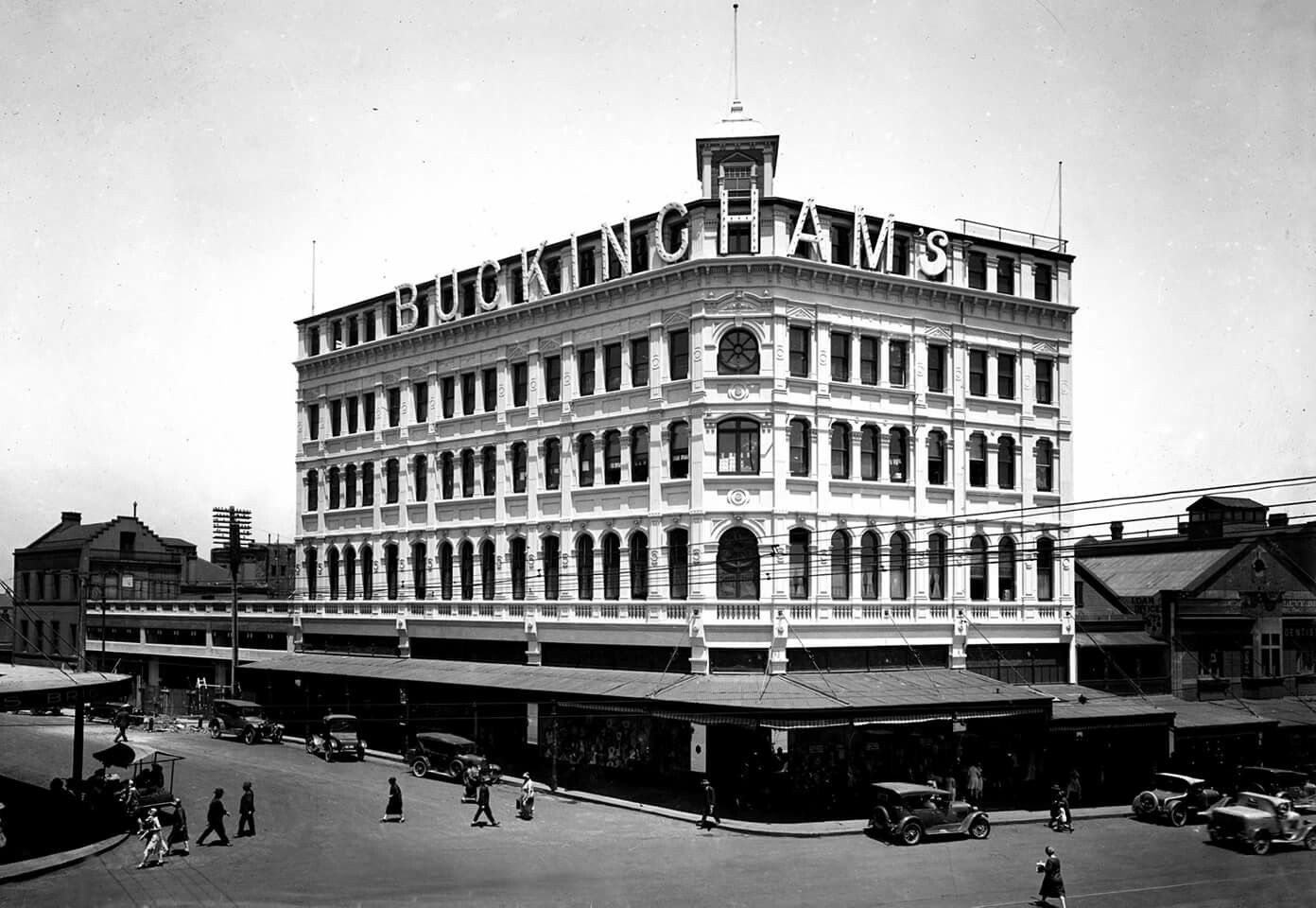
Buckinghams store in Oxford street, Sydney, circa 1930, courtesy National Library of Australia
THE LATE MR. WILLIAM BUCKINGHAM.
Mr. William Buckingham, chairman of directors of Buckinghams, Ltd., Oxford-street, died yesterday, after a short illness, at Balnagowan, Gordon Crescent, Petersham.
Born in Yorkshire, England, he came to Australia at the age of 20 years, and commenced business in George-street, under the style of Buckingham and Pepper. He was the first to introduce in Australia, what is now known as the cash order system in the retail business. Later he acquired a site at the corner of Riley and Oxford streets, upon which the firm's present departmental store was erected.
After the war Mr. Buckingham took two of his sons into the business, converted it into a limited liability company, and gradually left the management and direction to them.
It is a curious coincidence how the "mystic seven" was associated with Mr. Buckingham's career. He was born on the seventh of the month, left England on the seventh of the month, arrived In Sydney on the seventh, commenced business on the seventh, was married on the seventh, had seven children, and died on the seventh.
Outside of his business association, Mr. Buckingham was for many years a leading layman of the Baptist denomination, and prominently identified with religious movements of an interdenominational character. A large proportion of the sites for Baptist churches in the metropolitan district were acquired through his generosity. He had been a deacon of the Stanmore church since its inception.
Mr. Buckingham is survived by a family of four sons and three married daughters. Mr. William Buckingham, Junior, Dr. R. E. Buckingham (who both distinguished themselves during the war in the Air Service), Mr. Ashley J. Buckingham, Mr. Ivan C. Buckingham, Mrs. G. M. Richards. Mrs. R. Love, and Mrs, G. J. Yabsley.
The funeral will leave the Stanmore Baptist church, Albany-road, at 2.15 this afternoon, for Rookwood, following a short service in the church. THE LATE MR. WILLIAM BUCKINGHAM. (1928, December 8). The Sydney Morning Herald (NSW : 1842 - 1954), p. 21. Retrieved from http://nla.gov.au/nla.news-article28049599
CITY MERCHANT'S ESTATE.
LATE MR. W. BUCKINGHAM.
Probate has been granted of the will of the late Mr. William Buckingham, merchant, who died on December 7 last at his residence, Balnagowan, Gordon-crescent, Stanmore, aged 74 years. The value of his estate was sworn for stamp duty purposes at £80,013. Messrs. William Buckingham, son, and George Rowland Love, son-in-law, were appointed trustees and executors. To each of his sons, William Buckingham, Reginald Eric Buckingham, Ashley James Buckingham, and to Ivan Campbell Buckingham, be bequeathed £1000; and to each of his daughters, Edith May Richards, Victoria Yabsley, and Eva Love, £500. Bequests of £250 each were made to the Baptist Foreign Missionaries' Society and the Baptist Home Society, and one of £600 to the Stanmore Baptist Church.
Testator directed a division of his shares in Buckingham, Ltd., among his sons and daughters, in proportion to their present holdings in the company. Directions were given for the administration of the residue of the estate by the trustees for the benefit of testator's survivors. The will Included a bequest of £250 to the deceased's housekeeper, Miss Garston. CITY MERCHANT'S ESTATE. (1929, February 6). The Sydney Morning Herald (NSW : 1842 - 1954), p. 14. Retrieved from http://nla.gov.au/nla.news-article16529162
The Department store founded by draper William Buckingham was one of the first to provide a store credit system and a home service unit to visit clients. The building was destroyed by fire shortly after the business was closed. Opened in 1908 it was destroyed by fire on Anzac Day, April 25th 1968. It was scheduled for demolition at the time.
Reginald and Susan married on March 3rd 1919. He attended the Hawkesbury Agricultural College on his return and took up farming as well as studying to be a surgeon while Susan returned to work:
DESIGNATION.
DEPARTMENT OF EDUCATION.
HIS Excellency the Lieutenant-Governor, with the advice of the Executive Council, and upon the recommendation of the Public Service Board, has approved of the following appointments and alteration of designation :—
Dr. Susan Annie Buckingham, Medical Officer, Medical Branch (confirmation). APPOINTMENTS AND ALTERATION OF DESIGNATION. (1923, November 16). Government Gazette of the State of New South Wales (Sydney, NSW : 1901 - 2001), p. 5176. Retrieved from http://nla.gov.au/nla.news-article225144151
Susan Annie Robertson was born on the 28th of November 1892. Susan served as a Medical Officer in WWI having gained her Doctorate in Medicine at Sydney University in 1914. She served as a British Army Civil Medical Practitioner, attached Royal Army Medical Corps.
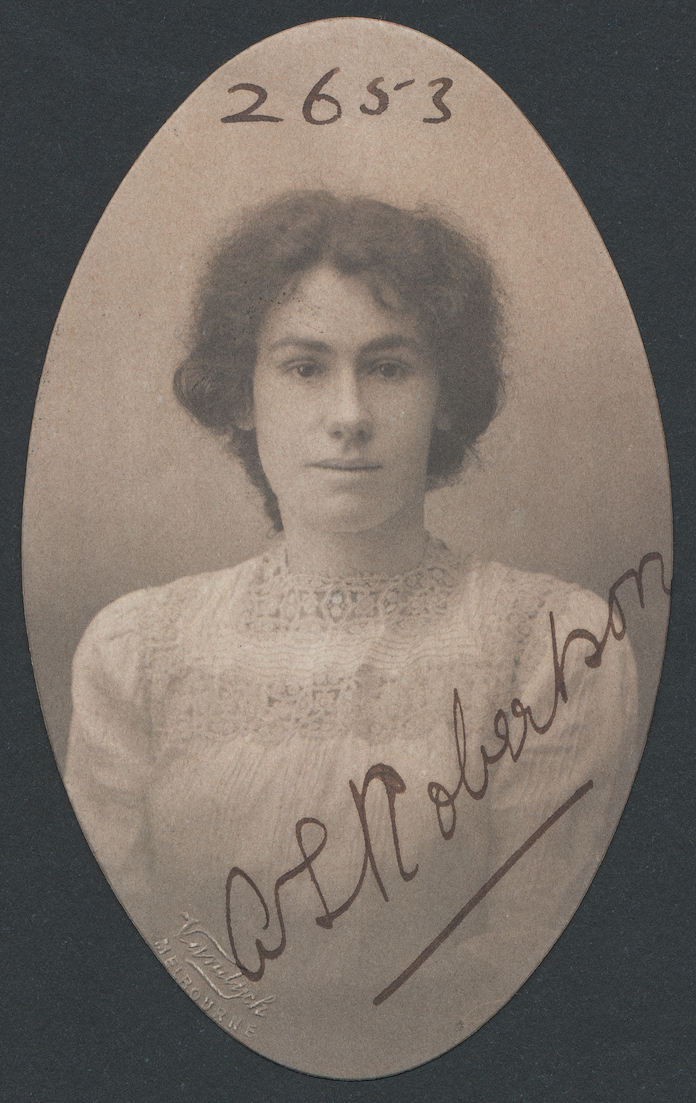
Susan Annie Robertson, photo courtesy The Mitchell Library, State Library of NSW
.jpg?timestamp=1692586107149)
Dorothy Gilfillan Memorial Prize awarded to Dr Susan Annie Robertson, MB ChB, 11-7-1917 by University of Edinburgh Susan Robertson was a member of the Robertson family of Mt Albert Auckland, and a sister of Nancy Marion Page (nee Robertson), who served with the QAIMNSR during WW1. Courtesy Collection of Auckland Museum Tamaki Paenga Hira
Dr. Reginald Eric Buckingham graduated as a surgeon from Sydney University in 1926, now 31 years of age. He would go on to specialise in ENT 9Ears, Nose and Throat).
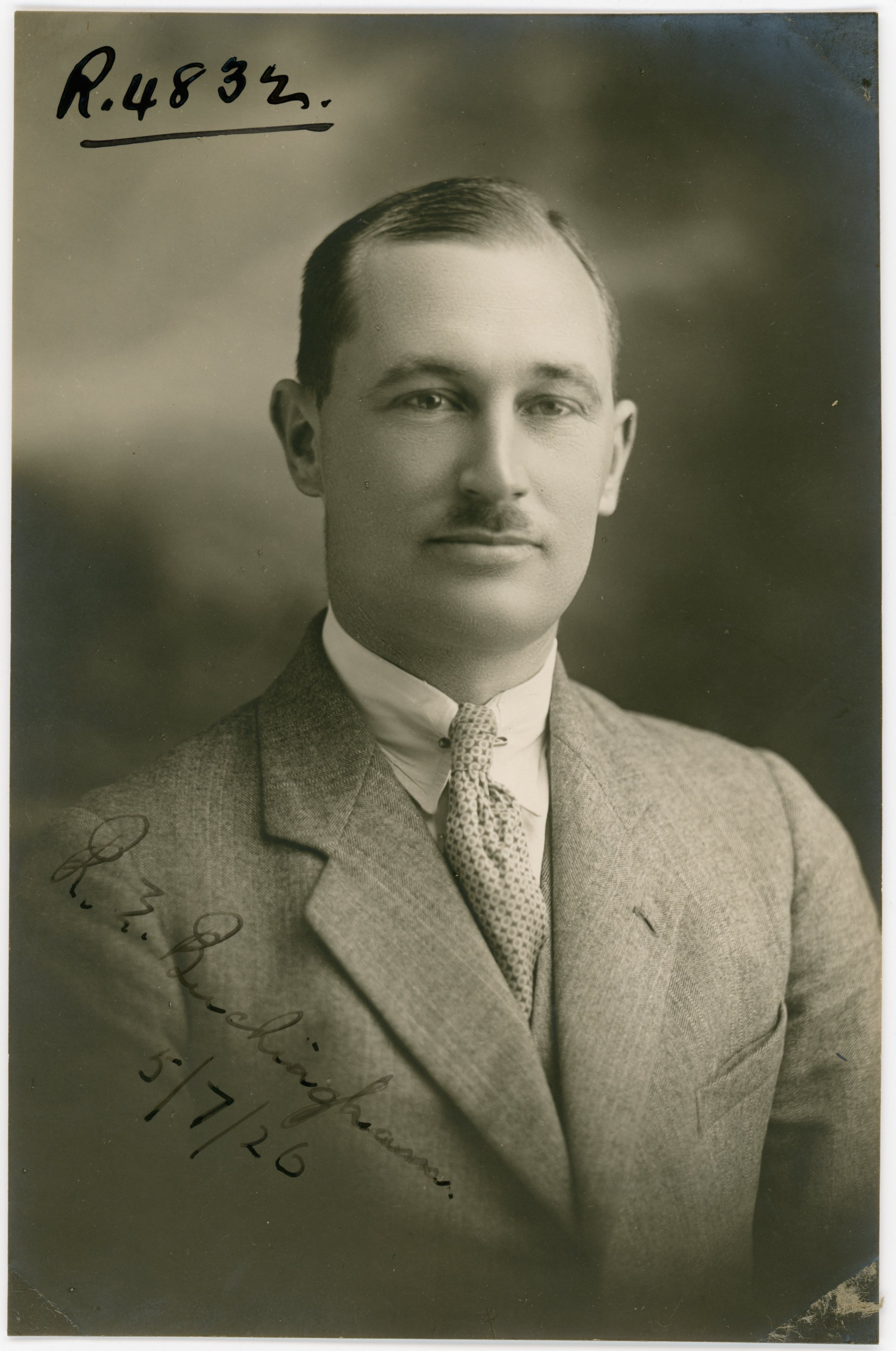
Dr. Reginald Eric Buckingham , taken on July 7th 1926, Item: FL406212 courtesy NSW State Records and Archives
Reginald Buckingham signed up again to serve in WWII with his War Record, held by the National Archives of Australia, providing a photograph of him when he was 46. Husband: BUCKINGHAM REGINALD ERIC : Service Number - 267680 Next of Kin - BUCKINGHAM SUSAN:
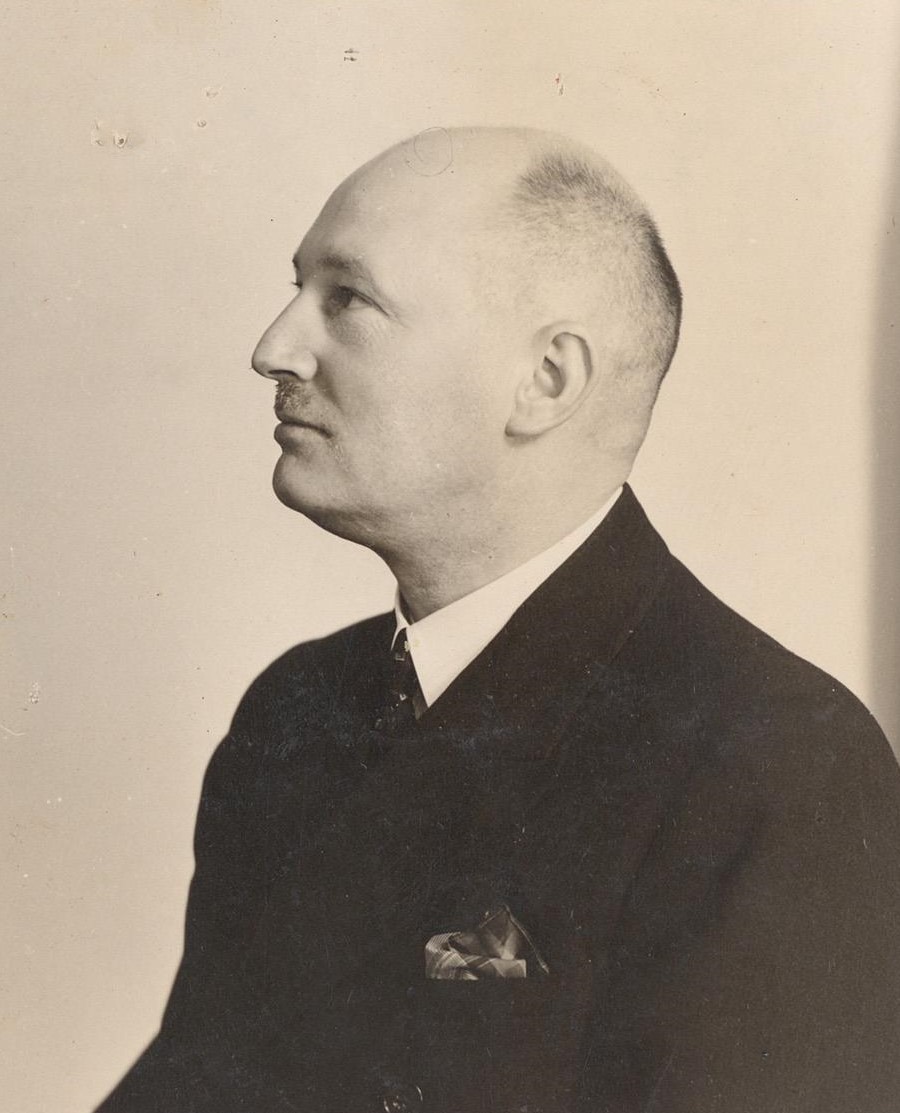
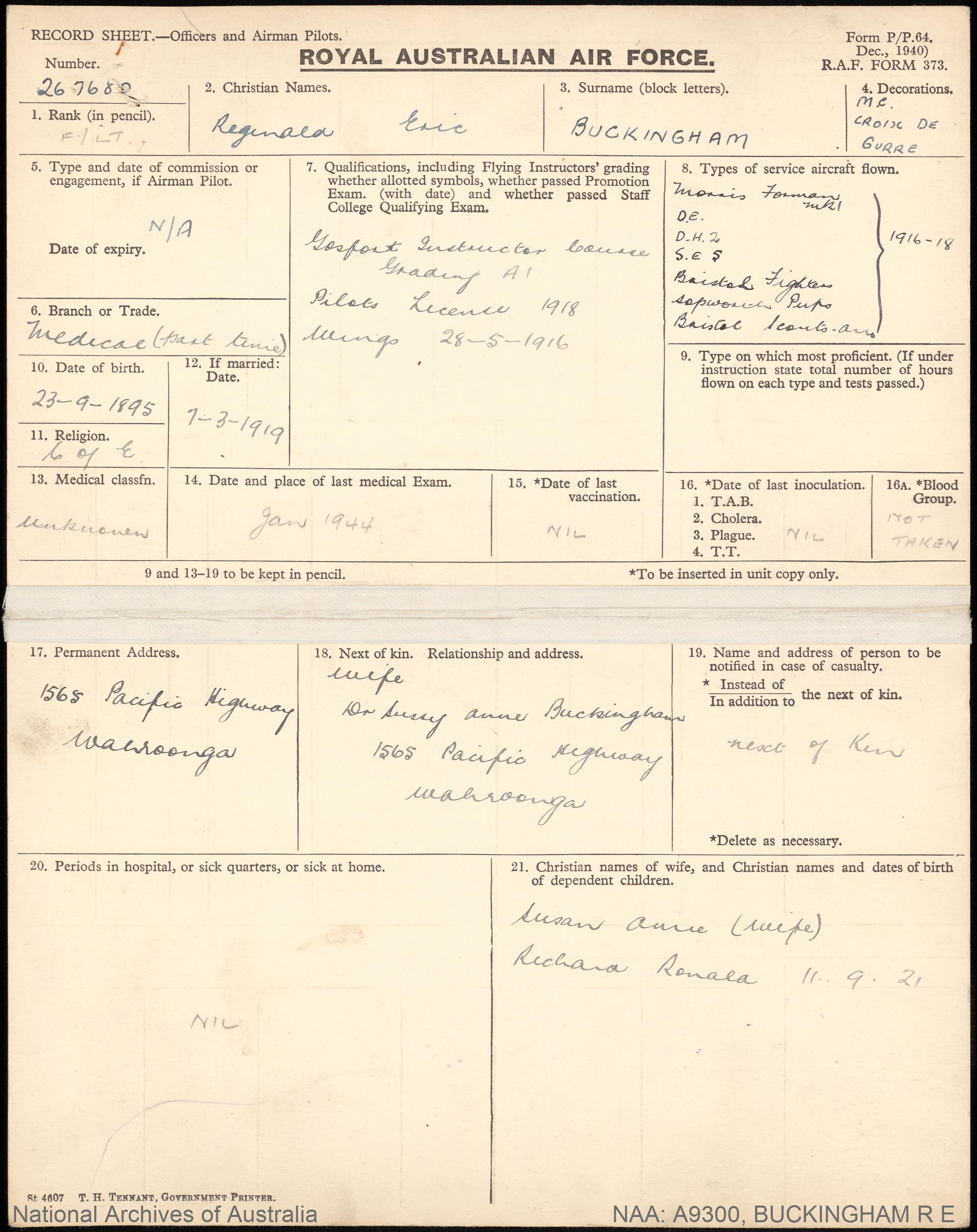
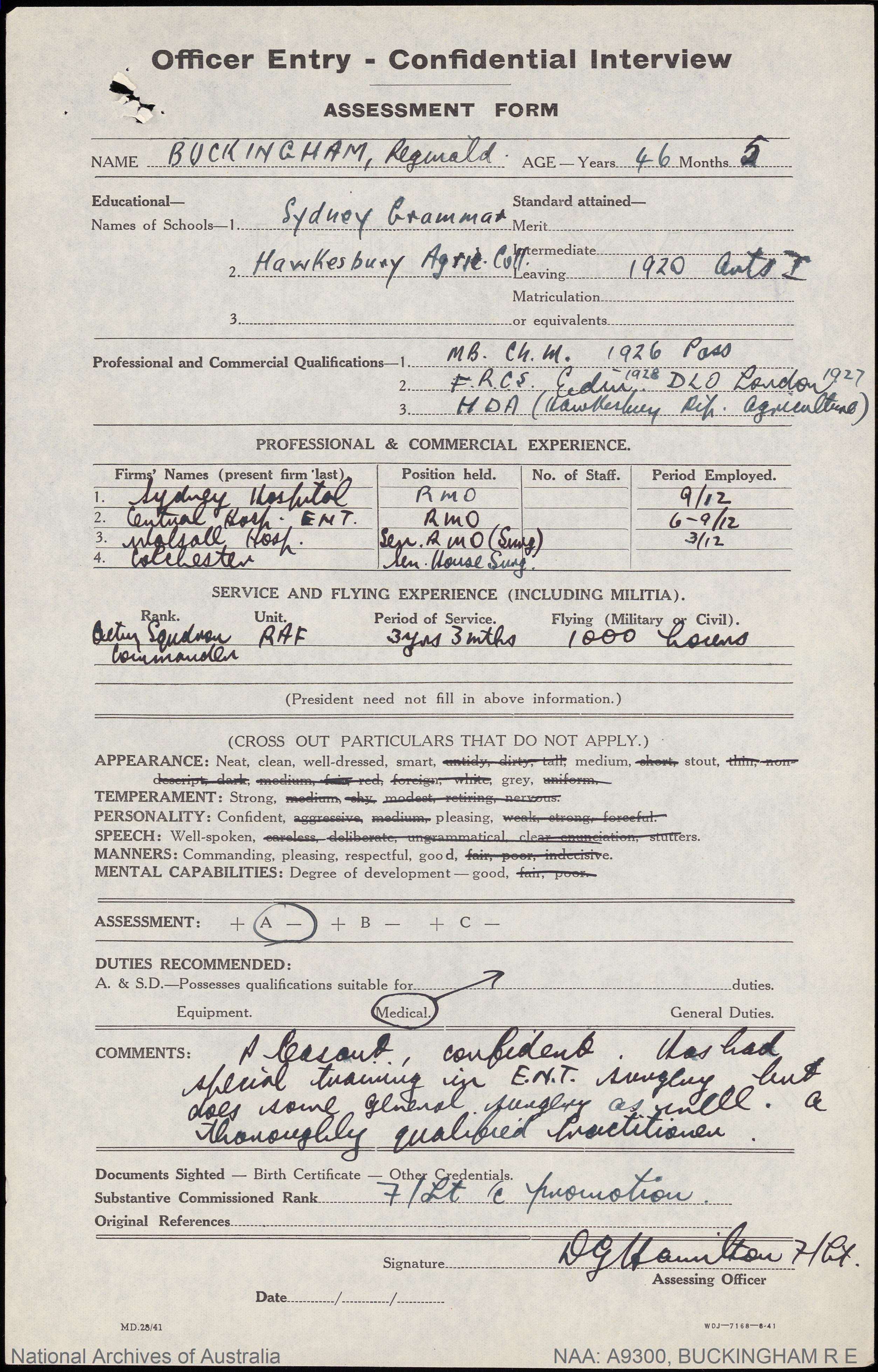
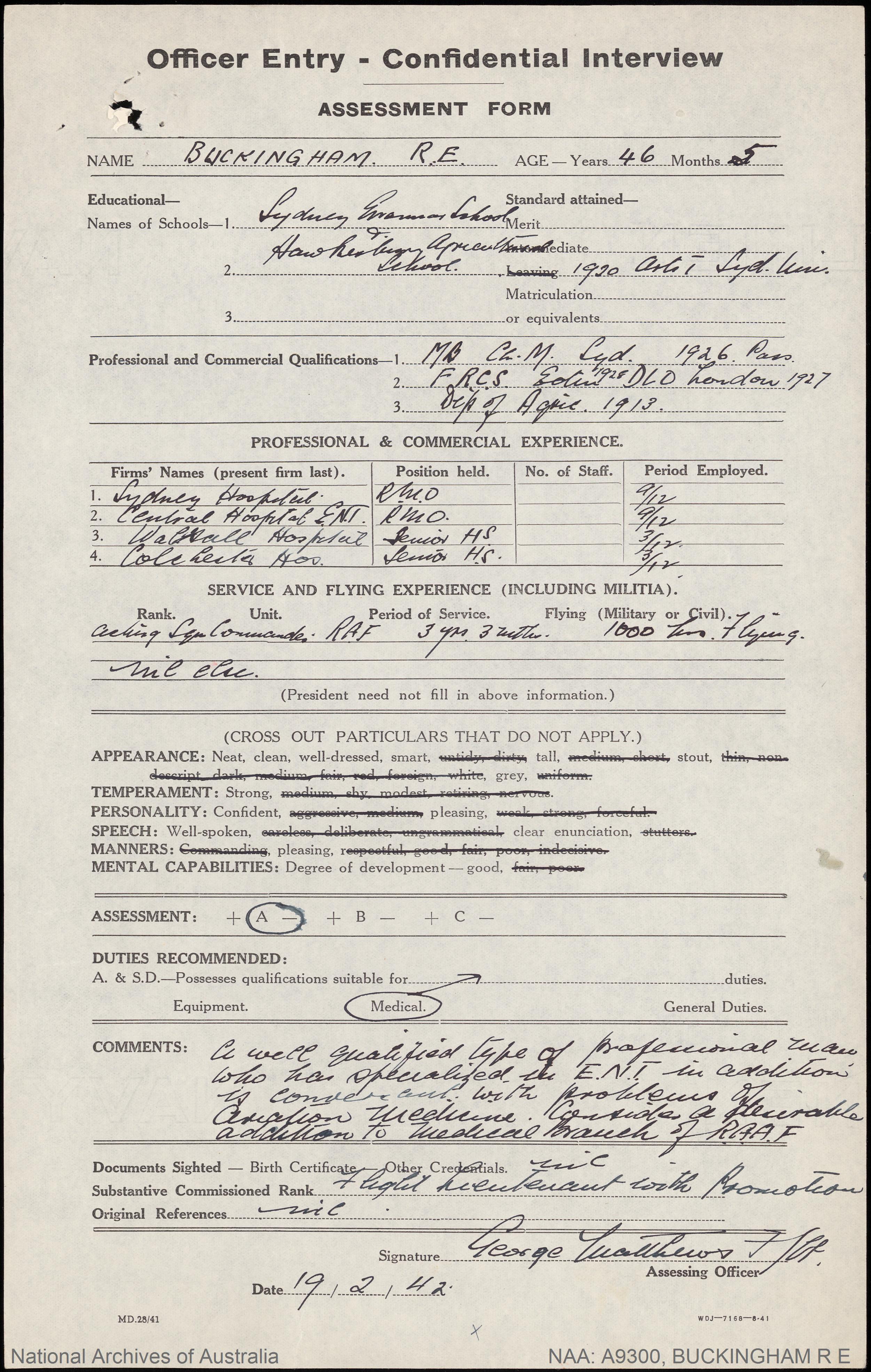
The Buckinghams kept up the water leases for 'Finisterre' as well:
Chief Secretary's Department, Sydney, 16th February. 1954.
FISHERIES AND OYSTER FARMS ACT, 1935-1949.
Notification of renewal of leases of Oyster Farms.
IT is hereby notified that the Minister has approved of the renewal to the undermentioned persons of leases for the purpose of oyster farming of the lands specified in the Schedule
hereunder.
C. J. BUTTSWORTH, Under Secretary.
Schedule.
*No. 43-147 (average lands), to Reginald Eric Buckingham and Susan Annie Buckingham, of Finisterre, Stokes Point, Avalon' Beach, situated at Pittwater, frontage 225 yards (plan cat No. P 16-42), fifteen years from 24th April, 1953; annual rental, £1 14s.,—under section 62, Fisheries and Oyster Farms Act, 1935-1949. FISHERIES AND OYSTER FARMS ACT, 1935-1949. (1954, February 19). Government Gazette of the State of New South Wales (Sydney, NSW : 1901 - 2001), p. 495. Retrieved from http://nla.gov.au/nla.news-article220289777
No. 67-221 (average lands), to Reginald Eric Buckingham and Susan Annie Buckingham, of "Finisterre", Stokes Point, Avalon Beach, situated at PITTWATER having a frontage of 232 yards (plan cat. No, 67-221), fifteen years from 24th April, 1968; annual rental $6.96, -under section 62, Fisheries and Oyster. Farms Act, 1935, as ,amended. Special Condition; Oyster Lease No. 67-221 is granted subject to the special condition that there is reserved to the Maritime Services Board the right to maintains 8mph speed sign in the area of the lease. FISHERIES AND OYSTER FARMS ACT, 1935, AS AMENDED (1969, September 19). Government Gazette of the State of New South Wales (Sydney, NSW : 1901 - 2001), p. 3782. Retrieved from http://nla.gov.au/nla.news-article219992290
Restoration of Names to the Register. 3910. BUCKINGHAM, Susan Annie, "Finisterre", Stokes Road, Avalon Beach, M.B,, Ch.B., Univ. Edin., 1917. NEW SOUTH WALES MEDICAL BOARD (1966, November 11). Government Gazette of the State of New South Wales (Sydney, NSW : 1901 - 2001), p. 4631. Retrieved from http://nla.gov.au/nla.news-article220020621
The couple had a rural property, 200 acres on the Lachlan River, as well as their coastal 'weekender'. Both clearly maintained a sense of serving the community in whatever capacity they could, as can be seen by this item:
ORANGE SEAT LIBERAL PARTY PRE-SELECTION
Dr. R. E. Buckingham A Candidate
Although a Country Party candidate to contest the Orange seat in the State Parliament has been selected, it is learned that the Liberal Party will nominate a candidate to contest the election in May of this year.
It is reported that a pre-selection ballot for the Liberal Party candidate will take place within a fortnight, when the names of three prominent citizens will be placed Before the selection committee.
The names to be placed before the committee are those of:-—
DR. R. E. BUCKINGHAM. •Mr. T. A. WHITELEY Mr W. WILLIAMS.
One-time alderman of the Orange Council, Dr. Reginald Eric Buckingham has had a varied career, and in addition to his professional degrees, he holds a diploma of the Hawkesbury Agricultural College.
The well-built doctor is also the mentor of a well-known Western stud at "Springfield," Gilgandra, renowned for its sheep and Aberdeen Angus cattle.
Now in his fifties, Dr. Buckingham served in World War I. with the Royal Flying Corps, and later with the Royal Air Force. He holds the French' Croix de Geurre and is a Military Cross winner. ORANGE SEAT (1947, February 6). Gilgandra Weekly (NSW : 1942 - 1955), p. 1. Retrieved from http://nla.gov.au/nla.news-article100320880
On February 24th 1976 Kenneth Owens Humphreys, Knight Bachelor, is registered as the owner in the Certificates of Title on February 24th 1976. Later that year, December 20th 1976, Finisterre is registered as an asset of United Telecasters Sydney Limited - or Chanel 10 - where Sir Humphreys was Chairman. Anecdotes state the property was used by the Humphreys for hosting VIP's.
Humphreys was named a Knight in the New Years Honours List for January 1st 1976 for his services to commerce and the community:
Nine new Knights for Australia
LONDON, January 1, (AAP): The Queen today named nine new Australian knights and one dame in the New Year honors list.
Four of the new knights are from New South Wales, two from Victoria, two from Queensland and one from Western Australia The new dame is Mrs Edith Burnshide, 0f. Toorak, Victoria, who is made a Dome of the Order of the British Empire (DBE) for her services to hospitals and the community. Only the four non-Labor state Governments submitted names for the full* range of honors, although three Tasmanian police officers have been awarded' the Queens Police Medal. Papua New Guinea did not submit a list.
The new NSW knights are:.
Sydney accountant and businessman Kenneth Owens Humphreys, 57, who is made a Knight Bachelor (KB) for his services to commerce and the community.
Former Sydney Lord . Mayor Alderman Nick Shehadie, 50, who also becomes a Knight Bachelor.
New South Wales Chief Justice and Lieutenant-Governor Laurence Whistler Street, 50, who becomes a Knight Commander- of the Order of St Michael and St George. (KCMG).
Archbishop of Sydney, The Most Reverend Marcus Loane, 64, Knight of the British Empire (KBE). Nine new knights for Australia (1976, January 1). Papua New Guinea Post-Courier (Port Moresby : 1969 - 1981), p. 6. Retrieved from http://nla.gov.au/nla.news-article250316003
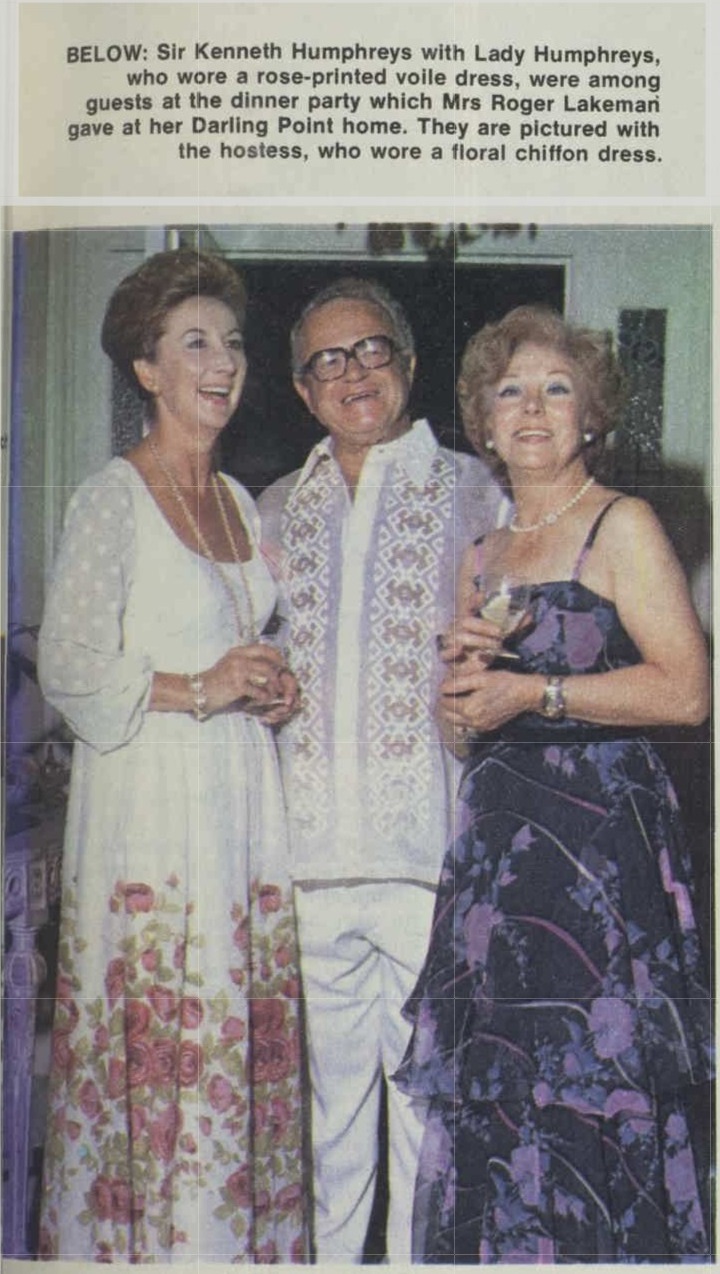
28th of January 1976 - People and Fashion - Trove , from the Australian Womens Weekly
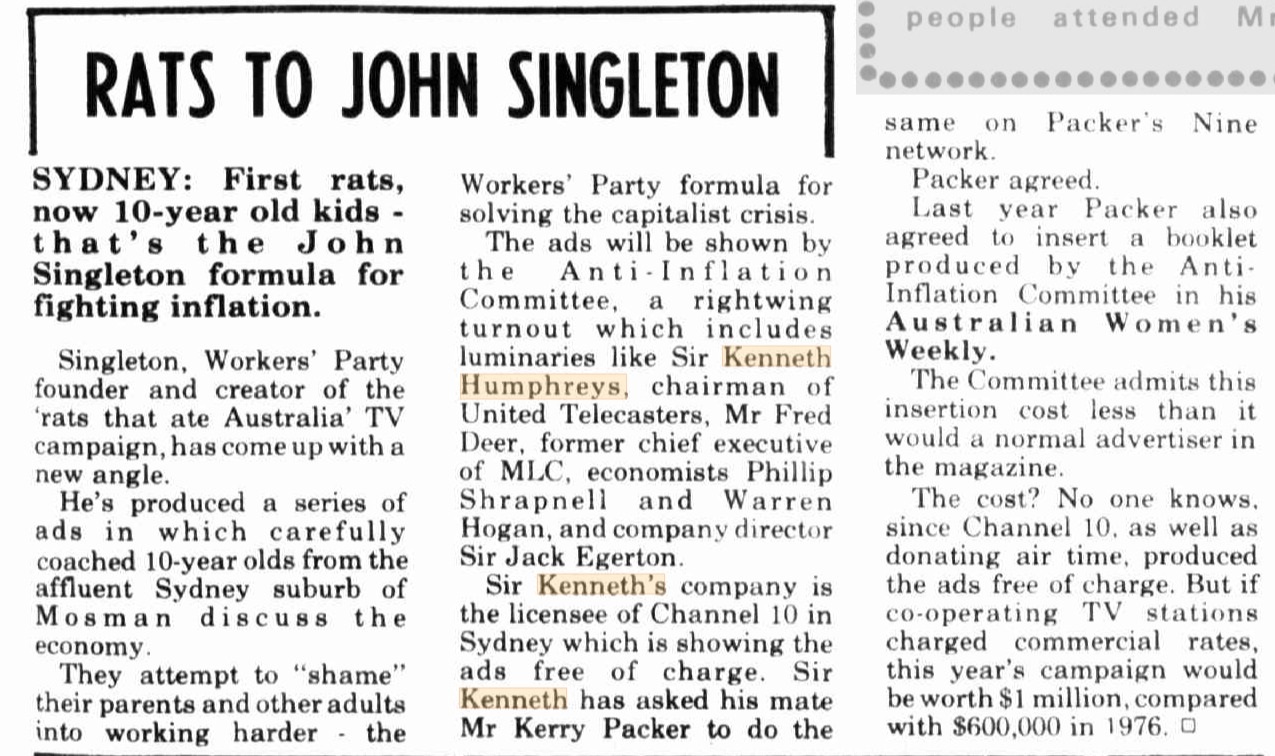
27 April 1977 - RATS TO JOHN SINGLETON article - via Trove
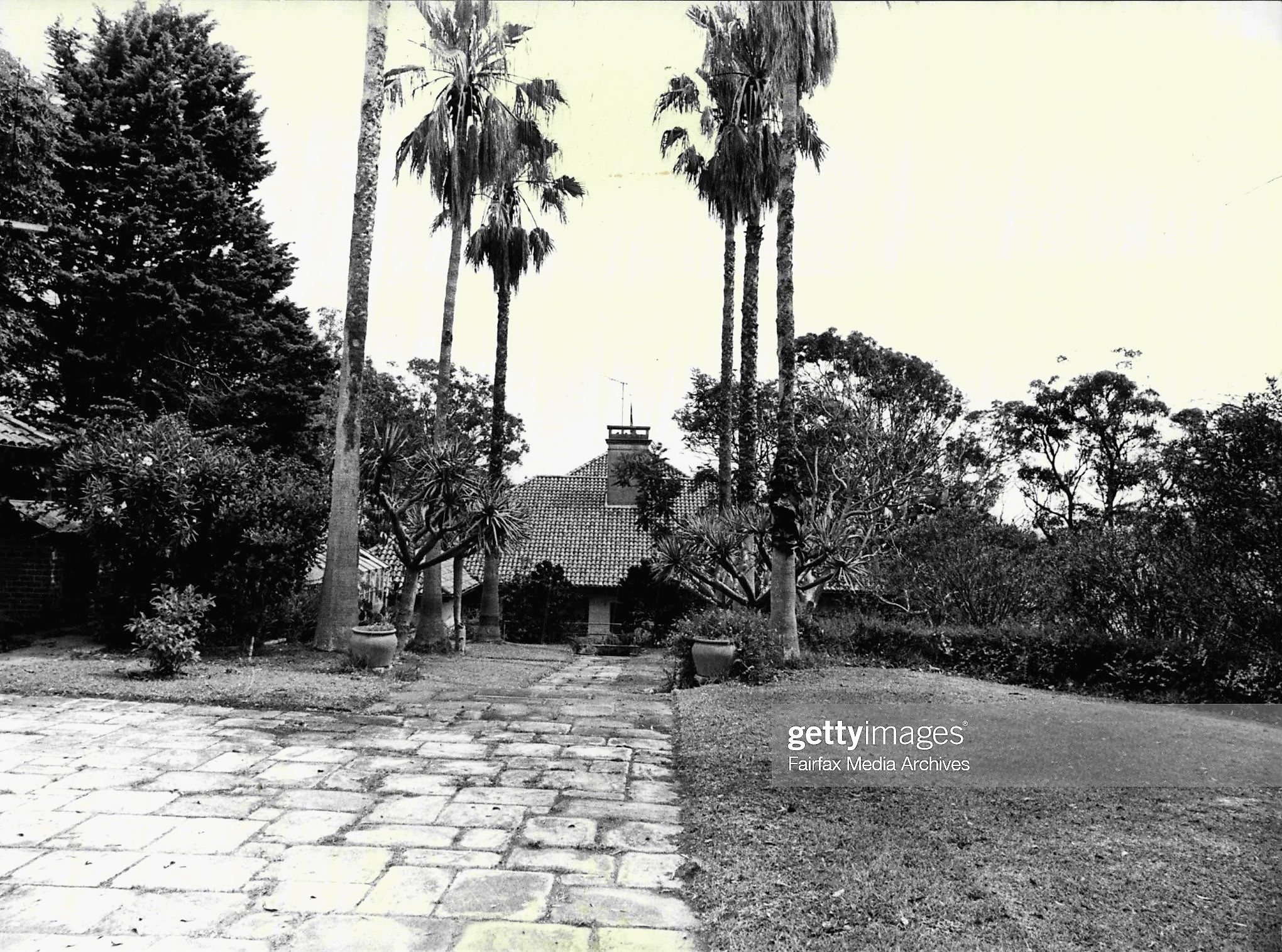
Finisterre circa 1975-76, courtesy Fairfax Archives
Born August 22nd 1918 at Artarmon, son of Arthur Gerald Humphreys and Olive Stephens nee Owens, he passed away February 7th 1981, just 62 years of age, possiby through doing way too much all the time. A few other insights:
APPOINTMENT OF RONALD ARTHUR IRISH, KENNETH OWENS HUMPHREYS, AND PETER LANCING CROSTHWAITE AS INSPECTORS UNDER SECTION 173 (1) OF THE COMPANIES ACT. 1961
I, Lieutenant-General Sir Eric Winslow Woodward, Governor of the State of New South Wales and its Dependencies, in the Commonwealth of Australia, in pursuance of the power conferred on me by section 173 (1) of the Companies Act, 1961, hereby appoint Ronald Arthur Irish, Kenneth Owens Humphreys, and Peter Lancing Crosthwaite to be inspectors to investigate the affairs of Latec Investments Limited, and to report to me thereon in writing.
Given under my hand and seal this seventh day of September, in the year of Our Lord, one thousand nine hundred and sixty-two, and in the eleventh year of Her Majesty's reign.
(l.s.) E. W. WOODWARD, Governor. By His Excellency's Command,
(5985) R. R. DOWNING, Attorney-General. APPOINTMENT OF RONALD ARTHUR IRISH, KENNETH OWENS HUMPHREYS, AND PETER LANCING CROSTHWAITE AS INSPECTORS UNDER SECTION 173 (1) OF THE COMPANIES ACT, 1961 (1962, September 14). Government Gazette of the State of New South Wales (Sydney, NSW : 1901 - 2001), p. 2681. Retrieved from http://nla.gov.au/nla.news-article220324917
Kenneth Owens Humphreys: aged 53: Chairman, Commonwealth Industrial Gases Ltd.: Manufacturers of industrial and medical gases, welding and cutting equipment, medical equipment.
UNIVERSITY OF NEW ENGLAND
Appointments to Council
HIS Excellency the Governor and the Executive Council, in pursuance of the provisions of section 10 of the University of New England Act, 1953, have approved of the appointment of the following persons as members of the Council of the University of New England, to hold office until 31st October, 1972:
Kenneth Owens Humphreys, Esq., F.C.A.
Keith Leonard Sutherland, Esq., Ph.D., D.Sc., F.R.A.C.I., A.R.I.C., M.Aust.I.M.M., F.A.A.
C. B. CUTLER, Deputy Premier and Minister for Education and Science. UNIVERSITY OF NEW ENGLAND (1971, April 30). Government Gazette of the State of New South Wales (Sydney, NSW : 1901 - 2001), p. 1375. Retrieved from http://nla.gov.au/nla.news-article220047908
Finisterre changed hands again on July 7th 1981 when sold by Lady Gladys Humphreys, the widow of Channel Ten chairman Sir Kenneth Humphreys, who paid $231,735 in 1976, to the Toohey family, who bought the five-bedroom house for $1.66 million. Lady Humphreys was registered as the owner in early June 1981, after all the paperwork that occurs when someone passes away had been finalised.
Toohey family patriarch Vincent James Toohey had built the original Time and Tide Hotel in Dee Why in the 1960s. They had also owned Tigh-na-Mana at Palm Beach, since soon after a Craig family member offloaded the former Summer boarding house on the beach. The Tooheys sold this place in 2020 after having had the place for decades by then:
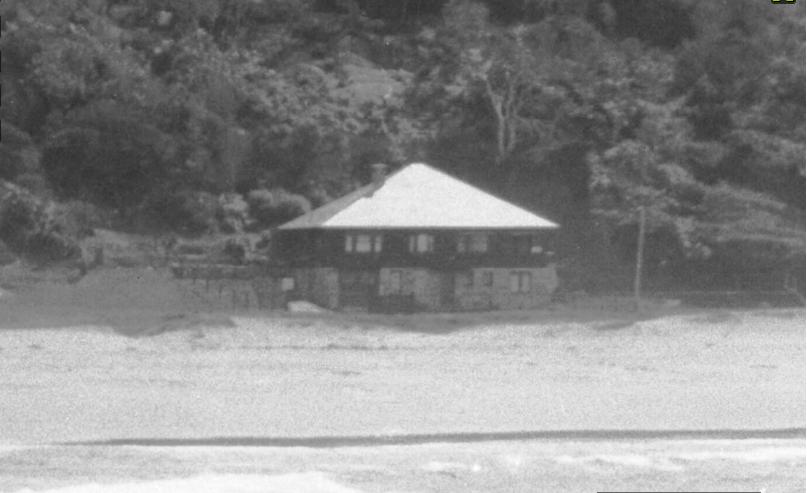
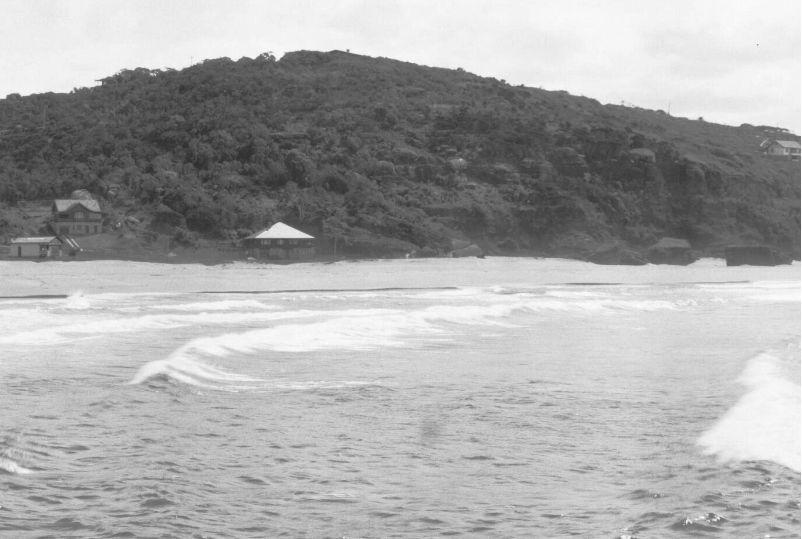
Publican Fined Over Beach Home
John Vincent Toohey, licensee of the Nelson Hotel, Oxford-street, Woollahra, was fined £10 in the Special Federal Court today for having made alterations to his Palm Beach property without WOI permission. Mr. Barwick. KC (for the defence) said Toohey submitted plans to Warringah Council, and was expressly told there was no need to get a WOI permit. Publican Fined Over Beach Home (1945, August 9). The Sun (Sydney, NSW : 1910 - 1954), p. 5 (LATEFINAL EXTRA V FOR VICTORY). Retrieved from http://nla.gov.au/nla.news-article230454299
Pittwater's double-digit sales began in 2002 with Finisterre, the area's most expensive waterfront property, selling for almost $20 million. The property served as the residence of family patriarch and Australian businessman Bob Oatley and second wife Val until wine magnate passed away in 2006 at the age of 87, still missed by many a Pittwater sailor. Finisterre is still held by this family.
The Oatley family’s Finisterre estate sits on more than 7000 square metres of waterfront land at the end of Stokes Point, although it would seem that recently a portion of this has been turned over to build a new property at the Cabarita road edge.
In 1990 Pittwater Council gave a Heritage Listing for Finisterre the property. The NSW Government's Heritage lists the following for Finisterre:
18. House - "Finisterre" Lot A, DP 319644 & PO 57/1236, No. 2 Cabarita Road, Stokes Point. PITTWATER COUNCIL - HERITAGE ACT, 1977 (1990, September 14). Government Gazette of the State of New South Wales (Sydney, NSW : 1901 - 2001), p. 8310. Retrieved from http://nla.gov.au/nla.news-article231938513
NSW Heritage Office - Department of Heritage and Environment
Listing No: 2270086
Gazette Date: 30/05/2014
Built at a prominent location on Stokes Point. Large two storey residence with stucco walls, Spanish terracotta tile roof. Extensive terraces and driveway with formal planting of palms. Stucco and stone gateposts.
Finisterre's design features such as the stucco walls, terracotta Spanish tile roof, terraces and stone gate posts make this this property architecturally significant in the Pittwater locality. The prominent position at the end of Stokes Point contributes to the iconic charm of Finisterre.
.jpg?timestamp=1692591674398)
The listing includes the interiors of the house; however detailed analysis and assessment should be undertaken at the time of any future changes to the interior in order to ascertain the relative heritage significance.
There appear to be some recent unsympathetic additions to the house.
Via Google maps it may be seen a tennis court and inground pool form part of the Stokes Point peninsula Finisterre site, along with buildings at the back of the imposing Pittwater and Lion Island facing front
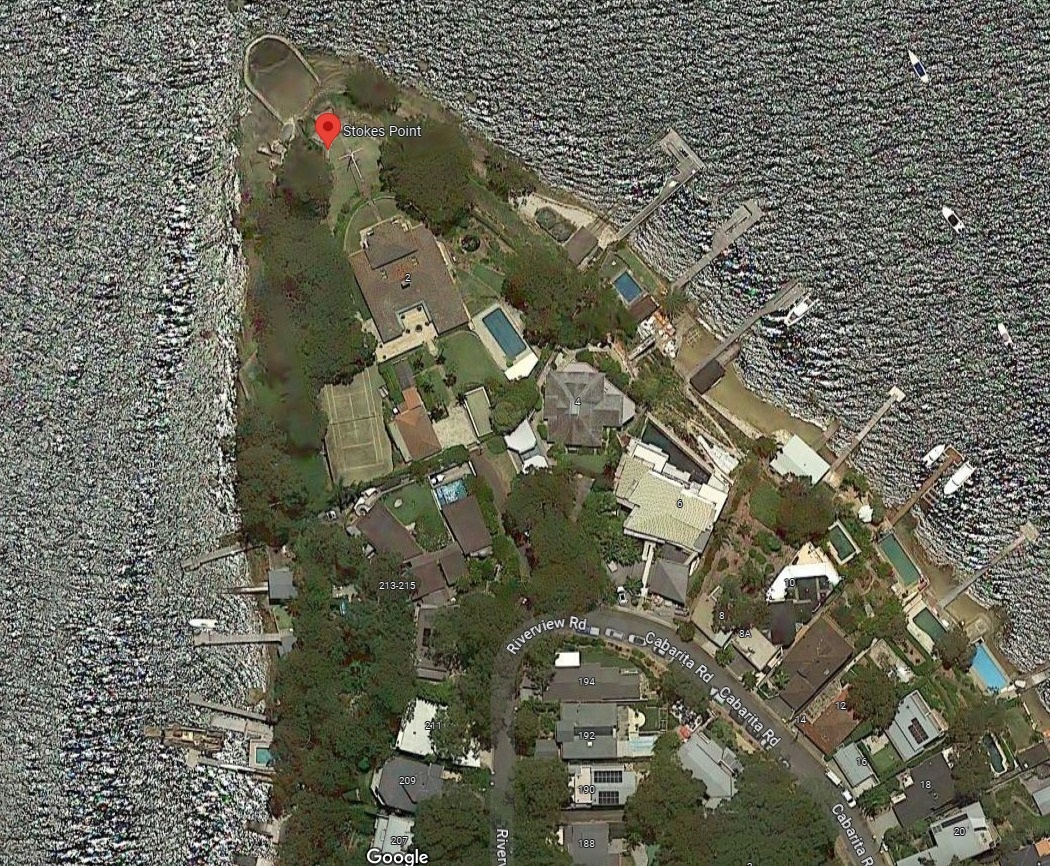
So from being a place where a hut where a fisherman lodged against the biting Winter winds and took shells gathered from the original custodians middens into Sydney to make lime for mortar to build all those sandstone heritage buildings in Sydney Town, to a holiday shack for a founder of the RSYS, to being a place where those who also liked 'mucking about in boats' and serving the community sought solace from the horrors of World war One and then World War Two, to still being a place for those who loved the snap of canvas and salt wind on their face, those Finisterre hallowed rocks, that grassy space and the walls of that home have played host to many a tinkling glass and sound of laughter, much alike the sound you hear when standing on the Pittwater waterfront facing a sea of masts and their rigging which a breeze is gently shifting, causing these to tinkle as well.
Long may she reign on Stokes Point!
references - Extras
- TROVE - National Library of Australia
- Historical Records Land Viewer (HRLV: https://hlrv.nswlrs.com.au/ ) - NSW Government
- Profiles of the Pioneers in Manly, Warringah and Pittwater - by Shelagh Champion, OAM, B.A.(Lib.Sc.) and George Champion, OAM, Dip.Ed.Admin(2013 Edition)
- The First Pittwater Regatta 1888
- Easter Cruises To Pittwater
- A Tent At The Basin
- The Basin, Pittwater: A Reprise
- My Holiday By Charles De Boos – 1861
- Historic Insights From The Australian National Maritime Museums 1890 Pitt Water 'Era' Yacht Collection - The RSYS Basin Regattas
- Florida House
- Pittwater Roads II: Where The Streets Have Your Name - Palm Beach
- Roads In Pittwater: The Barrenjoey Road
- Careel House
- Loggan Rock Cabin
- Albert George Verrills 1886-1960
- Fred Verrills – Builder Of Bridges And Roads Within Australia During WWII – Builder Of Palm Beach Thereafter
- The First Weekenders On The Palm Beach Beachfront + A Look Into Palm Beach SLSC Clubhouses In The Club's 101st Season
- Avalon Beach Reserve Heritage Marker For Old Kiosk Installed
- Careel Bay Steamer Wharf and Boatshed
- Boat Builders Of Pittwater II: From Cargo Schooners and Coasters To Sailing Skiffs and Motorised Launches
- John Collins (1815-1881 of Avalon)
- Albert Thomas Black - Customs Waiter of Barrenjuee
- Katherine Mary Roche (nee Collins) of Careel Bay and Bayview
- Archpriest John Joseph Therry (1790 - May 25, 1864)
- Herbert Henry Schlink (Sir) 28 March 1883 - 30 November 1962
- Early Pittwater Paddlers, Oarsmen, Rowers and Scullers: The Green Family
- Pittwater Roads II: Where The Streets Have Your Name - Careel Bay
- Careel Bay Playing Fields Reserve - Including Hitchcock Park: Birds, Boots & Beauty
- Avalon's Village Green: Avalon Park Becomes Dunbar Park - Some History + Toongari Reserve And Catalpa Reserve
- Pittwater Reserves: The Green Ways - Clareville and Taylor's Point Wharves
- Pittwater Roads II: Where The Streets Have Your Name - Clareville
- Pittwater Roads II: Where The Streets Have Your Name - Avalon Beach
- Avalon Beach Village Shops: Some History
- The Clareville/Long Beach Reserve: Some History Notes + Current Day Photos
- Pittwater Roads II: Where The Streets Have Your Name - Bilgola
- Pittwater Summer Houses: The Cabin, Palm Beach - The Pink House Of The Craig Family
- Oystering In The Pittwater Estuary - Oyster Kings And Pearl Kings And When Not To Harvest Oysters
113. Thomas Warner, 50, Fifty Acres, Parish of Narrabeen, commencing at the Northeast corner, and bounded on the East by a side the of twenty-five chains; on the South by a West line of twenty-five chains to Pitt Water; and on the West and North by the waters of Pitt Water to the commencing corner.
Promised by Governor Macquarie on 31st March, 1821. Quit-rent Is. sterling per annum, commencing 1st January, 1827.
114. Henry Gaskin, 50, Fifty Acres, Parish of Narrabeen, commencing at the North-east corner of Warner's fifty acres, and bounded on the West by a South line of twenty-nine chains; on the South by an East line of twenty chains ; on the East by a North line of twenty four chains to Pitt Water ; and on the North by the waters of Pitt Water to the commencing corner. Promised by Governor Macquarie on 31st March, 1821. Quit-rent 1s. sterling per annum, commencing 1st January, 1827.
115. John Joseph Therry, 1200, One thousand two hundred Acres, Parish of Narrabeen, commencing at the South-east comer of the Government Reserve of two hundred and eighty acres, and bounded on the North by that Reserve by a line West twenty-five chains to a Stream; on the North by that Stream and Careel Bay to the North-east corner of Henry Gaskin's fifty acres; on the West by Gaskin's by a line South twenty-four chains ; on the South by a line West twenty chains, and again by a line North four chains to the South-east corner of. Warner's fifty acres; on the North by Warner by a line West twenty-five chains to Pitt Water; on the West by the waters of Pitt Water to the North-west corner of John William's sixty acres; on the South by that farm by a line South fifty degrees East 38 chains ; on the West by a line South forty decrees West sixteen chains ; on the North by a line North fifty degrees West thirty-nine chains to the North corner of John Taylor's thirty acres; on the West by Taylor by a line South twenty three chains to Pitt Water; on the West by the waters of Pitt Water to the North-west corner of James M'Donald's thirty acres ; on the South by that farm by a line East eleven chains; on the West by a line South twenty-three chains to Robert Melvyn's sixty acres; on the South by part of Melvyn's farm, and by Porter's and Anderson's farms by a line East fifty chains to Martin Burke's fifty acres; on the East by that farm by a line North six chains to a Stream; on the East by that Stream, which is the Western boundary of John Farrell's sixty acres; on the South by that farm by a line East twenty-eight chains to the Village Reserve of one hundred acres; on the East by part of the Village Reserve by a line North seven chains to a Stream ; on the South by that Stream, which is the North boundary of the Village Reserve to the Sea; and on the East by the Sea to the commencing comer. Promised by Sir Thomas Brisbane, 200 acres, on 23d July, 1824 ; 500 acres on 1st September,1824; and 500 acres on the 19th December,1825. Quit-rent £9 8s. 4d. sterling per annum, commencing 1st January, 1829. Classified Advertising. (1832, November 1). The Sydney Gazette and New South Wales Advertiser (NSW : 1803 - 1842), p. 1. Retrieved from http://nla.gov.au/nla.news-article2209217
Colonial Secretary's Office, Sydney, 3d Sept. 1833.
TITLE DEEDS.
THE undermentioned Deeds of Grants have been transmuted from this office to the Registrar of the Supreme Court, during the past month, to be by him forwarded in the usual manner, through the Surveyor General to the Collector of Internal Revenue, and will he delivered by the last mentioned officer, on application after the 1st October next viz:
Lands of which descriptions have been Advertised in the notices specified Notice of 25th May, 1831.
49 Thomas Lewis, 30 acres, Cumberland,
50 No 8450 William Mobbs, 30 acres, Cumberland, No 89
51 Robert Macintosh, the elder, 200 acres, Cumberland, No 109
52 Jeremiah Bryant, 80 acres, Cumberland, No 11153
53 John Taylor, 30 acres, Cumberland, No 112
54 Thomas Warner, 50 acres, Cumberland, No 11355
55 Henry Gaskin, 50 acres, Cumberland, No 11456
56 John Farrell, 60 acres, Cumberland, No 116
57 Martin Burke, 50 acres, Cumberland, No 117
58 Isaac Shepherd, 100 acres, Cumberland, No 122
59 Henry Grattan Douglas, 1,100 acres, Cumberland, No 124
Deeds dated 8th July, 1833. By His Excellency's Command, ALEXANDER McLEAY.
Colonial Secretary's Office, Sydney, 3d Sept. 1833. TITLE DEEDS. (1833, September 9). The Sydney Herald (NSW : 1831 - 1842), p. 4. Retrieved from http://nla.gov.au/nla.news-article12847675
Davies Family Notes
DIVORCE COURT.
'THE KENTUCKY BELLE.'
Before Mr. Justice Simpson, in the Divorce. Court, Lewis James Davies applied for a divorce from Elizabeth Montague Davies, formerly Smith, on the ground of her adultery with William Hinson, who was Joined as correspondent. The respondent and the co-respondent had filed answers, in which they denied the Allegations made against them.
Mr. Want and Mr. Ralston appeared for the petitioner, and Mr. Whitfeld to watch the case on behalf of the respondent. The correspondent was not represented. The petitioner deposed to having married the respondent in January, 1895, at Santa Clara, California, according to the Episcopalian rites. Three weeks later they came to Australia. His wife's people were reputed to be wealthy. She was an only daughter. Arrangements were made that he should lake her to stay with her people from time to time. He lived with her till November 17 last year, when she left on another trip to California. He saw her off, and he had made arrangements to follow some months later. Two or three months later, after she left he made certain inquiries, and some letters were handed to him as the result of his investigations. The co-respondent he knew for the first time in 1899. He came from California in the same boat as his wife, and was an agent for English firms. He used to visit petitioner's house as a friend, up to the day before the respondent left. Petitioner received a letter from the respondent while in Melbourne, which was addressed from 'Santa Clara, the name of his house at Point Piper in which she stated that she was very comfortable on a certain night 'at Effie's.
Francis Baker Taylor, a Customs House agent and insurance broker, carrying on business in Sydney, said he knew Mrs. Davies and Miss — He remembered going with them to Willoughby on Eight-hour Day, 1901, for an outing. They went to a hotel at Willoughby. It was called the Willoughby Hotel, and there were bedrooms leading off the balcony at the place. Hinson came up in the afternoon, and went out and sat on the balcony. Mrs. Davies went into a bedroom leading off the verandah. Witness was in the sitting-room at the time and had a view of the balcony, from which Hinson disappeared. There were two other bedroom leading off the balcony. He did not see Hinson enter the room in which Mrs. Davies was but he saw him come from the door of that room. He did not actually see him come out of the room. Mrs. Davies came from the same direction as Hinson. Before she entered the bedroom she said to Miss-- that she was going into the room to wash her hands. He suspected something, and watched. The same day, on the way home, he spoke to her about what he had seen. He told her that he had seen Hinson practically go into the room, and that there was a probability of a scandal. She said she was going to marry Hinson, and that it was all right. On another occasion, at a luncheon party at the Hotel Australia, he saw her there. Hinson was also there. It was two or three days before she went away. He saw her in the street after the luncheon, and spoke to her about Hinson being there. She said she had remained behind at the hotel after the luncheon, and had been to Hinson 's room. Miss-- was at the luncheon, and he spoke to Mrs. Davies about Miss' name being compromised. Witness told Mrs. Davies that she ought not to have stayed at the hotel after the luncheon. He charged her with having misconducted herself, and she said it didn't matter. It was not until a month ago that he mentioned the matter to Mr. Davies. He refused to give a statement about it, and wasted to keep out of it as well as he could.
Euphemia Stewart said she knew Mrs. Davies, and had been on friendly terms with her for some time. She knew Hinson, and bad seen bint at Point Piper. In July, 1900, she went to Melbourne with Mr. and Mrs. Davies, and they stayed at the Oriental Hotel. When they arrived Hinson was also at the hotel. Mr. Davies went a war. and left witness and Hn. Davies, who then shared the same bedroom, behind. Hinson lived at the hotel. Before retiring at night Mrs. Davies sometimes took a bath. One night she put a dressing gown on, 'did her hair, and powdered her face.' That was after 10 o'clock. Witness was nervous, and remained awake for some hours. Before she went to sleep she locked the door. It was not till next morning that she again saw Mrs. Davies. It was at an early hour. She. locked at the door. and witness let her in.
His Honour: Was the powder on her face when she came back. Did you notice it? — No.
Witness went on to say that when Mrs. Davies came into bedroom witness told her she was going away, as she didn't like being left alone. Mrs. Davies asked her to say nothing about her being out of the room, and said, 'Ton must think I'm a very horrible woman.' Witness remembered on one occasion going with Mrs. Davies to the Club Chambers, Phillip-street. Mr. Davies had gone to Melbourne. She left Hinson and Mrs. Davies at the chambers. It was not true that that night Mrs. Davies stayed at witness' house or at her aunt's. She remembered being at Willoughby when Mr. Taylor was there. Mrs. Davies and Hinson were 'Way for some time. When she was going away from Sydney, Mrs. Davies told her she was going to marry Hinson, and showed her a ring, which she said he had given her. Witness bad been seen several times with a view of giving information, but she refused to give it, as she did not want to be mixed up in the matter at all.
Mrs. Davies used to recite a piece called 'The Kentucky Belle,' and Hinson, when speaking of and to her, called her 'Ken.' This closed the case for the petitioner. His Honour: You have no evidence, Mr. Whitfield? Mr. Whitfeld; No. your Honour; she's not coming over. His Honour found In favour of the petitioner, and granted a decree nisi, making it returnable In six months. DIVORCE COURT. (1903, December 11). Evening News (Sydney, NSW : 1869 - 1931), p. 4. Retrieved from http://nla.gov.au/nla.news-article113793746
DAVIES AND FEHON, LTD.
In future the business of Messrs. Dayies and Felion, which comprises general importers, shipowners, charterers, coal exporters, timber merchants, and operators in American and foreign merchandise, will be carried on under the above title, the business having been formed into a limited liability company. The magic word 'Limited,' thus added may seem to have some importance in the matter of increasing the trade of the well-known house of D. and F. but since its inception the business of the firm has proved a rapidly progressive one, and today takes a high rank in the commercial institutions of the city. May it continue to prosper under the new house flag. Notes and Comments. (1903, August 12). Daily Commercial News and Shipping List (Sydney, NSW : 1891 - 1954), p. 4. Retrieved from http://nla.gov.au/nla.news-article157972667
Manly Butcher's car of 1911 from Davies and Fehon:
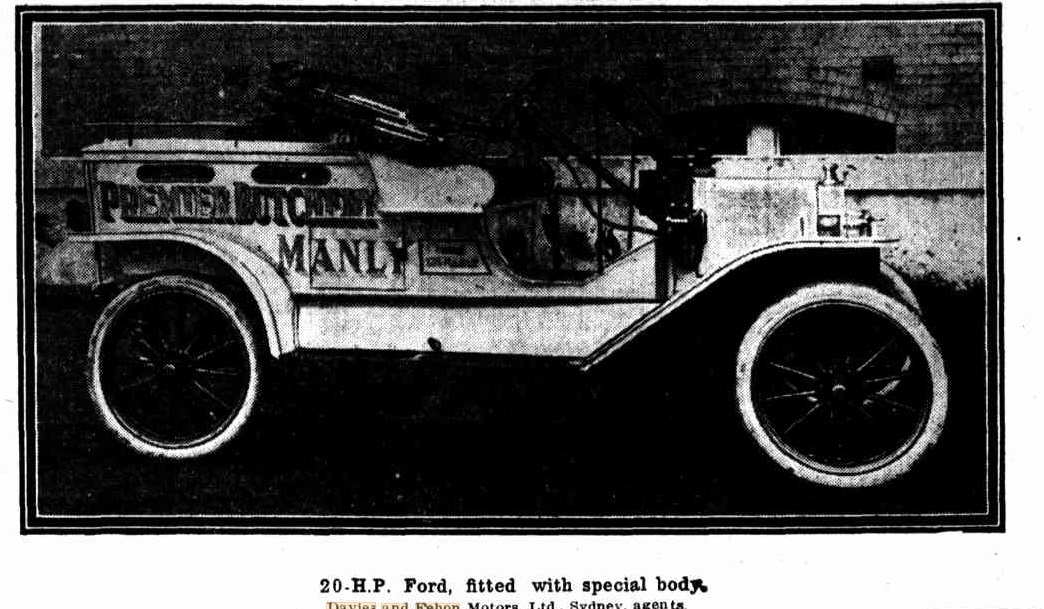
Messrs. Davies and Fehon, agents for the Crossley, Blanchi, Renault, Ford, &c., cars, report excellent business during the week. The firm has sold every available car, and a new shipment is due next week. MOTORS, BOTORS, AND AEROPLANES. (1911, June 24). The Sun (Sydney, NSW : 1910 - 1954), p. 10. Retrieved from http://nla.gov.au/nla.news-article221575023
DAVIES AND FEHON MOTORS.
One of the most attractive and largest exhibits at the show is that of Messrs. Davies and Fehon Motors, Limited. They have seven cars on exhibit. The Renault chassis of 14-20 h.p., and a little 9-10 h.p. single-seater of the same make, attract a good deal of notice, na rhla la nnn of the most DOnuInr makes of cars on -the market. An 18-20 h.p. Blanchi chassis displays the excellent workmanship of the Italian engineers. Two Metallurgiqun cars of 14 h.p, and 20 h.p, respectively, are shown; also a 14-li.p. single-seator Crossley, and a 20-h.p. of the same make. This car is one of the best British makes, and one of its features is the fitting of front wheel - brakes. Messrs. Davies and Fehon Motors have a nice display. On another stand the firm are showing the Ford car in three models; also' a dissected Ford, showing all the working parts.
.jpg?timestamp=1692503828764)
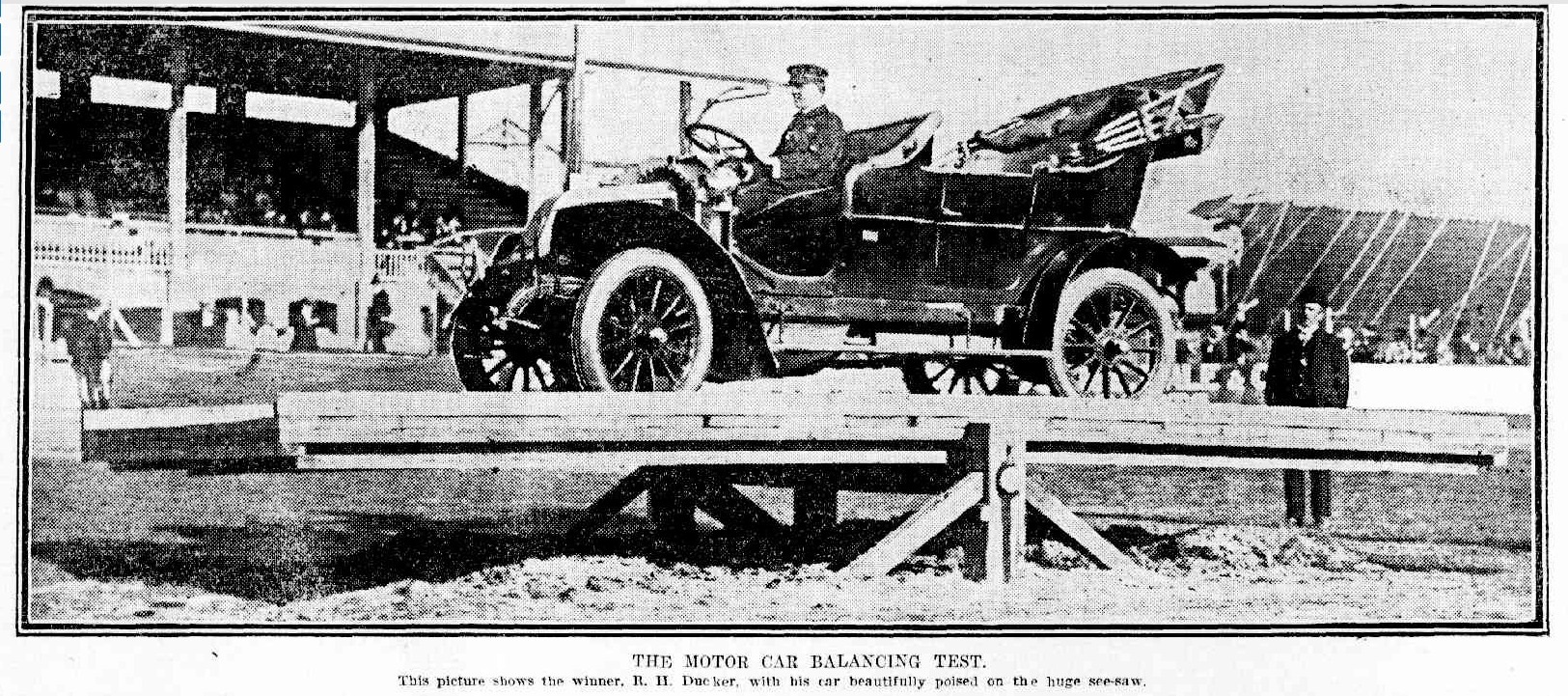
THE -MOTOR CAR BALANCING TEST. " This picture shows the winner, R. H. Ducker, with his car beautifully poised, on the huge see-saw. THE LIFE-BELT CONTEST-REPLACING THE DRIVING BELT. DAVIES AND FEHON MOTORS. (1911, October 2). The Daily Telegraph (Sydney, NSW : 1883 - 1930), p. 15. Retrieved from http://nla.gov.au/nla.news-article239192110
MESSRS. DAVIES & FEHON'S STEAMERS.
Messrs. Davies and Fehon, Ltd., have fixed the steamer Ikala to load at San Francisco, Eureka and Puget Sound for Melbourne. The steamer Koju Maru arrived at Honolulu on the 20th September from Newcastle, and upon discharge of her coal cargo left on the 5th inst. for Puget Sound to load lumber back to an Australian port. The steamer Strathallan arrived at Honolulu on the 16th September from Newcastle, and left again on the 27th for Eureka, where she arrived on the 6th inst. to load for Australia.' The steamer Auchencrag has been fixed to load timber at Otaru for Australia. MESSRS. DAVIES & FEHON'S STEAMERS. (1912, October 14). Daily Commercial News and Shipping List (Sydney, NSW : 1891 - 1954), p. 4. Retrieved from http://nla.gov.au/nla.news-article158456936
Davies and Fehon Motors, Limited
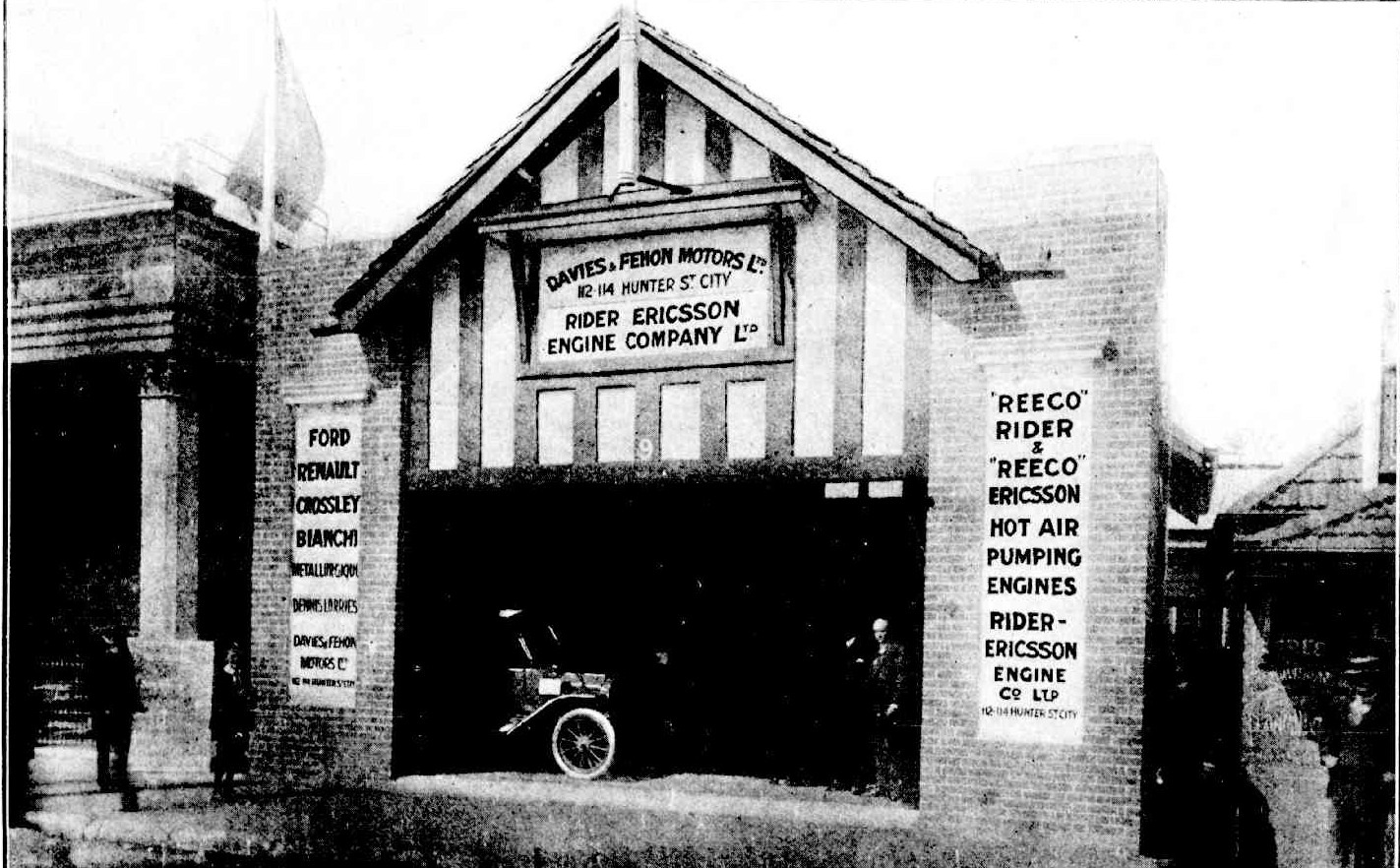
The well-known firm of Davies and Fehon had an imposing stand in the Park-road. It contained examples of the Ford motor car, and the Dennis lorries. A feature of the exhibits is a Ford station utility car. This is adapted to many purposes, including the carriage of goods up to"5cwt. Its price is only £180 complete. This firm are the agents of the Renault. Crossley, Bianchi, and Metallurgique cars, in addition to Ford and Dennis lorries. It was on a Ford touring car, it will be remembered that Mr. Francis Birtles recently toured across Australia in 15 days from north to south, without carrying any spare parts Mr. Birtles stated that he does not believe there is another car made which could have come through the trying conditions the Ford did without trouble of some kind. Of the many motor cars on the market, some have a reputation all their own, and their - merits are so even that the task of differentiation is somewhat difficult; and this is why a novice, who desires to purchase a motor car, needs to be careful how he proceeds, arid is wise to take advice from those who know. In this connection, it may be said that the merest tyro could put his faith in a Ford, buy it with his eyes shut, so to speak, because everyone speaks well of it; and what Birtles said was one of the best advertisements the Ford ever had. During the show the stand was well patronised by motor enthusiasts and men from the back-blocks; and Mr. Doyle, who was in charge of the exhibits, had a busy time throughout, a considerable amount of business having been transacted. The Sydney address of the firm is 112-114 Hunter-street.
Exhibit of Davies and Fehon Motors, Ltd. Davies and Fehon Motors, Limited (1914, April 15). Australian Town and Country Journal (Sydney, NSW : 1870 - 1919), p. 32. Retrieved from http://nla.gov.au/nla.news-article263732639
By 1920s were opening showrooms for cars at places like Lismore as well.
Motor Tractors. Ltd., capital £20,000 in £1 shares, to carry on business of inventors, Importers, etc. First directors, Lewis James Davies and Arthur Henry Davies. COMPANY NEWS. (1919, November 7). The Sydney Morning Herald (NSW : 1842 - 1954), p. 8. Retrieved from http://nla.gov.au/nla.news-article15855137
DEATHS.
DAVIES.— September 9th, 1919, at his late residence, ".St. Ithome," Point Piper, Captain Lewis Davies, in his 87th year. Family Notices (1919, September 10). The Daily Telegraph (Sydney, NSW : 1883 - 1930), p. 6. Retrieved from http://nla.gov.au/nla.news-article239637452
DAVIES LEWIS 15672/1919 parents: LEWIS and HANNAH at WOOLLAHRA - born in circa 1832
DAVIES-The Interment of the late Captain LEWIS DAVIES will take place in South Head Cemetery, THIS WEDNESDAY, at 11 a.m. By request, no flowers. Mrs. P. KIRBY and SON, LTD., Funeral Directors, Elizabeth-street, Sydney. Family Notices (1919, September 10). The Sydney Morning Herald (NSW : 1842 - 1954), p. 9. Retrieved from http://nla.gov.au/nla.news-article15853694
In the Supreme Court of New South Wales.
PROBATE JURISDICTION.
In the will and codicil of Lewis Davies, late of Wollahra Point, near Sydney, in the State of New South Wales, gentleman, deceased. PURSUANT to the "Wills, Probate and Administration Act, 1898," and the "Testator's Family Maintenance and Guardianship of Infants Act, 1916" : Notice is hereby given that all creditors and other persons having any debts, claims, or demands of what kind so ever upon or affecting the estate of the abovenamed deceased, who died on or about the 9th day of September, 1919, and probate of whose will as incorporated in the codicil thereto was granted by the Supreme Court of New South Wales in its Probate Jurisdiction, on the 15th day of January, 1920, to the Permanent Trustee Company of New South Wales, Limited, of 25 O'Connell-street, Sydney, and Lewis James Davies, of Wolseley-road, Point Piper, Sydney, the executors named in the said codicil, are hereby required to send in particulars of such debts, claims, and demands to the said executors, on or before the 13th day of March, next, at the expiration of which time the said executors will proceed to distribute the assets of the said deceased among the persons entitled thereto, having regard to the debts, claims, and demands only of which they shall then have had notice; and the said executors will not be liable, for the assets so distributed to any person of whose debt, claim, or demand they shall not have had notice at the time of such distribution.—Dated this 30th day of January, 1920.
For the Permanent Trustee Company of New South Wales, Limited, A. PERCEVAL BEDFORD, Norton Smith & Co., Manager. Proctors, 2 O'Connell-street, Sydney. 2851 7s. 6d. PROBATE JURISDICTION. (1920, January 30). Government Gazette of the State of New South Wales (Sydney, NSW : 1901 - 2001), p. 677. Retrieved from http://nla.gov.au/nla.news-article220080773
MR. LEWIS J. DAVIES
Death Announced
A cable message received in Sydney reported the death of Mr. Lewis J. Davies, formerly of the firm of Davies and Fehon, of Sydney, who went some years ago to the Isle of Jersey.
He was a well-known figure in the business life of Sydney for a number of years, having, shortly after his arrival, in Australia, established himself in business and taking into partnership Mr. Fehon, a son of a former Commissioner of Railways of this State. The firm carried on for many years the business of importing American timber and exporting Australian coal to America.
He was an enthusiastic yachtsman and owned several motor craft. He was also a keen golfer and belonged for some time to the Royal Sydney Golf Club and the Royal Sydney Yacht Club. A brother, Mr. A. J. Davies, who was in the Isle of Jersey when Mr. Lewis J. Davies died, is a well-known member of the Royal Motor Yacht Club and Royal Prince Alfred Yacht Club. Mr. Lewis J. Davies was twice married, and has left a Widow and a grown-up family of sons and daughters. MR. LEWIS J. DAVIES (1936, April 9). The Sun (Sydney, NSW : 1910 - 1954), p. 11 (COUNTRY EDITION). Retrieved from http://nla.gov.au/nla.news-article230825115
ESTATE OF CAPT. DAVIES.
Friday last a question was brought before Mr. Justice Long Innes in the Equity Court, Sydney, concerning the estate of the late Captain L. Davies, father of Mrs. W. H. Warhurst a long time highly respected resident of Kempsey. By his will, Captain Lewis Davies, a shipowner, formerly of Liverpool, who became domiciled in Sydney about 1914, left his residuary estate on trust for three of his children and their issue. The residuary trust fund in the hands of the trustees amounts to £74,156.
One of his sons and a beneficiary was Mr. Lewis James Davies, formerly a partner in the Sydney firm of Davies and Fehon, who, after retiring from business, went to live in the Channel Islands. He died in 1936, and his widow was one of the defendants in proceedings instituted by the trustee of Captain Lewis Davies, by which the Court was asked whether the trust for Captain Davies's grand-children was valid. The testator died a widower, leaving him surviving three sons and two daughters. By his will one son (Mr. Sidney Edward Davies) and a daughter (Mrs. Blanche Stephens), now deceased, did not benefit, the testator stating that both were amply provided for. After payment of debts, funeral, and testamentary expenses, etc., he gave his residuary estate to his trustee on trust to pay the income from third shares of the fund to each of three of his children— Mr. Lewis James Davies, Mr. Arthur Henry Davies, and Mrs. Lillian Warhurst, and on their respective deaths on trust for grand-children. By a codicil, the testator excluded from the gift over children born of Mr. Lewis James Davies's first marriage, and declared that only the children of his second marriage should participate on their father's death. The provision in the will in respect of the third share of residue, of which he was life tenant, was "After his death in trust for the children of my sons, Lewis James and Arthur Henry, and my daughter, Lillian Warhurst, living at the date of my said son's death, in equal shares as tenants in common, per capita and not per stirpes, who, being male, shall attain the age of 25 years, or, being female, shall attain that age or marry.'
On the deaths of Mr. Arthur Henry Davies and Mrs. Warhurst, the gift over was expressed in similar terms to their issue, and the issue of Mr. Lewis James Davies. The class to take at the death of Mr Lewis James Davies therefore consisted of persons coming, within the definition contained in the will. As there might thus be a grandson, or grand-daughter in existence under four years member of the class could not be ascertained until more than 21 years later, doubts had arisen as to whether the gift by the testator to his grandchildren infringed the rule against perpetuity. His Honor said that he was unable to extract from the remainder of the will any intention on the part of the testator that the benefit given grandchildren vested on attaining 25. He held that, subject to the respective life interests, in the fund bequeathed to three of his children, the testator died intestate. The residuary fund, therefore, passes on intestacy, as at the death of the tenant for life of each third. ESTATE OF CAPT. DAVIES. (1938, November 2). The Macleay Chronicle (Kempsey, NSW : 1899 - 1952), p. 1. Retrieved from http://nla.gov.au/nla.news-article173120272
MRS. LILIAN H. WARHURST.
The death occurred at Yeulba, Bowral, on November 9, of Mrs. Lilian Hannah Warhurst, wife of Mr. W. H. Warhurst. For many years, both were well known and respected residents at Orange Grove, East Kempsey, where Mr. Warhurst conducted a model property, and bred high class Jerseys while resident there. Mrs. Warhurst took a prominent part in the social life of the town. She was a keen sportswoman and no mean exponent at golf, being an associate of the East Kempsey Club, and finally became president. She was also prominently associated with .the C.W.A. and the Red Cross Society. She, with her husband, was iu the forefront in the movement which culminated in the establishment of the East Kempsey Golf Club links on the present site in preference to that along the flat immediately below the East Kempsey School. Only recently Mrs. Warhurst visited Kempsey with her husband and renewed acquaintance with a host of friends.— 'Argus.' MRS. LILIAN H. WARHURST. (1942, November 18). The Manning River Times and Advocate for the Northern Coast Districts of New South Wales (Taree, NSW : 1898 - 1954), p. 3. Retrieved from http://nla.gov.au/nla.news-article171303639
Her death record lists only her father as ‘Lewis’ – no mother, so they she may have passed away decades before her father died in 1919, already a widower at 87 years of age. Her husband William Herbert Warhurst, who had served for decades on Kempsey Council, passed away in November 1944 after a long illness.
In the Supreme Court of New South Wales.
PROBATE JURISDICTION.
In the will of Lewis James Davies, late of Oaklands, in the parish of St. Helier, Jersey, in the Channel Islands, formerly of Killeronae, Wolseley-road, Point Piper, in the State of New South Wales, retired merchant, deceased.
PURSUANT to the Wills, Probate and Administration Act, 1898, the Testator's Family Maintenance and Guardianship of Infants Act, 1916, and the Trustee Act, 1925: Notice is hereby given that all creditors, .widow, child, or children and other persons having any debts, claims or demands of what kind soever upon or affecting the estate of the abovenamed deceased, who died on or about the 6th day of April, 1936, and letters of administration of whose estate, with the will annexed, were granted by the Supreme Court of New South Wales, in its Probate Jurisdiction, on the 25th day of November. 1936, to the Permanent Trustee Company of New South Wales Limited, the administrator of the said estate, are hereby required to send in particulars of such debts, claims and demands to the said administrator, on or before the 15th day of February next, at the expiration of which time the said administrator will proceed to distribute the assets of-the said deceased among the persons entitled thereto, having regard to the debts, claims and demands of which it shall then have had notice; and the said administrator will not be liable, for the assets so distributed, to any person of whose debt, claim or demand it shall not have had notice at the time of such distribution.—Dated this 11th day of December, 1936.
For the Permanent Trustee Company of New South Wales Limited,
J. W. BARNES, Manager. Norton Smith and Company, Proctors. 1523 £1 12s. PROBATE JURISDICTION. (1936, December 11). Government Gazette of the State of New South Wales (Sydney, NSW : 1901 - 2001), p. 5135. Retrieved from http://nla.gov.au/nla.news-article223056827
In the Supreme Court of New South Wales.
PROBATE JURISDICTION.
In the will and codicil of Lewis Davies, late of Sydney, in the State of New South Wales, Australia, shipowner, deceased.
PURSUANT to the Wills, Probate and Administration Act, 1898-1938, the Testator's Family Maintenance and Guardianship of Infants Act, 1916-1938, and the Trustee Act, 1925-1938: Notice is hereby given that all creditors, •child or children, and other persons having any debts, claims or demands of what kind soever upon or affecting the estate of the abovenamed deceased, who died on or about the 9th day of September, 1919, and probate of whose will and codicil was granted by the Supreme Court of New South Wales, in its Probate Jurisdiction, on the 22nd day of January, 1920, to the Permanent Trustee Company of New South Wales Limited and Lewis James Davies, of 23 O'Connell-street, Sydney, New South Wales, the executors named in the said will, are hereby required to send in particulars of such debts, claims and demands to the said executors on or before the 8th day of November next, at the expiration of which time the said executors will proceed to distribute the assets of the said deceased among the persons entitled thereto, having regard to the debts, claims and demands only of which they shall then have had notice; and the said executors will not be liable, for the assets so distributed, to any person of whose debt, claim or demand they shall not have had notice at the time of such distribution.— Dated this 7th day of June, 1940.
For the Permanent Trustee Company of New South Wales Limited,
E. V. T. WHITTLE, Manager.
Norton Smith & Co., Proctors, 39 Hunter-street, Sydney, New South Wales. GG £1 12s. PROBATE JURISDICTION. (1940, June 7). Government Gazette of the State of New South Wales (Sydney, NSW : 1901 - 2001), p. 2507. Retrieved from http://nla.gov.au/nla.news-article225101794
Francis Lewis Davies - Notes
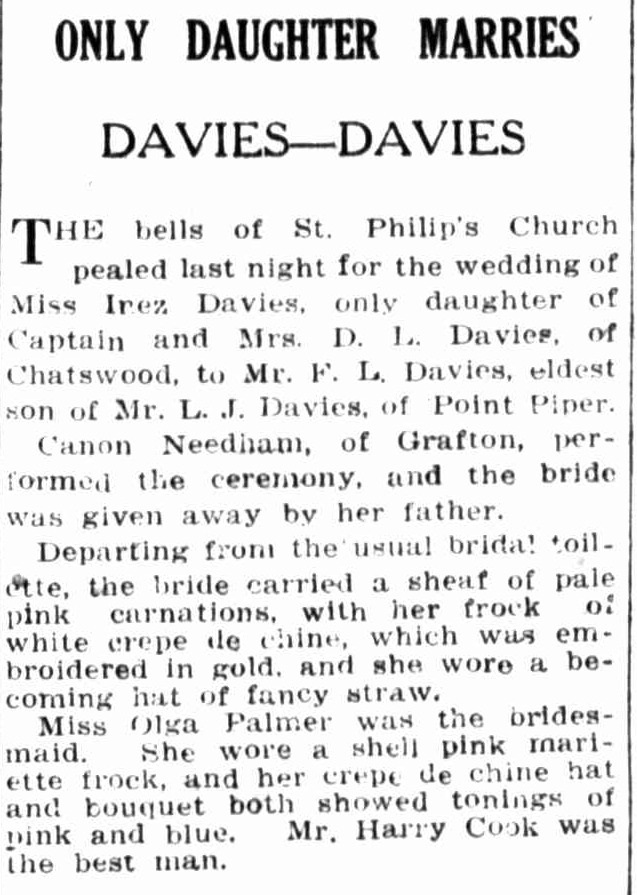
PEALING BELLS (1927, November 10). The Sun (Sydney, NSW : 1910 - 1954), p. 21 (FINAL EXTRA). Retrieved from http://nla.gov.au/nla.news-article222731425
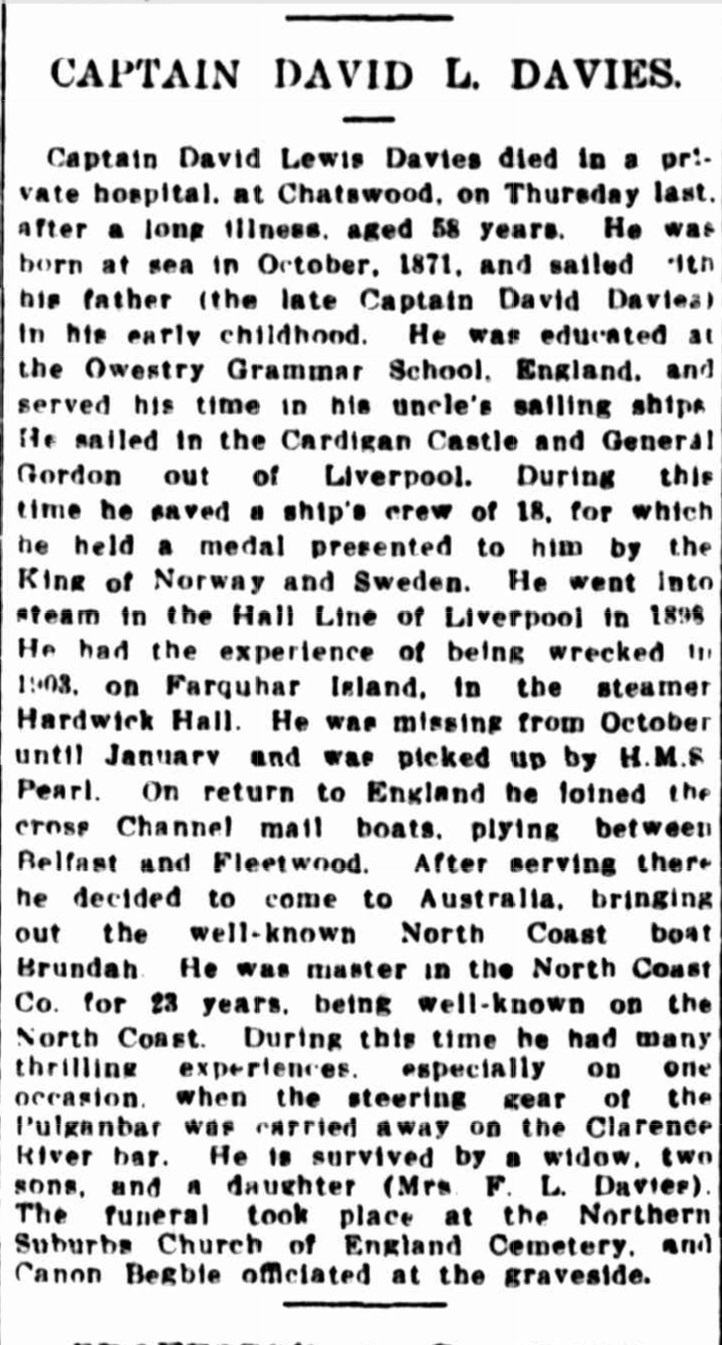
CAPTAIN DAVID L. DAVIES. (1929, May 29). The Sydney Morning Herald (NSW : 1842 - 1954), p. 19. Retrieved from http://nla.gov.au/nla.news-article28047950
Engaged To Airman
London, Friday
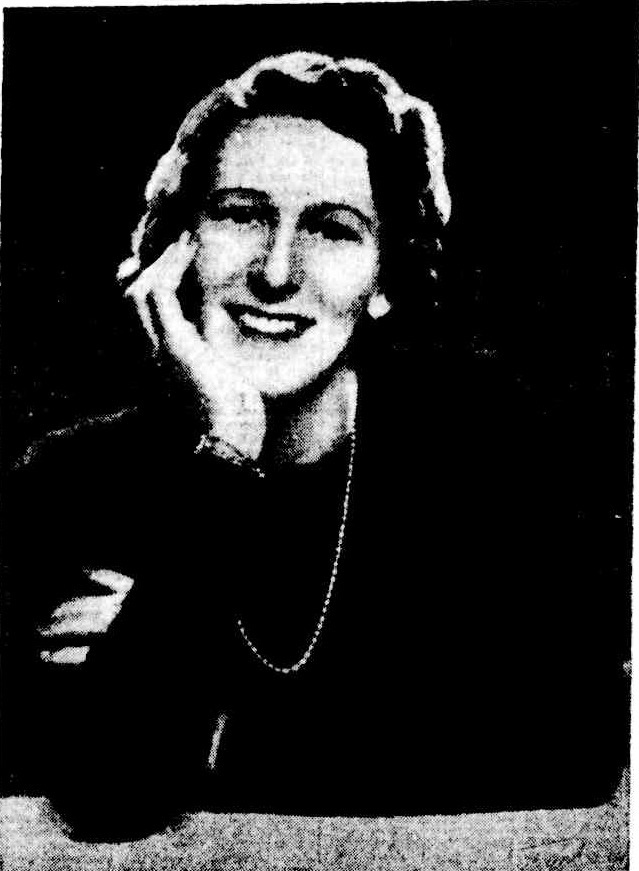
MISS CHERRY DAVIES, formerly of Sydney,' is engaged to Mr. Alfred Jackaman, well-known air man. Miss Davies is the daughter of Mr. Arthur Davies, who now lives in London. Mr. Jackaman is the representative of a civil aviation concern in East Africa. He planned the layout of the airports at Gatwick and Gravesend. Miss Davies is well known in Sydney, where she was educated. With her father, she was here 'on a visit early this year. Engaged To Airman (1938, June 11). The Daily Telegraph (Sydney, NSW : 1931 - 1954), p. 9. Retrieved from http://nla.gov.au/nla.news-article247243276
SOUTH AFRICAN AIRMAN To Marry Sydney Girl LONDON, June 10. It is announced that Mr. A. C. Morris Jackaman, of Nairobi, Kenya, a well known airman and an Air Ministry civil aviation representative in East Africa, has become affianced to Cherry, the only child of Mr. and Mrs. Arthur Davies. Mr. Jackaman has won many air trophies, including the Siddeley Challenge for the highest speed in a King's Cup race. SOUTH AFRICAN AIRMAN (1938, June 11). Newcastle Morning Herald and Miners' Advocate (NSW : 1876 - 1954), p. 14. Retrieved from http://nla.gov.au/nla.news-article133615136
Alfred Charles Morris Jackaman
Born 8 Jan 1904 in Slough, Buckinghamshire, England, United Kingdom
Husband of Muriel Norah (Davies) Jackaman OAM — married 1938 in Alexandria, Egypt
Muriel Norah (Cherry) Jackaman OAM formerly Davies
Born 1910 in Woollahra, New South Wales, Australia
Died 2011 at about age 101
H J Graham loses his wife:
CORONER INQUESTS.
SAD BOATING ACCIDENT OFF MIDDLE HEAD.
At the Soudan Hotel yesterday the Acting Coroner (Mr. W. T Pinhey, JP) held an inquest on the body of Amelia Mary Graham, who was drowned on Sunday through the capsizing of a skiff off Middle Head. The body presented unmistakable evidences of having been knocked about on the rocks, the unfortunate woman's face being bruised all over the following evidence was taken:—
Charles Henry Grey Jenkinson, civil engineer, residing at Lavender Bay, deposed: I identify the body just viewed as that of Amelia Mary Graham, she was my niece, she was a native of London, England and about 26 years of age, she was married to a nephew of mine, named Harold John Graham, and resided with him in a house situated near Union-street, North Shore, I last saw her alive on Saturday evening; we were then walking across from Middle Harbour; I know nothing about the accident.
James Martin Bance, draughtsman in the Survey Office, residing at No. 59 , Elizabeth-street, deposed: I knew the deceased Mrs. Graham ; at about 6 a.m. on Sunday I left the Sydney Rowing Club shed in a pair-oared skiff, intending to go to the head of Middle Harbour; I pulled over to M'Mahon's Point, and Mr. and Mrs. Graham entered the boat at that place, we then proceeded to Middle Head; Mr. Graham and I were pulling and the deceased was steering; she had been out several times in boats and could steer well, all went well until we were off Middle Head; Mrs. Graham and I had been talking just before we got off the Head, and perhaps I had not been paying that attention to the boat which I should otherwise have done, the water was pretty quiet at the place, but suddenly a large "bumborer" came up and filled the boat to the gunwale; she immediately sank, the wave caught the craft on the side of the bow ; the boat went down about six feet and then rose to the surace bottom upwards; we were thrown into the water, Mr Graham and I caught hold of deceased, one on each side, and held on to the keel of the craft for about 10 minutes; as knew there were sharks about the locality, I recommended that we should try to swim for the shore, which was about 100 yards distant before we let go our hold on the boat we did not see any chance of obtaining assistance from the light-ship or any other craft; it was too early in the morning; on leaving the boat, we caught hold of deceased and tried to swim ashore with her, when we had proceeded about 50 yards away from our craft, a big roller struck us, and the back wash carried us down some fathoms deep; Mr. Graham and I retained our hold of the deceased as we were going down, we appeared to descend a long way, and as I became exhausted I let go my hold of Mrs. Graham, and made my way to the surface, on getting to the top of the water a big wave carried me in close to a rock, which I managed to cling to with one hand, another wave came along and swept me ashore, I then looked round, but I could see nothing more of Mrs. Graham ; I do not think she came to the surface again after I let her go, Mr. Graham managed to get ashore all right, I then went up to the barraoks at Middle Head and told some of the Permanent Artillery of what had happened, one of the gunners returned with me and helped Mr Graham up the rooks, he was in a very exhausted condition, we saw nothing of the body of the deceased ; I subsequently reported the accident to the water police ; the body was recovered later in the day.
The witness, who appeared to be greatly distressed, informed the jury that he had been boating on and off for 29 years, but had never had an accident before ; he was well acquainted with the harbour, and had been round Middle Harbour 10 times.
Mr. Graham corroborated Mr Bance's testimony.
Dr. C. F. Eichler stated that death resulted from asphyxia by drowning.
Bombadier Stephen Lawler, stationed at Middle Head, deposed to the finding of the body of the deceased, which was subsequently taken to the Morgue.
A verdict of accidentally drowned was returned by the jury. CORONERS' INQUESTS. (1885, December 1). The Sydney Morning Herald (NSW : 1842 - 1954), p. 6. Retrieved from http://nla.gov.au/nla.news-article13605219
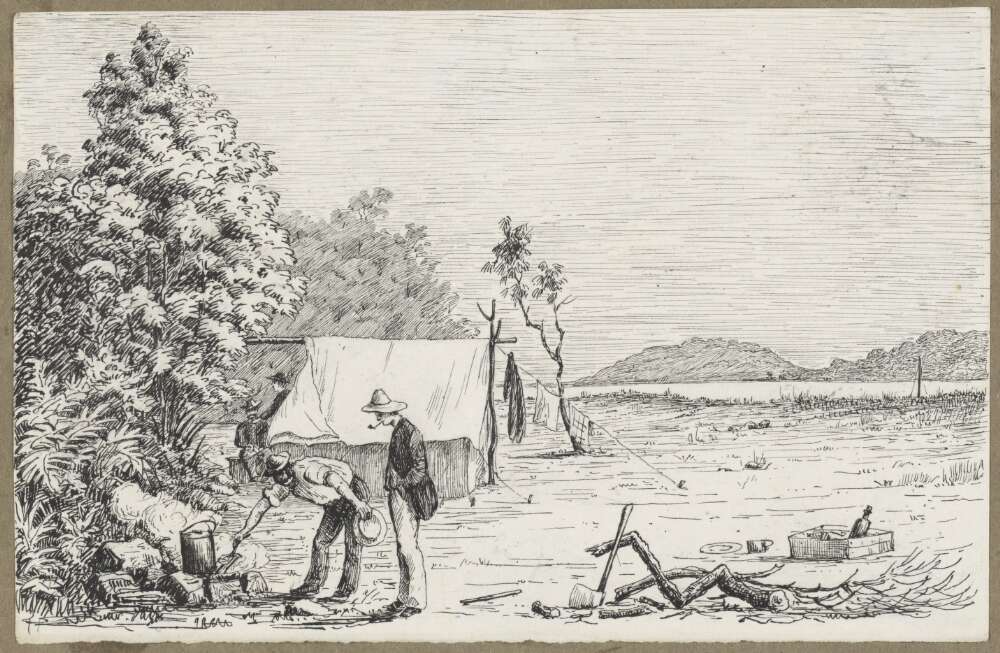
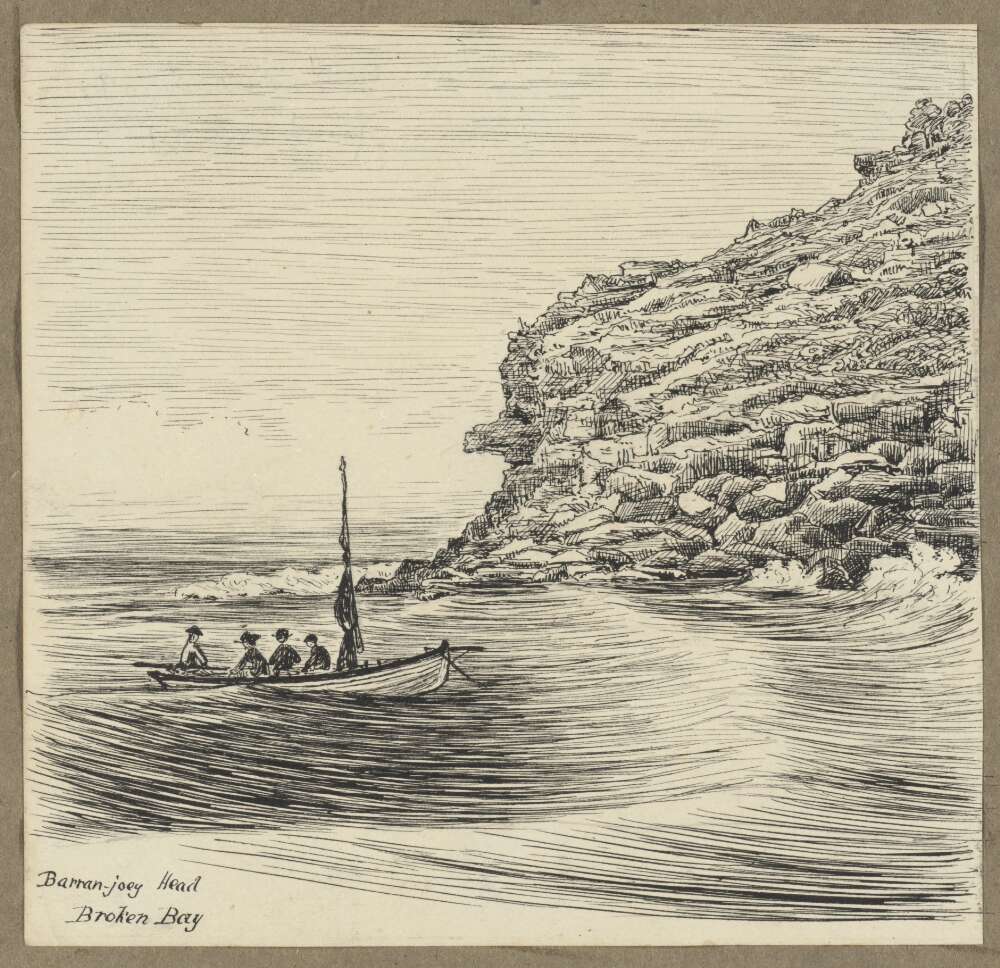
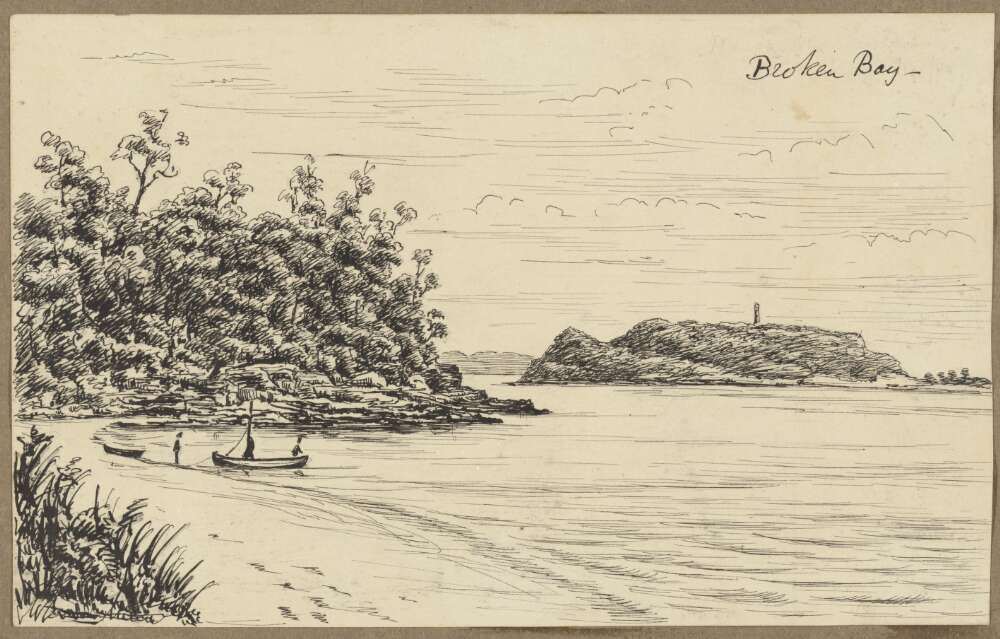
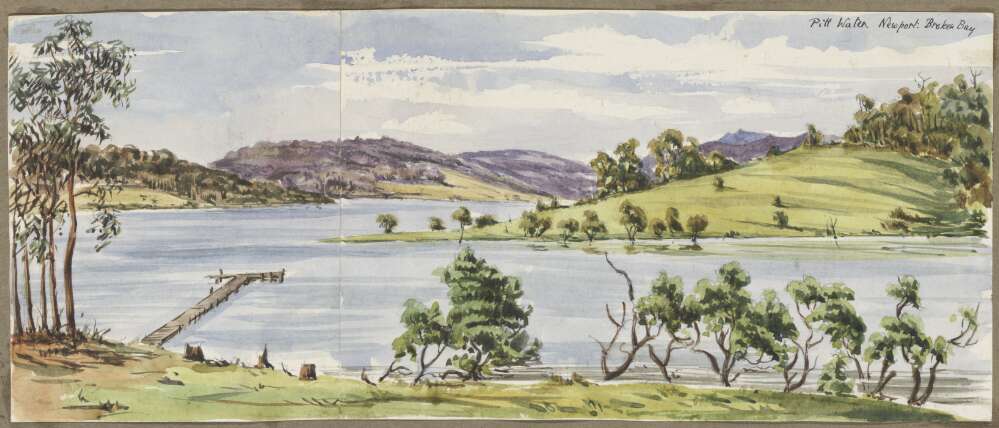
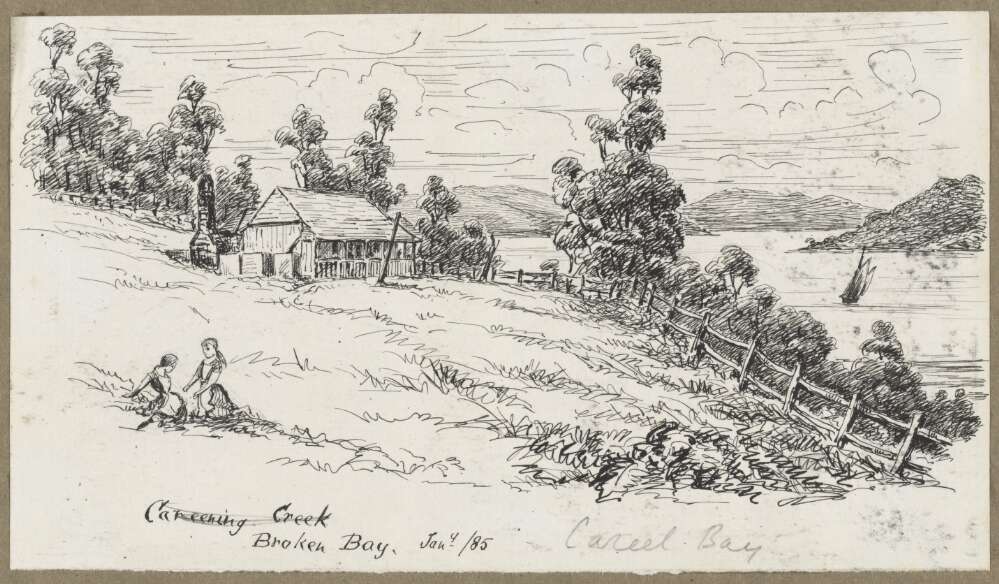
Jacob Josephson - Family notes
Other records state Jacob Josephson, who had converted from Judaism to Christianity and was a teacher of Christianity to Hebrews for the London Society for Promoting Christianity among the Jews, was sentenced to 14 years transportation for stealing the communion plate from a church. He was described as being 5 feet 4 inches tall, with a dark ruddy complexion, black hair and dark eyes.
Josephson received a conditional pardon on 30 June 1820 and opened a jewellery, gold and silver shop in the city. In 1827 he was imprisoned for bankruptcy. By 1828 he had become an innkeeper. He became a prominent member of the Methodist Church. -information from John S. Levi, These Are the Names: Jewish Lives in Australia 1788-1850 (2013), pp 405-07
Family records state Jacob was born in Breslau (Wroclaw), Lower Silesia, Poland and that he married Emma (Moses) Josephson on 25 January 1814 in Tower Hamlets, Middlesex, England. Convict records state he was born April 21 1782.
He would go on to be successful in Sydney and become a landholder.
The 1828 census records:
Josephson, Jacob, 46, conditional pardon, Neptune, 1817, 14 years, Jewish, householder, Castlereagh Street, Sydney
Josephson, Emma, 40, came free, Morley 2, 1821, Protestant
Josephson, Joshua F., 14, came free, Morley 2, 1821, Protestant
Josephson, Emanuel J., 7, born in the colony
Josephson, Isaac, I., 4, born in the colony
Lewis Josephson died in 1822, just 4 years of age.
BIRTH—On Monday evening last, of a son, Mrs. Josephson, wife of Mr. Josephson, Jeweller, Pitt-street. Family Notices (1821, July 21 - Saturday). The Sydney Gazette and New South Wales Advertiser (NSW : 1803 - 1842), p. 3. Retrieved from http://nla.gov.au/nla.news-article2180375 - Emanuel
BIRTH. On Tuesday morning last, the Wife of Mr. JOSEPHSON, of Pitt-street, Sydney, of a Son. Family Notices (1824, April 8 - Thursday). The Sydney Gazette and New South Wales Advertiser (NSW : 1803 - 1842), p. 3. Retrieved from http://nla.gov.au/nla.news-article2182768 - Isaac.
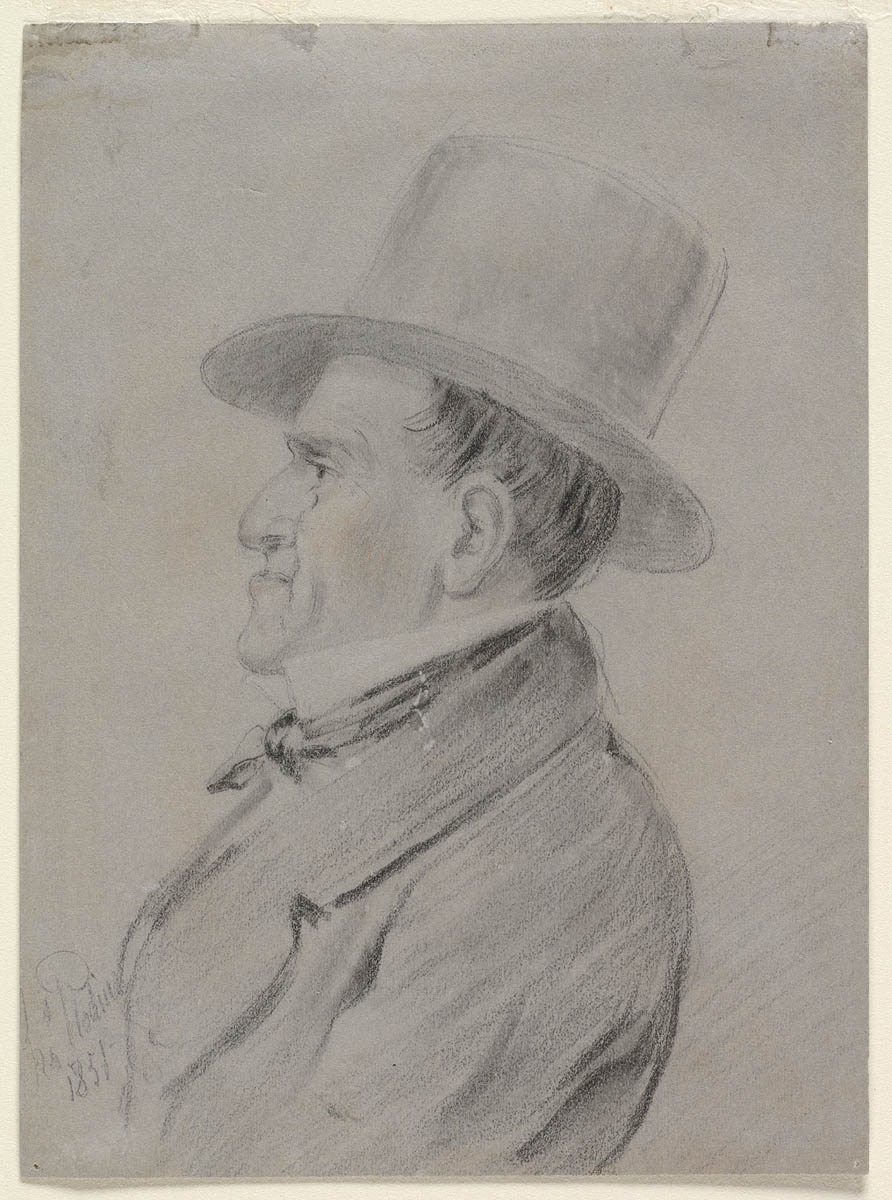
[Joshua Frey?] Josephson, 1851 / drawn by Charles Rodius Signature / Inscriptions; [?]oshua Frey) / J.F. Josephson / or father of - handwritten in pencil on reverse. Transferred with nine other portraits by Rodius, from the NSW Art Gallery, 1921 SLNSW_FL3312495, courtesy Mitchell Library, State Library of NSW
Jacob Passed away in 1845.
DIED. At Enmore, Newtown, on Saturday, 6th December, 1845, Mr. Jacob Josephson, in the 62nd year of his age, deeply regretted by his family and a large number of friends. Family Notices (1845, December 8). The Sydney Morning Herald (NSW : 1842 - 1954), p. 2. Retrieved from http://nla.gov.au/nla.news-article12883961
Eldest son Joshua Frey Josephson 1815-1892, according to City of Sydney Archives (A-00025067) was born in Hamburg, Germany, on 27 February 1815, eldest son of Jacob Josephson (d.1845) and his wife widow Emma Wilson, née Moss (Moses). Her first marriage was to Henry Wilson. He was christened on 26 March 1815 at Saint Matthew’s, Bethnal Green London.
The date of his mother Emma’s conversion from Judaism to Christianity is unknown, but her second husband Jacob was likely converted by the London missionary Joseph Samuel Frey who witnessed their marriage and presumably inspired Joshua’s parents to christen him Joshua Frey.
At St Lawrence Chapel Sydney, on 1 December 1838, Joshua Frey Josephson married Louisa Jane, the eldest daughter of John and Mary Davies. Louisa died in 1863 and in April 1868 he married Katerina Frederica, née Schiller, at St George. She died in 1884 and he married his third wife, Elizabeth Geraldine, née Brennan, at Springwood in 1891, just a few months before he passed away at Woollahra on 26 January 1892, survived by four sons and eight daughters of his first wife, and a daughter of his second wife. He was buried in the Anglican section of Rookwood Cemetery.
Interestingly, one of his daughters, Clara Maude, married a man with the surname 'Stokes' - Henry Edward:
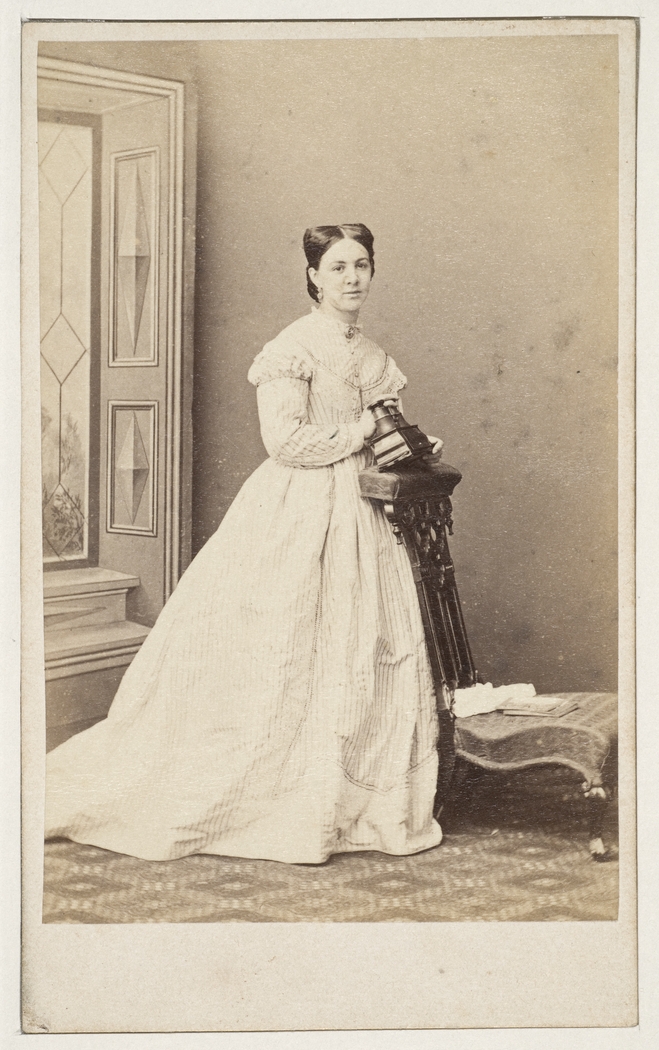
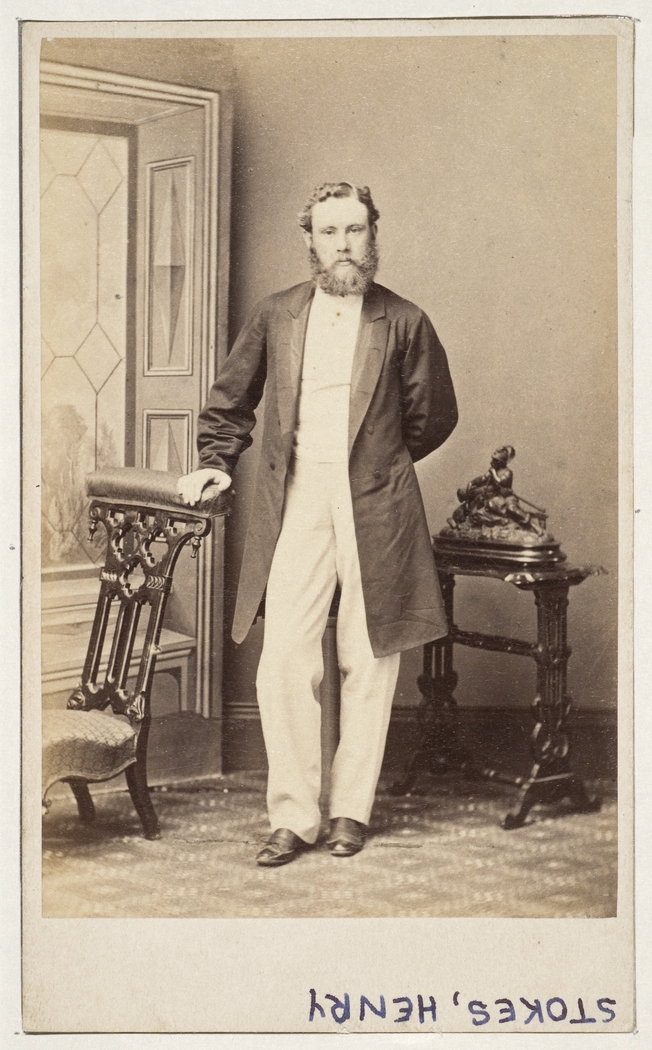
"Aunt Clara Stokes, daughter of Judge Josephson, married H. E. Stokes" -- in pencil on the reverse. Item; SLNSW_FL3282990, Mrs Clara Maude Stokes, ca. 1872-1874 / photographer B. C. Boake. "Aunt Clara, wife of Henry Stokes, Judge Josephson's daughter" -- in pencil on the reverse. Item: SLNSW_FL3299688 and "Henry Stokes, Eddie's G Pa, son of F. M. Stokes, m. d. of Judy Josephson" -- in pencil on the reverse - Author / Creator: William Bradley, both courtesy State Library of NSW
Although Christian by faith, Joshua Frey was the first Jewish mayor of Sydney.
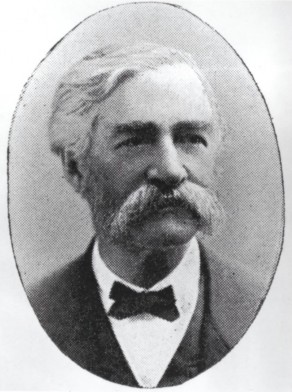
Joshua became an accomplished pianist, flautist and singer and was teaching music by 1834. He performed in concerts at the Theatre Royal organised by his step-brother Barnett Levey. Articled to James Norton, he was admitted as a solicitor on 17 February 1844 and to the NSW Bar on 9 June 1855. In February 1856, Josephson took his young family back to England and on a grand tour of Europe. He entered Lincoln’s Inn, was called to the Bar on 30 April 1859 and briefly practised as a barrister. He returned to Sydney in September 1861 and was appointed NSW Land Titles Commissioner in 1864.
Joshua Frey Josephson was appointed District Court Judge in September 1869 and chairman of Quarter Sessions for the Western District from 1869 to his resignation in 1884. He later became a partner in the wool-broking firm FL Barker & Co. On his father’s death, Joshua Josephson inherited Enmore House, designed by John Verge and demolished in 1883. With his wealth and land he was known as the Squire of Newtown but failed to gain a seat on the Newtown Council in 1863. He later built St Killians, Bellevue House, later Aspinall House, Scots College, and lived there until his death.
Enmore Road was an Aboriginal walking track and was known as Josephson’s Track in the 1850s. Enmore Ward was created in 1862; the name is taken from the estate owned by Captain Sylvester Brown from 1835 and the Josephsons from 1838 to 1883. Enmore is the name of a small millennium-old town in Somerset near Cornwall; Brown took the name of his employer’s estate in British Guiana or Barbados in the West Indies. Following the renaming of a section of Cooks River Road as King Street in 1877, Alderman Melville proposed that Enmore Road be renamed Chelsea Street and Alderman Cozens recommended Queen Street instead. Queen Street was used from 1879 until after 1880 [?]. Juliett Street can be seen on an 1841 subdivision map of Enmore and is assumed to be named after Isaac Josephson’s wife Juliet née Hanson (her brother was Romeo Hanson), although they did not marry until a decade later.
Joshua Frey Josephson was a founding member of St Pauls College, at the University of Sydney, and assisted in the establishment of the Sydney Dry Dock Co., the Hunter River Railway Co. and the Sydney Insurance Co. In the 1860s he was the Director of the Australian Joint Stock Bank, the Sydney Insurance Co, and the Australian Mutual Provident Society. He was a Commissioner for the 1867 Paris Exhibition. He collected Italian art and sculpture, some donated to the Art Gallery of New South Wales. In 1847 he was a founder of the Society for the Promotion of Fine Arts which presented Sydney’s first public art exhibition at the Australian Library. He was president of the Newtown School of Arts.
Joshua Frey Josephson was elected to the New South Wales Legislative Assembly as the representative for Braidwood from 13 December 1864 to 3 November 1869 when he was appointed judge. He was Solicitor-General from 27 October 1868 to November 1869.
Joshua Frey, with his brothers Isaac and Manuel invested in city real estate, developing the railway suburbs out to Concord and Strathfield.
The robbery at the house of Mr. Josephson, which occurred on Saturday night last, is the most immense and confounding that we have ever heard of in the Colony—£15,000 ! The very liberal reward offered by Mr. Josephson, in con-junction with the prompt steps resorted to by the Bank Directors to prevent the circulation of their 50-dollar notes, strengthened by the powerful voice of pardon issuing from the Executive Authority, and aided by the vigilance of our Police, will, there is little doubt, prove efficacious in bringing to justice the offending parties. The parties are suspected ; and they must feel very uncomfortable at the vigorous measures pursued.
We are informed, that with a view to afford every possible means of detecting the late extensive robbery, reported to have been committed in Pitt-street, the Directors of the Bank have ordered that the re-issue of the 50-dollar note, now in circulation, be discontinued ; and further, that the Public may not be inconvenienced thereby, a new series of this useful description of paper be struck off in red ink without delay.
We think it due to the interests of Mr. Josephson, as well as of all others concerned, to state unsolicited, upon the most unquestionable authority, that, in the event of the non-recovery of the amazing sum stolen, he has goods on hand, at the lowest computation, to the amount of £24,000, which will amply satisfy £22,000. Family Notices (1824, September 2). The Sydney Gazette and New South Wales Advertiser (NSW : 1803 - 1842), p. 2. Retrieved from http://nla.gov.au/nla.news-article2183177
APPEAL TO THE PUBLIC AT LARGE.
With a view to refute the gross calumnies, falsehoods, and misrepresentations, which have been spread abroad against the undersigned, Jacob Josephson, late of Pitt-street, Goldsmith, &c., &c. IT has been the prevailing principle, and distinguishing ornament of British jurisprudence, to consider every accused man innocent until his guilt shall have been proved and established ; and the most enlightened amongst mankind have subscribed to and echoed that liberal sentiment, which bears with it the admired adage, "audi alteram partem." This has rescued many an unfortunate man from that odium and disgrace which prejudice was laying wait to cast upon him, and enable him to stem its torrent, until he could raise him-self above, and get extricated from the waves, which, rushing from the source of that prejudice, were ready to overwhelm him.
The present case is one of general notoriety, and important in its bearings on the public mind :— it is not merely applicable to those common circumstances, which an obscure individual, under temporary embarassments, may have had to struggle with ; it comes home, in a greater or less degree, to the bosom and business of every member of the community ; it embraces a general interest — for let it not be forgotten, that whilst justice and integrity are due to the creditor on one side, a fair proportion of these qualities forms the claim of the debtor on the other, until he shall have forfeited it by a lapse from rectitude and probity, and a palpable dereliction from every moral obligation ; but in stating this I desire to be understood as not bespeaking any indulgence towards me beyond what my pretensions to the public consideration may warrant — I am at once appealing to the justice, to the good sense, and the impartiality of the country. I will not descend to dwell at any length upon the absurd and illiberal reports that got into circulation about the robberies committed on me. The information I laid on the second robbery was received with doubt, and treated with mistrust, under an impression, neither warranted nor warrantable, that I had not been robbed at all, and I was listened to, not as a man seeking for justice as a sufferer, but one who had contrived a surreptitious statement with a fraudulent and sinister design. I owe it, how-ever, to time, and to a providential discovery of some circum-stances, that it came out I had been robbed, and the offenders concerned in the plunder and share of my property, were convicted and punished.
I am now about to speak in respect to my engagements with my creditors, and of course I must refer to their engagements with me. I deny that I have broken these engagements, and let this be one of the proofs in support of my denial. At the time I paid them eleven thousand pounds in cash, being ten shillings in the pound, on notes not then due or demandable, they entered into a bond, a scaled instrument, not to molest me until the periods stipulated for the payment of the residue should arrive ; those periods were fixed at 12, 18, and 24 months — and whether such of my creditors as were parties to that bond have abided by the conditions of it will appear by the measures they took against me, by which I was not only deprived of the power to make good these engagements, but was harassed with a bill in equity ; to which, however, I am proud to say, only six of my creditors were parties. The bill was dismissed at the instance of the creditors, but I pronounce it a violation of their bond to me, or for what purpose was such bond given.
" Yes," say some of them "but Josephson had it in contemplation to escape from the Colony, and leave his creditors in the lurch." Fortunately for me this imputation has defeated itself. Is it not admitted that in the course of eleven months I paid cash to my creditors to the amount of nineteen thousand pounds ? If I ever had such a design as that of absconding, should I not have carried it into effect when possessed of £20,000 in money ; my credit and my character unimpeached, not after I had appropriated such a sum in payment of my debts ; and this was the manner I applied that sum — £11,000 in hand, being ten shillings in the pound on notes not then due ; £8000 to and amongst such of my creditors as did not demand their money until the notes they held became due ; and to them I now appeal, to declare whether, when they sent in my notes for payment, I did not promptly and honorably retire them.— Look at the goods in my shop, which, when seized upon and sold by the Sheriff under execution, realized under every disadvantage, between three and four thousand pounds ; and will it be for a moment doubted, that if I had been allowed to dispose of them myself in the ordinary course of business, they would have sold for three times that sum at least. Every one conversant with trade (and more particularly in a country like this) knows that time is not only necessary to sell goods, but also to get in the payment ; and I shall stand excused, if here, without any direct allusion, I take upon myself to say, that if the same measures, which were so suddenly taken against me, were to be put in ac-tion against many of the merchants or dealers in New South Wales, they and their creditors would be plunged in a far worse predicament than I even stand in now ; and the dividends drawn from the ruins of their property would be very slender, and far inferior to what I have already rendered.
The last imputation I take upon myself to refute is, that of having removed some property from my shop and committed it in confidence to some ostensible friends. Let me be allowed in passing on with this subject to pause a moment to inquire what description of character that man, or those men must be — who would not only accept, but court a trust of such a nature, and then betray it — who would first advise me to save as much property as I could for the eventual benefit of such of my creditors as had not broken their faith with me, and then claim the merit of having discovered it. If I had solicited their acceptance of such a charge, they were at liberty to decline it, and their connivance or motives would not have been called in question.— Mankind, generally, from interest are led to approve the treason when it conduces to their advantage, but from principle I despise the traitors. But for what purpose was this vast treasure re-moved ? I say it was to enable me to reserve it from the grasp of the executions which were pouring in upon me, and to pre-vent it from being sacrificed for one sixth of its value, as my other property was, and eventually for the benefit of my credit-ors, for whom, as the nearest interested, I was the safest guarantee.
And at last, when the clouds which prejudice, slander, and detraction have gathered over my devoted head, shall be dispersed by the prevailing ray of truth, reason, and reflection, I may confidently look forward to the time, when my name, character, and credit, shall be restored to that rank in the commercial world with which I set out and maintained for a series of years, and should still have maintained, but for the system of oppression exercised against me. If I say by such a system some of my creditors, who have acted in it shall eventually suffer, the cause was their own, and they have only themselves to look to for the effect.
But may I ask what is to become of me — a husband and father, destitute of the means of supporting my family, and who five years ago was master of thousands of pounds of my own. Be that as it may, time will be the test of my intentions, and when their purity shall appear, I may have an opportunity of illustrating by my conduct and example, in the result that I have all along been governed by, that perfect principle of doing unto others as I would wish they should do unto me. Sydney, Nov. 22, 1825. Jacob Josephson. Advertising (1825, November 24). The Australian (Sydney, NSW : 1824 - 1848), p. 4. Retrieved from http://nla.gov.au/nla.news-article37074125
THE EDITOR OF THE SYDNEY GAZETTE. — SIR, The few observations I have to make, I will briefly preface, with a statement of the facts which I am about to address you on.
Tho' an humble individual, I yet feel it my duty to assist the friendless as far as lies in my power; acting on this principle, seven years since I took under my protection two unfortunate children, one an orphan, and but for me, destitute of a friend, and I ever felt anxious to rear and educate them as my own; my circumstances for some time much embarrassed, prevented them from receiving those benefits which might have been derived from a good School, but lately becoming improved, about a fortnight, since, I sent one of them to Mr. Thurston's Seminary, as a boarder, at £30 per annum. This presumption, on my part, certain Ladies, to wit, the wife of Mr. Harper, butcher, in George-street, and Mrs. Josephson, felt so much aggrieved at, that they positively declared their intention of removing their children from Mr. T. if my poor orphan was allowed to remain there.
Through the medium of your columns, therefore, I call upon these Matrons to show cause for this unexpected pro-ceeding, and to explain to the world what disgrace attaches to a communication between their children and the adopted orphan of Sir,
your obedient humble servant,
JOSEPH RAPHAEL. Family Notices (1826, August 19). The Sydney Gazette and New South Wales Advertiser (NSW : 1803 - 1842), p. 3. Retrieved from http://nla.gov.au/nla.news-article2186380
Isaac John Josephson - Manuel Francis Josephson
MARRIED: By special license, on Friday, the 14th inst., at St. James' Church, by the Rev. R. Allwood, I. J., youngest son of the late Jacob Josephson, Esq., to Juliet Mary, eldest daughter of J.S. Hanson, Esq. Family Notices (1851, March 22). Bell's Life in Sydney and Sporting Reviewer (NSW : 1845 - 1860), p. 3. Retrieved from http://nla.gov.au/nla.news-article59772208
Children of the union: Joshua is not listed here as such
JOSEPHSON IDA M337/1858 ISAAC J JULIET M SYDNEY
JOSEPHSON ARTHUR W 1759/1859 ISAAC J JULIET M SYDNEY
JOSEPHSON IDA M463/1857 463 VOL 149 ISAAC J JULIET M
JOSEPHSON IDA M463/1857 V1857463 149 ISAAC J JULIET MCJ
JOSEPHSON HERBERT J 4004/1854 V18544004 40 ISAAC J JULIET M CJ
JOSEPHSON FRANCIS Jacob 749/1851 V1851749 37A ISAAC J JULIE M MF
JOSEPHSON EVA M673/1856 ISAAC JJULIET M SYDNEY
Eva died as a baby - all their other children survived into adulthood:
JOSEPHSON EVA M310/1858 ISAAC J JULIET M SYDNEY
Sons deaths:
JOSEPHSON JOSHUA P14174/1911 ISAAC J JULIETT M CHATSWOOD
JOSEPHSON HERBERT J 6752/1931 ISAAC J JULIET M MOSMAN
JOSEPHSON ARTHUR W1833/1926 ISAAC J JULIET M MOSMAN
Deaths
On the 27th instant, Eva May, eldest daughter of J. J. Josephson, aged 22 months. Family Notices (1858, March 1). The Sydney Morning Herald (NSW : 1842 - 1954), p. 1. Retrieved from http://nla.gov.au/nla.news-article13006837
Ida married in 1877:
983/1877 HAYMAN DAVID JOSEPHSON IDA SYDNEY
MARRIED,
By special license, at St. Peter's Church, Newtown, on Thursday, 21st July, by the Rev. Dr. Steele, Manuel Francis Josephson, second son of the late Jacob Josephson, of Enmore, Newtown, to Frederica Mary, youngest daughter of Mr. H. L. Miller, of Castlreagh-street, Sydney. Family Notices (1853, July 25). The Sydney Morning Herald (NSW : 1842 - 1954), p. 3. Retrieved from http://nla.gov.au/nla.news-article12947527
Children of the Union: those listed in NSW BDMs
JOSEPHSON MANUEL F5327/1869 MANUEL FFREDERICA MST LEONARDS
ROYAL SYDNEY YACHT SQUADRON'S JUBILEE.
FIFTY YEARS AGO— on July 8, 1862— the Royal Sydney Yacht Squadron was founded, largely as the result of the energy of Mr. William Walker, a Sydney merchant. Yachting had then been followed by a few enthusiasts for about 30 years. Small clubs had been formed in 1836 and 1856, but little attempt was really made to organise the sport till the early sixties. The first meeting to discuss a squadron was held at the Ex change Corner, Bridge-street, and was at tended by 19 gentlemen, each of whom signed the Magna Charta upon which the squadron — originally called the Australian Yacht Squadron — was founded. Most of the famous 19 have died, but their names are revered. One of the most treasured possessions of the squadron to day is a document — signed by each of the 19 — which hangs on the wall of the clubhouse at Kirribilli.
It is the constitution of the club, and the names if bears are: —
Yacht
James Milson junr,...........Era.
William Walker.................Chance.
Thomas P. Roxburgh.......Eclipse
Thomas T. Rowntress......Annie Ogle
Sydney C. Burt................Scud.
Staunton Spain...............Mischief
I. J. Josephson...............Ida
Robert Garrett................Daisy
Charles Parbury.............Why Not
Frederick J. Jackson......Gitana
Henry Threlkeld.............Irene
R. Harnett......................Australian
A. W. H. Pockley............Mazeppa
Henry C. Dangar........... Peri
H. Stuart Russell............Old Tom
J. D. McLean..................Mischief
J. W. Brooks...................Mischief
James Freeman..............Eclipse
H. Milford........................Eclipse
AT a late meeting the rules of the squadron were drawn up, and the first office-bearers appointed, namely :— Commodore, William Walker; vice-commodore, James Milson, junr ; hon. treasurer. Henry C. Dangar: hon, secretary, George H. Howell: committee, Captain Pockley and .Messrs. Roxburgh, Parbury, Spain, M'Lean and Burt.
.jpg?timestamp=1692249117054)
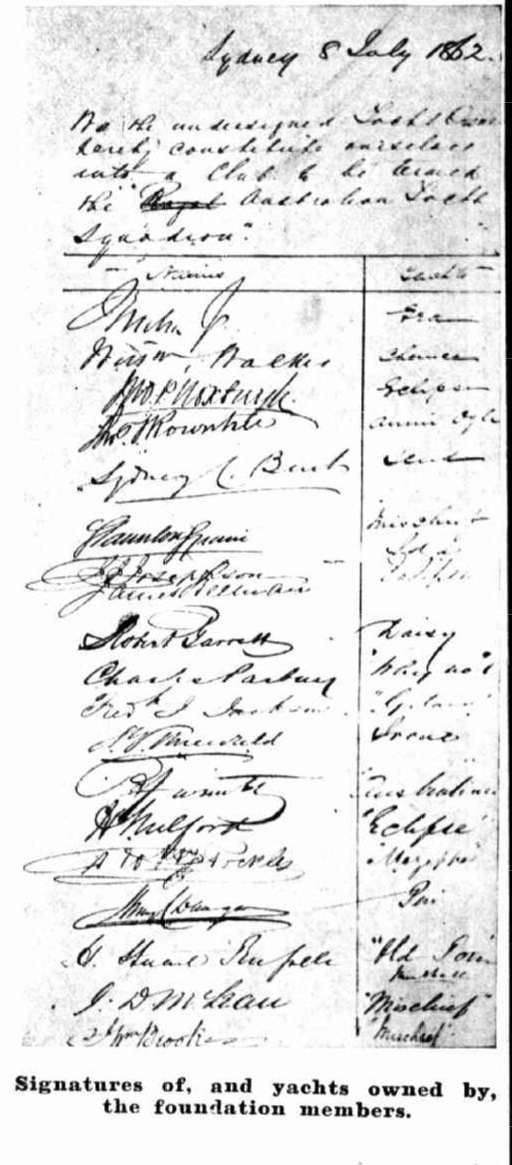
THE first cruise of the club took place, on October 18, 1862, when 12 boats sailed from Farm Cove to Manly Beach, and the first race on the New Year's Day following. For the latter half-a-dozen boats entered — Peri, Scud, Ida, Why Not, Old Tom, and Gitana— and the first named won easily.
.jpg?timestamp=1692249189891)
An important event in the history of the squadron was the receipt of a letter from the Colonial Office, dated June 27, 1863, enclosing a copy of a despatch received by the Governor of the colony from the Duke of Newcastle, intimating that his Royal Highness the Prince of Wales had 'signified his willingness to become the patron of the squadron,' under the designation of the Royal Sydney Yacht. Squadron, and that, the Lords Commissioners of the Admiralty had authorised by warrant the use by the squadron of the Blue Ensign of her Majesty's fleet, without any distinguishing mark upon it. This warrant, which was dated April 25. 1863, was subsequently replaced by a fresh warrant, dated May 15, 1864. The squadron thus acquired and still retains the right to exercise the same privileges as are possessed by the Royal yacht clubs of the United Kingdom.
At the next meeting of the squadron it was resolved that the club burgee should be 'blue with a white cross, and a crown in 'the upper corner;' and so it remains to-day. Since those days great advances have been made in the construction of yachts. The old deep-keeler has been almost entirely replaced by the modern over hanging bow, and the old system of ballasting by sand, gravel, stone, or metal has been superseded by outside ballast. Among the first to use the outside lead was Mr. A. G. Milson, who altered the ballasting of the lone in 1876.
IN the course of its career the squadron has had many ups and downs; it has had times of great progress and times of depression, but it has managed to keep its sails unfurled throughout. In the seventies, for instance, we find Mr. Dangar, who was then commodore of the squadron, referring to the 'depression in the colony' and lamenting the general 'lack of interest in yachting matters:' but in the eight ies, under the direction, first, of Commodore Milson, then of Commodore Fairfax, the squadron made great progress, and yachting became recognised as a 'national game.''
In the early days of the squadron, club racing within the harbour was the main objective: but trips to sea soon became popular. Then, with the growth of clubs in the other States, interstate racing became the great incentive, and in 1882 the Doris carried the burgee of the squadron to Melbourne, followed by the Era and Volunteer in 1888, the Rawhiti in 1897, the Thelma in 1909, and the Culwulla III. two years ago, when the Sayonara Cup was won from the Royal Yacht Club of Victoria. The Culwulla III. has also made successful cruises to Tasmania and Brisbane. Smaller boats than these have also made voyages outside the Heads— as far as Port Stephens and Jervis Bay. AT present the squadron boasts a member ship of over 280 and never in its fifty years of existence has its future looked brighter than at present. New enthusiasts are coming forward every season, and most of the older yachtsmen stand by the club, notably such members as Sir James R. Fairfax and Mr. A. G. Milson. On Monday night the members of the squadron foregathered at the Hotel Australia to celebrate the fiftieth anniversary of the founding of the squadron.
.jpg?timestamp=1692249228245)
.jpg?timestamp=1692249405019)
.jpg?timestamp=1692249325536)
.jpg?timestamp=1692249294074)
.jpg?timestamp=1692249255158)
.jpg?timestamp=1692249351464)
.jpg?timestamp=1692249485662)
.jpg?timestamp=1692249546649)
VIEW OF THE CLUB HOUSE AT KIRRIBILLI.
ROYAL SYDNEY YACHT SQUHDRON'S JUBILEE. (1912, July 10). Sydney Mail (NSW : 1912 - 1938), p. 7. Retrieved from http://nla.gov.au/nla.news-article158478593
Isaac Josephson passed away in 1897, his wife just a few weeks later:
By the death of Mr. I. J. [Isaac John] Josephson, which took place at his residence, 235 Macquarie-street, yesterday, an old and highly esteemed resident of Sydney has passed from our midst. Mr. Josephson had been a victim of paralysis for three years, due to his having being garroted and robbed near the Crown Law Office one night whilst on his way home. Since that occasion he had never been in good health, and for upwards of two years was almost intermittingly confined to his bed.
Deceased had, however, passed the allotted span of years, being in his 74th year. For about 17 years he held the position of hon. secretary of the Benevolent Asylum, being ultimately succeeded in that office by Mr. Penfold, the present secretary and in addition to having for some time been a director of the Randwick Asylum, he was actively associated with the directorate of the Sydney Hospital for some 25 years. The assault referred to, which laid him prostrate for the last three years, prevented him from taking the active part in the administration of the hospital's affairs that he had hitherto done; but up to the time of his death he still remained on the board of directors. As a practical illustration of the interest he at all times took in the Benevolent Asylum and the Sydney Hospital, it may be mentioned that he has left the sum of £100 to each of these institutions.
Mr. Josephson's pet hobby in his younger days was yachting, and a number of handsome souvenirs won by him at various times with his well-known yachts, the Pert and Emma, are in the possession of the family. In addition to being something of a mechanic— for Mr. Josephson personally built the Emma in 1858— he also dabbled in chemistry.
Deceased was a brother of the late Judge Josephson. He leaves a widow and five children, one of whom— Mr. Arthur W. Josephson— is the licensee of the York Hotel, at the corner of King and York streets. The funeral arrangements are in the hands of Mr. Walter Stewart, and the cortege will leave deceased's late residence at 2.30 to-day for the Waverley Cemetery. DEATH OF MR. I. J. JOSEPHSON. (1897, June 1). The Daily Telegraph (Sydney, NSW : 1883 - 1930), p. 5. Retrieved from http://nla.gov.au/nla.news-article238396341
DEATH
Mr Isaac Josephson, a well known resident of Sydney died yesterday. Mr Josephson was a brother to the late Judge Josephson and owned considerable property in Sydney, including the opera House in King-street. He was the inventor and proprietor of the famous "Josephson's" Ointment. DEATH. (1897, June 2). Riverina Recorder (Balranald, Moulamein, NSW : 1887 - 1944), p. 2. Retrieved from http://nla.gov.au/nla.news-article137608029
LATE MR. I. J. JOSEPHSON.
THE FUNERAL
The funeral of the late Mr. Isaac John Josephson, who died at his residence, 235 Macquarie-street, Sydney, on Monday, took place yesterday afternoon, the remains being interred in the family vault in the Church of England section of the Waverley Cemetery. The cortege left Macquarie-street about 3 o'clock. The chief mourners were Messrs Frank J., J. Percy, Herbert J., and Arthur W. Josephson (sons of the deceased), Hampton Gleeson (son-in-law), Albert and Thomas Josephson and Joseph Hanson (nephews), Dr. Hanson (brother-in-law), and Mr. Carlo Marina, and among those who followed the remains to the grave were: Messrs. John Gould, F. S. Morgan, A. Levy, J. Star-key, J. T. Broyden, H. Walter William Weir, H. Hargraves, Quong Tart, R. Allen, John Roseby, J. Hourigan, Alderman M. Chapman, and R. Smyth. Wreaths and other handsome floral emblems were sent by the widow, Mrs. W. Charlton, Mr. C. Bander, Mr. Arthur Josephson, Mr. and Mrs. H. Josephson, Mr. and Mrs. P. Josephson, Mr. and Mrs. Emanuel, Mr. J. Lindsay, Mr. and Mrs. Marina, and Mr. and Mrs. Hampton Gleeson (from Miss Goodenough's establishment), the matron of the Sydney Hospital, and Dr. Jarvie Hood (Jean and Company), the directors of the Sydney Hospital, Mr. and Mrs. F. Josephson, Dr. Lockhead, Mr. J. Marshall, Miss Taylor, and the domestics at No. 235 Macquarie-street (Messrs. Searl and Sons), Miss Hanson, Mr. Meier, directors of the Benevolent Society of N.S.W., and Mr. and Mrs. A. S. Pearce (Messrs. Pearce Brothers), Mr. and Mrs. E. Maxted, Mr. and Mrs. Hassell and family, Messrs. M'Dowell and Cooper, Mr. W. Roseby, Mr. R. Coe, Nurse Yeo, Mr. and Mrs. Walters, and Mr. E. T. Beilby. The service at the grave was conducted by the Rev. J. Mauncey, of St. James's Church, King-street. LATE MR. I. J. JOSEPHSON. (1897, June 2). Evening News (Sydney, NSW : 1869 - 1931), p. 3. Retrieved, from http://nla.gov.au/nla.news-article108056233
THE LATE MRS. JOSEPHSON.
The funeral of the late Mrs. Josephson, who died on Monday last, took place yesterday afternoon from her residence in Macquarie-street. Mrs. Josephson's death was due to heart disease. Possibly the sad event was precipitated greatly by the death of her husband, which, It will be remembered, took place a few weeks ago. The cortege, which was a long one, started from Macquarie-street at 3 o'clock for the Waverley Cemetery, where the body was interred in the family vault. The grave service was conducted by the Rev. Carr Smith and assistants. Amongst those present at the funeral were all the relatives of the late Mr. and Mrs. Josephson, the Hon. J. H. Carruthers, M.L.A. (Minister for Lands), the Hon. George Thornton, Mr. Chapman, M.L.A., and a number of well-known citizens. The wreaths, sent by friends were numerous and chaste. THE LATE MRS. JOSEPHSON. (1897, June 25). The Australian Star (Sydney, NSW : 1887 - 1909), p. 3. Retrieved from http://nla.gov.au/nla.news-article227193179
JOSEPHSON.—May 31, 1897, at his late residence, 235 Macquarie-street, North, Isaac John Josephson, aged 73 years.
JOSEPHSON.—June 22, at her late residence, 235 Macquarie-street, North, Juliet Mary, the beloved wife of the late Isaac John Josephson, aged 66 years. Family Notices (1897, June 23). The Sydney Morning Herald (NSW : 1842 - 1954), p. 1. Retrieved from http://nla.gov.au/nla.news-article14117491
JOSEPHSON.—October 3, 1911, at his residence. Moppity, Springdale-road, Killara, Joshua Percy Josephson, dearly loved husband of Eliza Judita Josephson, aged 58 years.
FUNERALS. JOSEPHSON.—The Funeral of the late Mr. JOSHUA PERCY JOSEPHSON will leave his late residence, "Moppity", Springdale road, Killara, TOMORROW (WEDNESDAY) MORNING, at 10 o'clock, for St. Martin's Church, Killara, thence to St. John's Church of England Cemetery, Gordon. WOOD and COMPANY, Funeral Directors, Sydney and Suburbs. 'Phones, 723 Central, and 9 N. Sydney. Family Notices (1911, October 3). The Sun (Sydney, NSW : 1910 - 1954), p. 7 (FINAL EXTRA). Retrieved from http://nla.gov.au/nla.news-article221522975
JOSEPHSON - June 13, 1931, at a private hospital, Neutral Bay, Herbert John, son of the late Isaac and Juliet Josephson, dearly loved husband of the late Frances Catherine Josephson and loving father of Juliet (Mrs. Jones) and Jack and Romeo Josephson, aged 76 years. Family Notices (1931, June 15). The Sydney Morning Herald (NSW : 1842 - 1954), p. 8. Retrieved from http://nla.gov.au/nla.news-article16785885
Application 21555 - shows what was in Section A - the tip of Stokes Point and Isaac John Josephson Lots changing hands to Arthur James McDonald:
.png?timestamp=1692206725729)
.jpg?timestamp=1692240573642)
.jpg?timestamp=1692240771616)
.jpg?timestamp=1692240879232)
.jpg?timestamp=1692240854891)
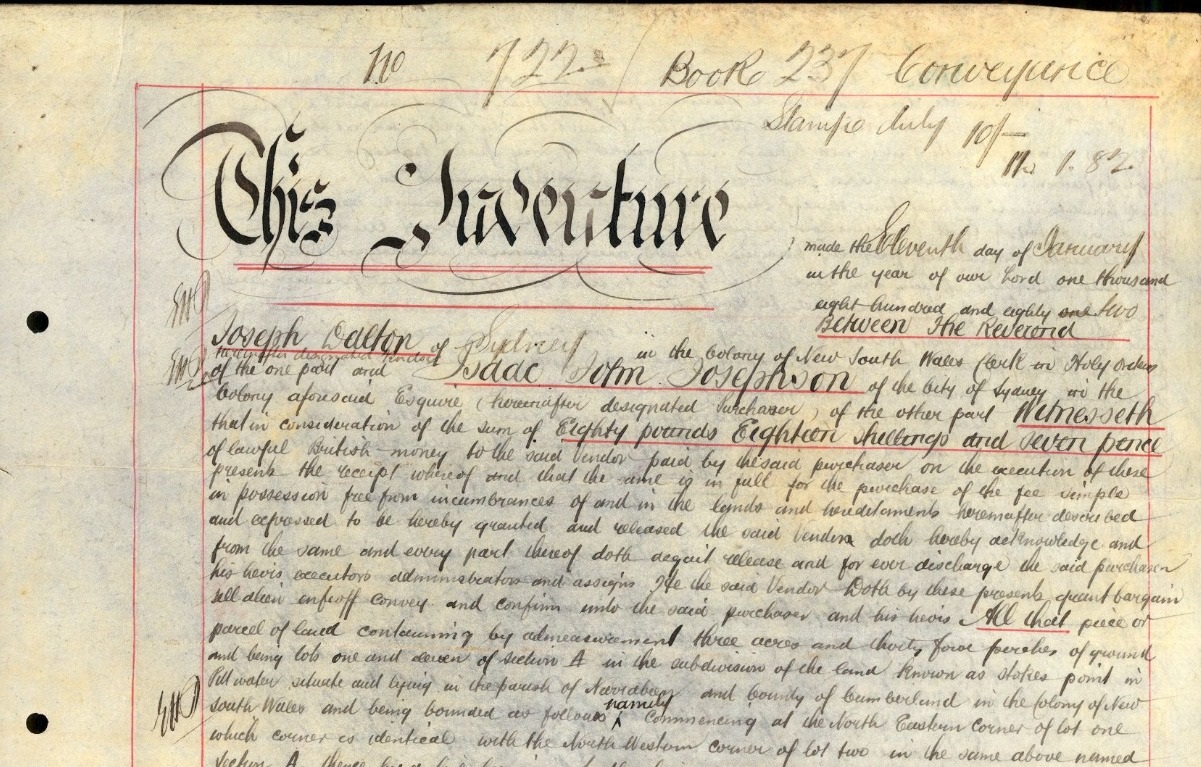
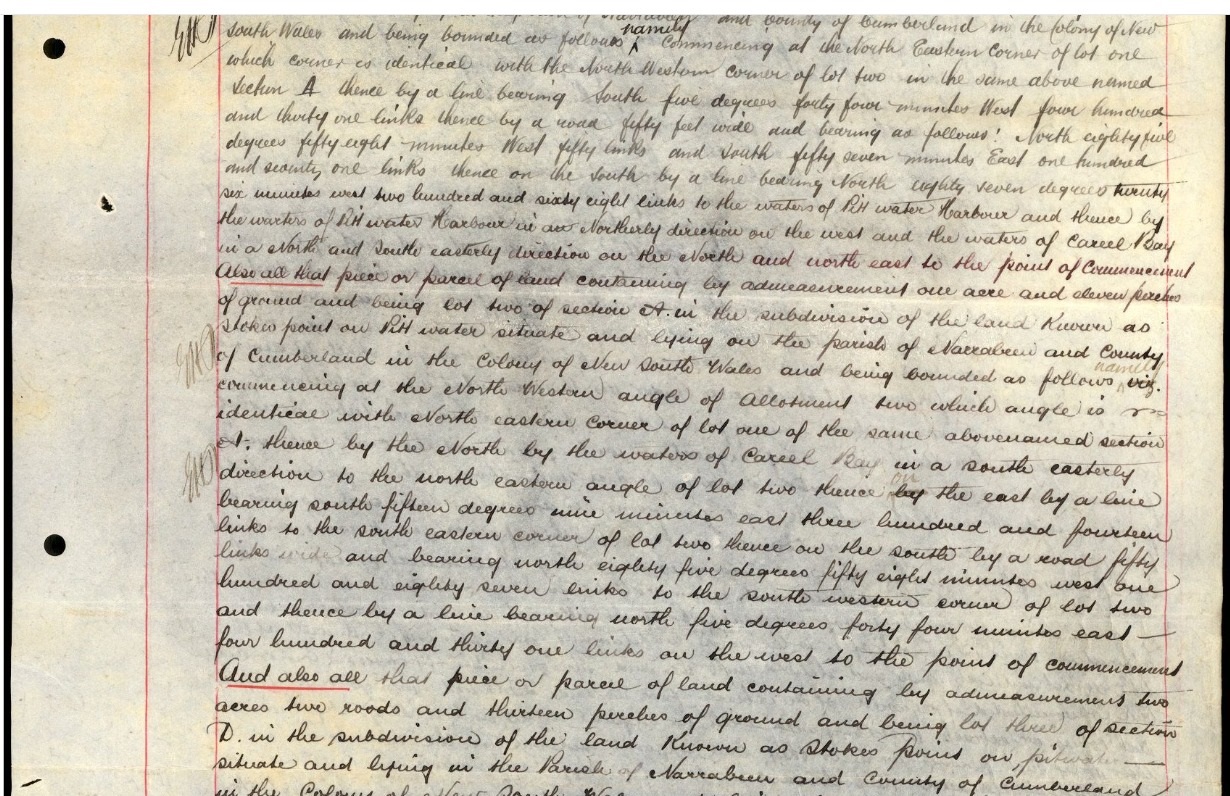
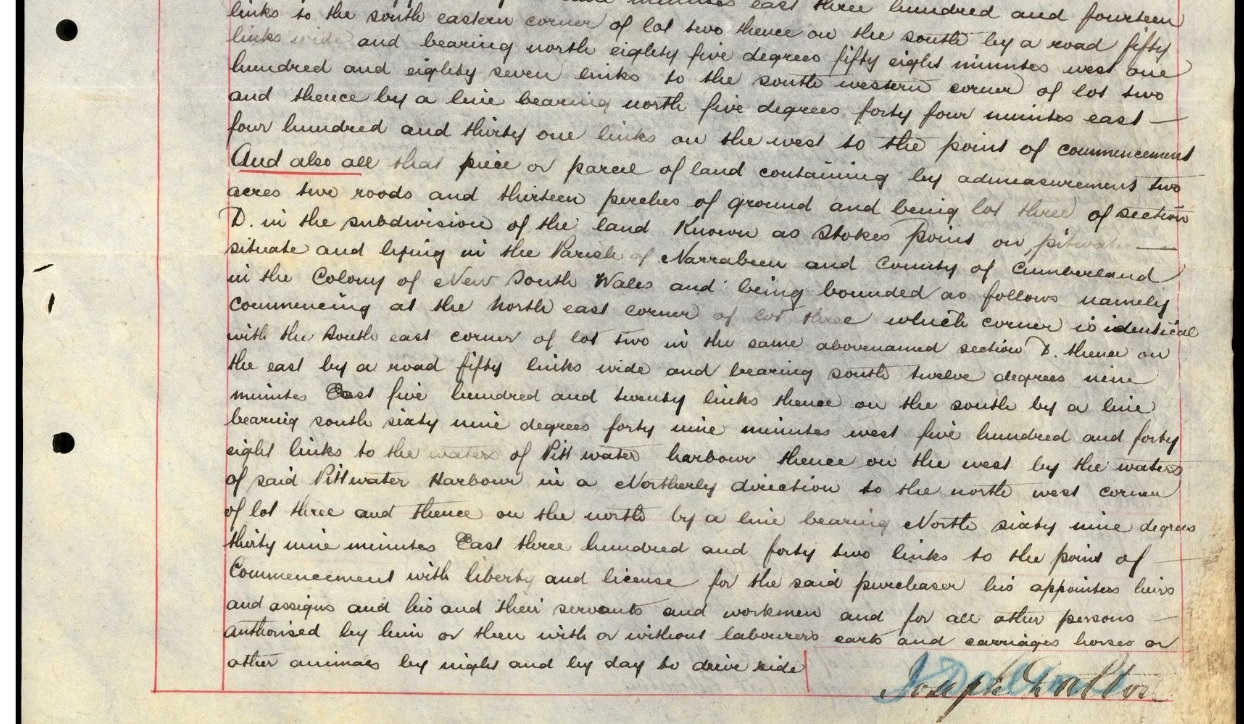
Arthur James McDonald
Birth:
MCDONALD ARTHUR J 1096/1869 Parents: JAMES LILY registered at SYDNEY
Marriage:
4304/1893 MCDONALD ARTHUR J ANGLE AMELIA S LEICHHARDT
M'DONALD — ANGLE. — April 26, at the residence of the bride's parents, by the Rev. George Grimm, Arthur James, eldest son of James M'Donald, of Concord, to Amelia Sarah (Millie), eldest surviving daughter of Edmund Angle, of Cicely-st., Leichhardt. Family Notices (1893, May 30). The Daily Telegraph (Sydney, NSW : 1883 - 1930), p. 1. Retrieved from http://nla.gov.au/nla.news-article236030999
Doris was born in 1894, Reginald in 1898, Nellie in 1902.
MARSDEN PARK.
DURING the past week Mrs. McDonald (wife of Mr. A. McDonald solicitor) and family have been staying here residing with their relatives, Mr. and Mrs. Angle. MARSDEN PARK. (1899, December 9). Windsor and Richmond Gazette (NSW : 1888 - 1965), p. 8. Retrieved from http://nla.gov.au/nla.news-article66442620
Daughter married in 1915:
8964/1915 FELL WILLIAM B S MCDONALD DORIS SYDNEY
SCOTT FELL — McDONALD.— At St. Stephen's Church, Phillip-street, Sydney, on August 30, the wedding was celebrated by the Rev. John Ferguson, of William Bain, elder son of Mr. and Mrs. W. Scott Fell, of Mosman, and Doris, elder daughter of Major and Mrs. Arthur J. McDonald, of Edgecliff. The wedding was quiet, because' of the absence of the bride's father with the 18th Battalion at the Dardanelles. The bride, who was given away by her brother, wore a coat and skirt of cream cloth, her white hat being wreathed with lilies of the valley. She carried a posy of white flowers, this and a diamond cluster ring were gifts of the bridegroom. The bridesmaids, Miss Nellie McDonald and Miss Cathie Fell sisters of the bride and bridegroom wore frocks of pale pink crepe-de-chine with hats to match; their gifts from the bridegroom being posies of pink flowers and pearl brooches. Mr Jack Scott Fell acted as best man. After the ceremony Mrs. McDonald held a reception at the Hotel Australia, only immediate relatives being present. Mr. and Mrs Bain Scott Fell left by motor for the Mountains and the Jenolan Caves. WEDDINGS (1915, September 19). Sunday Times (Sydney, NSW : 1895 - 1930), p. 5. Retrieved from http://nla.gov.au/nla.news-article120791102
LOVEDAY—McDONALD
St. Stephen's Church, Phillip-street, was chosen by Miss Nell McDonald, daughter of Major and Mrs. Arthur J. McDonald, of "Rothwell," Macleay-street, Potts Point, to be the scene of her marriage with Mr. John Loveday, of No. 9 Spring-field Avenue, Darlinghurst, on Wednesday evening. January 25.
Rev E. Ferguson officiated. Hydrangeas and roses were used to decorate the church for the occasion. Gowned in ivory beaded georgette, mounted on palest pink chiffon, and wearing a tulle veil of shell pink tint, arranged with a Limerick lace headdress and caught at the side with posies of orange blossoms and pearls, the bride looked very sweet as she entered the church on her father's arm. An armlet of choice pink radiance roses was a delightful finish to the color scheme of pink and white. Mrs. Bain Scott Fell, wearing a smart frock of apple green chiffon, showing touches of fuchsia, and a hat to tone, attended her sister as matron of honor. She carried a beautiful armlet of golden gladioli and frangipanni. Mr. Norman Harding was best man. After the ceremony a reception was held at "Rothwell," where the bride's mother received the guests, gowned in black beaded gorgette. She carried a bouquet of pink roses and delphiniums. When leaving the reception the bride covered her frock with a lovely embroidered shawl. The honeymoon is being spent on a motor tour to Melbourne. LOVEDAY—McDONALD (1928, January 29). Sunday Times (Sydney, NSW : 1895 - 1930), p. 14. Retrieved from http://nla.gov.au/nla.news-article122802492
LATE REV. W. BAIN. THE FUNERAL.
The funeral of the late Rev. W. Bain took place on Saturday afternoon, and was attended by, a number of representative citizens and by many old friends of deceased. The chief mourners were Mr. W. Scott-Fell (son-in-law), and W. Bain Fell and J. W. Fell (grandsons). The pall-bearers were Messrs. John Hay, W. Todd, and D. Davies, elders of St. Philip's Presbyterian Church. The members of the Hunter Presbytery were present, also office-bearers of St. Philips Church and of St. Andrew's Presbyterian Church, the Mayor of Newcastle (Alderman H. M. Shedden), the Rev. E. Mona Jones, and other citizens. Before the funeral left the house, service was conducted by the Rev .A . Fraser, minister of St. Philip's, and the Rev. J.B. Fulton, of West Wallsend,. Moderator of the Presbytery, engaged In prayer. The members of the presbytery, and members of Lodge No. 26, L.O.L., to which Mr Bain had belonged, marched In front of the hearse.
At the graveside at Sandgate the burial service was read by the Rev. A. Thain Anderson, of Hamilton. The Rev. D. W. Davies said their old friend, father,' and brother, William Bain, had responded to the call-Come up higher. He saw now as never before, and knew as never before, the mystery, the glory, the bliss, God had prepared for His own. Length of days in the land had been his lot. He had been called to serve his Lord and Master in this new land beneath the Southern Cross, and had done so for nigh half a century. His jubilee would be celebrated, not here, perhaps yonder. He had passed from the present life to higher service, but death had not Interrupted his service. His life continued, his work continued, but in more auspicious conditions. He was now carrying on his work unhampered, unwearied, resting only from the laboriousness of life's toll, yet resting not day or night. Ever fresh, ever active, never spent, never weary-life Indeed, service Indeed-and It was all work for others. Did they ask How employed? He could not tell. He did not know. But, doubtless, the work he was best fitted for, and the work he loved most. His work would be ceaseless Joy to him, his service would be a perpetual praise. It would be work that was. worship-a song and bliss. The late William Bain was a gentleman, every inch of him. 'Full of courtesy, ever ready to do a kindness, and to lend a helping hand, and most truly given to hospitality "A constitutional Presbyterian," was his friend heavie's pronouncement on him. Clerk of the Presbytery for a generation-let all things be done decently and in order had become part of the very man. A conservative theologian, although an up-to date reader: an evangelical of the old school; the last of a small body of stalwarts who for very many years had guided the destiny of the Hunter Presbytery. Well might they ex claim-"The fathers, where are they?" Gordon, White, Benvle, Lang; and now the last of them, Bain, had joined the band. Their work had fallen on the shoulders of new and younger men. The churchmanship of these fathers was strong and earnest. New conditions, perhaps, called for a new type, Like the shuck of corn fully ripe, he, their friend, father, brother, had been garnered In and gathered home. Who next?
Prayer was offered up by the Rev. A. Smith, of East Maitland. The Rev. A. S, M'Cook., of West Maitland, read a verse of deceased's favourite hymn, 'Safe in-the Arms of Jesus," and it was sung by those gathered about the grave. The Rev. B. Fulton, read the committal, and an impressive service closed with the pronouncing of the Benediction by the Rev. Grant Forsyth, of St. Andrew's. The members of Lodge No. 26 L.O.L., Joined In uttering the last farewell of the brethren, concluding with the prayer of the order, by the secretary, Bro. J. Sperring.
Wreaths were sent by Mrs. Bain, Mr. and Mrs. Scott Fell and grandchildren: Mr. and Mrs G Warren, snr., and family; Mr and Mrs. W. C. Murray and Mrs. George Bell and family; Miss Williamson, Belmont; Captain and Mrs. Al fred Fell: Mr. A. E. Bates and Mrs. W. H. Bates and family; and Mrs. Jackson. Many messages of sympathy have been received by Mrs Bain from friends in different parts of the State, several of whom had known Mr. Bain for more than a generation. The Rev Dr Burgess, clerk of the general assembly of the Presbyterian Church. and the Rev Robert Steele, M.A., of the Presbyterian Church Office. wrote, expressing regret at their inablity to be present at the funeral. LATE REV. W. BAIN. (1911, March 13). Newcastle Morning Herald and Miners' Advocate (NSW : 1876 - 1954), p. 5. Retrieved from http://nla.gov.au/nla.news-article133802861
Mr William Scott FELL (1866 - 1930)
Date of Birth: 20/07/1866
Place of Birth: Glasgow, Scotland
Date of Death: 07/09/1930
Place of Death: Sydney, New South Wales, Australia
Member of the NSW Legislative Assembly 25 Mar 1922 02 Apr 1927 5 years 9 days
Member for North Shore 25 Mar 1922 18 Apr 1925 3 years 25 days
Member for North Shore 30 May 1925 02 Apr 1927 1 year 10 months 4 days
Political Party Activity
National Party. Member of Consultative Council; resigned in 1927 to contest Warringah against endorsed Nationals.
Qualifications, occupations and interests
Shipowner and shipbroker. Educated at the Dollar Academy and Graham's Academy, Scotland; arrived in Sydney in 1879, worked at Lassetters and Potts and Paul; commenced own business as a broker in 1882; general commission agent from 1888 until 1891; later became a shipping broker and ship charterer as Scott Fell and Company Limited; bankrupted in 1908, discharged in 1911; established Interstate Steamships Limited, managing director; managing director of Maitland Main Collieries (1929); president of British Empire Union of Australia; fellow of Royal Geographic Society; Freemason; Protestant Federation
Personal
William Scott Fell was a son of Captain John Wilson, shipbroker, and Jessie McKinley Power. Married Emma Catherine Bain on 17 November 1889 and had issue, 3 daughters and 2 sons. Brother of David Fell (q.v). Presbyterian. Buried at Manly cemetery from Mosman Presbyterian church. - NSW Parliament records
Fell stood for election as an Independent Liberal to the seat of Middle Harbour in the New South Wales Legislative Assembly in 1907 and 1913. In 1922, he won North Shore as an Independent Coalitionist candidate, which he held until his resignation in 1927 to contest a by-election for the federal seat of Warringah.
McDONALD.-May 1, at his home, Rothwell, 43 Macleay Street, Potts Point, Arthur James McDonald, beloved husband of Millie and father of Doris, Reg, and Nell. Privately cremated May 4. Family Notices (1944, May 6). The Sydney Morning Herald (NSW : 1842 - 1954), p. 18. Retrieved from http://nla.gov.au/nla.news-article17906590
Amelia Sarah McDonald passed away in 1952.
NOTICE of intended distribution.—Any person having any claim upon the estate of the late ARTHUR JAMES McDONALD, late of Sydney, solicitor, who died on 1st May, 1944, probate of his will No. 291528 being granted on 26th June, 1944, following the death of Nellie Loveday, late of Beecroft, in the State of New South Wales, who died on 10th January 1989, must send particulars of their claim to Permanent Trustee Company Limited, of 23-25 O'Connell Street, Sydney, N.S.W. 2000, within two (2) calendar months from publication of this notice. After that time the trustee may distribute the assets of the remaining trust of the estate, having regard only to the claims of which at the time of distribution it has notice. PERMANENT TRUSTEE COMPANY LIMITED, D. G. Davis, Managing Director (D.X. 383, Sydney). NOTICE of intended distribution.—Any person having any claim upon the estate of the late ARTHUR JAMES McDONALD, late (1989, May 26). Government Gazette of the State of New South Wales (Sydney, NSW : 1901 - 2001), p. 3183. Retrieved from http://nla.gov.au/nla.news-article231666629
The Isaac Josephson land became Arthur McDonald (Solicitor) Lots; who devises portions of this for his children; Doris Scott Fell, Nellie Loveday and Reginald Arthur McDonald - and then sells the tip end of Stokes Point to Lewis Davies (merchant), then William Illingworth Hill (wool-broker), then Reginald Buckingham (husband and wife both MD's), then Sir Kenneth Humphreys to John Vincent Toohey and then to Oates family:
.jpg?timestamp=1692223127593)
.jpg?timestamp=1692223226397)
.jpg?timestamp=1692223290381)
.jpg?timestamp=1692223487233)
.jpg?timestamp=1692223522778)
.jpg?timestamp=1692223561825)
.jpg?timestamp=1692223670712)
.jpg?timestamp=1692223636080)
.jpg?timestamp=1692223601559)
.jpg?timestamp=1692225819724)
.jpg?timestamp=1692225854291)
.jpg?timestamp=1692225888261)
.jpg?timestamp=1692225924014)
.jpg?timestamp=1692225952020)
.jpg?timestamp=1692225981212)
Reginald Eric Buckingham
Parents marriage:
902/1883 BUCKINGHAM WILLIAM to GELLATTY HANNAH J SYDNEY
Marriages.
BUCKINGHAM—GELLATLY.—June 21, at the residence of the bride's mother, 79, Botany Street, Surry Hills, by the Rev. Archibald Wright, Murray William, eldest son of Samuel Buckingham, to Hannah Jane, eldest daughter of the late William Gellatly, of Greta. Family Notices (1883, August 13). The Sydney Morning Herald (NSW : 1842 - 1954), p. 1. Retrieved from http://nla.gov.au/nla.news-article13541772
FIELD—BUCKINGHAM.— August 19, at the residence of the bride's parents, 368, Crown-street, Surry Hills, by the Rev. A. W. Murray, George W., eldest son of the late George Field, of Sydney, to Mary Ellen, eldest daughter of Samuel Buckingham, of Crown-street, Surry Hills. Home papers please copy. Family Notices (1882, November 4). Evening News (Sydney, NSW : 1869 - 1931), p. 4. Retrieved from http://nla.gov.au/nla.news-article107999965
Mother father’s death:
BUCKINGHAM HANNAH J 9865/1918 her parents: WILLIAM HANNAH at PETERSHAM
BUCKINGHAM WILLIAM 19898/1928 parents: SAMUEL MARY registered at PETERSHAM
heir rural property:
SUSAN ANNIE BUCKINGHAM
That a license be granted for a period of five years in respect of the application by Reginald Eric Buckingham and Susan Annie Buckingham, for a license for a pump on the Lachlan River, on portion 29, parish Badjerribong, county Cunningham. (W.O. & I.C. 37-7,984) WATER ACT, 1912-1936. (1938, February 18). Government Gazette of the State of New South Wales (Sydney, NSW : 1901 - 2001), p. 739. Retrieved from http://nla.gov.au/nla.news-article228138019
WATER ACT. 1912-1936.
IT is hereby notified that the Water Conservation and Irrigation Commission has decided that a license be granted for a period of five years in respect of application by Reginald Eric Buckingham and Susan Annie Buckingham, for a license for a pump on the Lachlan River, on portion 29, parish of Badjerribong, county of Cunningham, and that the license be subject to the following limitations and conditions:—
(1) Subject to Conditions (2) and (3).—When the discharge of the Bumbuggan Creek at the Bumbuggan Weir Gauge near the offtake of the Bumbuggan Creek from the Lachlan River is less than 119 cubic feet per second (such discharge corresponding at the present time to a reading on the said Gauge of 4 feet inches, or such other reading as may be determined from time to time), the area which may be irrigated under this License taken in conjunction with Licenses Nos. 3,840 and 5,820 shall not exceed 150 acres and the pump shall not be operated for more than 120 hours per fortnight.
(2) Subject to Condition (3).—The Water Conservation and Irrigation Commission in the exercise of its right to appropriate water from the Lachlan River for any works controlled by it downstream from the Gauge mentioned in Condition (1) shall, if such appropriation would affect the pumping operations of the Liccncees, notify the Licencees of the rate of flow so appropriated from time to time and also of the effect of such flow on the discharge of the River at the said Gauge; the Licencees shall then carry on irrigation subject to the tenor of Condition (1), the discharge and corresponding gauge height being amended as notified to the Licencees in accordance with the foregoing.
(3) Notwithstanding anything contained in the foregoing limitations and conditions, the Licencees may apply to the Water Conservation and Irrigation Commission from time to time during the currency of the Licence for permission to cany on pumping operations during any limited period, otherwise than in accordance with the said limitations and conditions. If any such application be granted by the said Commission, then the Licencees may use the pump for the period and in accordance with the conditions to be specified by the Commission in granting the application. The application by the Licencees and the granting thereof by the Commission shall be in writing.
H. BEVAN, Secretary. Water Conservation and Irrigation Commission, Sydney, 18th October, 1939. WATER ACT, 1912-1936. (1939, October 20). Government Gazette of the State of New South Wales (Sydney, NSW : 1901 - 2001), p. 5055. Retrieved from http://nla.gov.au/nla.news-article225840558
Reginald Eric Buckingham and Susan Annie Buckingham, for two pumps on the Lachlan River, on portion 29, parish of Badjerrifjong, county of Cunningham, for irrigation of an area of 200 acres. (48-4,146) WATER ACT, 1912-1946. (1948, July 23). Government Gazette of the State of New South Wales (Sydney, NSW : 1901 - 2001), p. 1812. Retrieved from http://nla.gov.au/nla.news-article224780923
Application 275626 : The Stokes Point Careel Bay Subdivisions of the Therry Estate
Application 275626 - shows Book-Number in each lot of what was sold to whom and when in Section C along waterfront and Section B, behind waterfront and up the hill- :
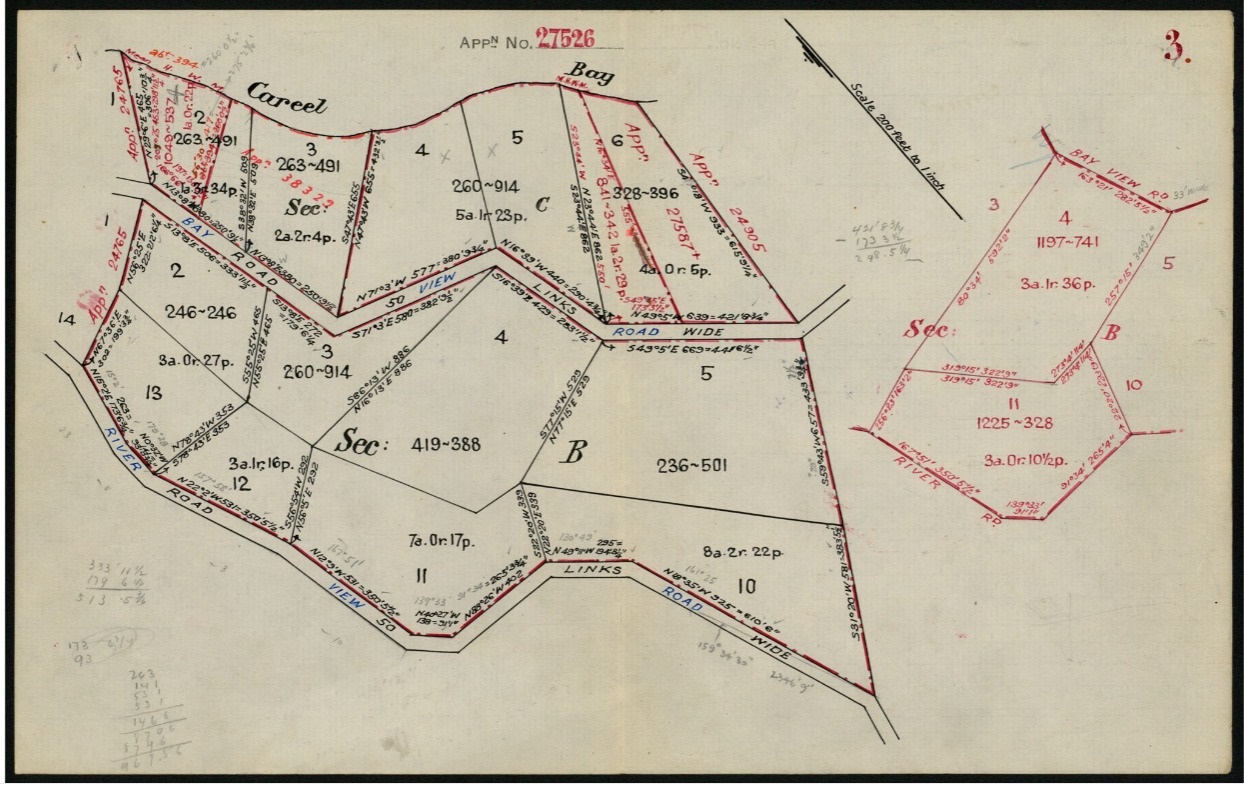
Blocks 2 and 3 (Book/Number 263-491) Milford acreage Lots 1 and 2 of Section C - and also Lot 9 South Division which was 25 acres on Refuge Cove - on the others side and on Pittwater:
.jpg?timestamp=1692206890198)
.jpg?timestamp=1692207615218)
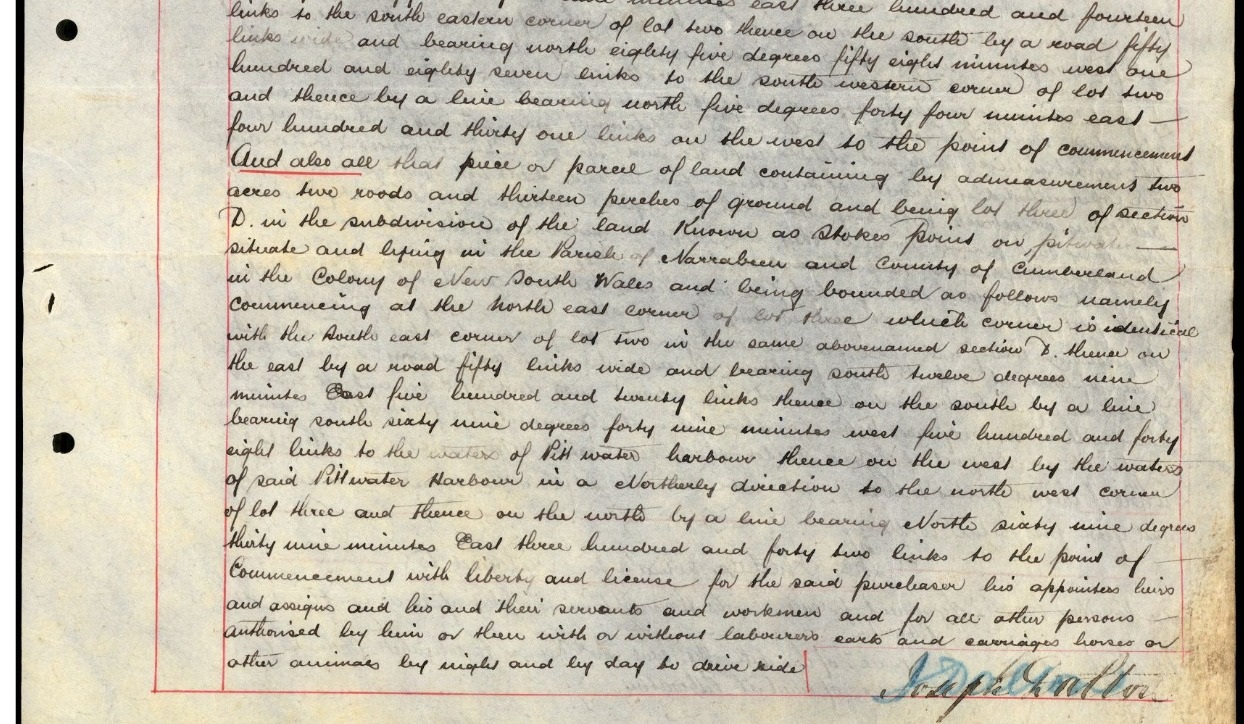
.jpg?timestamp=1692207748578)
.jpg?timestamp=1692207716790)
Blocks 4 and 5 Book-Number 260-914 Lot 6 of 4 acres- Dalton to William Waterhouse (steamboat proprietor - steamships were still landing people via Careel Bay Wharf at Careel Bay as an outing for the day into the1890s via the Namoi and Newcastle, all with bands aboard) and/with Matthew Byrne:
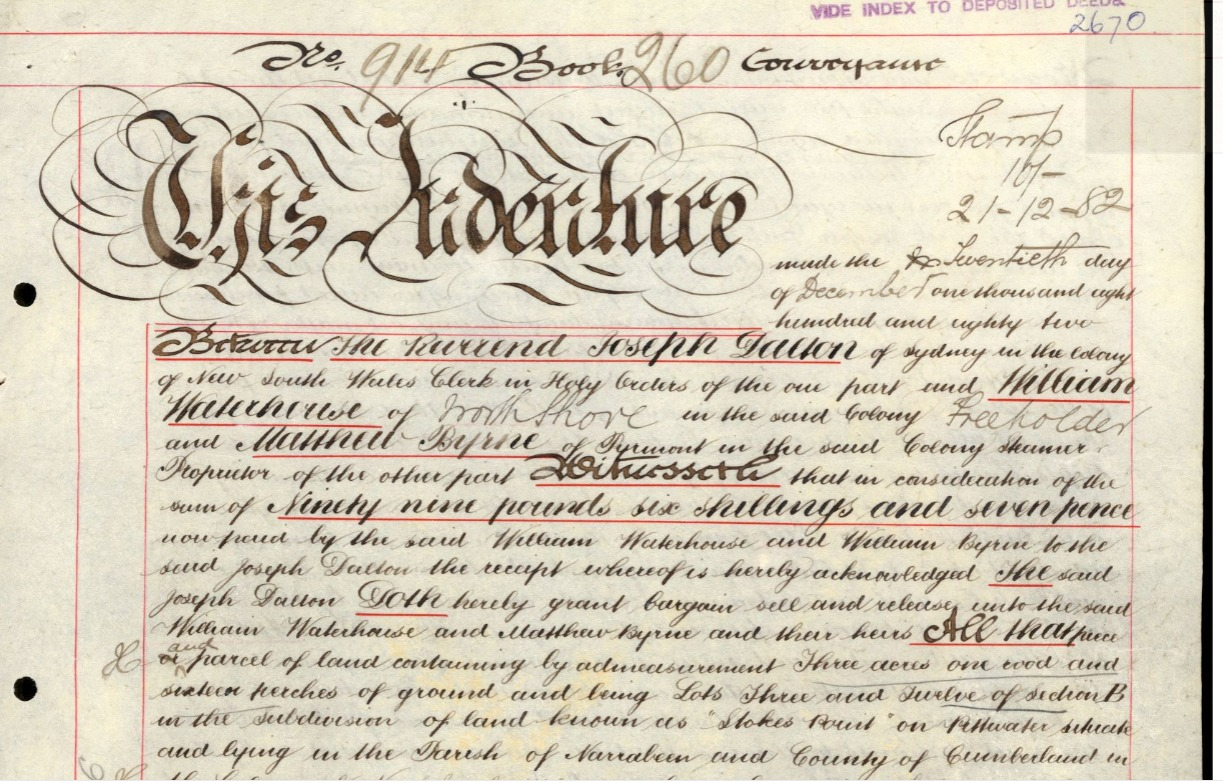
[Notice of Application for a Certificate of Conformity.]
In the Supreme Court of New South Wales.
IN INSOLVENCY.
In the Insolvent Estate of William Waterhouse, of St. Leonards, North Shore, labourer.
To the Official Assignee and Creditors.
TAKE NOTICE, that I, William Waterhouse, intend to apply to His Honor the Chief Commissioner of Insolvent Estates, at the Court Room, King-street, Sydney, on Tuesday, the 29th day of June next, at 11 a.m., or as soon afterwards as the course of business will admit, that a Certificate be granted to me, under and according to the provisions of the Acts 5th Victoria, No. 17, 7th Victoria, No. 19, and 25th Victoria, No. 8.—Dated this 13th day of May, a.d. 1869.
WILLIAM WATERHOUSE. 2952 6s. 6d. IN INSOLVENCY. (1869, May 28). New South Wales Government Gazette (Sydney, NSW : 1832 - 1900), p. 1409. Retrieved from http://nla.gov.au/nla.news-article225583007
NORTH SHORE FERRY COMPANY'S NEW STEAMER.
For some time past Mr William Dunn, of Berry's Bay, St Leonards has been engaged in building a steamboat of large capacity or the North Shore Steam Ferry Company, to be employed in the growing traffic between the metropolis and North Shore. Mr. William Waterhouse having become the proprietor of the shed in which the boat was being constructed, made some additions thereto which involved the driving of some piles. It appeared however that the land, or at any rate the greater Part of it, upon which the boatshed stood was not freehold, but was reserved in the original grant.
This created a difficulty with Mr. Waterhouse but ultimately wiser counsels prevailed, the piles were removed and the boat which will be a valuable addition to our harbour fleet, was then successfully and quietly launched. As the vessel left the ways she was named the Cammeray, in the usual manner by the manager of the company, the early hour at winch the launch took place precluding the attendance of a lady to perform the ceremony.
Cammeray, it might be stated, is the aboriginal name of St Leonards. The principle dimensions of the vessel are -Length overall, 130 feet ; beam, 20 feet 5 inches, with an extreme breadth across the sponsons of 32 feet ; depth 7 feet 6 inches. Picked hardwood has been used for the frames with kauri planking. She is copper-fastened throughout, and was also coppered prior to launching. She is exceptionally strong. very heavy hardwood stringers and diagonals having been fitted into her. The deck fittings of the Cammeray are similar to the Victoria. The ladies' cabin is a comfortable airy compartment capable of seating 250 persons. It is 45 feet in length by the breadth of the vessel. The fittings are of cedar with polished Huon pine panels, and the seats are to be up-holstered in horsehair. The main feature in this steamer is a splendid promenade deck 130 feet in length on which fully 300 poisons can be seated. This will be covered by an permanent awning for a space of 60 feet amid-ships.
The Cammeray has accommodation for at least 800 persons. In designing the vessel great attention was paid to the matter of stability, and this has been fully met, as a survey has shown. She has two good ends, and a long perfectly flat floor. Thus giving her great floating power. She will only draw 3 feet 6 inches when loaded and require only small engines for propulsion. The ends of the vessel are flanged out considerably above water, and by this means the full beam on her deck line is carried right fore and aft. The Cammeray is to be taken round to Mort's Dock on Monday, to have her engines and boilers fitted. The engines which are on the high-pressure diagonal principle, are of 40 horsepower, and expected to drive the vessel between 10 and 11 knots per hour, and arrangements have been made with the Dock Company to provide the steamer with an apparatus to consume her own smoke. She will probably be ready for running in about a month. NORTH SHORE FERRY COMPANY'S NEW STEAMER. (1884, April 24). The Sydney Morning Herald (NSW : 1842 - 1954), p. 6. Retrieved from http://nla.gov.au/nla.news-article13560862
BOROUGH OF VICTORIA.
Election of Aldermen and Auditors.
NOTICE is hereby given that the following gentlemen have been duly elected Aldermen and Auditor respectively, viz.:—
As Aldermen.
Michael McMahon, The Point, North Shore.
John Blue, Union-street, Worth Shore.
Robert Moodie, Union-street, North Shore.
As Auditor.
George Ernest Blue, Union-street, North Shore.
There having been only one Auditor nominated and duly elected, the matter of one vacancy for the Auditorship has been duly reported to His Excellency the Governor, as required by the provisions of the Municipalities Act, 1867.
WILLIAM WATERHOUSE,
Mayor and Returning Officer.
Council Chambers, Blue's Point Road, 12th February, 1890. 1593 5s. BOROUGH OF VICTORIA. (1890, February 21). New South Wales Government Gazette (Sydney, NSW : 1832 - 1900), p. 1581. Retrieved from http://nla.gov.au/nla.news-article223597147
Block 6 Book-Number 328-398 Dalton to Fahey (husband died intestate) sold to James Brown:
.jpg?timestamp=1692216065548)
.jpg?timestamp=1692216110238)
.png?timestamp=1692216158289)
.jpg?timestamp=1692216234419)
.jpg?timestamp=1692216277206)
On the 11th instant, at Christ Church, by the Rev. Mr. Vidal, FRANCIS FAHEY, of King-street, Sydney, to HARRIET, second daughter of GREGORY BOARD, Esq., Brisbane-street, Surry Hills. Family Notices (1866, September 13). The Sydney Morning Herald (NSW : 1842 - 1954), p. 1. Retrieved from http://nla.gov.au/nla.news-article28613028
Children - one born just before he died:
FAHEY FRANCIS W1441/1867 FRANCIS HARRIETSYDNEY
FAHEY THOMAS C1599/1871 FRANCIS HARRIETSYDNEY
FAHEY FRANCES HARRIET1221/1876 FRANCIS HARRIETSYDNEY
FAHEY MARY3020/1877 FRANCIS HARRIETSYDNEY
FAHEY FREDERICK JAMES2147/1879 FRANCIS HARRIETSYDNEY
FAHEY GREGORY2948/1881 FRANCIS HARRIETSYDNEY
FUNERAL OF THE LATE MAJOR FAHEY.
The body of the late Major Francis Fahey, of the New South Wales Volunteer Artillery, was yesterday buried with military honours. The deceased gentleman had been associated with the corps since about the year 1860, and had by his genial manner and kindliness of heart won the affection and respect of his fellow-officers and the men he commanded. A great crowd of people assembled in the afternoon in the vicinity of the late officer's residence, Castlereagh-street, and followed the funeral procession to the Necropolis. At about 2 o'clock the various military corps took up their position.
There were present, the Volunteer Artillery, under the command of Lieutenant-Colonel Wells, with Adjutant Taunton and Captain Brewington ; No. Regi-ment, under the command of Lieutenant-Colonel Raymond ; No. 2 Regiment, under the command of Major Jaques ; the Permanent Artillery, under the command of Major Airey ; the Engineer Corps, under the command of Major Rowe, the Torpedo Corps under the command of Captain Walker, and a few members of the Naval Brigade. Beside those officers mentioned there were present Acting-Commandant Colonel Christie, Brigade-Major M'Kenzie, Lieutenant-Colonel Baynes, and Captain Compton, of the staff. Nearly all the officers in the corps and regiments mentioned were present, there being in all about from 400 to 500 rank and file. The bands present were the Headquarters, the Permanent Artillery, and the Volunteer Artillery.
The coffin was placed upon a gun-carriage drawn by four horses. It was coveted by the Union Jack, and wreaths and crosses of flowers were laid upon it, at the head also being placed the deceased officer's helmet and sword. Behind the gun-carriage was led the horse of the late major, the military custom of reversing the boots hung one on either side of the horse being observed. The streets were lined with spectators, and much trouble was experienced in keeping the crowd back when the Necropolis was reached. A special train, leaving at about 3 o'clock, took the relatives and friends of the deceased, the officers of the various regiments, and corps, and about 100 members of the Volunteer Artillery to the Haslem Creek Cemetery. Arriving at the cemetery, the Parramatta Volunteer Corps were seen drawn up to render the last mark of honour to the late major. At the request of the deceased he was buried in the Church of England ground. From the station to the grave the Volunteer Artillery Band play the dead march in "Sahl" and Beethoven's " Marche Funebre." The coffin was borne to the grave upon the shoulders of four members of the Volunteer Artillery, the pallbearers being Major Jaques, No. 2 Regiment : Major Airey, Permanent Artillery; Major Rowe, Engineer Corps; and Captain Farrell, No. 1 Regiment. The solemn burial service of the Church of England was read by the Rev. Hough, and at its conclusion a firing party, under the command of Captain Renwick, fired three volleys of blank cartridge over the grave. FUNERAL OF THE LATE MAJOR FAHEY. (1882, October 16). The Sydney Morning Herald (NSW : 1842 - 1954), p. 7. Retrieved from http://nla.gov.au/nla.news-article13522903
Deaths.
FAHEY. — October 12, at his residence, 129, Castlereagh-street North, Francis Fahey, aged 49. Family Notices (1882, October 13). The Sydney Morning Herald (NSW : 1842 - 1954), p. 1. Retrieved from http://nla.gov.au/nla.news-article13525582
NOTICE is hereby given, that application is intended to be made to the Parliament of New South Wales, during the ensuing session thereof, for leave to bring in a Bill to authorize and empower Harriet Fahey, of Castlereagh-street, Sydney, the widow of Francis Fahey, deceased, from time to time to demise all or any part or parts of all that parcel of land containing by admeasurement twenty-four perches, and situate in the city of Sydney, parish of St. James, county of Cumberland, allotment No. 15 of section No. 35; bounded on the east by Castlereagh street bearing north three degrees forty-five minutes west 67 links; on the north by allotment No. sixteen bearing west four degrees south one hundred links, then south four degrees east two and a half links, then west four degrees south twenty seven links, then south two degrees west four links, then west eight degrees south one hundred and twenty-one links ; on the west by allotment No. eight bearing south nine degrees fifteen minutes east fifty-eight links, and on the south by allotment No. fourteen bearing east six degrees thirty minutes north two hundred and forty-five links, which parcel of land, under an indenture made the twenty-fourth day of March, one thousand eight hundred and sixty-eight, between John Godden Colyer, of the one part, and Gregory Board, of the other part, stands limited unto the said Gregory Board and his heirs, to the use of the said Harriet Fahey for her separate use without power of anticipation to such uses as she may notwithstanding coverture by will appoint, and in default of such appointment to the use of all and every the children of the said Harriet Fahey then surviving at the time of her decease share and share alike as tenants in common in fee.—Dated this 13th day of July, 1885.
HOLDSWORTH & EVANS,
Solicitors for the Bill, 75, Pitt-street, Sydney. 4674—3 £2. NOTICE is hereby given, that application is intended to be made to the Parliament of New South Wales, during the (1885, July 28). New South Wales Government Gazette (Sydney, NSW : 1832 - 1900), p. 4780. Retrieved from http://nla.gov.au/nla.news-article223986116 - The Bill was passed, helped her look after her children.
Dr James Frederick Elliott
Around 1917/1918 Dr. Elliot built 'Marara' - a property and house still in existence on Careel Bay until recently.
Tenders called for... Hawkesbury River — Residence, Careel Bay Undated — E. R. Orchard. 684 Pitt Street. Advertising. (1918, June 10). Construction and Local Government Journal (Sydney, NSW : 1913 - 1930), p. 3. Retrieved from http://nla.gov.au/nla.news-article109675648
Careel Bay -Erection of timber bungalow at Careel Bay Mr E R Orchard, architect, 68 Pitt street. TENDERS. (1918, June 26). The Sydney Morning Herald (NSW : 1842 - 1954), p. 8. Retrieved from http://nla.gov.au/nla.news-article15790801
Edwin (Ted) Orchard (1891–1963) was an Australian architect, and established Sydney North Shore architect who is credited with designing the earliest Californian Bungalow-influenced houses in New South Wales between 1913 and 1915 (three of his Sydney designs have been entered in the New South Wales State Heritage Register).
Orchard relocated to Mareeba during the Depression and was involved in the tobacco industry until 1933, when he established an architectural practice in Cairns. He registered with the Queensland Chapter of the Royal Society of Architects in 1936. In 1937, he undertook a world tour from which he learned a great deal about architecture to suit tropical regions.
Orchard's other projects in the Cairns region included: Tobruk Memorial Pool (in partnership with Jack McElroy), St David's Anglican Church at Mossman, motor showrooms and a hotel in Atherton, the Tinaroo Dam lookout shelter, the Great Northern Hotel at Mareeba, the remodelling of the Courthouse Hotel in Cairns, and the Australian Hotel in Mackay. Much of his north Queensland work was influenced by the work of Dutch-born modernist architect Willem Marinus Dudok, whose use of dramatic massing, asymmetry, and overhanging eaves achieved international recognition and influence in the 1920s and 1930s.
From Primary Application Number 27526 - J F Elliott now owns 29 + acres - sold around 1 acre to Arthur Pixley (March 16 1927) and an Instrument of Transfer to Hilary James Monckton of Manly, Wool-buyer, on same date (Vol/Fol: 4011-108). His father - Walter Hillary Monckton passed away at Careel Bay in 1924. Hillary James Monckton would transfer Lot 2, on Careel Bay, to David Bruce Monckton in 1955.
Careel Bay -Erection of timber bungalow at Careel Bay Mr E R Orchard, architect, 68 Pitt street. TENDERS. (1918, June 26). The Sydney Morning Herald (NSW : 1842 - 1954), p. 8. Retrieved from http://nla.gov.au/nla.news-article15790801
.jpg?timestamp=1692221669934)
.jpg?timestamp=1692221701128)
.jpg?timestamp=1692221746190)
The Elliott premises is first advertised, beginning in October 1926 'The Commonwealth Home' magazine - note is spelled 'Marama' in this magazine/journal: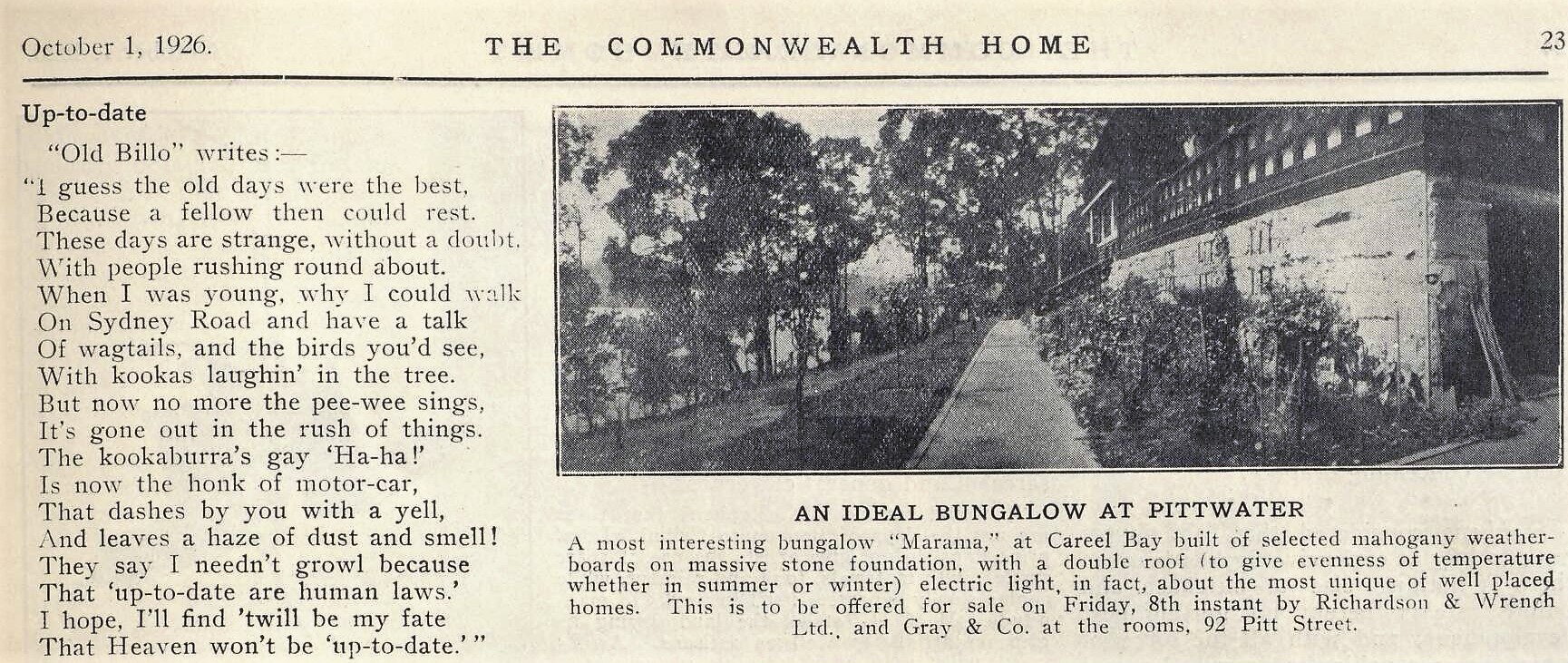
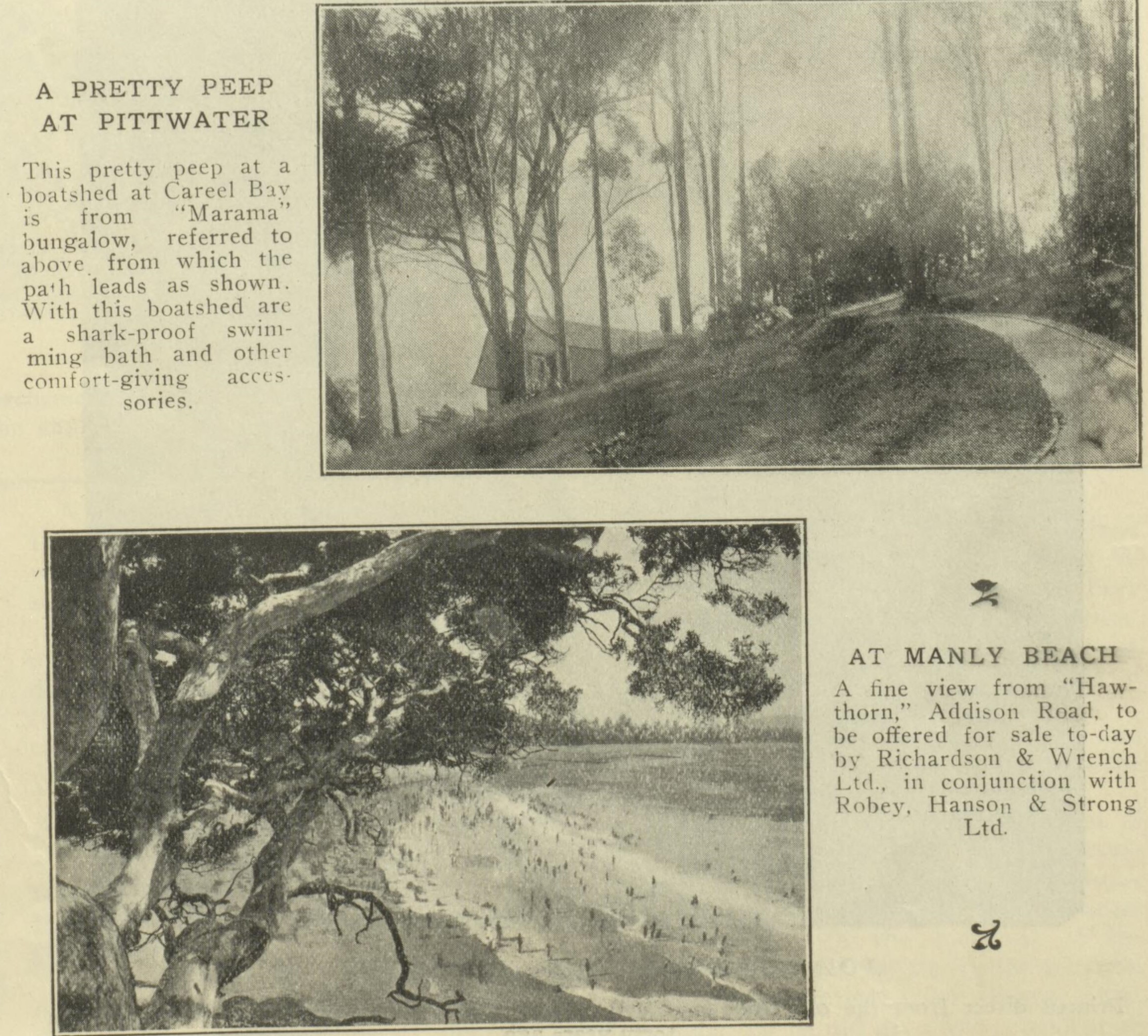
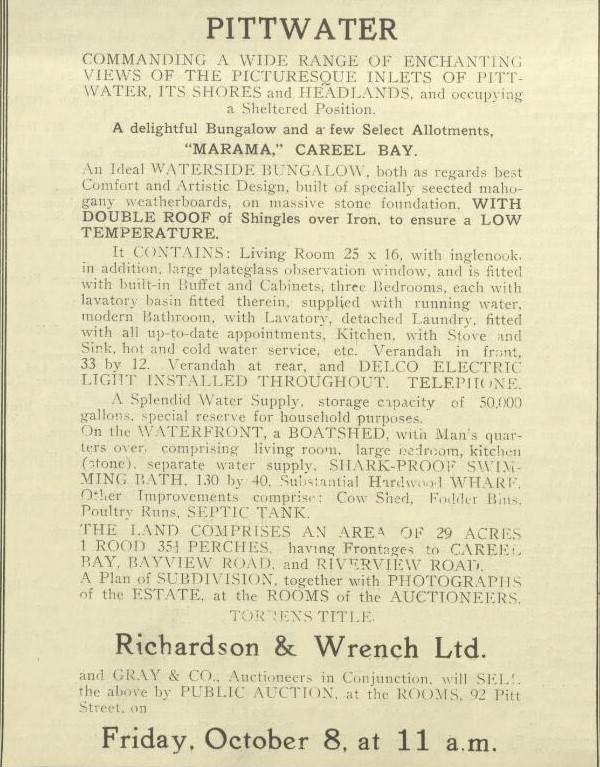
A simple investigation of the owners of the yachts of the Royal Sydney Yacht Squadron and the then owner of the Meteor, Dr. James Frederick Elliott of Elliott Brothers, Limited, was rear-commodore of the Royal Sydney Yacht Squadron in 1893-94 and 1900-02 and vice-commodore in 1902-04, and a director of the private company formed to buy the club's premises, Carabella, Milsons Point, in 1904. J F Elliott passed away in 1928 but two years prior to then purchased land at Careel Bay: Primary Application - James Frederick Elliott 29 acres 11 roods 35 1/4 perches in Bay View & River View Roads & on Careel Bay & Pittwater in Parish Narrabeen County Cumberland Shire Warringah Volume 3952 Folio 98 Date range: 13/04/1926 to 23/12/1926 (From State Records of NSW).
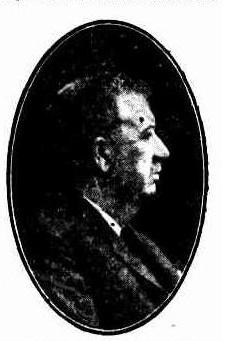 DR. J. F. ELLIOTT. DEATH IN SYDNEY. After an illness of a few months the death took place in Sydney on Sunday morning last of Dr. James Frederick Elliott, for many years chairman of directors and general manager of Elliott Brothers, Limited, Sydney and Brisbane. Dr. Elliott was a son of Dr. F. W. Elliott, one of the founders of the business, which has come to be one of the largest of its kind in the British Empire. After the death of the original Elliott Brothers the business was conducted by Mr. George C. Elliott, and the late Dr. J.F. Elliott, D.Sc, the former for many years being chairman of directors, during which time Dr. J. F. Elliott was managing director at the large chemical works and manufacturing laboratories at Balmain, Sydney. On the death of Mr. George C. Elliott, Dr. J. F. Elliott accepted the chairmanship of the company, and during the period of his control the business made very rapid strides. The doctor was one of the leading figures of the drug trade in the Commonwealth. His wide knowledge and versatility were generally recognised, and his business sagacity was availed of by many companies outside the drug trade, which he served in the capacity of director. His outside interests were many, and various. Of a naturally kind-hearted, sympathetic, and genial disposition, Dr. Elliott will long be remembered by a large body of loyal employees.
DR. J. F. ELLIOTT. DEATH IN SYDNEY. After an illness of a few months the death took place in Sydney on Sunday morning last of Dr. James Frederick Elliott, for many years chairman of directors and general manager of Elliott Brothers, Limited, Sydney and Brisbane. Dr. Elliott was a son of Dr. F. W. Elliott, one of the founders of the business, which has come to be one of the largest of its kind in the British Empire. After the death of the original Elliott Brothers the business was conducted by Mr. George C. Elliott, and the late Dr. J.F. Elliott, D.Sc, the former for many years being chairman of directors, during which time Dr. J. F. Elliott was managing director at the large chemical works and manufacturing laboratories at Balmain, Sydney. On the death of Mr. George C. Elliott, Dr. J. F. Elliott accepted the chairmanship of the company, and during the period of his control the business made very rapid strides. The doctor was one of the leading figures of the drug trade in the Commonwealth. His wide knowledge and versatility were generally recognised, and his business sagacity was availed of by many companies outside the drug trade, which he served in the capacity of director. His outside interests were many, and various. Of a naturally kind-hearted, sympathetic, and genial disposition, Dr. Elliott will long be remembered by a large body of loyal employees.
Until recent years Dr. Elliott made frequent and regular trips to Brisbane, but in consequence of the amalgamation of the Brisbane branch of Elliott Brothers, Limited, with Taylor and Colledge, Limited, which took place in 1924, his visits became less frequent. He still retained his connection, however, as a director of Taylors and Elliotts, Limit-ed, and also T. and E (Surgical),Limited. His widespread business interests left him with little leisure time, and this time he usually spent in boating, fishing, and other pleasures of an aquatic nature.
For many years his motor yacht, Ena, was prominent amongst the motor craft of Sydney Harbour. As chairman of Elliott Brothers, Limited, he will be succeeded by Mr. Victor G. Elliott, son of the late G. C. Elliott. Yesterday, from noon to 2 p. m., the Brisbane offices of Taylors and Elliotts were closed as a mark of respect to the memory of the late Dr. Elliott. The funeral took place yesterday. THE LATE DR. J. F. ELLIOTT. DR. J. F. ELLIOTT. (1928, September 11). The Brisbane Courier (Qld. : 1864 - 1933), p. 12. Retrieved from http://nla.gov.au/nla.news-article21355389
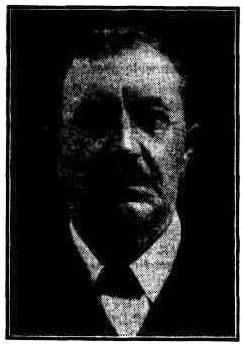 LATE DR. ELLIOTT. The funeral of Dr. James Frederick Elliott took place privately at the South Head Cemetery yesterday. One of the leading pharmaceutical chemists in Australia, he found time, in a crowded life, to engage in many commercial and other activities.
LATE DR. ELLIOTT. The funeral of Dr. James Frederick Elliott took place privately at the South Head Cemetery yesterday. One of the leading pharmaceutical chemists in Australia, he found time, in a crowded life, to engage in many commercial and other activities.
The second son of the late Dr. George Robinson Elliott, who founded the firm of Elliott Bros., Ltd., the late Dr. J. F. Elliott was born in Elliott-street, Balmain, in 1857, and was educated at the Sydney Grammar School. For his technical education he proceeded to London, thence to Germany. Returning to Sydney, he was appointed to the position of pharmaceutical chemist to Elliott Bros., Ltd., and he designed the laboratories at Rozelle. He also occupied the position of scientific director of the chemical works of the company, succeeding the late Mr. James R. Elliott as managing director of the chemical works and laboratories.
In these positions he had great opportunities of showing his ability as a chemical engineer, and under his supervision great progress was made in the manufacture of sulphuric and other mineral acids, and also the manufacture of superphosphates and other chemical manures, He was a leading authority on all pharmaceutical matters and chemical engineering and was a life member of the Pharmaceutical Society of New South Wales.
During the last few years he made several visits to England, the Continent, and the Far East, and was one of the founders of the oil industry in Timor. He took a special interest in the refinement of bismuth metal.
Subsequent to the death of the late Mr.George Elliott in 1912 he became general manager and chairman of the board of directors of Elliott Bros., Ltd., and also became director of a number of other companies, including the Australian Alliance Assurance Co., Consumers' Ammonia Co., of Australia, Ltd., Taylors and Elliotts, Ltd. (Brisbane), in which were amalgamated the businesses of Elliott Bros., Ltd., and Taylor and Colledge, in Brisbane. He was a member of the New South Wales Club and the Royal Sydney Yacht Squadron. Yachting had a fascination for him and he introduced the 30ft class, and he sailed the Magic and the Meteor. Latterly, he owned the motor yacht, Lotus. LATE DR. ELLIOTT. (1928, September 11). The Sydney Morning Herald (NSW : 1842 - 1954), p. 12. Retrieved from http://nla.gov.au/nla.news-article16493486
Balmain Sailing Club; Messrs. M. A. H.Fitzhardinge, J. C. Elliott, and Dr. Elliott. R. S. YACHT SQUADRON. THE CENTENNIAIL CELEBRATION. (1887, November 3). Evening News(Sydney, NSW : 1869 - 1931), p. 8. Retrieved from http://nla.gov.au/nla.news-article108222596
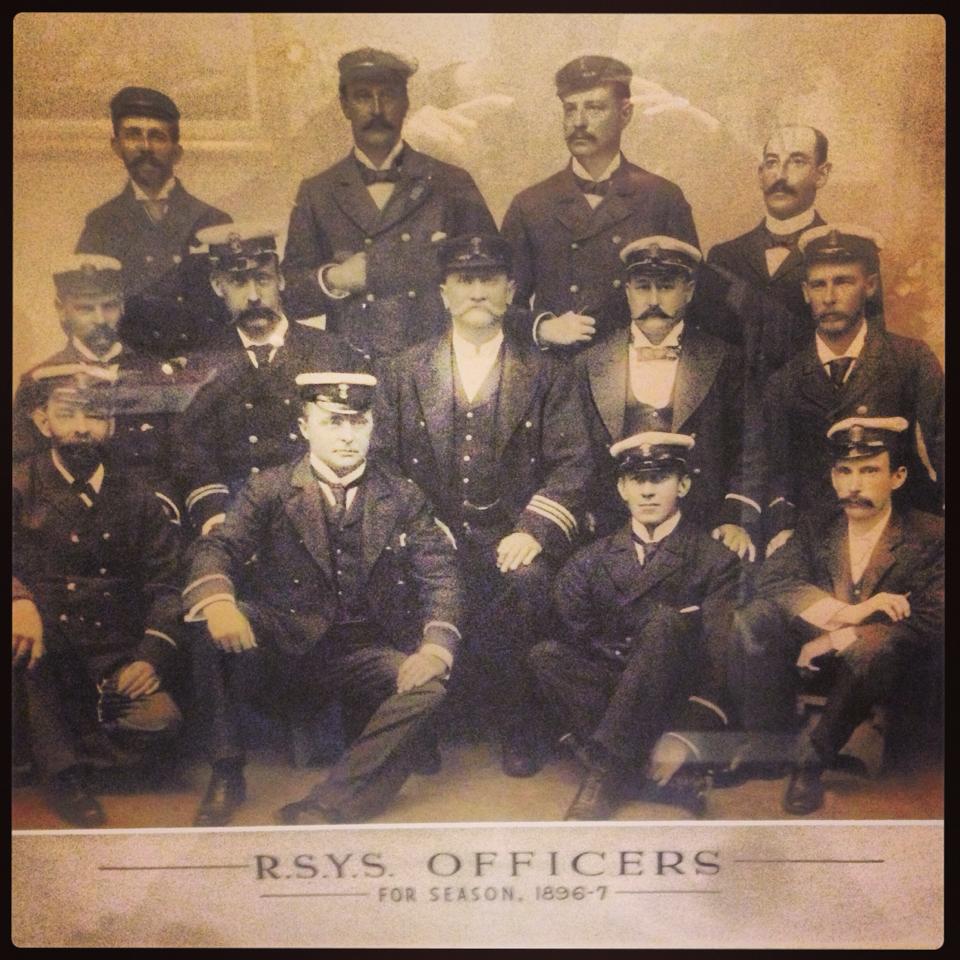
J F Elliott appears in the above image in back row, second from left (courtesy RSYS archives). The RSYS members, alike the foundation members of Pittwater's RPAYC and RMYC - Broken Bay, were captains of industry or at the top of their field. Sailing races to Pittwater, Pitt Water as a holiday destination were a clear and obvious choice. Having a Pitt Water base was part of RSYS plans and moorings and the boatshed itself, once built, were theirs up until quite recently in terms of how long Careel Bay has attracted the yachting fraternity.
A description of 'Marara' from 1929 sale Notice:
Under Instruction from THE EXECUTORS OF ESTATE OF THE LATE
Dr. JAMES FREDERICK ELLIOTT, "MARARA." CAREEL BAY. near PALM BEACH. OCCUPYING a sheltered position, commanding a wide range of enchanting views if the picturesque Inlets of Pittwater, its shores, and headlands. An ideal Waterside Bungalow of attractive design, built of specially selected mahogany weatherboards on massive stone foundation, WITH DOUBLE ROOF and shingles over iron, to ENSURE A LOW TEMPERATURE.
It contains: Living-room, 25 x 10, with inglenook. In addition large plate glass observation window, and is fitted with built-in bullet and cabinets, four bedrooms, each with lavatory basin fitted therein, supplied with running water, modern bathroom, with lavatory, kitchen with stove and sink, hot and cold water service, etc. Verandah in front. 33 x 12. Verandah at rear. All windows and doors fitted with copper wire flyscreens. Delco Electric Light Installed throughout, Telephone. The water supply Is a special feature, having a storeage capacity of '60.000 gallons, with special Reserve supply for household purposes, connected to bedrooms, bathroom, and kitchen.
DETACHED LAUNDRY, fitted with up-to date appointments, storeroom.
ON THE WATERFRONT Is a BOATSHED. with man's quarters over, comprising living-room, large bedroom, kitchen (stone), separate water supply. SHARK-PROOF SWIMMING BATH. 130ft, x 40ft. Substantial Hardwood Wharf, Other improvements comprise: Motor Garage, Cow Shed. Fodder Bins, Poultry Run, Septic Tank. THE LAND COMPRISES AN AREA OF 28 ACRES 8 ROODS 6 PERCHES. TITLE TORRENS. HAVING FRONTAGES to CAREEL BAY. BAYVIEW ROAD AND RIVERVIEW-ROAD, about 4500 FEET t o EXISTING ROADS.
.jpg?timestamp=1591354015225)
PHOTOS. ON VIEW. RICHARDSON and WRENCH. LTD. in conjunction with JOHN W. ILFORD. 82 PITT STREET, will submit the above GENTLEMAN'S SEASIDE HOME (FURNISHED. AND BOATS, GEAR, FISHING NETS, ETC. ETC.) to PUBLIC AUCTION.IN THE ROOMS. on PITT-STREET. on FRIDAY 15th of MARCH. AT 11 A.M. INSPECTION BY CARD ONLY MAY BE MADE BETWEEN THE HOURS 0F 9AM AND 5PM (INCLUDING WEEKENDS). Advertising. (1929, March 2). The Sydney Morning Herald(NSW : 1842 - 1954), p. 24. Retrieved from http://nla.gov.au/nla.news-article16535201
.jpg?timestamp=1692221836392)
.jpg?timestamp=1692221898289)
.jpg?timestamp=1692221959953)
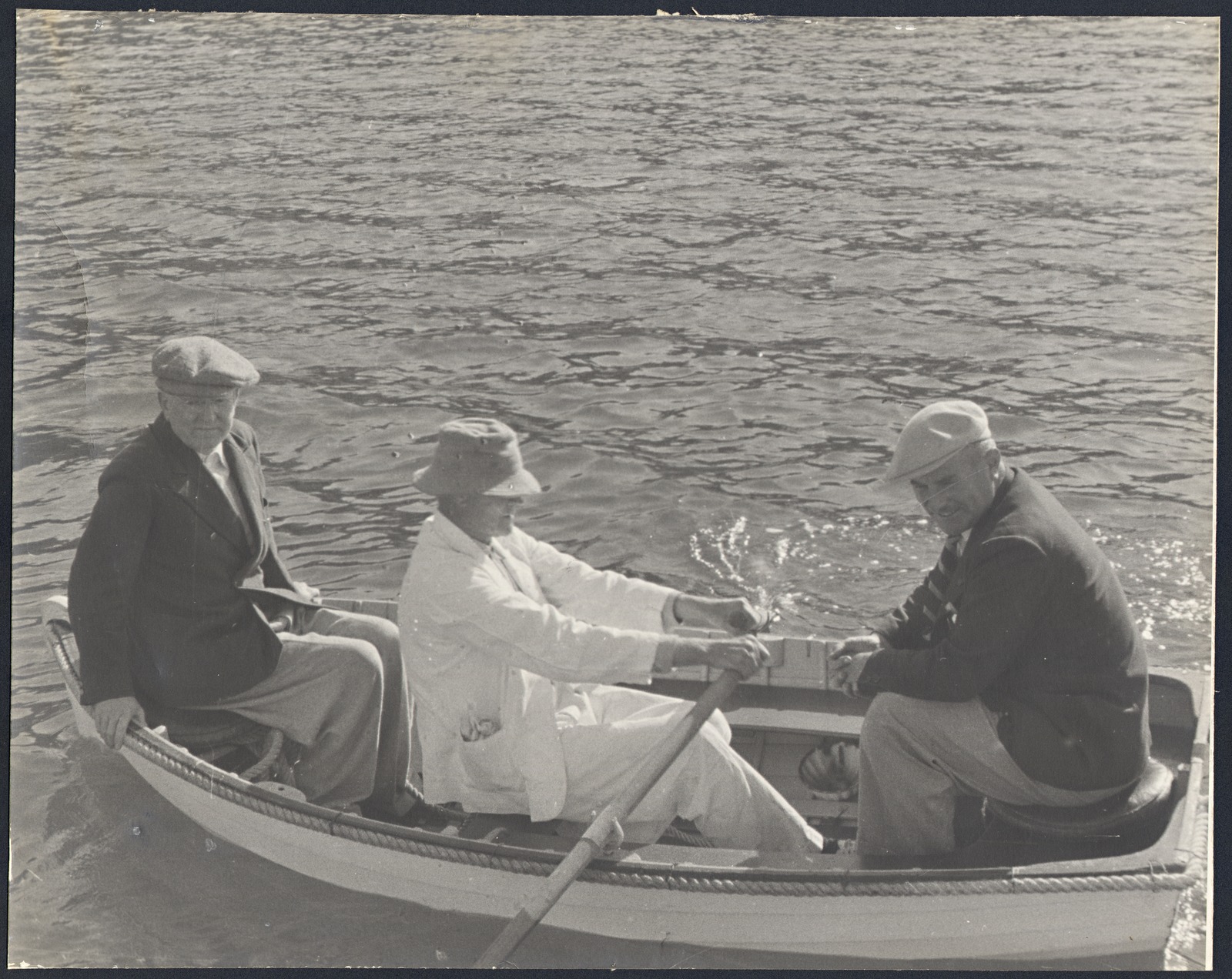
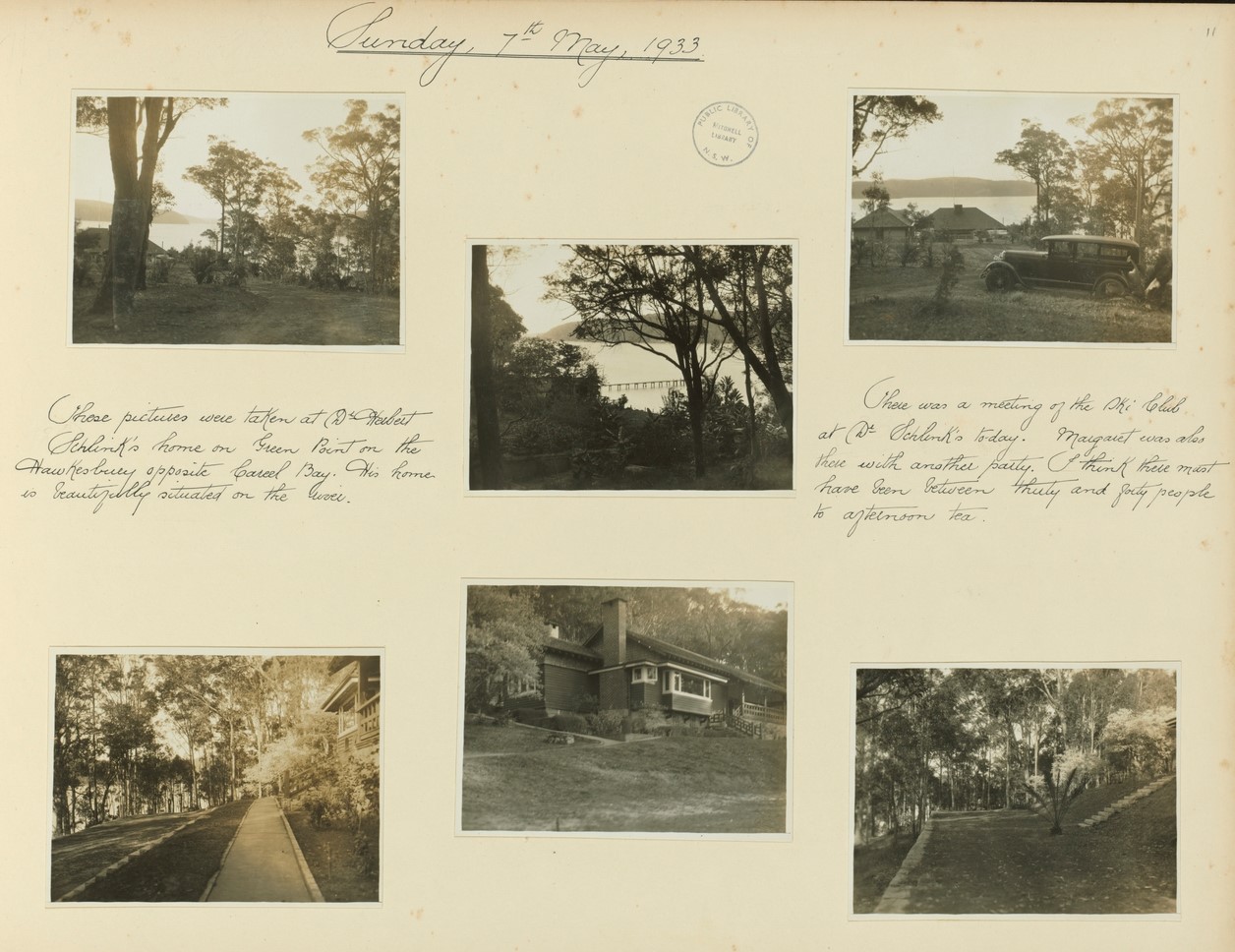
Found Drowned. A fisherman named Albert Turner, living at Stockpoint Careel Bay, was found drowned in Broken Bay near Hazeldon on May 8. He had been out in his sailing boat, which was found on the rocks with the sails set, and had visited his brother-in-law, Thomas Wilson, at Bayview during the day. Deceased leaves a wife and seven children. Found Drowned. (1892, May 14). Australian Town and Country Journal (NSW : 1870 - 1907), p. 46. Retrieved from http://nla.gov.au/nla.news-article71237819
Charlie Hastie, a well-known fisherman of Pittwater, says that black bream, flathead, and flounder are now fairly plentiful about Careel Bay and the mouth of Pittwater, and advises anglers to give the place a trial. FISHING NOTES. (1906, February 3). Evening News (Sydney, NSW : 1869 - 1931), p. 5. Retrieved from http://nla.gov.au/nla.news-article114224127
Charles Hastie married Isabella Harris in 1890, they had two sons and two daughters, one of whom was Jessie Hastie (born 1896). In 1914 Jessie Isobell married Frederick James Wilson (born 1889, fisherman). Frederick was the son of Thomas and Frances (nee Oliver) Wilson. His grandfather was the Thomas Wilson who first came to Pitt Water in 1841 as the lessee of “Mona Vale” farm. The above mentioned Albert Turner was married to his aunt, Nancy (b.1852, married Albert H. Turner 1872). More in: Pittwater Fishermen: Great Mackerel, Little Mackerel (Wilson's Beach - Currawong) and The Basin
Primary Application - Charles John Hastie 2 acres on Bay View Road & Careel Bay, Pittwater in Parish Narrabeen County Cumberland Shire Warringah Volume 3946 Folio 207 Date range: 01/05/1926 to 11/12/1926 (was named 'Koala' from HRLV map as there were lots of koalas in Pittwater, particularly in the Avalon to Careel Bay to Palm beach area then):
.jpg?timestamp=1692224864940)
.jpg?timestamp=1692224940466)
.jpg?timestamp=1692225066558)
.jpg?timestamp=1692224995831)
.jpg?timestamp=1692225025637)
Charles Hastie passed away in 1940 and the property passed to his daughter, Jessie Isabel Wilson's keeping.
HASTIE.—September 13, 1940, at his residence, Careel Bay, Newport, Charles John Lawson Hastie, dearly beloved husband of Isabella Jane Hastie and loving father of Jessie (Mrs. Wilson), Isobel (Mrs. Colwell), and Bessie (Mrs. Baker), aged 75 years. Family Notices (1940, September 14). The Sydney Morning Herald (NSW : 1842 - 1954), p. 14. Retrieved from http://nla.gov.au/nla.news-article27948065
Ted Allan, whom we spoke to when researching, and who knew both Hasties and Wilsons, sheds some light on activities of then:
Ted Allan:
I grew up with Colin Wilson, and I fished with them. Colin, the Wilsons, lived in the corner here. I’d walk across the bay here when young and Colin and I would muck about with nets. After I finished my apprenticeship as a carpenter I went commercial fishing with them for four years. I fished with Charlie Wilson and old Jackie. The land in the corner that is Careel Bay Close now, that was the Wilson’s place.
There was another bloke by the name of “Hastie’ and old grandmother Hastie lived in the bottom house there which is in that old photograph – it had a mandarin tree. They were yum. Old Jackie Wilson, in between fishing, he had a very good garden on the hill there.
The man who had the Newport Hotel, as I remember it, bought the land from the Wilson family – I think his surname was Seibert. There were four boys and four girls in the Wilson family. Of the four Wilson family girls some are still alive – Jean lives down in Canberra, she’s the youngest, Mercia lived in Mona Vale, Joan used to live in Joseph street but is in a nursing home now, her surname is Hillier, and there is also Betty.
Late in 2014 we were contacted by a relative of the Wilson family, who shared this insight on the Wilson ladies and their sequence of birth:
The youngest is JEAN (my mother) and she resides in Queanbeyan near Canberra; the next oldest is Betty who has lived in Newport Beach for almost 30 years; Joan Hillier does in fact live in a Mona Vale nursing home. The eldest Mercia (known as Bid), who had also moved to the same nursing home, has unfortunately now passed away. - WENDY LOYD.
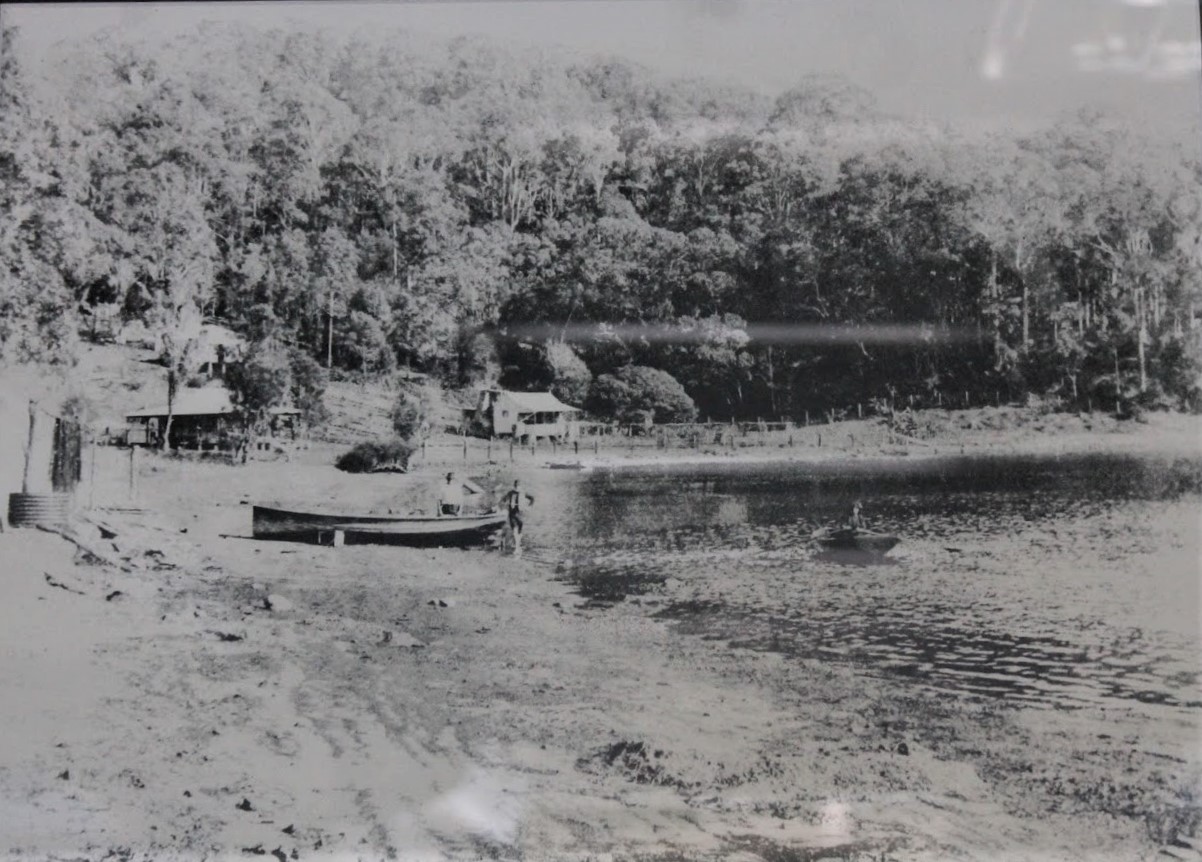
The nets you see in that old photograph – old Jackie had a net pole along here and they used to dry their nets on these. In the photograph you can see a big tub. In those days they used to boil the ironbark up to dye the nets as these were cotton, or they were when I first started. There was no nylon then. You would pick an ironbark tree that had a lot of sap coming out of it and chop the bark up finely to use as a dye. - PETER VERRILLS, photo courtesy Verrills family
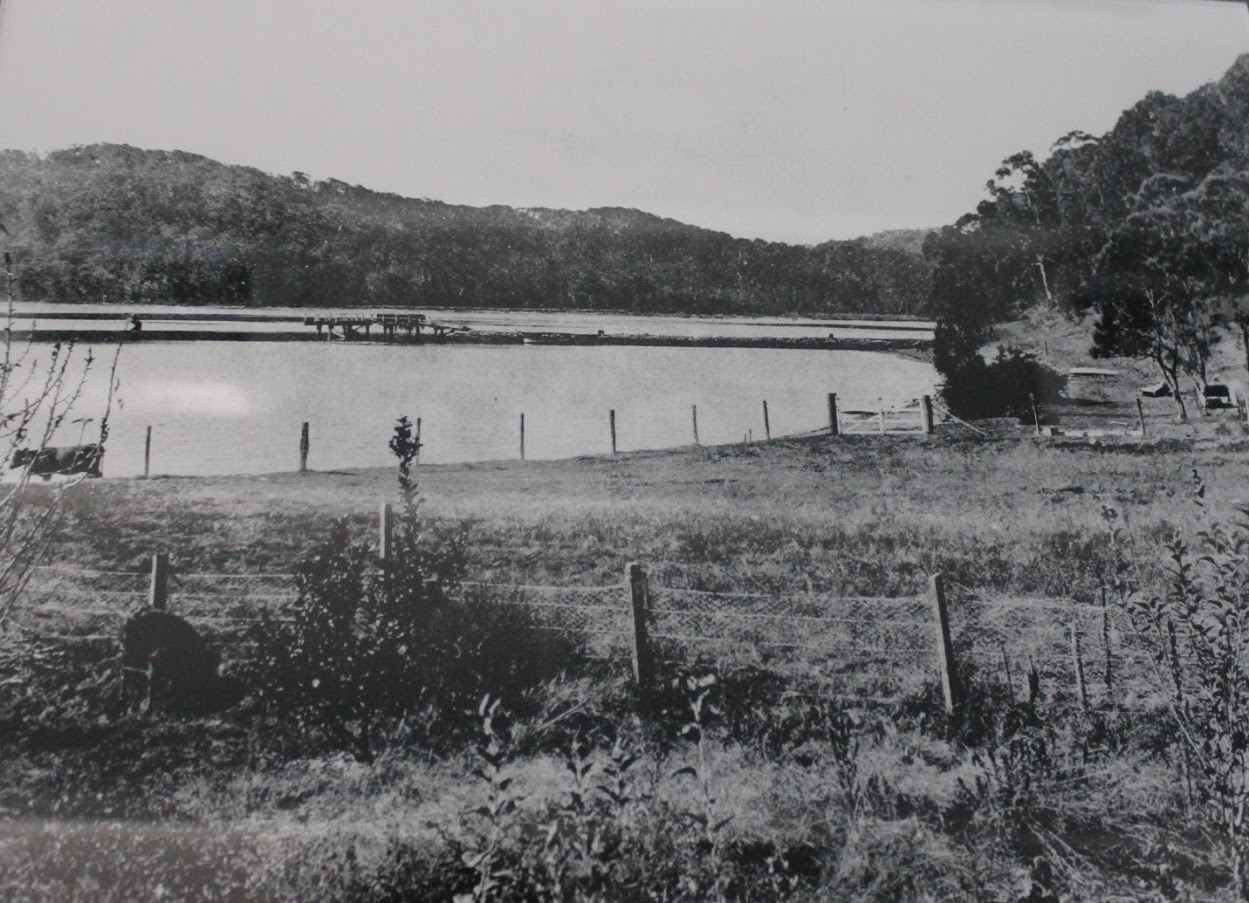
This was the base for Palm Beach Ferries; all the maintenance happened here. This was done originally by Jimmy Goddard. He married one of the Hammond girls and had two sons, Billy (William) and Allan. Allan is down in Tasmania now and Bill is up in Bilgola Plateau. Jim was the resident shipwright here and did all the woodwork maintenance on the ferries because they were timber boats in those days. He also built a few boats here with Taylor, but that was much later on in life. - PETER VERRILLS photo
Stokes Point Careel Bay: The Shift From Warner's Hut In 1813 To Finisterre In 1924; 1934 Additions Probably Designed By Australia's First Women Architect, Beatrice (Bea) May Hutton - A Pittwater Rendezvous Site For Royal Sydney Yacht Squadron Members Is Still A Home With A View For Those With A Passion For Sailing, threads collected and collated by A J Guesdon 2023.
.jpg?timestamp=1692591780649)
.jpg?timestamp=1692591737233)
.jpg?timestamp=1692591947980)